Sony Group NWZX1000 Digital Media Player User Manual Instruction manual GB PDF
Sony Corporation Digital Media Player Instruction manual GB PDF
User Manual

©2009 Sony Corporation 4-141-609-11 (1)
Operation Guide
NWZ-X1050 / X1051 / X1060 / X1061
Table of
Contents
Index
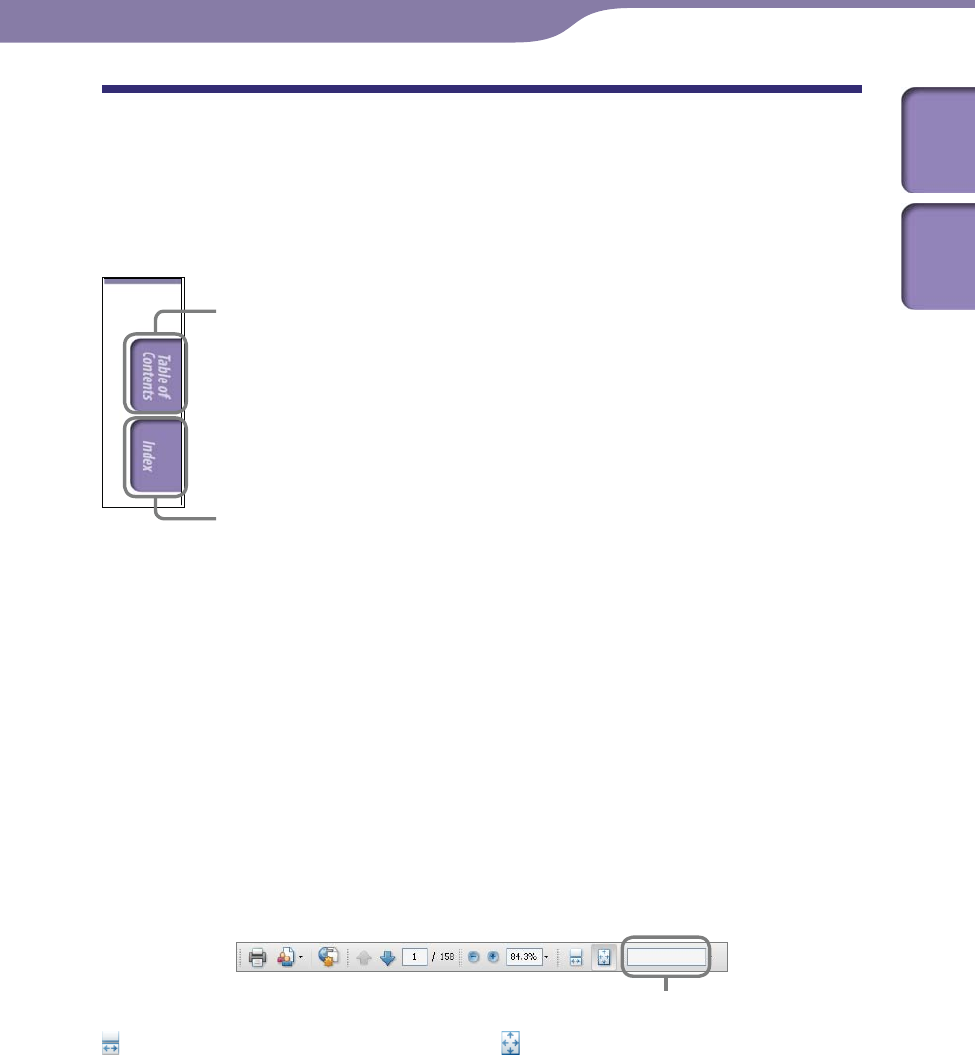
Basic Operations and Screens
2
2
Browsing the Operation Guide
To use the buttons in the Operation Guide
Click the buttons located at the upper right of the pages of this manual to jump
to “Table of Contents” or “Index.”
Jumps to the table of contents
Find what you are looking for from a list of topics in the manual.
Jumps to the index
Find what you are looking for from a list of key words mentioned in the manual.
Hints
You can jump to the indicated page by clicking a page number in the table of contents or
in the index.
You can jump to the indicated page by clicking a page reference indication (e.g., page
4) on each page.
To search for a reference page by keyword, enter the keyword into the find text field on
the Adobe Reader window.
Operation procedures may differ, depending on your Adobe Reader version.
To change the page layout
The buttons on the Adobe Reader window enable you to select how pages are
displayed.
Text field to find text
Continuous
Pages are displayed as a continuous
roll of pages, fitting the page width
inside the window. When you scroll,
the previous or next pages scroll up
or down continuously.
Single Page
Pages are displayed one at a time,
fitting the page into the window.
When you scroll, the display changes
to a previous or succeeding page.
Table of
Contents
Index

Basic Operations and Screens
3
3
Continued
Table of Contents
Basic Operations and Screens
Parts and Controls ................................ 6
Connecting the headphones ...........................8
Turning the Player On and Off ............. 9
Disabling the operation buttons and the
touch panel ...................................................10
How to Use the Touch Panel ............... 11
About the Home Menu........................ 13
How to Use the Home Menu ............... 14
How to Use the Option Menu ............. 18
Text Input ............................................ 20
About the Bundled Software ............... 22
Windows Media Player 11 ............................22
Media Manager for WALKMAN*1 ..............22
Content Transfer ............................................23
Preparing the Player
Charging the Player ............................ 24
Setting the Date and Time .................. 26
Getting Music/Videos/Photos/
Podcasts ............................................ 27
Transferring Music/Videos/Photos/
Podcasts ............................................ 28
Wireless LAN Connection .................. 33
Wireless networks which may be used with
the player ......................................................33
Connecting to a wireless LAN .....................34
Disconnecting from a wireless LAN ...........36
Playing Music
Playing Music (Music) ........................... 37
Music playback screen ...................................38
List screen .......................................................39
Browsing cover arts to select an album
(Album Scroll) ..................................................41
Searching for Songs ............................ 42
Searching for Reference Information on
a Song (Related Links) ........................... 43
Deleting Songs .................................... 44
Using the Music Option Menu ............ 45
Displaying the Detailed
Information screen ......................................46
Changing the Music Settings .............. 47
Play Mode .......................................................47
Playback Range ..............................................48
Equalizer .........................................................48
VPT (Surround) .............................................50
DSEE (Sound Enhance) ................................51
Clear Stereo .....................................................52
Dynamic Normalizer .....................................52
Album Display Format ..................................53
Watching Videos
Playing a Video (Videos) ....................... 54
Video playback screen ...................................55
Browsing scenes (Scene Scroll) .........................57
Searching for Videos ........................... 58
Deleting Videos ................................... 59
Deleting currently playing video .................59
Deleting videos by selecting from a list ......59
Using the Video Option Menu ............ 60
Changing the Video Settings .............. 61
Zoom Settings ................................................61
Playing only video sound
(On-Hold Display) .............................................63
Order of Video List ........................................63
Viewing Photos
Viewing Photos (Photos) ....................... 64
Photo display screen ......................................66
Searching for Photos ........................... 67
Deleting Photos ................................... 68
Using the Photo Option Menu ............ 69
Changing the Photo Settings .............. 70
Setting the Photo List Display Format ........70
Table of
Contents
Index

Basic Operations and Screens
4
4
Listening to FM Radio
Listening to FM Radio ........................ 71
To listen to FM radio .....................................72
Presetting broadcast stations automatically
(Auto Preset).....................................................73
Presetting broadcast stations manually .......74
Deleting preset broadcast stations ...............74
Changing the FM Radio Settings ........ 75
Scan Sensitivity ...............................................75
Mono/Auto .....................................................75
Using the FM Radio Option Menu ...... 76
Watching YouTube
Watching YouTube .............................. 77
To watch YouTube ..........................................77
YouTube playback screen ..............................79
Searching for YouTube Videos ............ 80
Choosing country/region..............................81
Choosing timeframe ......................................81
Using the YouTube Option Menu ....... 82
Enjoying Podcast
Before Enjoying Podcast ..................... 83
What is a podcast? .........................................83
Registering a Podcast .......................... 84
Register a Podcast by using the Internet
browser of the player ..................................84
Downloading episodes ........................ 86
Downloading from a podcast .......................86
Downloading from all of the podcast
selected to refresh ........................................87
Selecting/deselecting podcasts to refresh ...88
Setting the number of episodes to be
downloaded..................................................89
Playing Podcast ................................... 90
To play podcast ...............................................90
Podcast playback screen ................................91
Searching for Podcasts ........................ 94
To search for podcasts ...................................94
Episode list screen ..........................................95
Podcast List screen .........................................96
Deleting Podcasts ................................ 98
Deleting the currently playing episode .......98
Deleting an episode in the episode list ........98
Deleting all episodes of a podcast ................98
Deleting a podcast .........................................98
Deleting all podcasts ......................................99
Using the Podcast Option Menu ....... 100
Viewing Websites
Viewing Websites (Internet Browser) ..... 102
Internet browser screen .............................. 104
Operations of the Control Buttons ... 105
Using favorites ............................................. 106
Using history list ......................................... 106
Changing the Internet Browser
Settings ........................................... 107
View Mode ................................................... 107
Page Information ........................................ 107
Startup Page ................................................. 108
Detailed Settings ......................................... 108
Privacy Settings ........................................... 109
Cookie Settings ........................................... 109
Using Noise Canceling Function
About Noise Canceling ..................... 110
Playing Back with Using the Noise
Canceling Function ......................... 112
Listening to External Audio Sources
(External Input Mode) ........................... 113
Reducing the Ambient Noise without
Playing Back Music (Quiet Mode) ...... 115
Changing the Noise Canceling
Settings ........................................... 116
Select NC Environment ............................. 116
Set Noise Cancel Level ............................... 117
Continued
Table of
Contents
Index

Basic Operations and Screens
5
5
Common Settings
Changing the Common Settings ....... 118
Unit Information ......................................... 118
AVLS (Volume Limit) ................................. 119
Beep Settings ............................................... 119
Screen Off Timer......................................... 120
Brightness..................................................... 121
Wallpaper Settings ...................................... 121
Set Date-Time .............................................. 122
Date Display Format ................................... 123
Time Display Format .................................. 123
Hold Settings ............................................... 123
Reset All Settings ........................................ 124
Clear Input History ..................................... 124
Format .......................................................... 125
USB Connection Mode .............................. 125
Language Settings ....................................... 126
Service Country/Region............................. 126
Changing the Wireless LAN
Settings ........................................... 127
WLAN Function On/Off ........................... 127
New Registration ......................................... 128
Access Points screen ................................... 133
Current Connection Details ...................... 136
Detailed Information .................................. 137
Disconnect from Network ......................... 137
Useful Facts
Maximizing Battery Life ................... 138
What are Format and Bit Rate? ......... 139
What is audio format? ................................ 139
What is video format? ................................ 140
What is photo format? ................................ 140
Storing Data ...................................... 141
Upgrading the Player’s Firmware ..... 142
Troubleshooting
Troubleshooting ................................ 143
Messages ............................................ 160
Additional Information
Precautions ....................................... 161
Precautions about the display .................... 167
On cleaning .................................................. 168
Important Notice ........................................ 168
License and Trademark Notice ......... 171
Specifications .................................... 173
Index ................................................. 179
Note
Depending on the country/region in which you have purchased the player, some models
may not be available.
Table of
Contents
Index

Basic Operations and Screens
6
6
Parts and Controls
Front
Screen (touch panel)
Touch (tap) an icon, item, control
button, etc., on the screen to operate
the player ( page 11).
HOME button
Press to display the Home menu (
page 13).
If you press and hold the HOME
button, the screen turns off and the
player enters standby mode. If you
press any button while the player is
in standby mode, the screen that was
displayed before entering standby
mode such as playback screen, list
screen, etc., reappears and the player
is ready for operation.
Furthermore, if you leave the player
in standby mode for about a day, the
player turns completely off
automatically. Thereafter, if you press
any button when the player is turned
off, the start up screen appears first,
then the Home menu appears.
Note
The player consumes battery power very
slightly even when it is in standby mode.
Therefore, the battery can run down
rather sooner if you keep the player in
standby mode for a long time without
turning it off.
WM-PORT jack
Use this jack to connect the supplied
USB cable, or optional peripheral
devices.
Built-in antenna
Take care not to cover the antenna
with your hand or other objects
during wireless LAN
communication.
VOL +*1/- button
Adjusts the volume.
NOISE CANCELING switch
Slide the NOISE CANCELING
switch in the direction of the arrow
to activate the Noise Canceling
function ( page 110).
RESET button
Press the RESET button with a small
pin, etc., to reset the player ( page
143).
Continued
Table of
Contents
Index
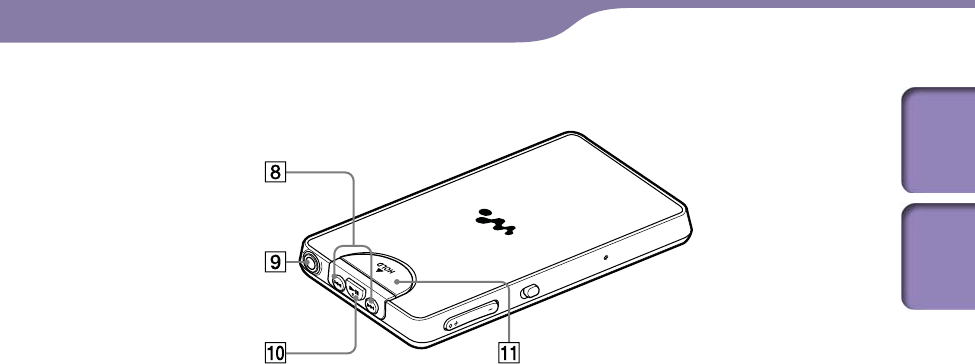
Basic Operations and Screens
7
7
Rear
/ buttons
Press to find the beginning of a song
or video, or to fast-forward/rewind.
Headphone jack
Connects the headphones ( page
8).
*1 button
Press the button to start
playback of a song or video. During
playback, press the button to
pause.
HOLD switch
Use the HOLD switch to disable the
buttons and touch panel to avoid
unintentional actions.
*1 There are tactile dots. Use them to help
with button operations.
Table of
Contents
Index
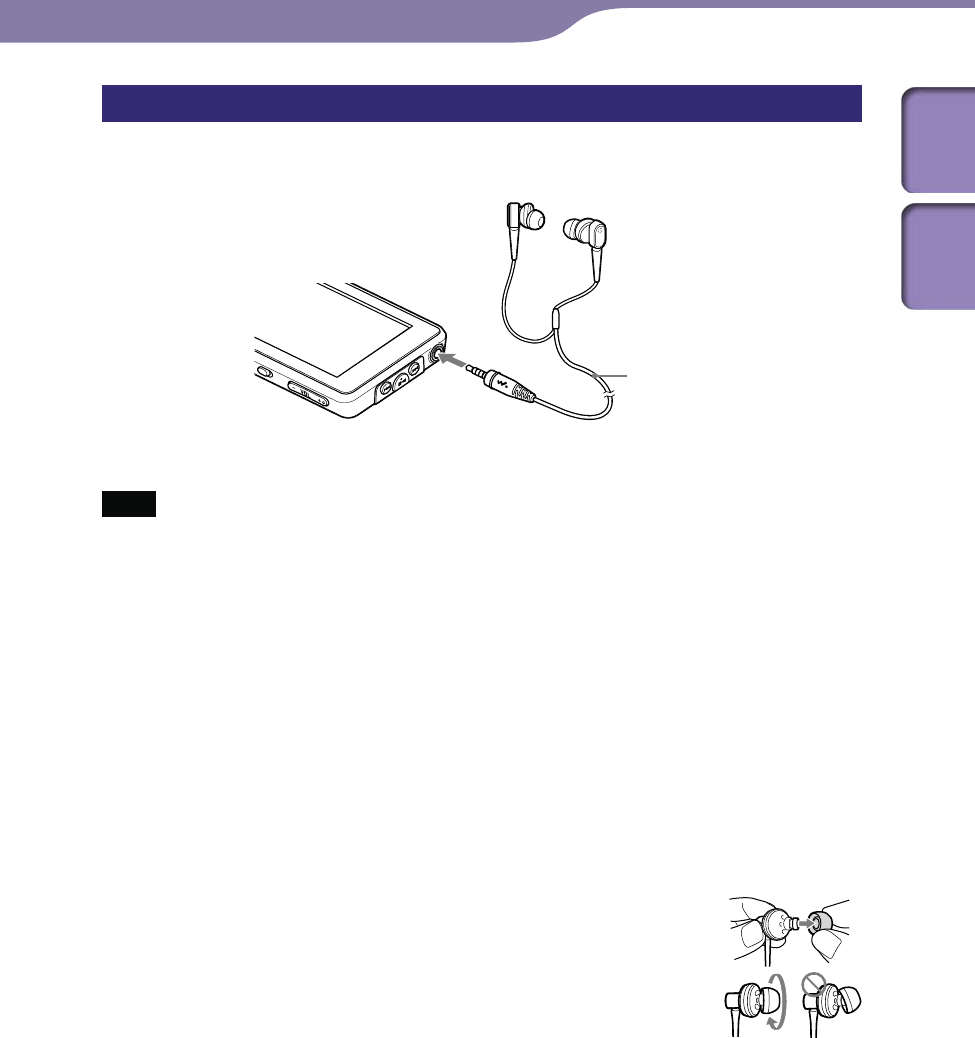
Basic Operations and Screens
8
8
Connecting the headphones
Plug the headphones into the headphone jack of the player until they click into
place. If the headphones are not connected correctly, the sound does not play.
Headphones
Note
The supplied headphones are exclusive to this player only. If you connect the supplied
headphones to another device, the sound may not play.
About the Noise Canceling function
The Noise Canceling function ( page 110) is enabled when using the
supplied headphones. The supplied headphones are exclusive to this player
only and cannot be used with other devices.
How to install the earbuds correctly
If the earbuds do not fit your ears correctly, low bass sound may not be heard
and the Noise Canceling function ( page 110) may not work effectively.
To enjoy better sound quality, change the size of the earbuds or adjust the
earbud position to fit your ears snugly.
At purchase, M size earbuds are installed. If the earbuds do not
fit your ears, try one of the other supplied sizes, S or L.
When you change the earbuds, twist to install them firmly on
the headphones to prevent the earbud from detaching and
remaining in your ear.
When the earbud is broken, purchase the optional earbuds
(EP-EX1).
L
L
Table of
Contents
Index
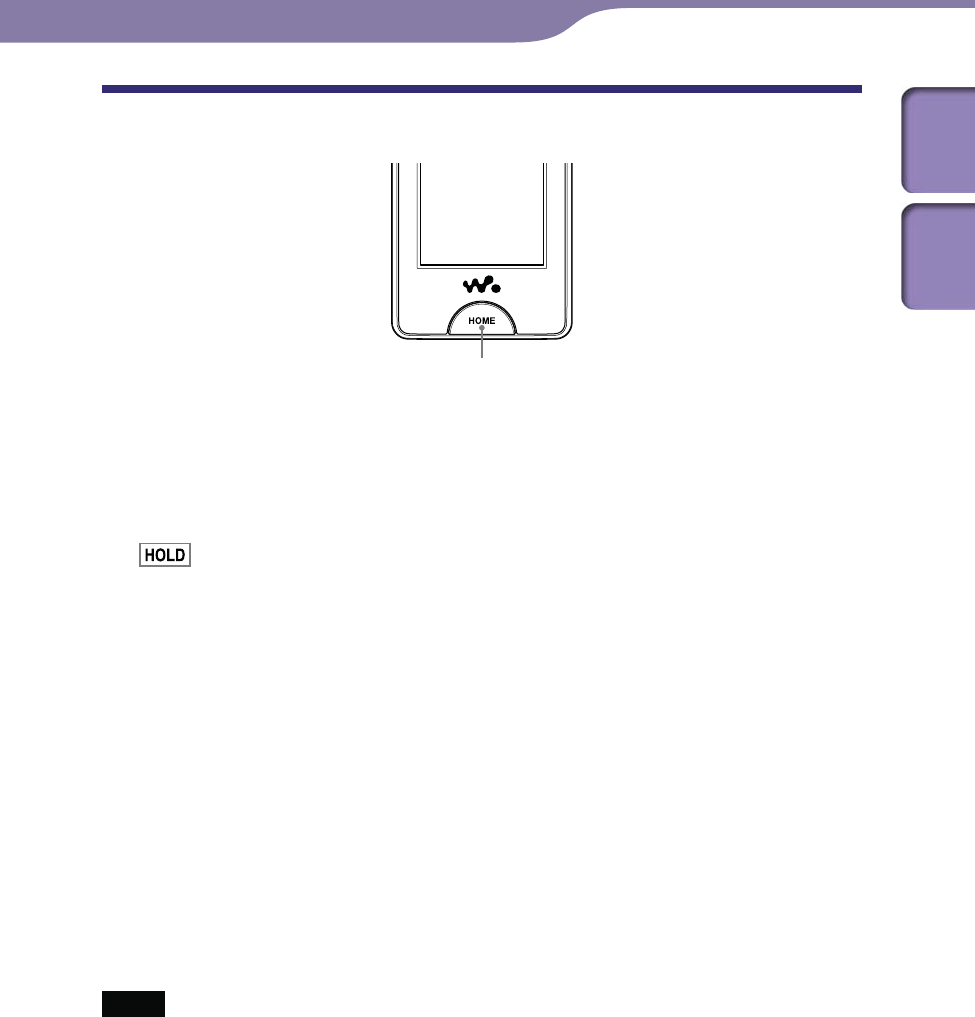
Basic Operations and Screens
9
9
Turning the Player On and Off
HOME button
To turn on the player
Press any button to turn the player on.
Hint
If appears on the top of the screen, slide the HOLD switch on the back of the
player in the opposite direction of the arrow to cancel the HOLD function.
To turn off the player
If you press and hold the HOME button, “POWER OFF” screen appears, then
the player enters the standby mode and the screen turns off.
Furthermore, if standby mode is retained for about one day, the player turns off
completely automatically.
Hints
After a lapse of time of the “Screen Off Timer” setting ( page 119), the screen turns
off, but you can still tap the screen to turn it on.
About 10 minutes after turning off the screen, the player enters the standby mode. You
cannot use the touch panel during the standby mode. Press any button of the player to
turn it on before using it.
Adjust the date and time of the player before using it ( page 26).
Notes
You cannot operate the player when it is connected to a computer. Disconnect the USB
cable before operating the player.
When connected to a computer via the USB cable, the resume information of the last
played song, video, photo, etc., is cleared. Reselect the desired content from the list
screen.
Table of
Contents
Index
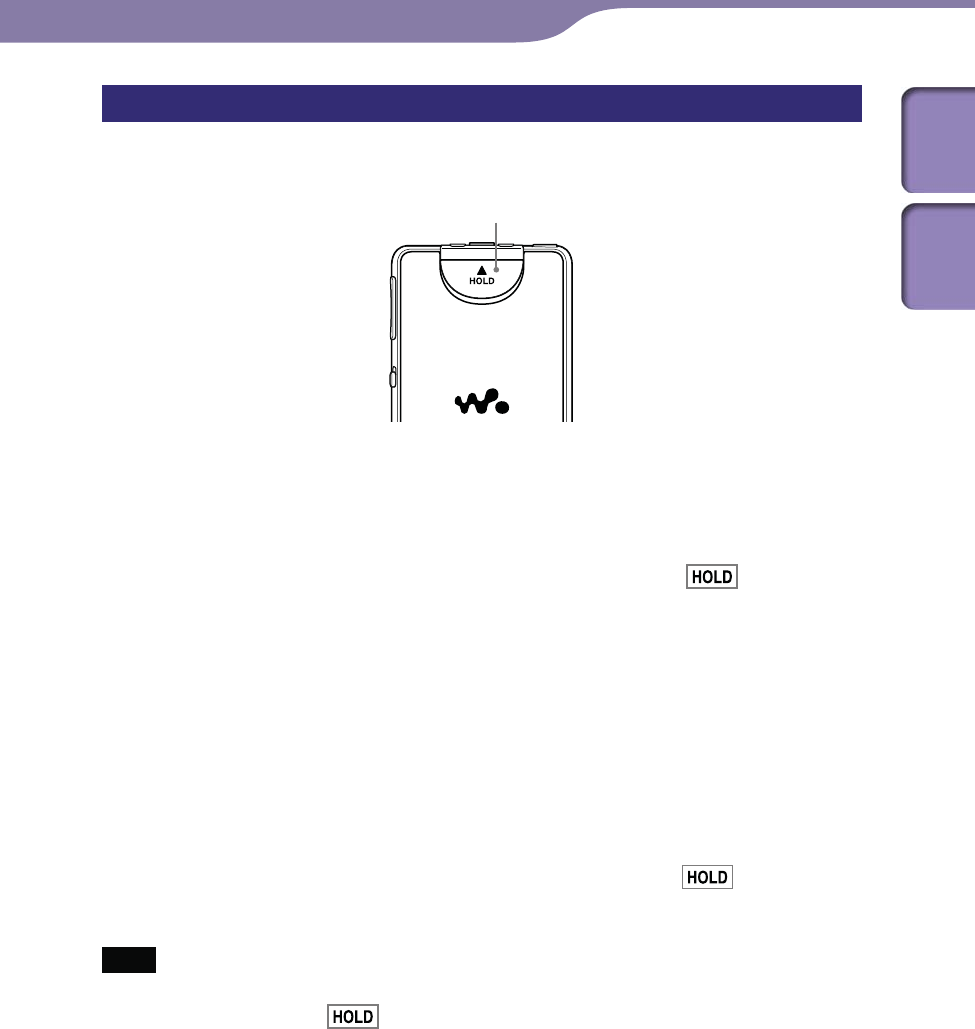
Basic Operations and Screens
10
10
Disabling the operation buttons and the touch panel
You can protect the player against accidental operation by using the HOLD
switch when carrying it.
HOLD switch
To lock the player
Slide the HOLD switch in the direction of the arrow .
The operation buttons and touch panel are disabled and appears on
the information area ( page 13).
Hint
You can also lock the touch panel only, keeping the operation buttons enabled ( page
123).
To unlock the player
Slide the HOLD switch in the opposite direction of the arrow .
The operation buttons and touch panel are enabled and on the
information area ( page 13) disappears.
Note
You cannot use the touch panel while the player is locked. If you press any button of the
player while it is locked, appears on the information area.
Table of
Contents
Index
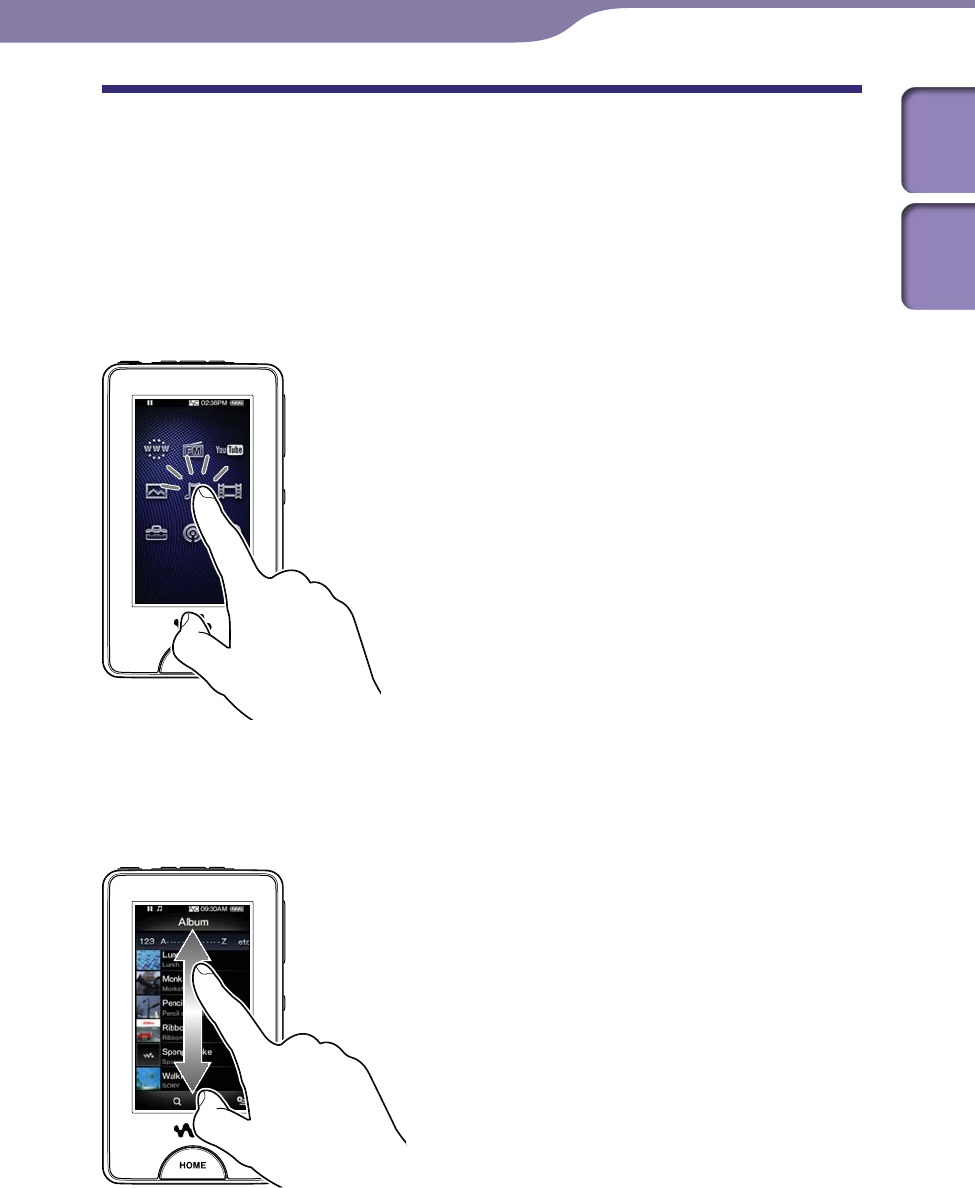
Basic Operations and Screens
11
11
How to Use the Touch Panel
You can use the touch panel screen to operate the player.
Tap an icon, item, control button, etc., on the screen to operate the player. Also,
drag up or down to scroll through a list, and flick to scroll quickly through a
list or thumbnails (reduced-size images that appear in a list).
Tapping to select
Touch (tap) an icon, item, control button, etc., to select it.
Dragging to scroll
Drag your finger up or down on the list to scroll through the list. Also, drag the
indicator along the Seek Slider to choose a starting point for the playback.
Continued
Table of
Contents
Index
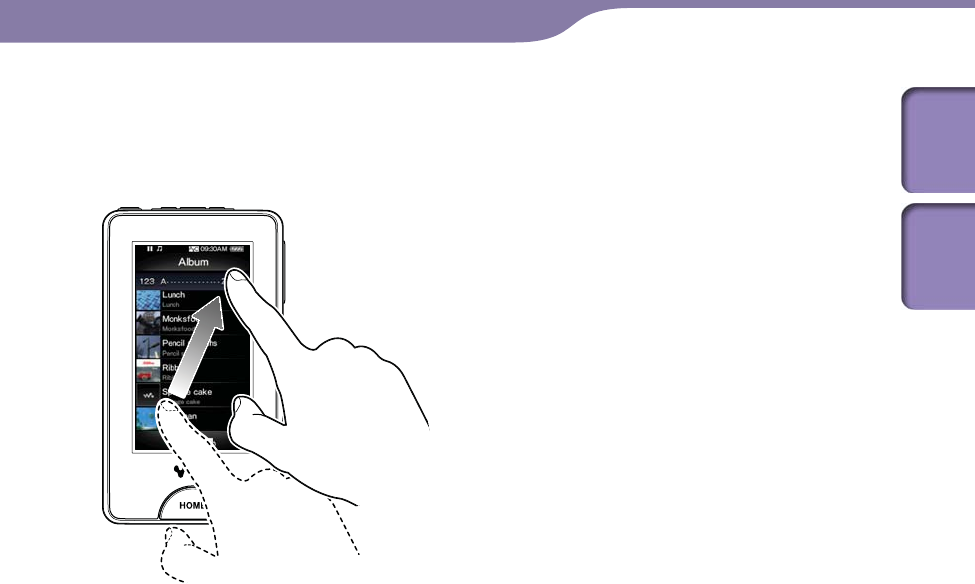
Basic Operations and Screens
12
12
Flicking to scroll quickly
Flick the screen up or down with your finger to scroll quickly through a list.
Also, flick up, down or sideways to see the next/previous album on the album
scroll screen, or to see the next/previous image on the scene scroll screen.
Notice for touch panel operations
The touch panel of the player does not work properly when operated with:
A gloved finger.
Two or more fingers.
A finger nail.
A wet finger.
A pen, ballpoint pen, pencil, stylus, etc.
Touching with other objects in addition to a finger.
Table of
Contents
Index
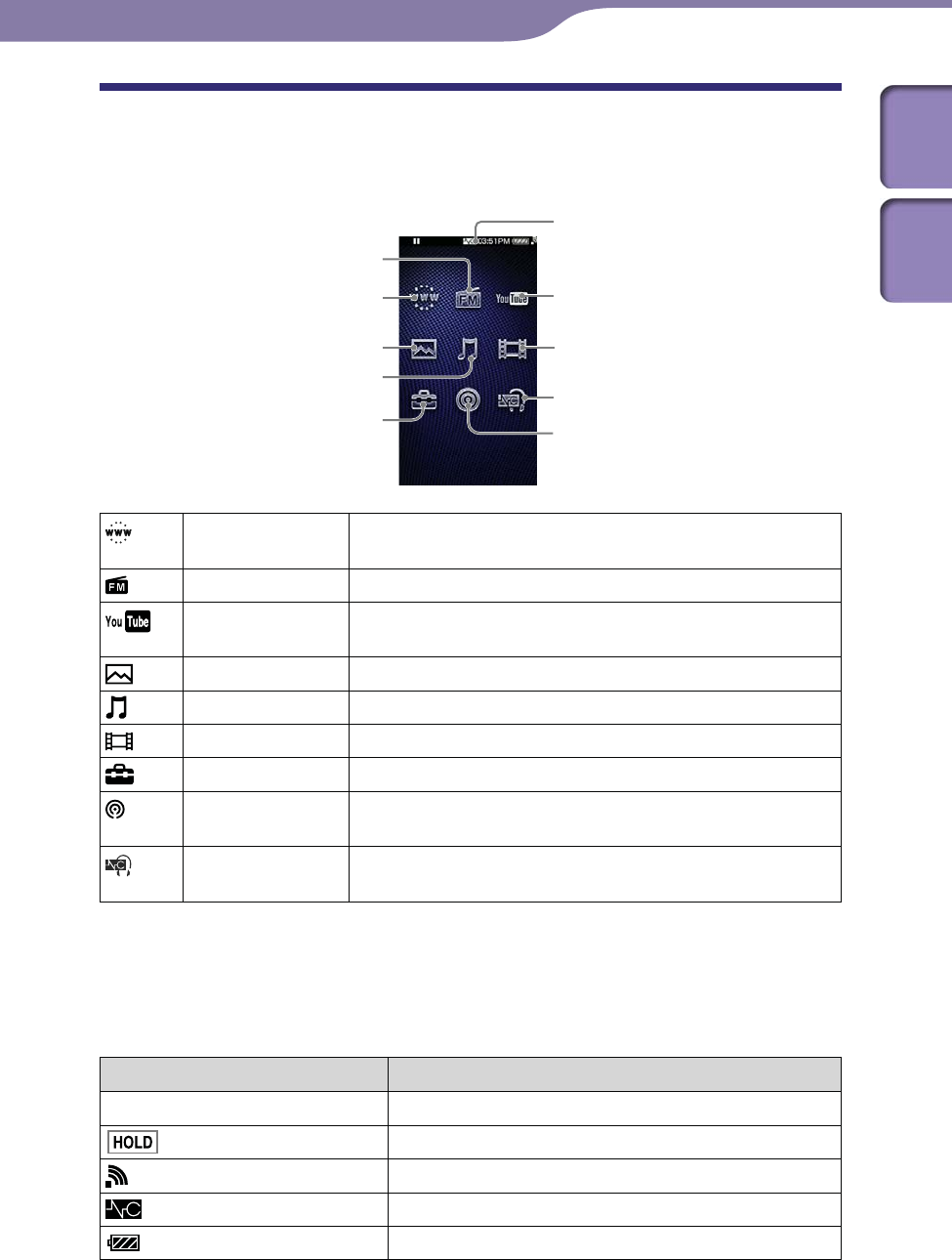
Basic Operations and Screens
13
13
About the Home Menu
The following table shows the item list of the player.
For details about each menu item, refer to the specified reference page.
FM Radio
Photos
Music
NC Modes
Settings
Information area
YouTube
Videos
Internet Browser
Podcasts
Internet Browser Browse websites over wireless Internet connection ( page
102).
FM Radio Listen to FM radio broadcasting ( page 71).
YouTube Watch videos on YouTube via wireless Internet connection
( page 77).
Photos View photos transferred to the player ( page 64).
Music Listen to songs transferred to the player ( page 37).
Videos Watch videos transferred to the player ( page 54).
Settings Set up the player and its applications ( page 118).
Podcasts Download podcast episodes via wireless Internet connection
and play them back ( page 83).
NC Modes Reduce unwanted ambient noise by active noise control
technology ( page 110).
About the information area
The icons, shown in the table below, appear in the information area. The icons
vary according to the playback status, settings or the screens.
For details about each icon, refer to the specified reference page.
Icons Description
, , , , , , etc. Playback status ( page 38, 55, 79, 91, 92)
Hold indication ( page 10)
Wireless communication status ( page 129)
Noise Canceling indication ( page 112)
Remaining battery power indication ( page 24)
Table of
Contents
Index
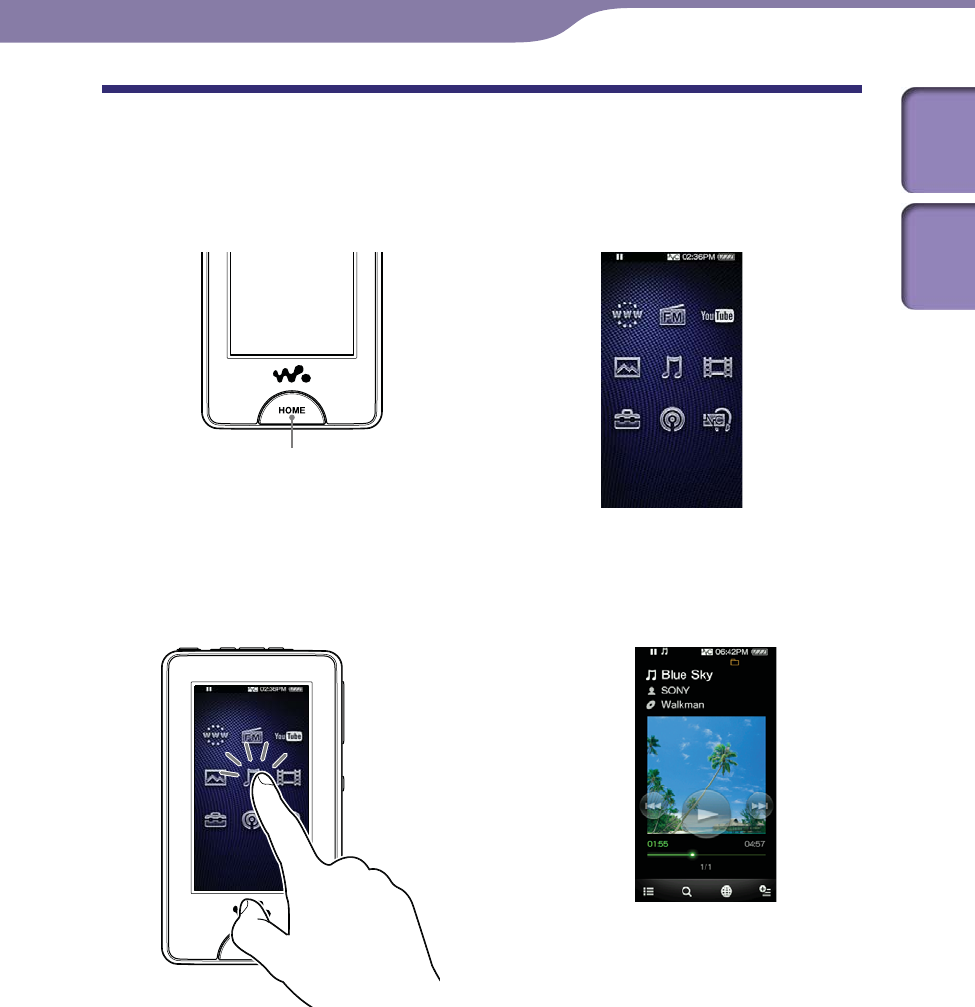
Basic Operations and Screens
14
14
How to Use the Home Menu
The Home menu is the starting point of each application, such as searching for
songs, changing settings, etc.
You can display the Home menu by pressing the HOME button of the player.
HOME button
From the Home menu, you can select the desired item on the screen by touch
panel operations ( page 11). On the playback screen of music, video, photo,
etc., you can operate the player by selecting the control button or item on the
screen.
Continued
Table of
Contents
Index
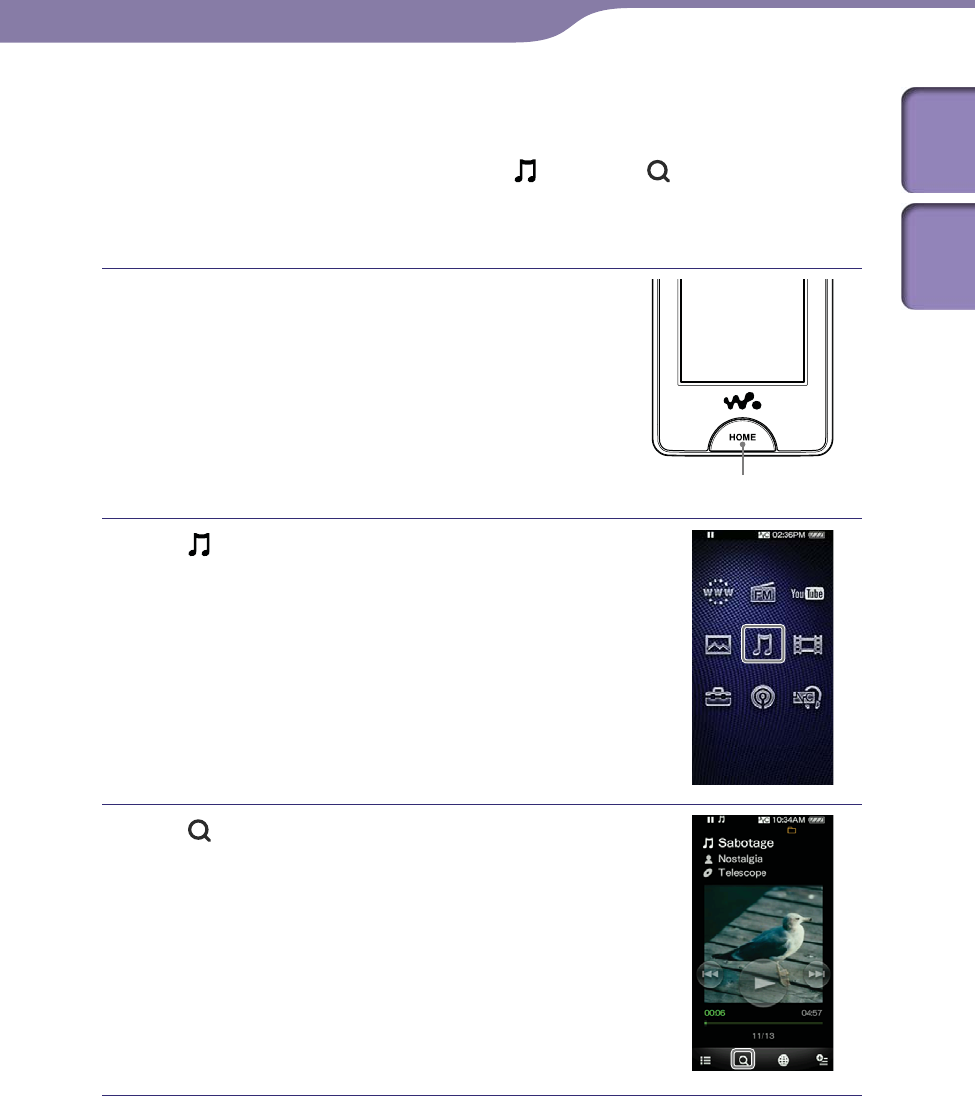
Basic Operations and Screens
15
15
In this manual, operating instructions from the Home menu are described as
below.
Example: From the Home menu, select (Music) (Search)
“Album” the desired album the desired song.
The actual operations for the example above are shown below.
Press the HOME button.
The Home menu appears.
HOME button
Tap (Music).
The music playback screen appears.
You can operate the player by tapping the
control buttons on the music playback
screen.
Tap (Search).
The search menu appears.
Continued
Table of
Contents
Index
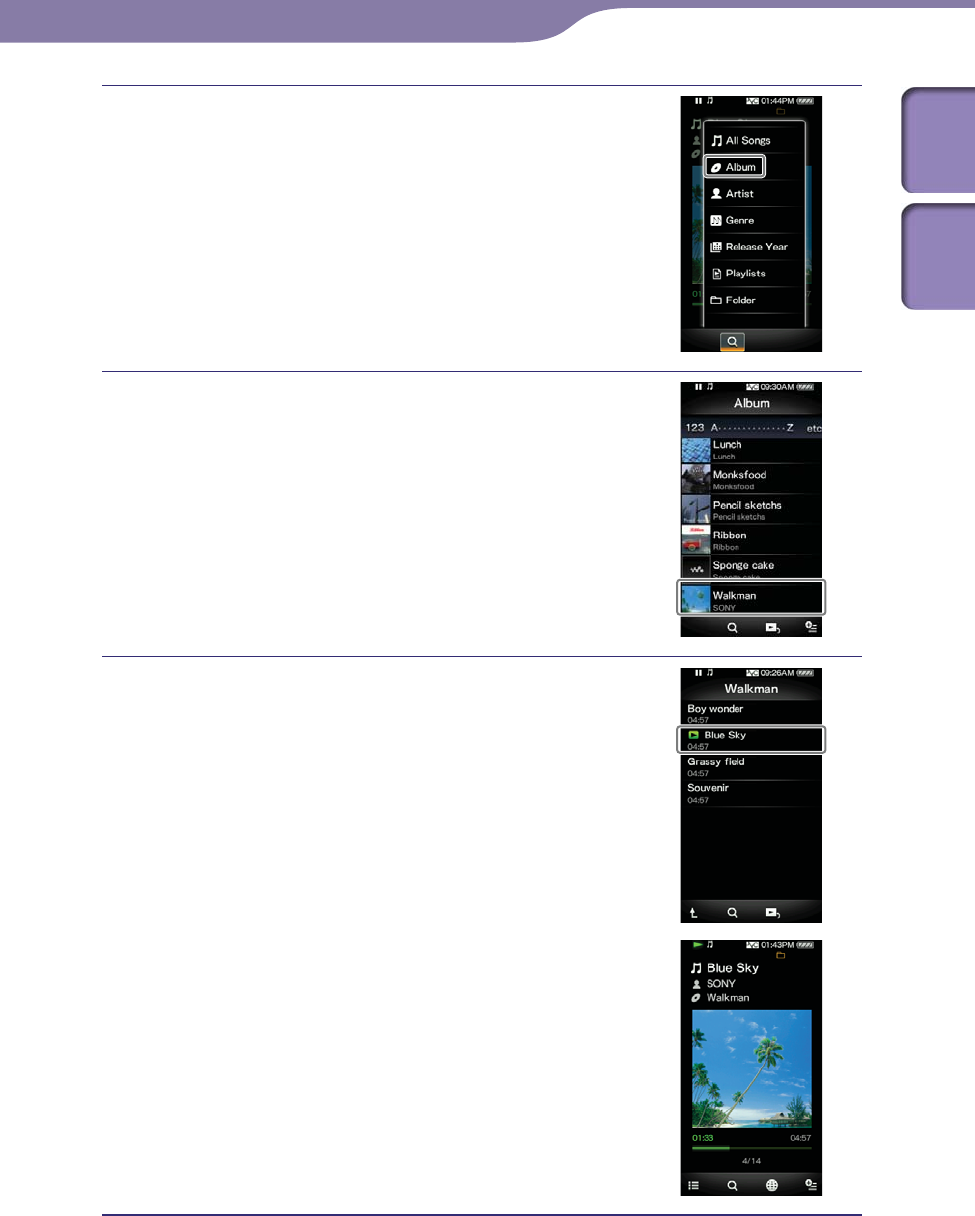
Basic Operations and Screens
16
16
Tap “Album.”
The album list screen appears.
You can scroll the list by dragging your
finger up or down.
Tap the desired album.
The song list screen of the selected album
appears.
Tap the desired song.
The music playback screen appears and
playback begins.
Continued
Table of
Contents
Index

Basic Operations and Screens
17
17
To return to the Home menu during operation
Press the HOME button.
To return to the previous screen during operation
Tap (To List)/ (Up).
Table of
Contents
Index
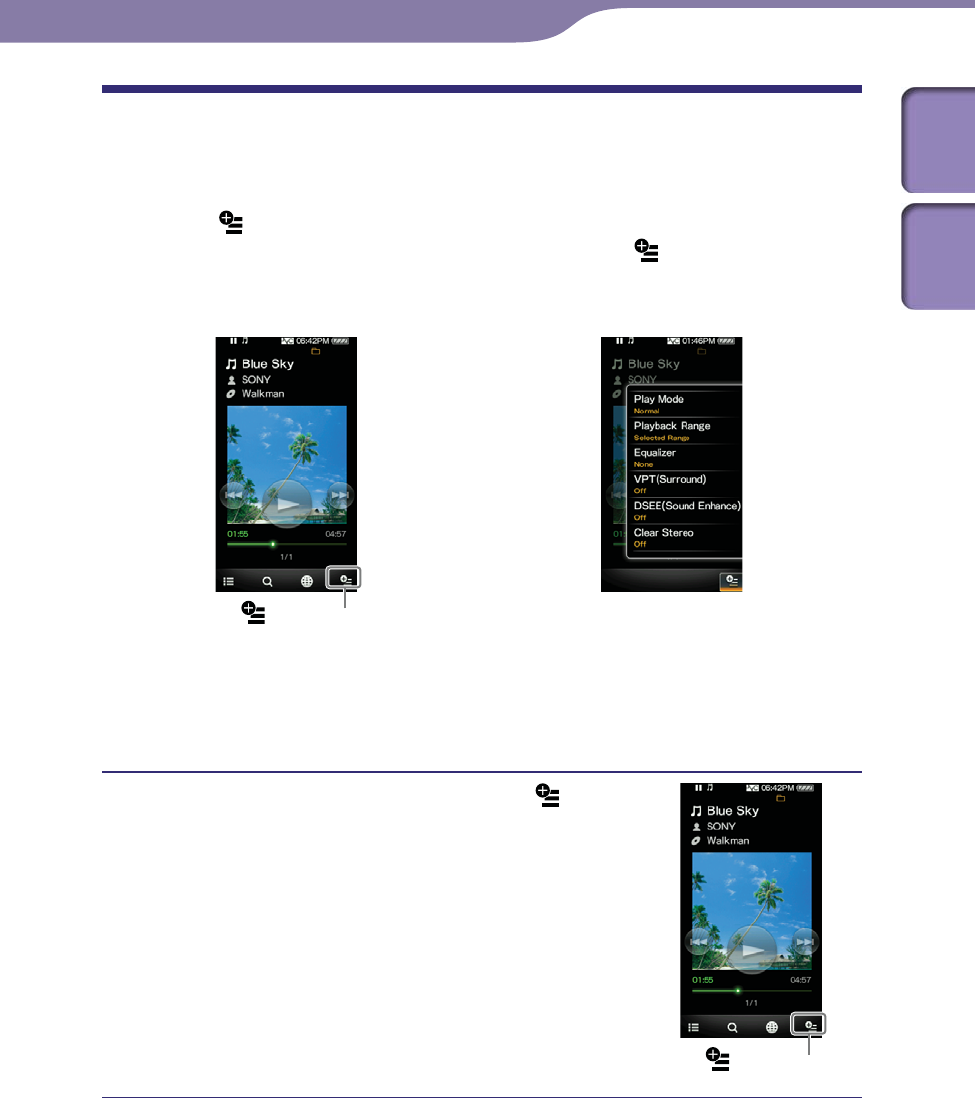
Basic Operations and Screens
18
18
How to Use the Option Menu
The option menu items vary function-to-function, allowing you to change the
settings of each application.
You can tap (Option Menu) on the playback screen or the list screen to
display the option menu. To close the option menu, tap (Option Menu) once
more.
Playback screen
(Option Menu)
Option menu
You can select the desired item on the option menu by touch panel operations
( page 11).
For example, the operations for setting “Play Mode” option to “Shuffle” are
shown below.
From the music playback screen, tap
(Option Menu).
The option menu appears.
(Option Menu)
Continued
Table of
Contents
Index
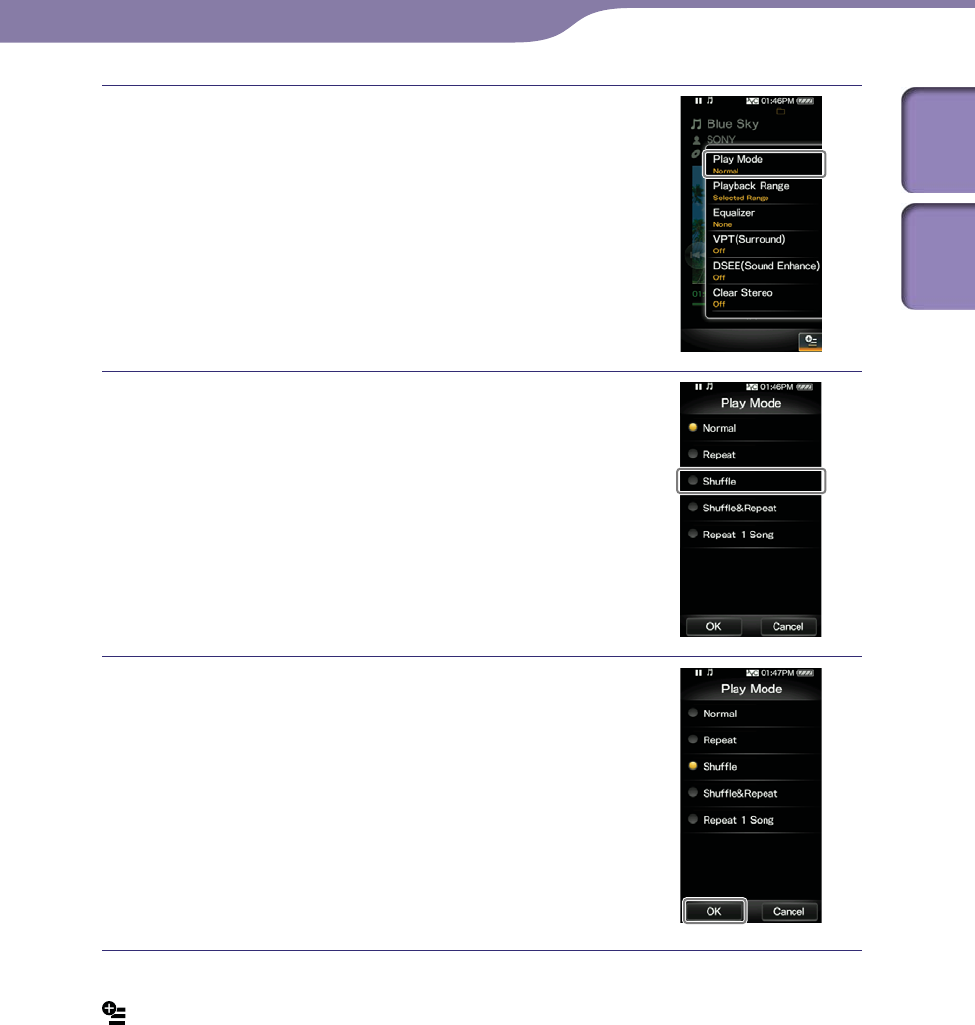
Basic Operations and Screens
19
19
Tap “Play Mode.”
Tap “Shuffle.”
Tap “OK.”
The play mode changes to “Shuffle.”
The items of the option menu differ, depending on the screen on which you tap
(Option Menu).
For details, see the following pages.
“Using the Music Option Menu” ( page 45)
“Using the Video Option Menu” ( page 60)
“Using the Photo Option Menu” ( page 69)
“Using the FM Radio Option Menu” ( page 76)
“Using the YouTube Option Menu” ( page 82)
“Using the Podcast Option Menu” ( page 100)
Table of
Contents
Index
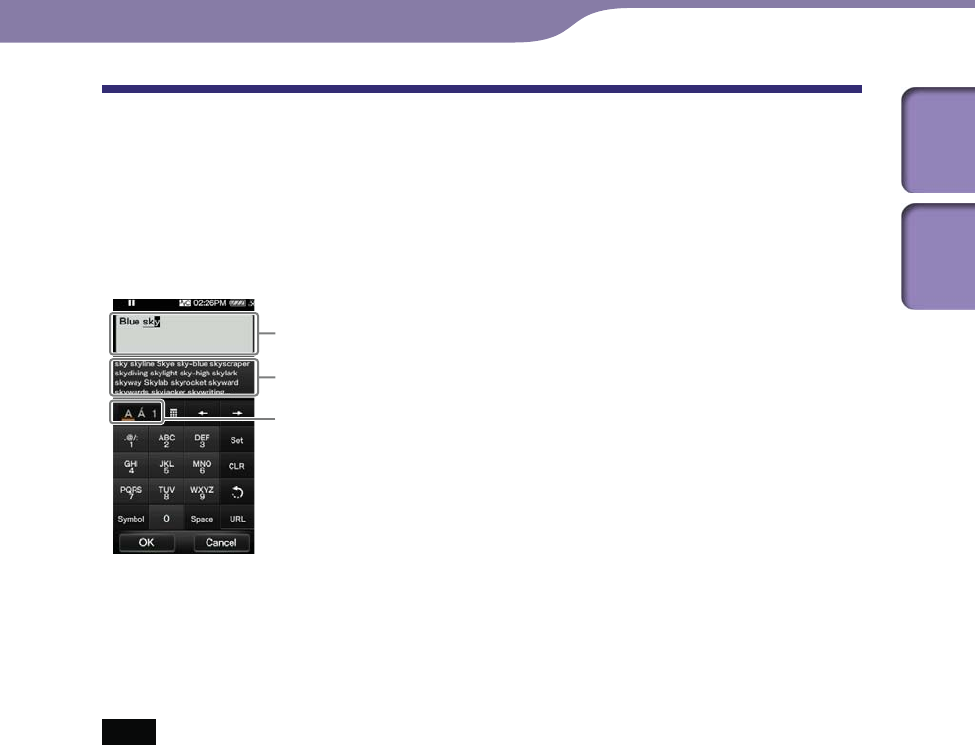
Basic Operations and Screens
20
20
Text Input
You can use the onscreen keyboard to enter text.
Select a text field you intend to enter text into, such as a web page address
entry, to bring up the onscreen keyboard.
Example: Alphanumeric keyboard for English
Input field
Predictive texts field
(English and Chinese only)
Input mode key
Changing the input mode (key assign)
As you tap the Input mode key, the key assignment changes cyclically. The key
assign maps vary depending on the language.
Note
Depending on the text field, you may not be able to change the input mode because of
character restrictions.
About the Chinese input method
You can use the pinyin input method (for simplified Chinese) and the zhuyin
input method (for traditional Chinese) to input Chinese text.
About the predictive text function
The onscreen keyboard for English and Chinese are implemented with
predictive text function. As you enter a character, the predictive text function
displays candidate words below the text you have entered. You can reduce the
number of keystrokes by selecting one of these words. To select, tap the
predictive text field to display the full list, drag the list to find the desired word,
then tap it to add to the text you have entered.
Hint
You can use the URL predictive text function by tapping the “URL” key in the
alphanumeric input mode. Candidate words for URL input that begin with the entered
characters appear in the predictive text field. If you tap the predictive text field, the full
list of the candidate words for URL input appears.
Continued
Table of
Contents
Index

Basic Operations and Screens
21
21
Entering text
The following example shows how to enter “Blue” in the alphanumeric input
mode.
Tap the “ABC2” key five times.
“B” appears in the input field.
Each time you press the key, the character changes.
Tap the “” key.
The text cursor moves to the right of the “B.”
Tap the “JKL5” key three times.
“l” appears in the input field.
Tap the “” key.
The text cursor moves to the right of the “l.”
Tap the “TUV8” key three times.
”u” appears in the input field.
Tap the “” key.
The text cursor moves to the right of the “u.”
Tap the “DEF3” key three times.
”e” appears in the input field.
Tap the “Set” key.
”Blue” in the input field is confirmed.
Tap the “OK” key.
The onscreen keyboard disappears and the text “Blue” is entered in the
text field that brought up the keyboard.
Continued
Table of
Contents
Index

Basic Operations and Screens
22
22
About the Bundled Software
Windows Media Player 11
Windows Media Player can import audio data from CDs and transfer data to
the player. When you use copyright protected WMA audio files and copyright
protected WMV video files, use this software.
Transferable files: Music (MP3, WMA), Video (WMV), Photo (JPEG)
For details on operation, refer to the Help of the software or visit the following
website.
http://www.support.microsoft.com/
Hint
Some computers that already have Windows Media Player 10 installed may encounter
file limitations (AAC, video files, etc.) when transferring by drag-and-drop. If you install
Windows Media Player 11 from the supplied CD-ROM, you can solve this problem, then
you can transfer by drag-and-drop again. Before installing Windows Media Player 11 on
your computer, make sure to check whether your software or service corresponds to
Windows Media Player 11.
Media Manager for WALKMAN*1
Media Manager for WALKMAN can transfer music, photos or videos from the
computer to the player and import audio data from CDs. Media Manager for
WALKMAN can also subscribe to RSS feeds and transfer the music and video
files that have been downloaded from Podcasts. For details on operation, refer
to the Help of the software. Audio files (AAC) or videos can also be transferred
by drag-and-drop using Windows Explorer as well as Media Manager for
WALKMAN.
Transferable files: Music (MP3, WMA, AAC*2, WAV), Photo (JPEG), Video
(MPEG-4 Simple Profile, AVC (H.264/AVC) Baseline Profile, WMV*2*3),
Podcast (music, video)
*1 Media Manager for WALKMAN is not bundled with the packages sold in the U.S.A.
Please download it from the following web site:
http://www.sonycreativesoftware.com/download/wmm_lite
*2 DRM files are not compatible.
*3 Some WMV files cannot be played back after being transferred by Media Manager for
WALKMAN. If you retransfer them using Windows Media Player 11, they may become
playable.
Note
Copyright protected video files, such as DVD movies or recorded digital television
programs, are not supported.
Table of
Contents
Index

Basic Operations and Screens
23
23
Content Transfer
Content Transfer can transfer music, videos or photos from a computer to the
player by a simple drag-and-drop operation. You can use Windows Explorer or
iTunes® to drag and drop data to Content Transfer. Furthermore, if you transfer
a podcast from iTunes® to the player, the podcast is registered to the player,
allowing you to download the podcast’s episodes by using the wireless LAN
function of the player. For details on operation, refer to the Help of the
software.
Transferable files: Music (MP3, WMA, AAC*1, WAV), Photo (JPEG), Video
(MPEG-4 Simple Profile, AVC (H.264/AVC) Baseline Profile, WMV*1*2),
Podcast (music, video)
*1 DRM files are not compatible.
*2 Some WMV files cannot be played back after being transferred by Content Transfer. If
you retransfer them using Windows Media Player 11, they may become playable.
Hints
ATRAC files can be transferred to the player after conversion to MP3 file format. To
convert files, download the MP3 Conversion Tool from the customer support website
( page 170).
You can register podcasts to the player by using iTunes® and Content Transfer. To
register, drag and drop the title of a podcast from iTunes® to Content Transfer.
Table of
Contents
Index
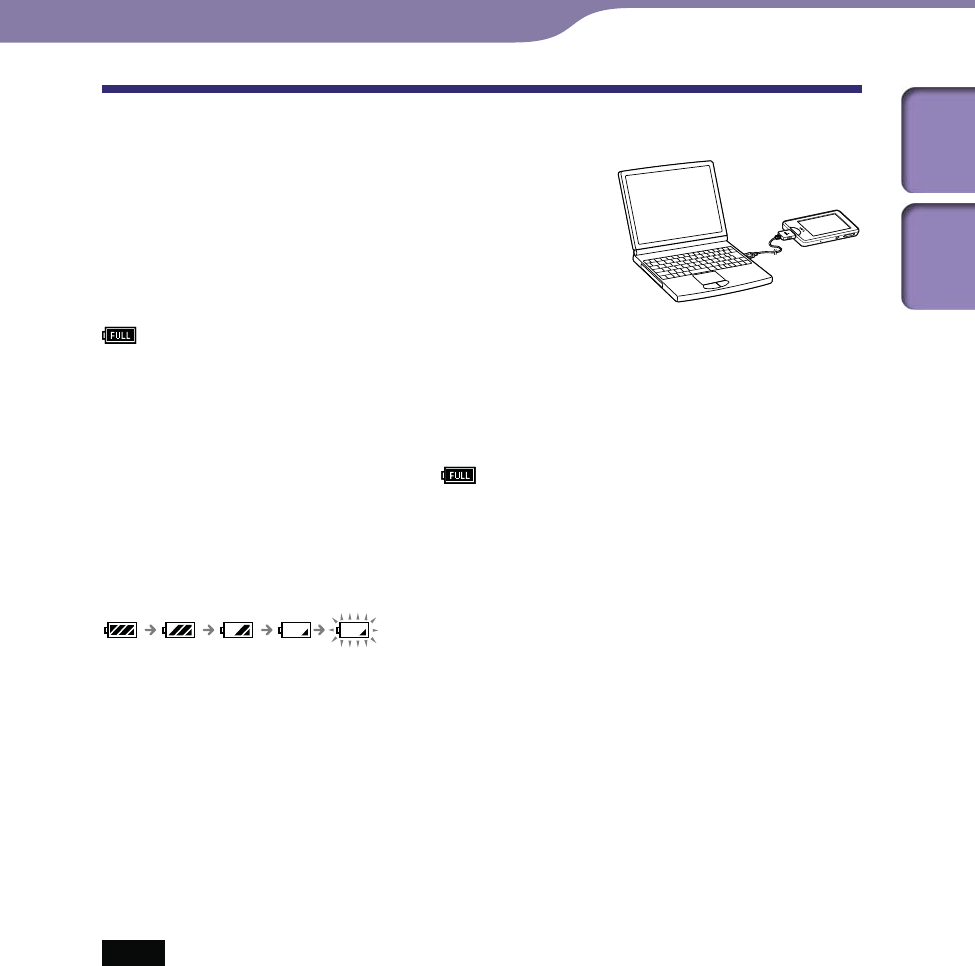
Preparing the Player
24
24
Charging the Player
The player’s battery is recharged while the player is
connected to a running computer.
When you connect the player to your computer, use
the supplied USB cable.
When the remaining battery power indication on
the upper right-hand corner of the display shows:
, charging is completed (charging time is approx. 3 hours).
If the remaining battery power indication is not displayed, press the HOME
button of the player to display it.
When you use the player for the first time, or if you have not used the player
for a long time, recharge it fully (to in the remaining battery power
indication of the display).
About the battery indicator
The battery icon in the information area shows remaining battery charge.
As the battery power gets lower, the bars of the icon disappear. If “LOW
BATTERY. Please Charge.” appears, you cannot use the player. In this case,
charge the battery by connecting to your computer. See page 176 on battery
duration.
Hint
While charging, after a lapse of time of the “Screen Off Timer” setting ( page 119), the
screen turns off. To see the charging status or other indications, press the HOME button
to turn on the screen.
Notes
Charge the battery in an ambient temperature of between 5 ºC to 35 ºC (41 ºF to 95 ºF).
The number of times the battery can be recharged before it is used up is approximately
500 times. This number may vary, depending on the conditions under which you use the
player.
The battery indicator on the display is only an estimate. For example, one section of
black in the indicator will not always indicate exactly one-fourth of the battery’s charge.
“Do not disconnect.” appears in the display while the player accesses the computer. Do
not disconnect the supplied USB cable while “Do not disconnect.” appears or data being
transferred may be damaged.
The touch panel and control buttons on the player are all disabled while it is connected
to a computer.
If you do not intend to use the player for over half a year, charge the battery at least once
per 6 to 12 months for battery maintenance.
Continued
Table of
Contents
Index

Preparing the Player
25
25
Some USB devices connected to the computer may interfere with the proper operation
of the player.
We do not guarantee the recharge of the battery using personally assembled computers
or modified computers.
If the computer enters a power saving mode, such as the sleep or hibernation mode,
while the player is connected via the USB cable, the player’s battery is not charged.
Instead, the player continues to draw power from the battery, discharging it.
Do not leave the player connected for extended periods to a laptop computer that is not
connected to AC power, because the player may discharge the computer’s battery.
While the player is connected to a computer, do not turn on, restart, wake up from sleep
mode, or shut down the computer. These operations may cause the player to
malfunction. Disconnect the player from the computer before performing these
operations.
When connected to a computer via the USB cable, the resume information of the last
played song, video, photo, etc., is cleared. Reselect the desired content from the list
screen.
Table of
Contents
Index
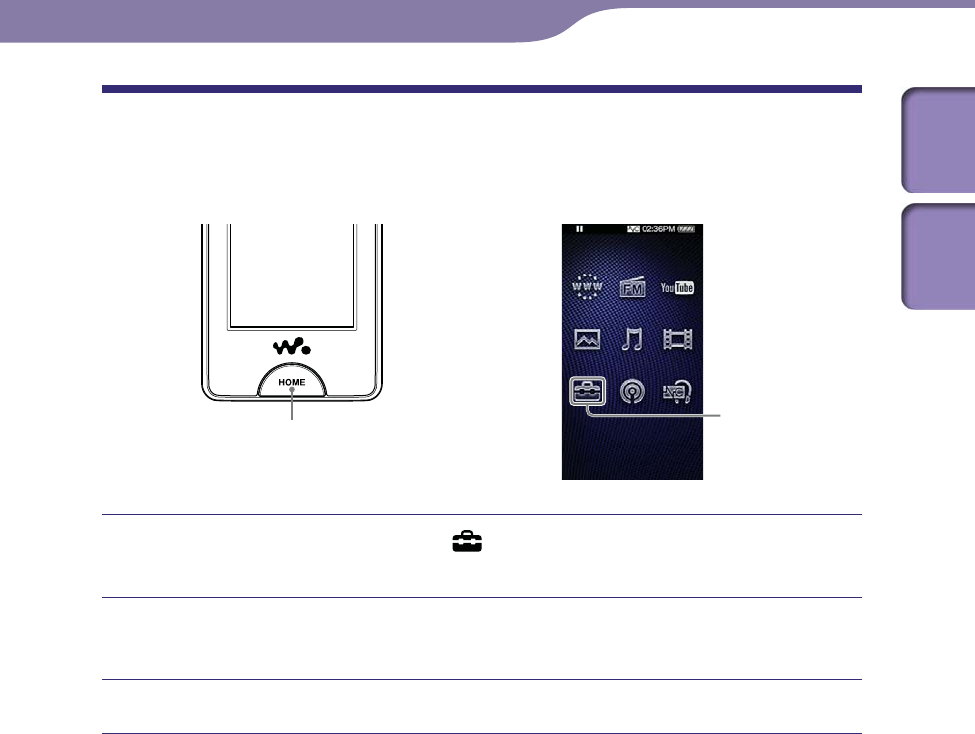
Preparing the Player
26
26
Setting the Date and Time
Some applications of the player do not work correctly until the date and time
are set. Set the current date and time before using the player.
HOME button Settings
From the Home menu, select (Settings) “Common Settings”
“Clock Settings” “Set Date-Time.”
Drag or flick the year, month, date, hour and minute up or down to
adjust the date and time.
Select “OK.”
Table of
Contents
Index
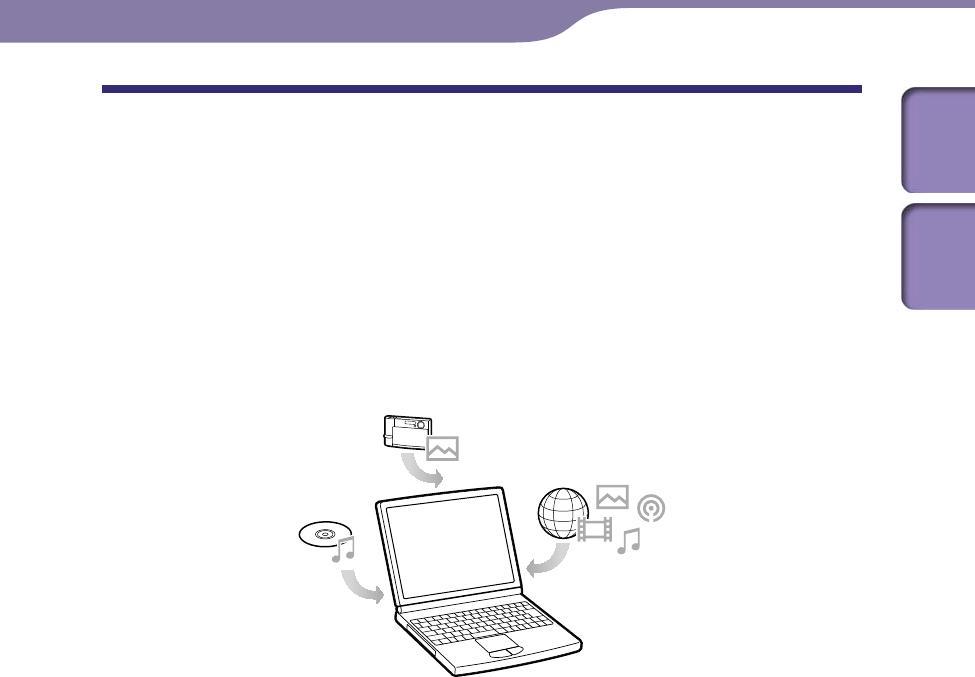
Preparing the Player
27
27
Getting Music/Videos/Photos/Podcasts
To enjoy music, videos, photos and podcasts on the player, you need to prepare
the data on your computer.
You can import music from audio CDs or from the Internet, etc. You can
import videos from recorded videos or from the Internet, etc. You can import
photos from a digital camera, etc.
To import the data into your computer, use appropriate software. For detailed
information on how to import data, refer to the Help of each software.
For details about supported file formats, see “Supported file format” ( page
173).
Hint
You can connect the player to the Internet by using the wireless LAN function to
download podcast episodes without using a computer ( page 84).
Table of
Contents
Index

Preparing the Player
28
28
Transferring Music/Videos/Photos/Podcasts
You can directly transfer data by drag-and-drop using Windows Explorer on
your computer.
Playable data hierarchy has rules. To transfer data properly, see the following
instructions.
For details about the bundled software that can transfer data, see page 22.
Hints
Some computers that already have Windows Media Player 10 installed may encounter
file limitations (AAC, video files, etc.) when transferring by drag-and-drop. If you install
Windows Media Player 11 (for details, see “Installing the Operation Guide and software”
of “Quick Start Guide”) from the supplied CD-ROM, you can solve this problem, then
you can transfer by drag-and-drop again. Before installing Windows Media Player 11 on
your computer, make sure to check whether your software or service corresponds to
Windows Media Player 11.
Data hierarchy may differ, depending on your computer environment.
Some WMV files can be played back only by transferring using Windows Media Player
11.
Notes
Do not disconnect the USB cable while “Do not disconnect.” appears on the player, or
the data being transferred may be damaged.
If you turn on or restart the computer while the player is connected to the computer, the
player may malfunction. In this case, press the RESET button of the player to reset it (
page 143). Disconnect the player from the computer before turn on or restart the
computer.
You cannot change the following folder names or delete them: “MUSIC,” “MP_ROOT,”
“MPE_ROOT,” “VIDEO,” “PICTURES,” “PICTURE,” “DCIM,” “PODCASTS” and
“FEEDS.”
Do not change the folder or file names directly under the “MP_ROOT” folder or “MPE_
ROOT” folder. Otherwise, they will not be displayed on the player.
Connect the player to your computer using the supplied USB
cable.
Insert the connector of the USB cable into the player with the mark
facing up.
Select the player on Windows Explorer, and then drag and drop
files.
The player appears on Windows Explorer as [WALKMAN].
Continued
Table of
Contents
Index

Preparing the Player
29
29
For songs
(On Windows Explorer)
Drag and drop files or folders into the “MUSIC” folder.
However, folders and files beyond the 8th level will not be
recognized.
Note
Do not change the folder name or delete the “MUSIC” folder.
(On the player)
Folders are displayed in the folder name order first, then files are displayed in
the file name order. In this case, upper or lower case letters are not
distinguished.
Continued
1st
7th
8th
9th
Table of
Contents
Index

Preparing the Player
30
30
For videos
(On Windows Explorer)
Drag and drop files or folders into the “VIDEO” folder.
Files on the 1st to 8th level will be recognized. However, files
beyond the 8th level will not be recognized.
Note
Do not change the name of the “VIDEO” folder. If renamed, the folder will not be
displayed on the player.
(On the player)
In default setting, video files are displayed in the order they are transferred by
drag-and-drop operation. (The latest data is at the top.)
Hints
You can arrange the video list by transfer date or by video title ( page 63).
You can set JPEG files as a thumbnails of video files, by placing JPEG files in the
corresponding video folders. When you display the video list, you can see the
thumbnails (small pictures to display on the menu) for the video files on the player. To
display a thumbnail for a video file, create a JPEG file (horizontal 160 × vertical 120 dots,
extension: .jpg) and name it the same as the desired video file, then store it in the video
file folder.
The maximum video size playable on the player is 320 × 240. For detailed specifications,
see “Specifications” ( page 173).
Continued
1st
7th
8th
9th
Table of
Contents
Index

Preparing the Player
31
31
For photos
(On Windows Explorer)
Drag and drop files or folders into the “PICTURE,” “PICTURES”
or “DCIM” folder.
Files on the 1st to 8th level will be recognized. However, files
beyond the 8th level will not be recognized.
Notes
Do not change the name of the “PICTURE,” “PICTURES” and “DCIM” folders. If
renamed, the folder will not be displayed on the player.
(On the player)
Photo files are displayed in alphabetical order. The files under the “PICTURE,”
“PICTURES” and “DCIM” folders are displayed in the “PICTURE,”
“PICTURES” and “DCIM” folders respectively.
If there are any folders under the “PICTURE,” “PICTURES” and “DCIM”
folders, they appear as folders. Tap the desired folder to display the photo files
within the folder.
Continued
1st
7th
8th
9th
Table of
Contents
Index

Preparing the Player
32
32
For podcasts
(On Windows Explorer)
Drag and drop podcast folders into the “PODCASTS” folder and
episode files into the podcast folders.
On the 1st level, the “PODCASTS” folder will recognize only
folders. Episode files on the 1st level will not be recognized. On
the 2nd level, only files will be recognized and any folders will
not be recognized. Beyond the 2nd level, neither files nor folders
will be recognized.
(On the player)
Podcast folders under the “PODCASTS” folder are displayed in alphabetical
order.
Episode files under the podcast folders are displayed in reverse chronological
order. The episode files transferred using Windows Explorer are displayed
under the reverse chronological order list, in alphabetical order.
Hints
You can connect the player to the Internet by using the wireless LAN function to register
podcasts, download episodes and play them back ( page 84).
Notes
Do not change the name of the “PODCASTS” folder. If renamed, it will not be displayed
on the player.
You cannot refresh the podcasts transferred by Windows Explorer, even after you
connect the player to the Internet via wireless LAN. To refresh a podcast, register it by
using the player ( page 84) or by using Media Manager for WALKMAN ( page 22).
1st
2nd
3rd
Table of
Contents
Index
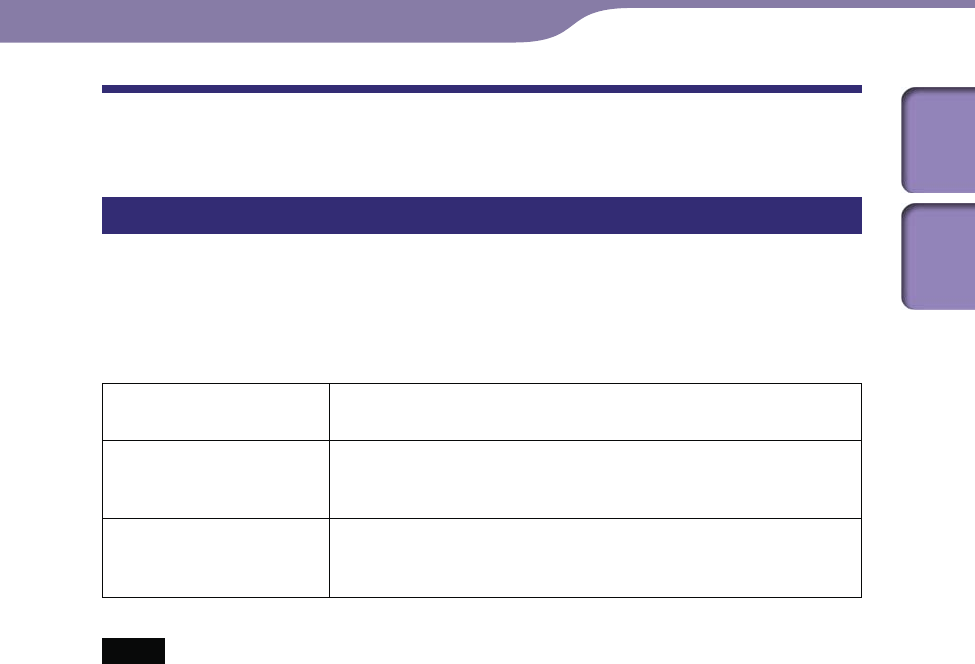
Preparing the Player
33
33
Wireless LAN Connection
Wireless networks which may be used with the player
The player can connect to the following wireless LANs.
Your Home wireless LAN
Your office or school wireless LAN
Public wireless LANs, such as at coffee shops, hotels, or libraries.
Standard IEEE 802.11b
IEEE 802.11g
Security WEP (128 bit/64 bit, Open System Key)
WPA-PSK (TKIP/AES)
WPA2-PSK (TKIP/AES)
Communication range Approx. *** ft (30 m)
(The communication range may vary, depending on conditions
of use and settings.)
Notes
To connect to an access point, the SSID and encryption key may be required. For the
necessary settings ( page 127), consult the person who installed the access point. For
the settings of the access point, refer to the operation guide of the access point, or
consult the manufacturer of the access point.
For the necessary settings ( page 127) to connect to a wireless LAN, ask the
administrator of the network (at office/school) or the public Internet access service
provider.
The player does not support security systems customized in some access points. For
details, refer to the operations guide for the access point.
The player does not support AOSS (AirStation One-Touch Secure System).
Set the “WLAN Function On/Off” option to “Off ” where the network connection is
restricted or prohibited, such as in a hospital or in an airplane ( page 127).
Some public wireless LAN services require log-in by using the Internet browser.
Table of
Contents
Index

Preparing the Player
34
34
Connecting to a wireless LAN
To connect to a wireless LAN, select the desired access point from a list, then
enter the encryption key if necessary.
Usually, when the connection is required by the Internet browser, YouTube or
Podcast, the connection confirmation screen appears automatically to connect
to a wireless LAN. The following instructions use the Internet browser as an
example. Move within the communication range of the access point you intend
to connect to before beginning the operation.
To connect to an access point by using the WPS method, see “New
Registration” ( page 128).
Notes
To connect to an access point using the WPS method, refer to “New Registration” (
page 127) to register the access point before connecting to it.
Set the “WLAN Function On/Off” option to “On” before connecting to a wireless LAN
( page 127). The default setting is “Off.”
HOME button
Internet Browser
From the Home menu, select (Internet Browser).
The connection confirmation screen appears.
Select “Yes.”
The Select Access Point screen appears.
On the screen, registered access points and
access points that are installed within the
communication range of the player are
displayed in a list.
Yes
Continued
Table of
Contents
Index

Preparing the Player
35
35
Select the access point you want to
connect to from the list.
If an encryption key is required, the entry
screen appears.
When no encryption key is required, the
connecting dialog box appears. After
establishing the connection, the Internet
browser appears.
Select “WEP Key” or “WPA Key,” enter the
encryption key, then select “OK.”
The connecting dialog box appears. After
establishing the connection, the Internet
browser appears.
For how to input text, see “Text Input” (
page 20).
To register the access point, check “Save
encryption key.” After registering, you can
connect to the access point by simply
selecting it from the Select Access Point
screen.
If you do not know the WEP key or WPA key
for the access point, refer to the operation
guide for the access point, or consult the
administrator of the network or the public
Internet access service provider.
WEP Key or WPA Key
If you cannot connect
Some access point require more detailed settings. See “Changing the Wireless
LAN Settings” ( page 127) to set up. If you are not sure about the settings,
ask the person who installed the access point, the administrator of the wireless
LAN, or the public Internet access service provider.
Continued
Table of
Contents
Index

Preparing the Player
36
36
Notes
If the “WLAN Function On/Off” option is set to “Off,” the player cannot connect to the
wireless LAN.
While connected to a wireless LAN, if the player enters standby mode, is turned off, or is
connected to a computer via the USB cable, it is disconnected from the wireless LAN.
Some public wireless LAN services require log-in by using the Internet browser. In this
case, until you log in at the log-in site, you cannot browse other websites, cannot watch
YouTube, and cannot download podcast episodes. For details, consult with the public
Internet access service provider.
Be sure to check that the access point you intend to register is secure before registering
it.
Hint
You can register an access point from the Home menu, (Settings) “Wireless LAN
Settings” “New Registration” before connecting to it ( page 128). Also, you can
register an access point in this step if the desired access point does not appear in the list
of the Select Access Point screen.
Disconnecting from a wireless LAN
From Home menu, select (Settings) “Wireless LAN Settings”
“Disconnect from Network” “Yes.”
Notes
While connected to a wireless LAN, the battery is consumed quickly. Set the “WLAN
Function On/Off ” option to “Off ” when you do not intend to use the connection for the
time being.
Set the “WLAN Function On/Off” option to “Off ” where the network connection is
restricted or prohibited, such as in a hospital or in an airplane ( page 127).
Table of
Contents
Index
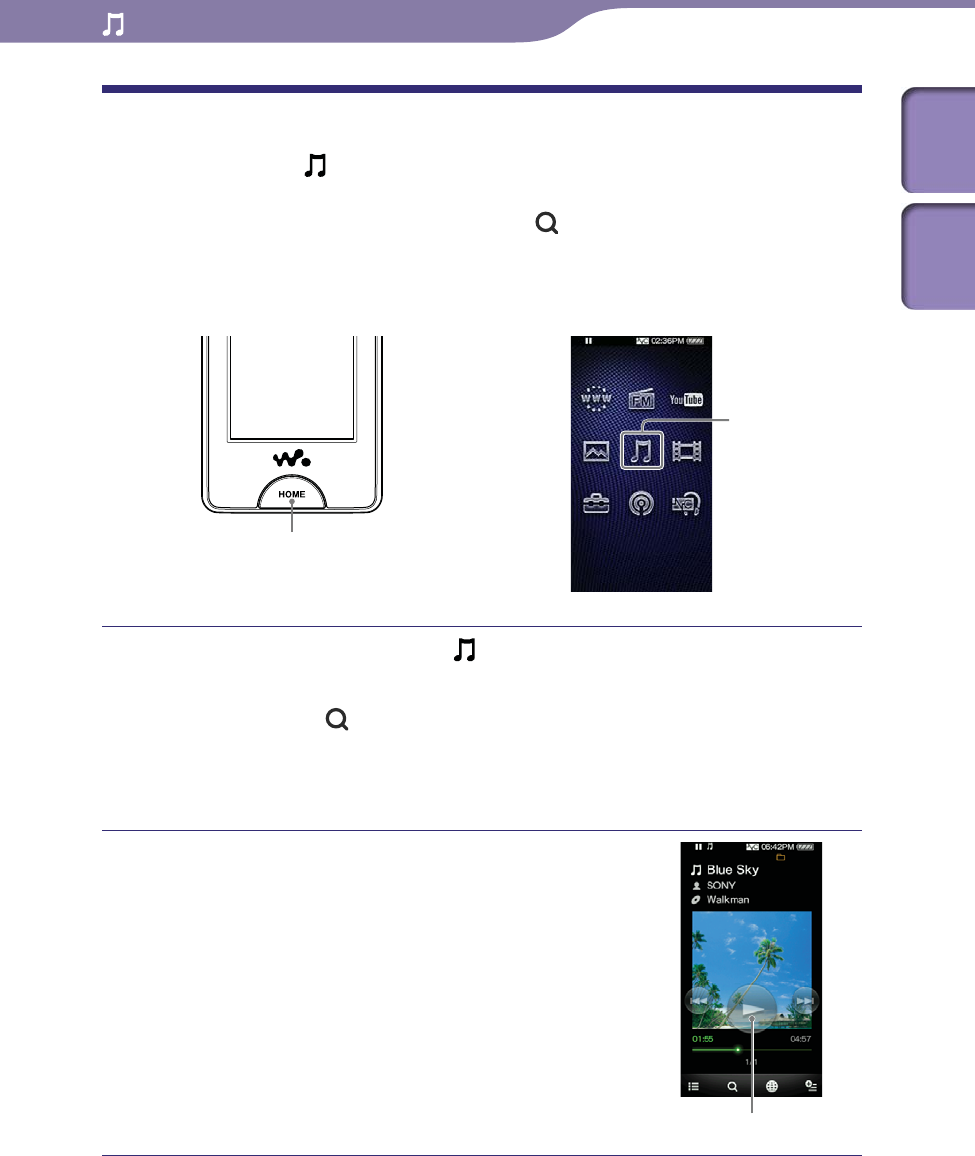
Playing Music
37
37
Playing Music
(Music)
To play music, select (Music) from the Home menu to display the music
playback screen.
You can search for desired songs by selecting (Search) on the music
playback screen.
The song information, control buttons, etc., are displayed on the music
playback screen.
HOME button
Music
From the Home menu, select (Music).
The music playback screen appears.
When you select (Search) on the music playback screen, the search
menu appears. You can select the desired search method to display the
list screen and search for songs. For details, see “Searching for Songs”
( page 42).
Select .
The playback of the songs begins.
You can tap the control buttons, icons etc.,
on the music playback screen to operate
the player. For details on how to control
the music playback, see “Music playback
screen” ( page 38).
Table of
Contents
Index
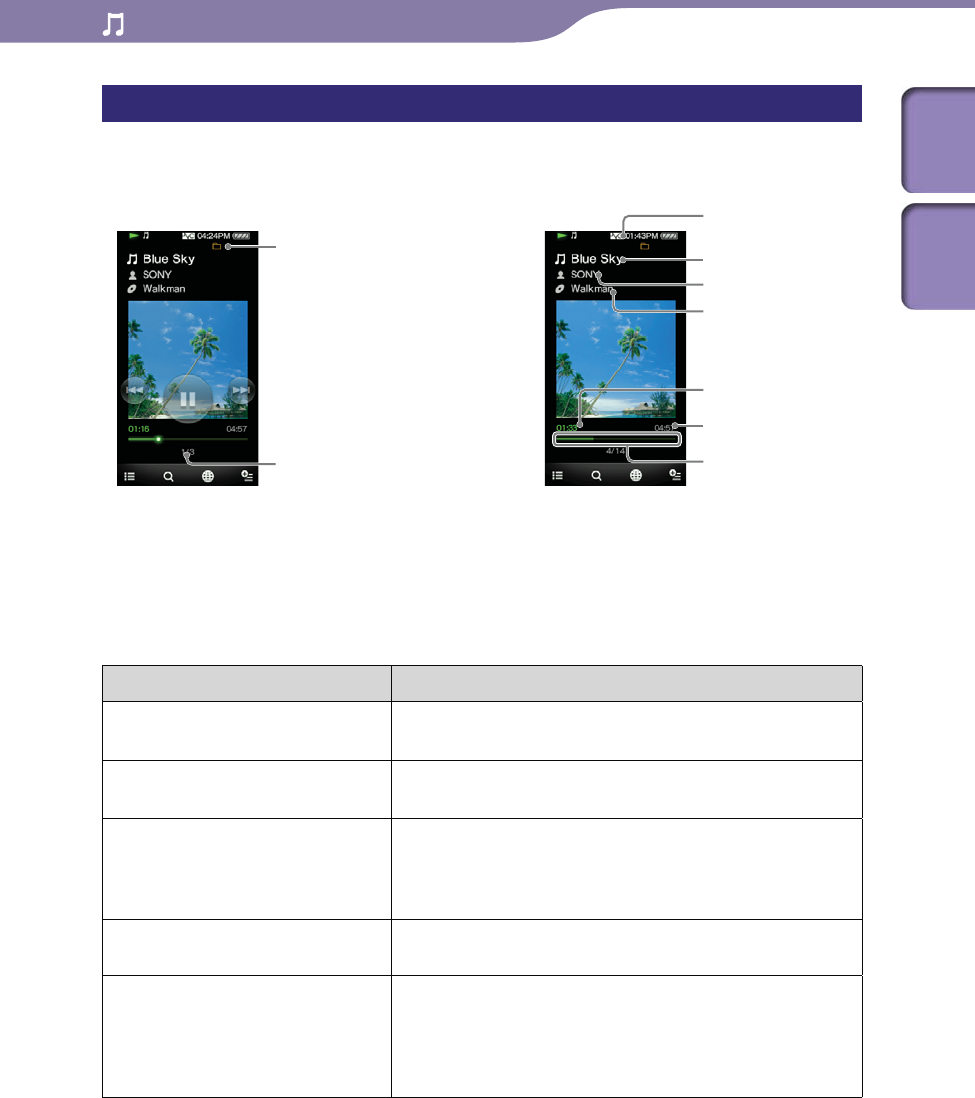
Playing Music
38
38
Music playback screen
You can bring up or dismiss the control buttons by tapping the screen. If there
is no operation for a while, they disappear.
Information area
Current song number/
Total song number to be played
Seek Slider
Information area
Song name
Artist name
Album title
Total time
Elapsed time
Operations on the music playback screen
You can tap the objects such as control buttons on the screen to operate the
player. Also, you can use the // buttons on the body of the player
to operate it.
To (screen indication) Do this
Play ()/pause ()*1 Tap (play)/ (pause).
Press the button on the body.
Fast forward ()/
fast rewind ()
Touch and hold /.
Press and hold the / button on the body.
Find the beginning of the previous
(or current) song ()/
find the beginning of the next
song ()
Tap /.
Press the / button on the body.
Move to any point in a song Drag the indicator (playback point) along the Seek Slider.
The playback begins at the point of the indicator.
Browse album covers to select an
album
Drag or flick the cover art up or down to display the
album scroll screen. Drag or flick the cover art on the
screen to select the desired album. For details, see
“Browsing cover arts to select an album (Album Scroll)”
( page 40).
*1 During pause, if there is no operation for a while, the player automatically enters
standby mode.
Continued
Table of
Contents
Index
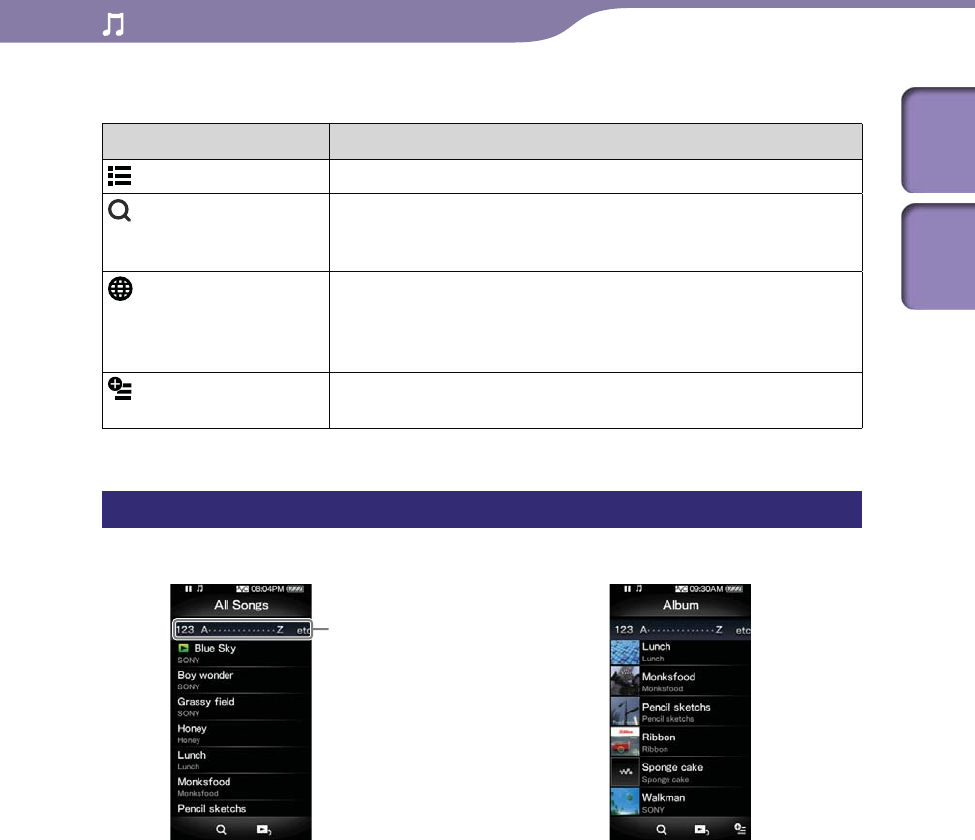
Playing Music
39
39
Icons on the playback screen
Icon Description
(To List) Shows a list screen.
(Search) Shows the search menu. You can select the desired search
method to display the list screen and search for songs. For
details, see “Searching for Songs” ( page 42).
(Related Links) Shows the Related Links screen. You can search the Internet for
reference information on the current playing song. For details,
see “Searching for Reference Information on a Song (Related
Links)” ( page 43).
(Option Menu) Shows the option menu. For details on the music option menu,
see “Using the Music Option Menu” ( page 45).
List screen
The following are examples of list screens.
Song list screen
Index
Select an initial letter for
song name, album title,
artist name, etc., to bring it
on the top of the list screen.
Album list screen
(Title & Cover Art)
Hint
You can change the display format of the album list to display the cover art thumbnails
only ( page 53).
Continued
Table of
Contents
Index
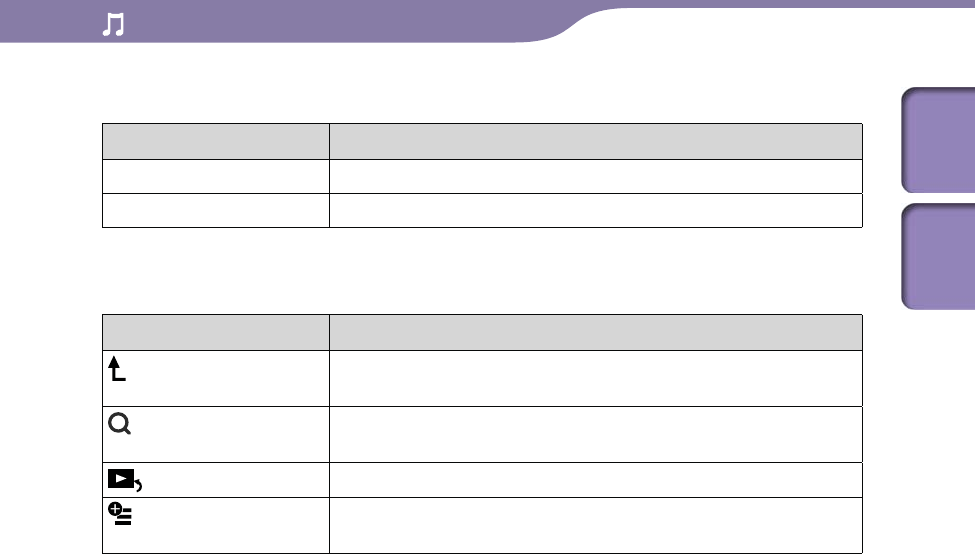
Playing Music
40
40
Operations on the list screen
To Do this
Select an item Tap an item.
Scroll a list up or down Drag or flick up or down.
Icons on the list screen
Icon Description
(Up) Shows the list screen of the next upper level (for example, the
icon of a song list screen may show an album list screen).
(Search) Shows the search menu. For details, see “Searching for Songs”
( page 42).
(To Play Screen) Returns to the music playback screen.
(Option Menu) Shows the option menu. For details on the music option menu,
see “Using the Music Option Menu” ( page 45).
Table of
Contents
Index
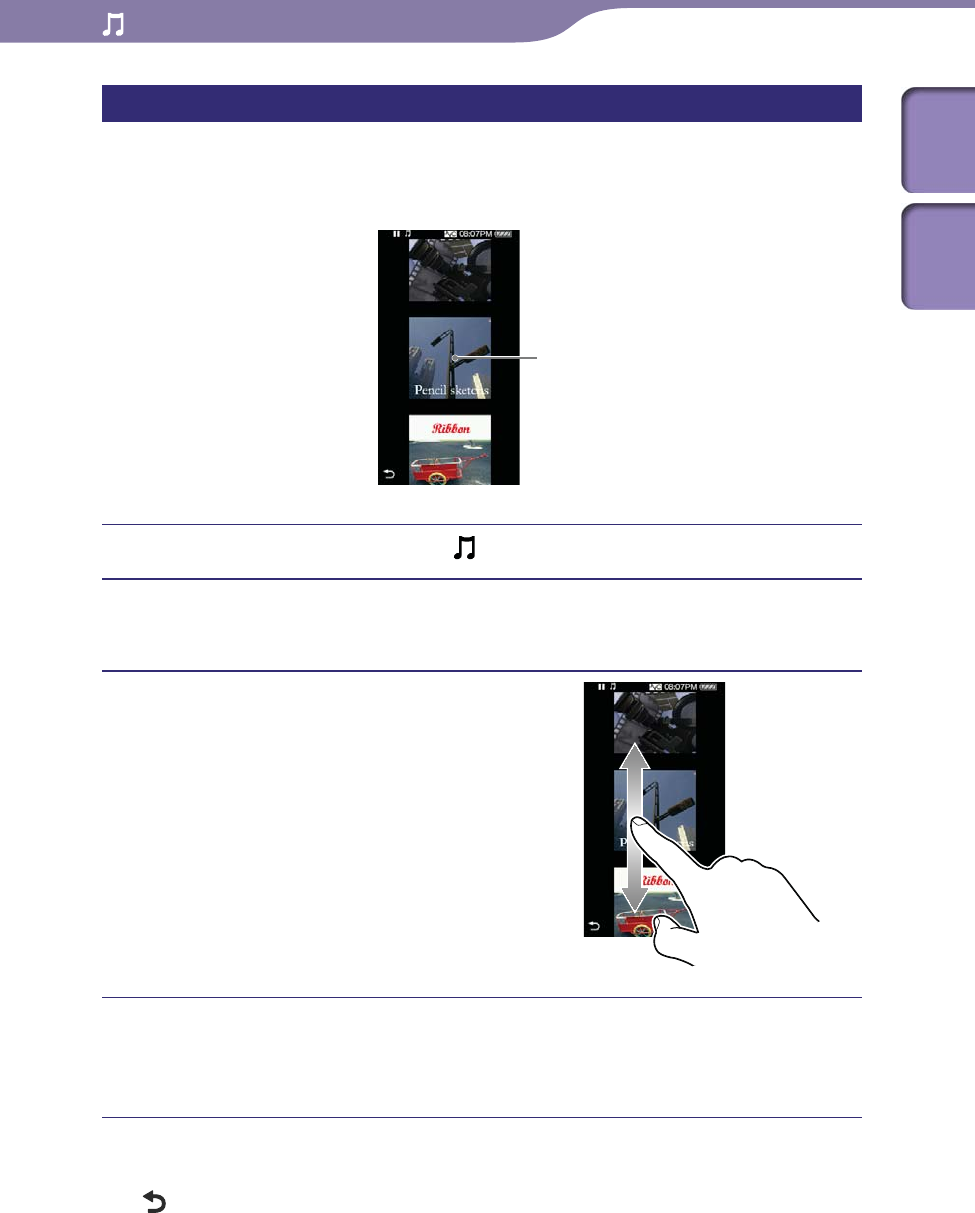
Playing Music
41
41
Browsing cover arts to select an album (Album Scroll)
On the music playback screen, you can drag or flick the cover art up or down
to select the album.
Album scroll screen
Cover art
From the Home menu, select (Music).
Drag or flick the cover art up or down.
The album scroll screen appears.
Drag or flick the cover art
up or down to browse
album covers.
The cover art images are
arranged by title in
alphabetical order.
Tap the cover art of the desired album.
The music playback screen reappears and the playback of the selected
album begins.
To cancel the browsing
Tap (Back).
Table of
Contents
Index
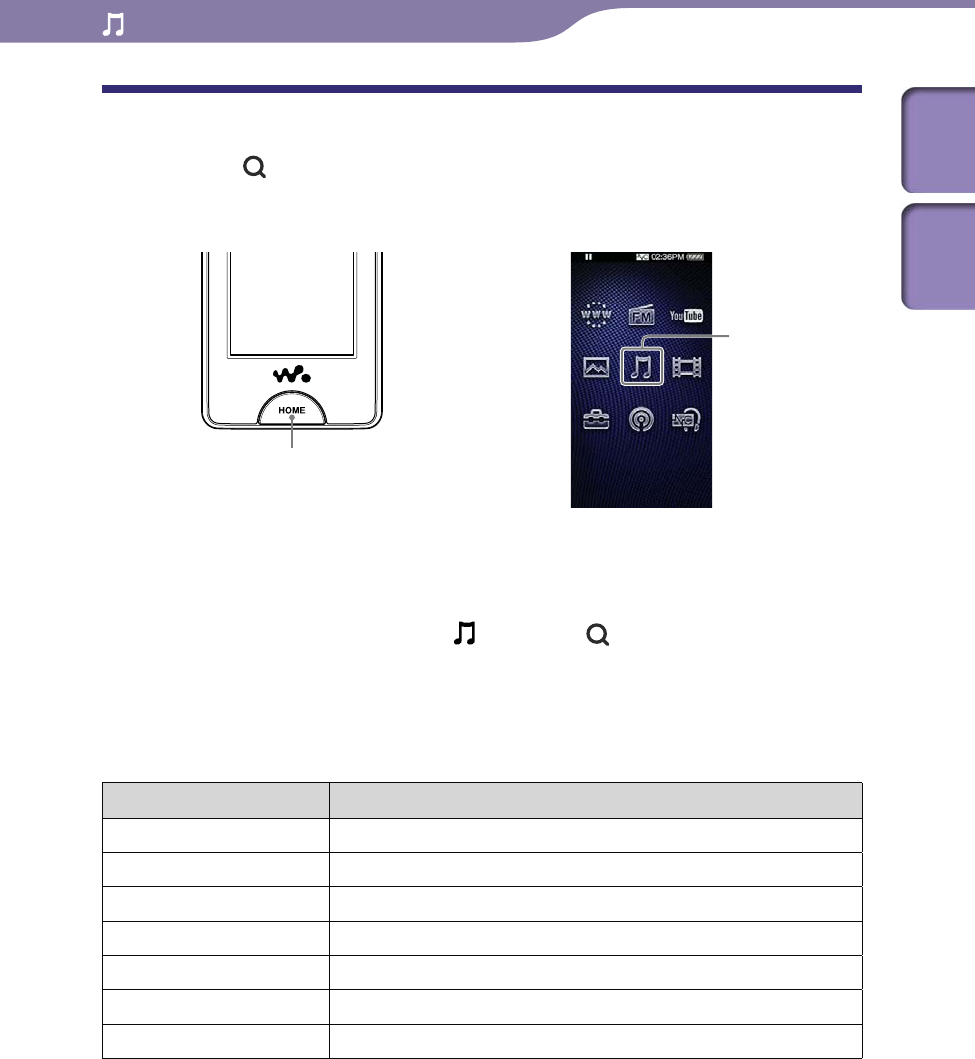
Playing Music
42
42
Searching for Songs
When you tap (Search) on the music playback screen or the list screen, the
search menu appears. You can select the desired search method to search the
list for desired songs.
HOME button
Music
Hint
”All Songs,” “Album” and “Artist” lists are arranged in alphanumeric order.
From the Home menu, select (Music) (Search) the desired
search method the desired song.
Select items as follows until a song list appears.
Search method
Method Description
All Songs Select a song from the song list.
Album Select an album a song.
Artist*1Select an artist an album a song.
Genre Select a genre an artist an album a song.
Release Year Select a release year an artist a song.
Playlists*2Select a playlist a song.
Folder Select a folder a song.
*1 “The” at the beginning of the artist name is omitted when arranging the list.
*2 Playlists are created by using Windows Media Player 11. For information on how to
create a playlist, refer to the Help of the Windows Media Player 11. Cover art images
registered to a playlist are not displayed on the player.
Table of
Contents
Index
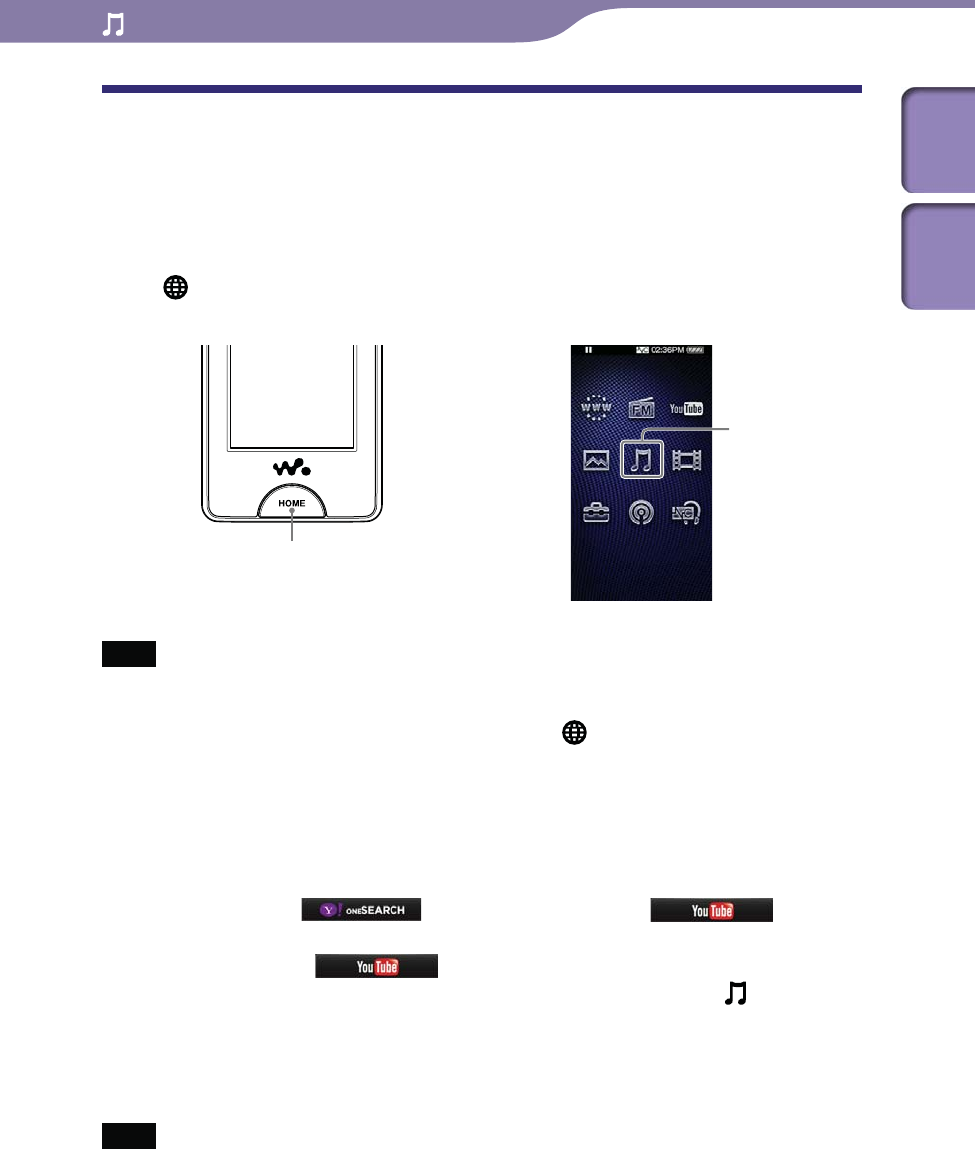
Playing Music
43
43
Searching for Reference Information on a Song
(Related Links)
You can search the Internet by keyword for information on the current playing
song, album, artist, etc. You can search YouTube site for videos, or search a
website for information.
Select (Related Links) on the music playback screen to search the Internet
for information on the playing song.
HOME button
Music
Note
The Related Links function requires a wireless LAN connection.
From the music playback screen, select (Related Links) the
desired keyword the desired website to search.
After the search, the YouTube application or the Internet browser is
brought up.
You can select artist name, song name or album title as the search
keyword.
You can select (Yahoo! oneSearch) or, (Search
on YouTube) as the search website.*1
When selecting (Search on YouTube) to search, the
playback of the song pauses. To restart the playback, select (Music)
from the Home menu.
*1 The search website may vary depending on the “Service Country/Region” setting (
page 126).
Note
You can set the country/region to use the search websites of your residence. For how to
choose the country/region for YouTube, see “Choosing country/region” ( page 81).
For how to choose the country/region for Yahoo! oneSearch, see “Service Country/
Region” ( page 126).
Table of
Contents
Index

Playing Music
44
44
Deleting Songs
When you delete songs from the player, use the software you used to transfer
the songs, or Windows Explorer.
For details about using the software, see the Help of the software.
Note
The player itself cannot delete songs without connecting to a computer.
Table of
Contents
Index
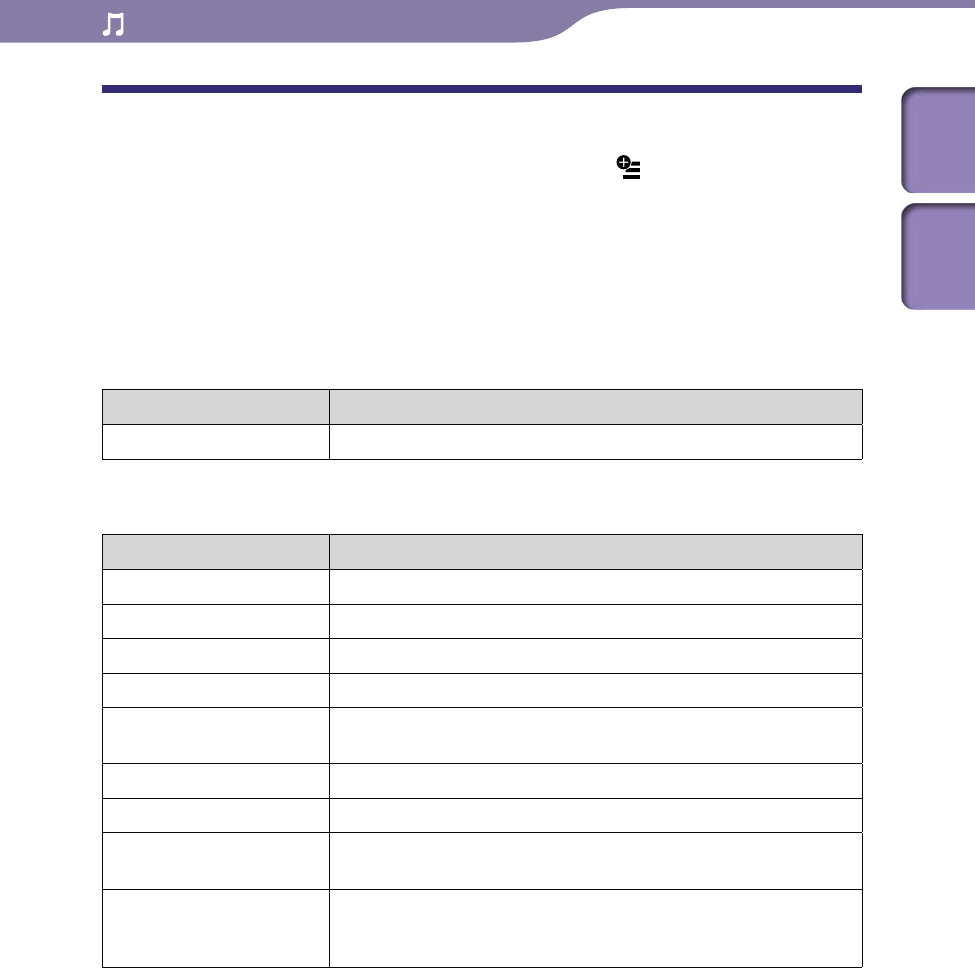
Playing Music
45
45
Using the Music Option Menu
You can bring up the music option menu by selecting (Option Menu) on the
music list screen or on the music playback screen. For how to use the option
menu, see page 18.
The option items shown on the option menu vary, depending on the screen
from which you bring up the option menu. See the reference page for settings
and usage.
Option item appearing on the list screen
Option Item Description/reference page
Album Display Format Selects the album list format ( page 53).
Option items appearing on the playback screen
Option Items Description/reference page
Play Mode Sets the play mode ( page 47).
Playback Range Sets the playback range ( page 48).
Equalizer Customizes the sound quality ( page 48).
VPT(Surround) Customizes the “VPT(Surround)” settings ( page 50).
DSEE (Sound Enhance) Enables/disables the “DSEE (Sound Enhance)” option ( page
51).
Clear Stereo Enables/disables the “Clear Stereo” option ( page 52).
Dynamic Normalizer Enables/disables the “Dynamic Normalizer” option ( page 52).
Detailed Information Displays the detailed information of a song, such as playing time,
audio format, and bit rate ( page 46).
Add to Wishlist/Remove
from Wishlist
Adds the song to the wish list to purchase it from the service on
the corresponding software./Removes the song from the wish
list.
Continued
Table of
Contents
Index
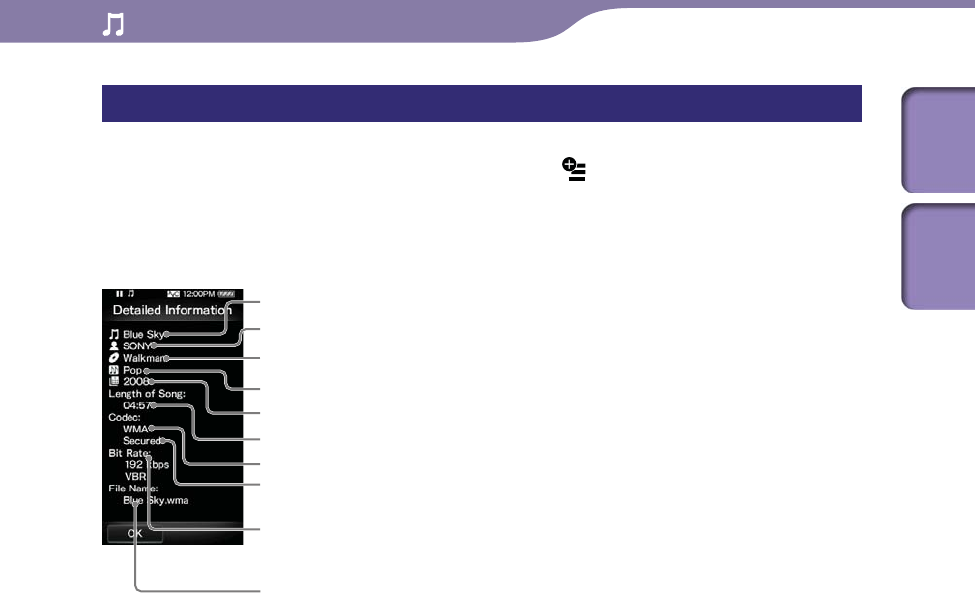
Playing Music
46
46
Displaying the Detailed Information screen
From the music playback screen, select (Option Menu)
“Detailed Information.”
Detailed Information screen
Song name
Artist name
Album title
Genre
Release year
Length of Song
Codec
Copyright protected content
Bit rate
While playing back variable bit rate songs, “VBR” is shown. During VBR playback, the
elapsed time indication and the Seek Slider indicator may be unstable and inaccurate.
File name
Table of
Contents
Index
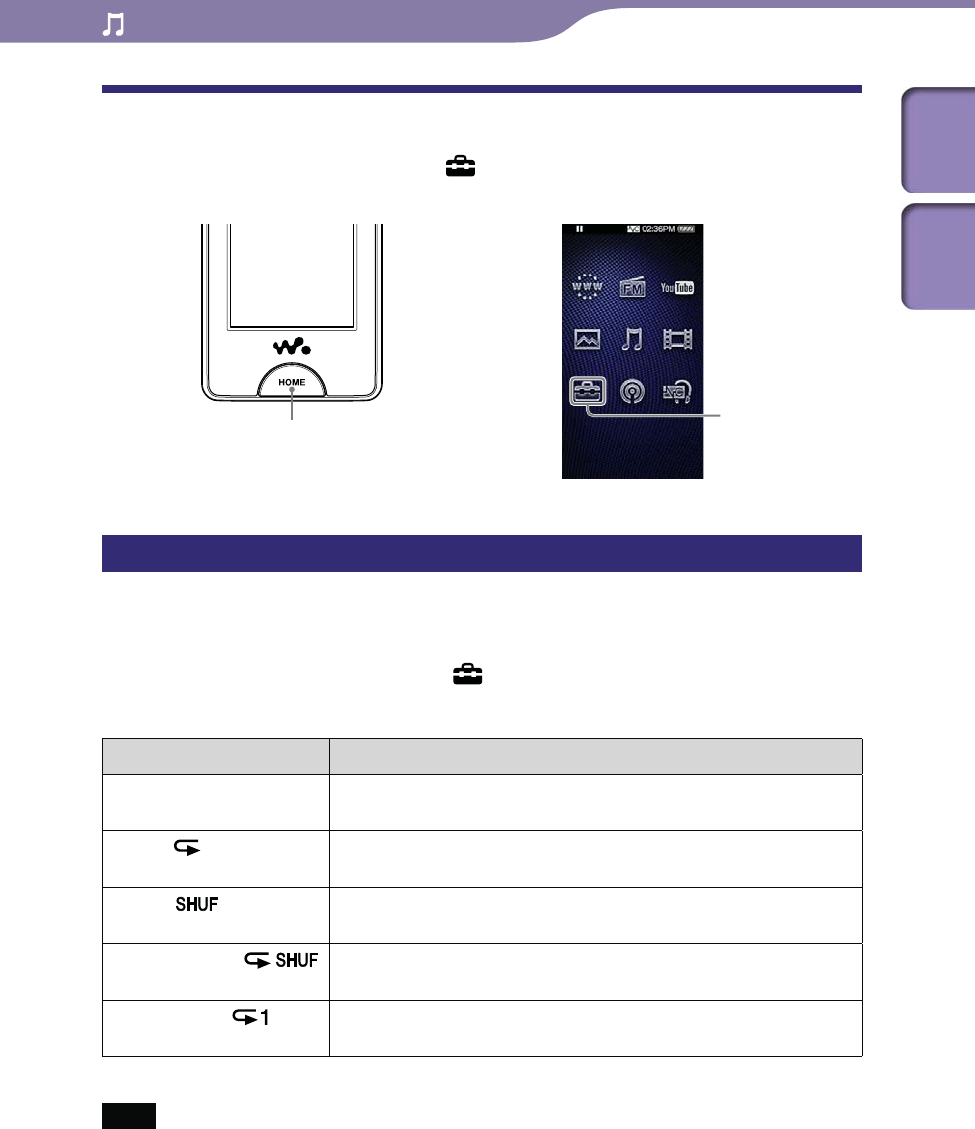
Playing Music
47
47
Changing the Music Settings
To change the music settings, select (Settings) from the Home menu, then
select “Music Settings.”
HOME button Settings
Play Mode
The player offers a variety of play modes, including random play and selected
repeat play.
From the Home menu, select (Settings) “Music Settings”
“Play Mode” the desired play mode type “OK.”
Type Description
Normal/ No icon The songs within the playback range are played back in the song
list order. (Default setting)
Repeat/ The songs within the playback range are played back in the song
list order and the playback repeats.
Shuffle/ The songs within the playback range are played back in random
order.
Shuffle&Repeat/ The songs within the playback range are played back in random
order and the playback repeats.
Repeat 1 Song/ The current song or the song selected from a song list is played
back repeatedly.
Note
Songs to be played back differ depending on the Playback Range settings ( page 48).
Table of
Contents
Index
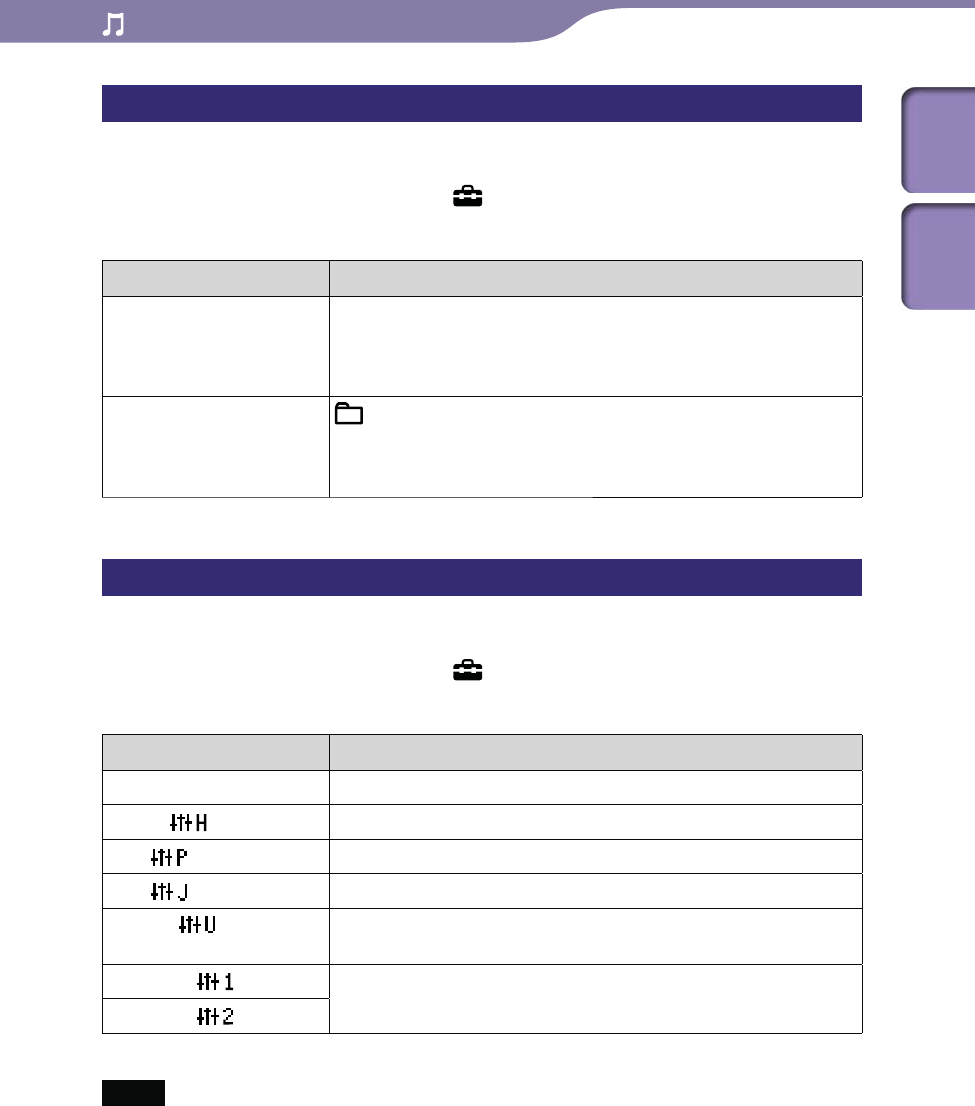
Playing Music
48
48
Playback Range
You can set the playback range of songs.
From the Home menu, select (Settings) “Music Settings”
“Playback Range” the desired playback range type “OK.”
Type Description
All Range Plays back all the songs in all the lists of the selected search
method.
For example, if you start playback from an album list, all the
albums in the player are played back.
Selected Range appears on the screen, and plays back songs only in the lists
from which the playback starts. (Default settings)
For example, if you start playback from an album list, the songs
in the album only are played back.
Equalizer
You can set the sound quality according to the music genre, etc.
From the Home menu, select (Settings) “Music Settings”
“Equalizer” the desired equalizer type “OK.”
Type Description
None Sound quality setting is not activated. (Default setting)
Heavy ( ) Emphasizes high and low ranges for a powerful sound.
Pop ( ) Stresses the middle range audio, ideal for vocals.
Jazz ( ) Emphasizes high and low ranges for a lively sound.
Unique ( ) Emphasizes high and low ranges, so that even soft sounds can be
heard easily.
Custom 1 ( ) User-customizable sound settings for which you can adjust each
frequency range individually. See page 49 for details.
Custom 2 ( )
Notes
If your personal settings saved as “Custom 1” and “Custom 2” seem to produce a
different volume level than the other settings, you may have to adjust the volume
manually to compensate.
The “Equalizer” setting is not applied while playing a video, YouTube video, podcast
video, or FM radio.
Continued
Table of
Contents
Index

Playing Music
49
49
Customizing sound quality
You can preset the value of CLEAR BASS (bass) and 5 bands Equalizer as
“Custom 1” or “Custom 2.”
From the Home menu, select (Settings) “Music Settings”
“Equalizer” “Custom 1” or “Custom 2.”
Drag the slider for the CLEAR BASS or the frequency range setting
to adjust the setting level, and then select “OK.”
The CLEAR BASS can be set to any of 4 sound levels, and the 5 frequency
ranges can be set to any of 7 sound levels.
Note
The “Equalizer” setting is not applied while playing a video, YouTube video, podcast
video, or FM radio.
Table of
Contents
Index
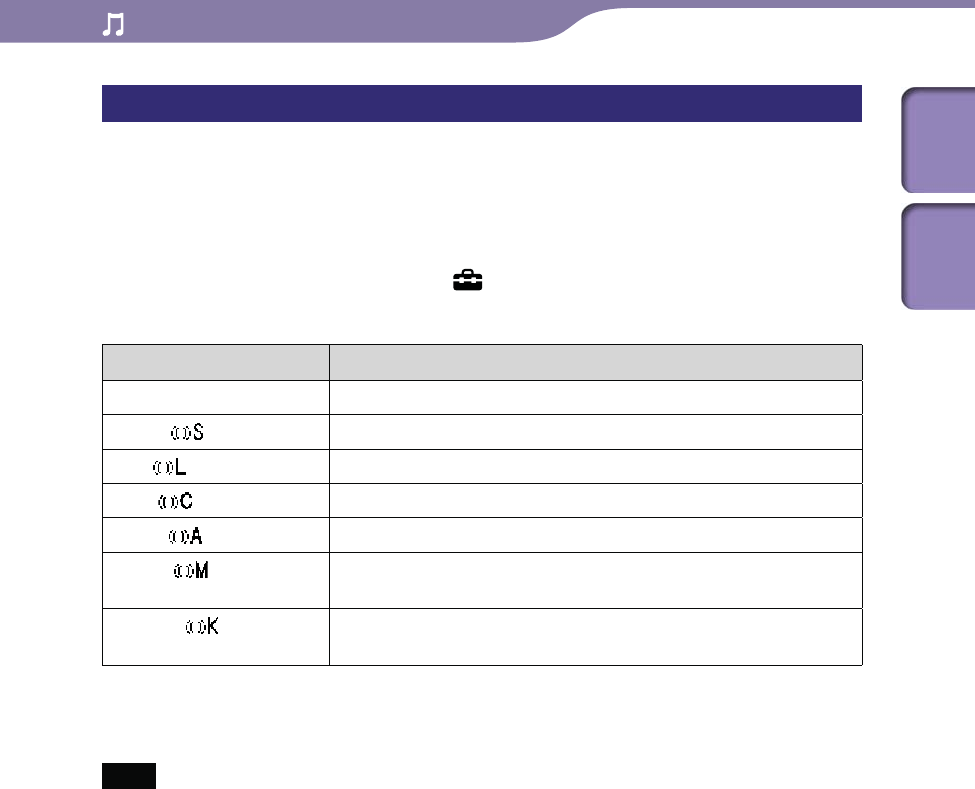
Playing Music
50
50
VPT (Surround)
You can customize the surround sound by using the VPT*1 (Surround)
function to enrich the sound reproduction quality of the audio playback.
The sense of realism is more enhanced in the order of “Studio” “Live”
“Club” “Arena” (most enhanced).
From the Home menu, select (Settings) “Music Settings”
“VPT (Surround)” the desired VPT (Surround) type “OK.”
Type Description
None “VPT(Surround)” setting is not activated. (Default setting)
Studio ( ) Creates the sound of a recording studio.
Live ( ) Creates the sound of a concert hall.
Club ( ) Creates the sound of a club.
Arena ( ) Creates the sound of an arena.
Matrix ( ) Reproduces an additional surround effect, and creates a natural,
yet richly enhanced sound.
Karaoke ( ) Creates a stage-like sound field by suppressing vocal sounds, and
adding a surround effect to the music.
*1 VPT, which stands for Virtual Phone Technology, is a proprietary sound processing
technology developed by Sony.
Note
The “VPT (Surround)” setting is not applied while playing a video, YouTube video,
podcast video, external input audio, or FM radio.
Table of
Contents
Index
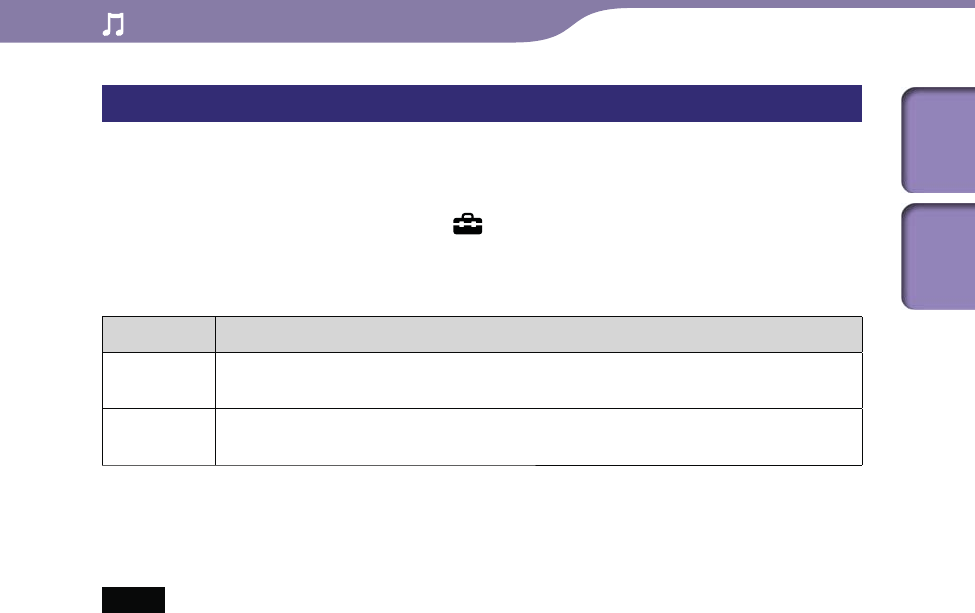
Playing Music
51
51
DSEE (Sound Enhance)
By activating the “DSEE*1(Sound Enhance)” feature, you can hear a rich and
natural sound almost exactly like the original source.
From the Home menu, select (Settings) “Music Settings”
“DSEE(Sound Enhance)” the desired DSEE (Sound Enhance)
type “OK.”
Type Description
On The “DSEE*1(Sound Enhance)” function is activated, and plays back naturally
extended sound that is close to the original sound.
Off Disables the “DSEE (Sound Enhance)” function and plays back normal sound.
(Default setting)
*1 DSEE, which stands for Digital Sound Enhancement Engine, is a technology developed
by Sony, to enhance the sound quality of compressed audio files by restoring high-range
sound removed by the compression process.
Notes
The “DSEE (Sound Enhance)” setting is not applied while playing a video, YouTube
video, podcast video, external input audio, or FM radio.
The “DSEE(Sound Enhance)” function is not effective for songs with a file format that is
not compressed, or songs that are of a high bit rate with no treble loss.
In the case of songs of very low bit rate, the “DSEE(Sound Enhance)” function will not
be effective.
Table of
Contents
Index

Playing Music
52
52
Clear Stereo
”Clear Stereo” enables individual left and right digital processing of the sound.
From the Home menu, select (Settings) “Music Settings”
“Clear Stereo” the desired Clear Stereo type “OK.”
Type Description
On Activates the “Clear Stereo” function when you use the supplied
headphones. (Default setting)
Off Disables the “Clear Stereo” function and plays back normal
sound.
Notes
The “Clear Stereo” setting is not applied while playing a video, YouTube video, podcast
video, external input audio, or FM radio.
The “Clear Stereo” function is designed to obtain maximum effect with the supplied
headphones. The “Clear Stereo” effect may not be obtained with other headphones.
When using other headphones, set “Clear Stereo” to “Off.”
Dynamic Normalizer
You can reduce the volume level between songs. With this setting, when
listening to album songs in the shuffle play mode, the volume level between
songs is moderated to minimize the difference in their recording levels.
From the Home menu, select (Settings) “Music Settings”
“Dynamic Normalizer” the desired Dynamic Normalizer type
“OK.”
Type Description
On Minimizes the difference of the volume level between songs.
Off Plays back songs with their original volume level as transferred.
(Default setting)
Note
The “Dynamic Normalizer” setting is not applied while playing a video, YouTube video,
podcast video, external input audio, or FM radio.
Table of
Contents
Index
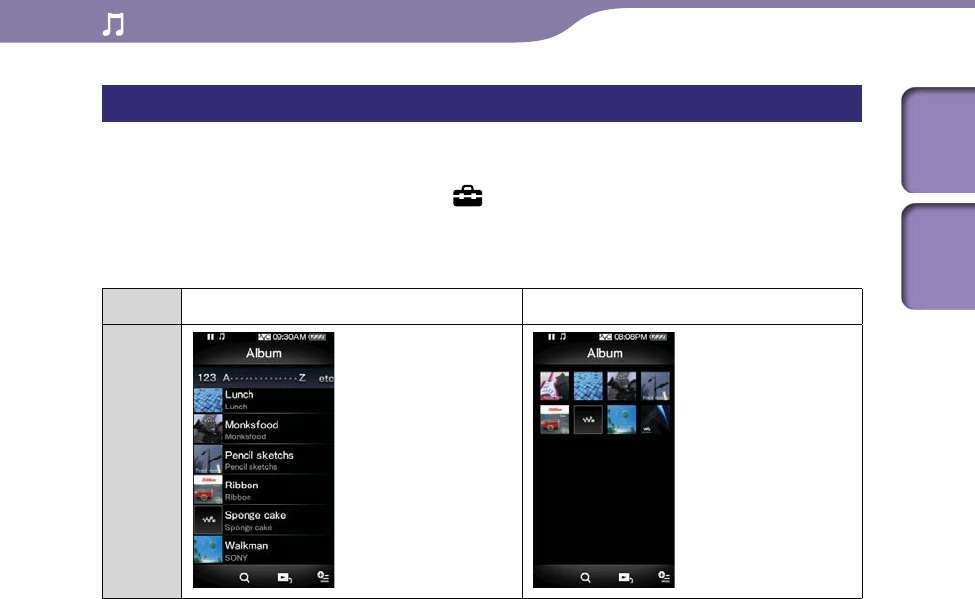
Playing Music
53
53
Album Display Format
You can select the album display format.
From the Home menu, select (Settings) “Music Settings”
“Album Display Format” the desired Album Display Format type
“OK.”
Type Title & Cover Art (Default setting) Cover Art Only
Screen
Hint
The cover art only appears if the cover art information is included. You can set cover art
using the bundled Windows Media Player 11. For details on operation, refer to the Help
of Windows Media Player 11. Note that the player does not display cover art attached to
playlists.
Table of
Contents
Index

Watching Videos
54
54
Playing a Video
(Videos)
To play a video, select (Videos) to display the video playback screen.
You can select the desired video by selecting (Search) on the video playback
screen. The video’s information, control buttons, etc., are displayed on the
video playback screen.
HOME button
Videos
From the Home menu, select (Videos).
The video playback screen appears.
When you select (Search) on the video playback screen, the search
menu appears. You can select desired search method to display the list
screen and search for videos. For details, see “Searching for Videos” (
page 58).
Select .
The playback of the video begins.
You can tap the control buttons,
icons etc., on the video playback
screen to operate the player. For
details on how to control the video
playback, see “Video playback
screen” ( page 55).
Hint
When the “On-Hold Display” option is set to “No,” you can turn off the screen to enjoy
sound only by setting the HOLD switch to on during video playback. By this operation,
you can reduce power consumption to make the battery last longer.
Table of
Contents
Index

Watching Videos
55
55
Video playback screen
You can bring up or dismiss the control buttons, icons, etc., by tapping the
screen. If there is no operation for a while, they disappear.
Information area
Total time
Seek Slider
Elapsed time
Operations on the video playback screen
You can tap the objects such as control buttons on the screen to operate the
player. Also, you can use the // buttons on the body of the player
to operate it.
To (screen indication) Do this
Play ()/pause ()*1 Tap (play)/ (pause).
Press the button on the body.
Fast forward ()/
fast rewind () Tap /, or touch and hold / .*2
Press and hold the / button on the body.
Fast forward ()/
fast rewind () during
pause*3
Touch and hold / during pause.
Press and hold the / button on the body during
pause.
Move to the previous
scene*4 or chapter ()/
move to the next scene or
chapter ()
Tap /.
Press the / button on the body.
Rewind slightly/forward
slightly
Tap (rewind)/ (forward) during pause.
Move to any point in a
video
Drag along the Seek Slider to move the indicator (playback
point). The playback begins at the point of the indicator.
*1 During pause, if there is no operation for a while, the player automatically enters
standby mode.
*2 Forward speed changes through 3 levels by repeatedly tapping ( (×10),
(×30), (×100)). Also, rewind speed changes through 3 levels by repeatedly tapping
( (×10), (×30), (×100)). Tap to exit the operation and resume
normal playback.
*3 The speed of fast forward/fast rewind during pause varies depending on the length of
the video.
*4 If there is only one chapter in the video, the playback position moves with an interval of
5 minutes.
Continued
Table of
Contents
Index

Watching Videos
56
56
Icons on the playback screen
Icon Description
(To List) Shows a list screen.
(Search) Shows the search menu. You can select desired search method to
display the list screen and search for videos. For details, see
“Searching for Videos” ( page 58).
(Scene Scroll) Shows the scene scroll screen. You can browse scenes or chapters
by flicking the thumbnail*1 on the screen, to select the desired
scene. For details, see “Browsing scenes (Scene Scroll)” ( page
57).
(Option Menu) Shows the option menu. For details on the video option menu,
see “Using the Video Option Menu” ( page 60).
*1 Thumbnail refers to a reduced size image of one scene of a video.
Table of
Contents
Index
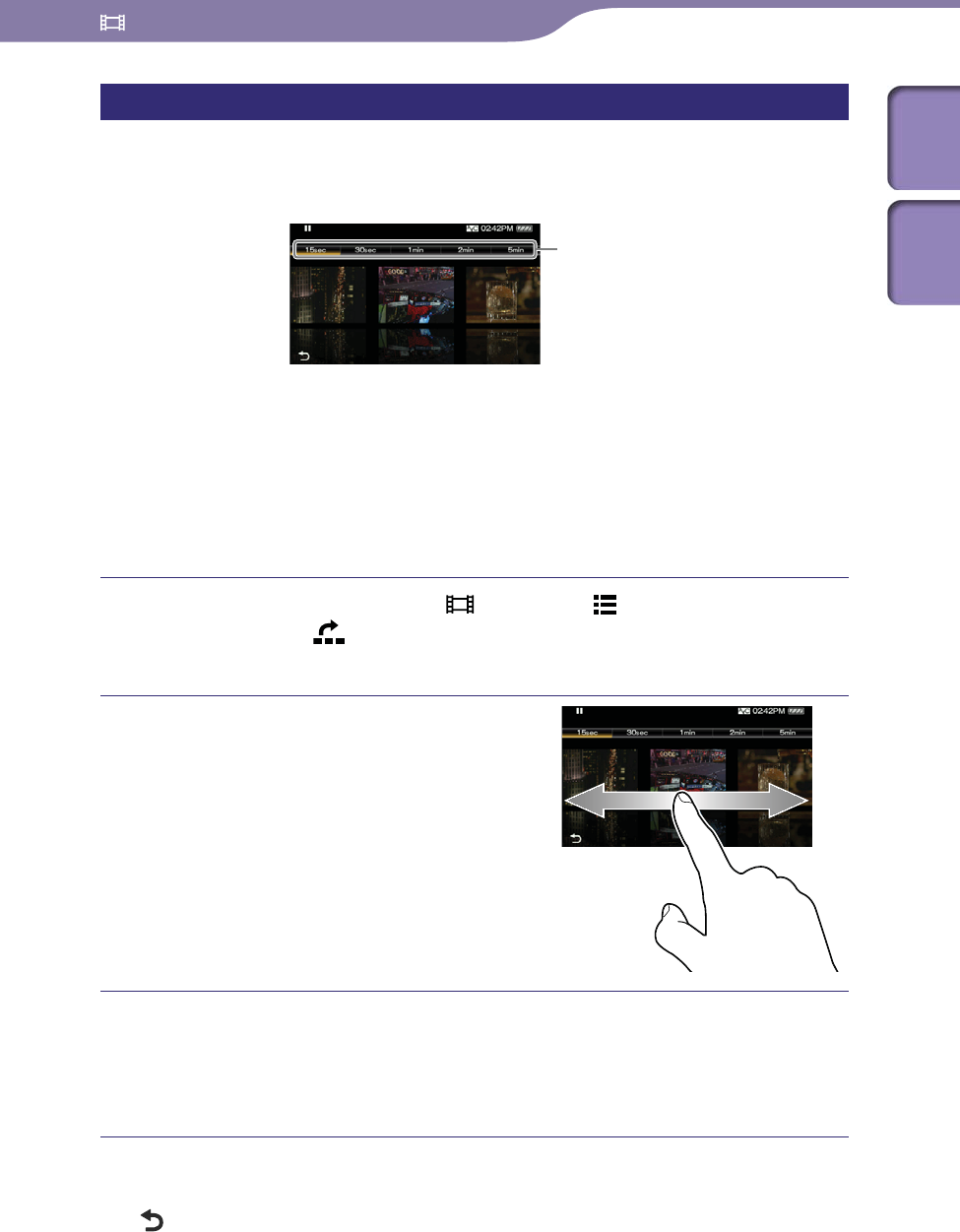
Watching Videos
57
57
Browsing scenes (Scene Scroll)
You can display thumbnails*1 to select a scene or chapter to play back.
*1 Thumbnail refers to a reduced size image of one scene of a video.
Scene scroll screen
Scene interval setting
Hint
On the scene search screen, you can set the interval of scenes displayed as thumbnails.
You can set the interval to “15 Sec,” “30 Sec,” “1 Min,” “2 Min” or “5 Min.” Tap the Scene
interval setting on the top of the screen to select the desired interval. Use the scene
thumbnails as a guide (because each thumbnail may have a deviation from the exact
time interval).
From the Home menu, select (Videos) (To List) the
desired video (Scene Scroll).
The scene scroll screen appears.
Drag or flick the images sideways
to browse.
Tap the desired image.
The video playback screen reappears
and the playback begins from the
beginning of the scene you selected.
To cancel the browsing
Tap (Back).
Table of
Contents
Index
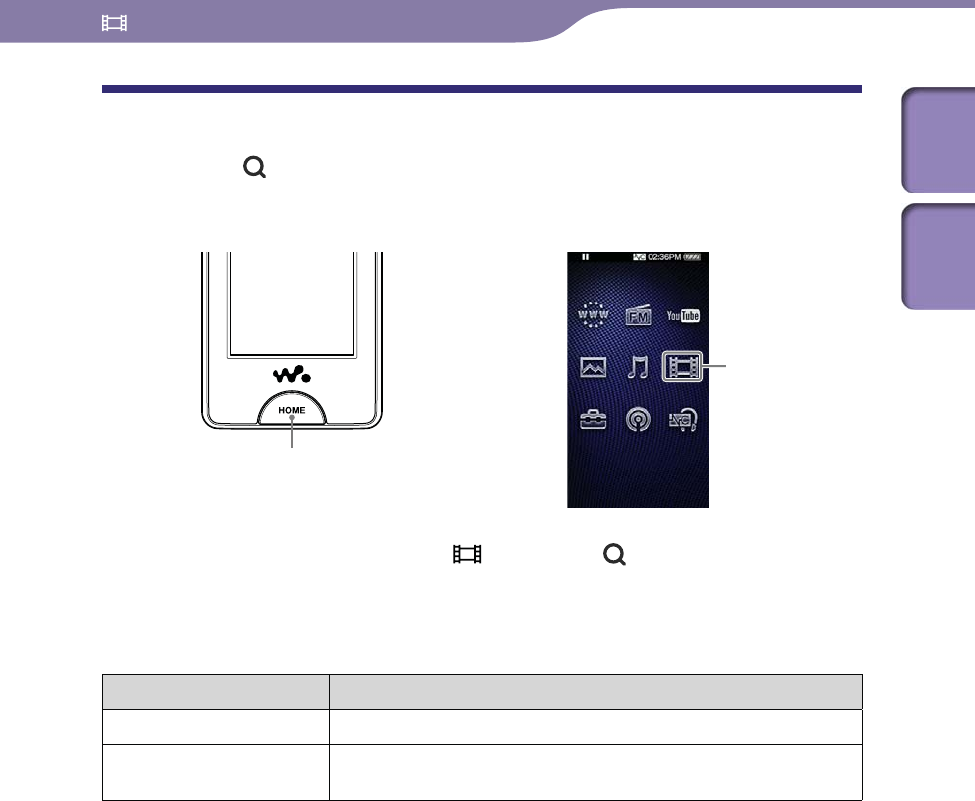
Watching Videos
58
58
Searching for Videos
When you tap (Search) on the video playback screen or the list screen, the
search menu appears. You can select desired search method to search the list
for desired video.
HOME button
Videos
From the Home menu, select (Videos) (Search) the
desired search method the desired video.
Search method
Method Description
All Videos Select a video from the video list.
VIDEO You can search for videos by folder.
Select a folder a video.
Table of
Contents
Index

Watching Videos
59
59
Deleting Videos
You can delete videos from the player.
Deleting currently playing video
From the playback screen of the video, tap (Option Menu)
“Delete Video” “Yes.”
Deleting videos by selecting from a list
From the video list screen, select (Option Menu) “Delete Video”
the video you intend to delete “Yes.”
Hint
You can use Media Manager for WALKMAN or Windows Explorer to delete video files
from the player. Use Media Manager for WALKMAN to delete videos transferred by it.
Use Windows Explorers to delete videos transferred by it.
Table of
Contents
Index
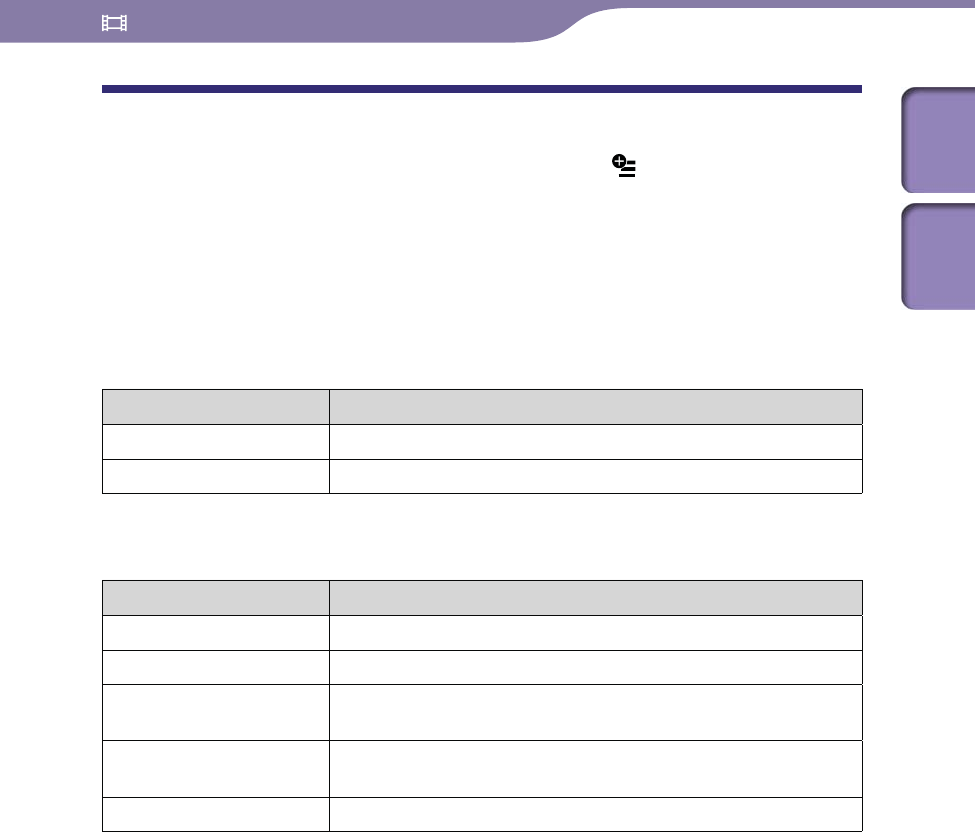
Watching Videos
60
60
Using the Video Option Menu
You can bring up the video option menu by selecting (Option Menu) on the
video list screen or on the video playback screen. For how to use the option
menu, see page 18.
The option items shown on the option menu vary, depending on the screen
from which you bring up the option menu. See the reference page for settings
and usage.
Option item appearing on the list screen
Option Item Description/reference page
Order of Video List Arranges the video list by date or by title ( page 63).
Delete Video Deletes videos ( page 59).
Option items appearing on the playback screen
Option Items Description/reference page
Zoom Settings Sets the zoom function ( page 61).
Brightness Adjusts the brightness of the screen ( page 121).
On-Hold Display Sets to turn off the video screen during the player is on hold (
page 63).
Detailed Information Displays file information, such as file size, resolution, video/
audio compression format, and file name, etc.
Delete Video Deletes the videos from the player ( page 59).
Table of
Contents
Index
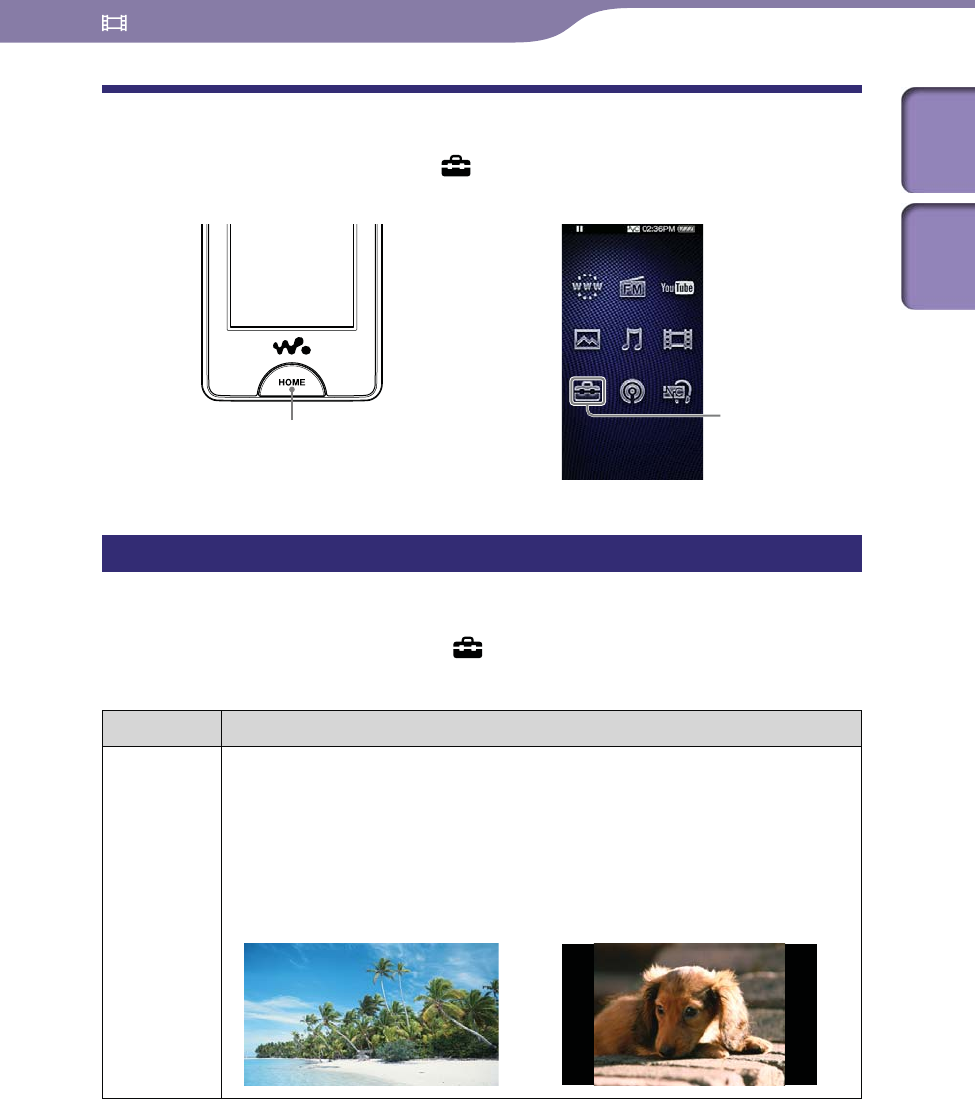
Watching Videos
61
61
Changing the Video Settings
To change the video settings, select (Settings) from the Home menu, then
select “Video Settings.”
HOME button Settings
Zoom Settings
You can zoom in the currently playing video.
From the Home menu, select (Settings) “Video Settings”
“Zoom Settings” the desired zoom setting type “OK.”
Type Description
Auto The video image is enlarged/reduced by fully fitting it to the available display
area, keeping the aspect ratio. (Default setting)
When a 16:9 video image is displayed, it is enlarged/reduced by fully fitting
it to the available display area, keeping the aspect ratio.
When a 4:3 video image is displayed, it appears with the short side of the
video image fully fit to the screen, and black bands right and left on the
screen.
16:9 source 4:3 source
Continued
Table of
Contents
Index
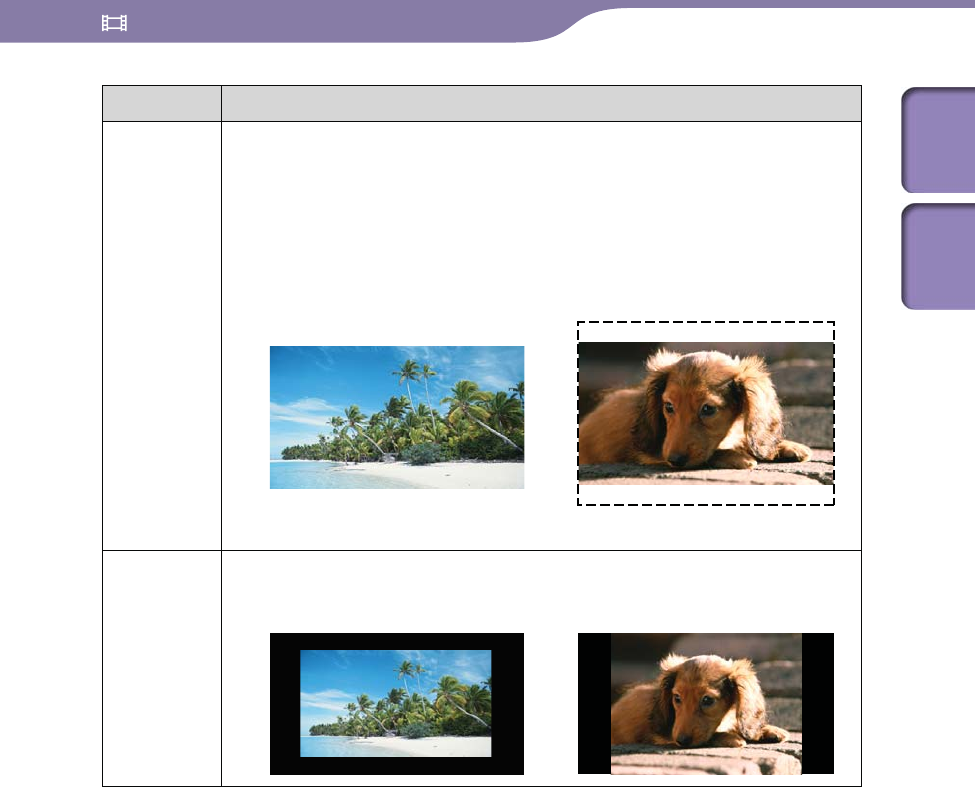
Watching Videos
62
62
Type Description
Full The video image is enlarged/reduced by fully fitting it to the available display
area, keeping the aspect ratio.
When a 16:9 video image is displayed, it is enlarged/reduced by fully fitting
it to the available display area, keeping the aspect ratio.
When a 4:3 video image is displayed, it appears with the long side of the
video image fully fit to the screen, with the top and bottom of the video
image cut to fit.
16:9 source 4:3 source
The dotted line frame represents the original video image size.
Off The video image is not enlarged/reduced, and appears at the original
resolution.
16:9 source 4:3 source
Table of
Contents
Index
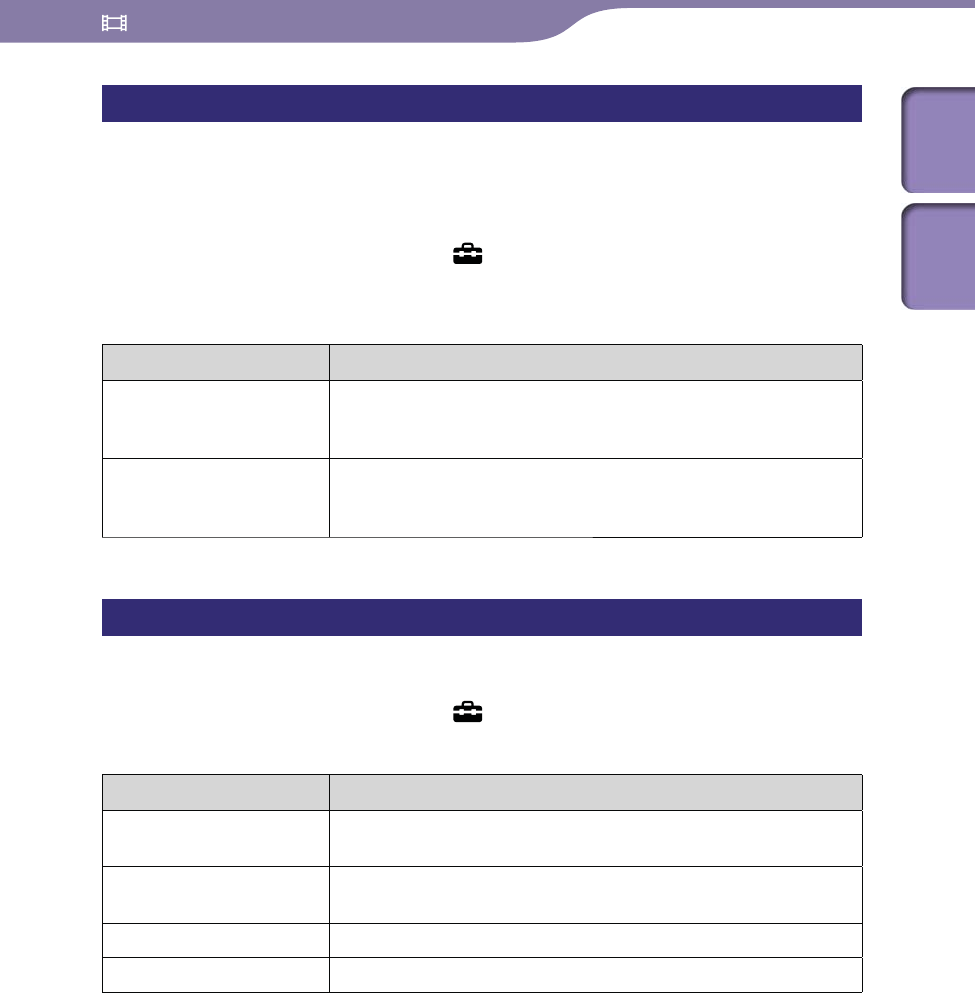
Watching Videos
63
63
Playing only video sound (On-Hold Display)
You can set to turn off the video screen during the player is on hold, allowing
you to enjoy the sound of videos only.
Setting this option to “No” saves battery power and battery life will last longer.
From the Home menu, select (Settings) “Video Settings”
“On-Hold Display” the desired On-Hold Display setting type
“OK.”
Type Description
Yes When the player is on hold, the touch panel and buttons are
deactivated, but videos will be played back normally. (Default
setting)
No When the player is on hold, the touch panel and buttons are
deactivated and the screen turns off, but the sound of the current
video is played back.
Order of Video List
Arranges the video list by date or by title.
From the Home menu, select (Settings) “Video Settings”
“Order of Video List” the desired order of video list type “OK.”
Type Description
Date/Time (Oldest) Arranges the video list by transfer/record date in ascending
order.
Date/Time (Newest) Arranges the video list by transfer/record date in descending
order. (Default setting)
Title (A>Z) Arranges the video list by title in ascending order.
Title (Z>A) arranges the video list by title in descending order.
Table of
Contents
Index

Viewing Photos
64
64
Viewing Photos
(Photos)
To view photos, select (Photos) from the Home menu to display the photo
display screen.
You can select desired photos from a list by selecting (Search) on the photo
display screen.
The photo information, control buttons, etc., are displayed on the photo display
screen.
HOME button
Photos
From the Home menu, select (Photos).
The photo display screen appears.
When you select (Search) on the photo display screen, the search
menu appears. You can select desired search method to display the list
screen and search for photos. For details, see “Searching for Photos” (
page 67).
Drag or flick sideways to display
the previous/next photo.
You can tap the control buttons,
icons etc., on the photo display
screen to operate the player. For
details on how to control the photo
display, see “Photo display screen”
( page 66).
Continued
Table of
Contents
Index

Viewing Photos
65
65
Hints
Playback of songs continues even while you are searching for photos in the photo folder
lists or photo lists, or when the photo display screen is displayed.
You can arrange photos transferred to the player by folder. Select the player (as
[WALKMAN]) using Windows Explorer, drag and drop a new folder just under the
“DCIM,” “PICTURES” or “PICTURE” folder. For details on data hierarchy, see page 31.
Note
If the size of the photo is too large, or the photo file is damaged, appears, and the
photo cannot be displayed.
Table of
Contents
Index
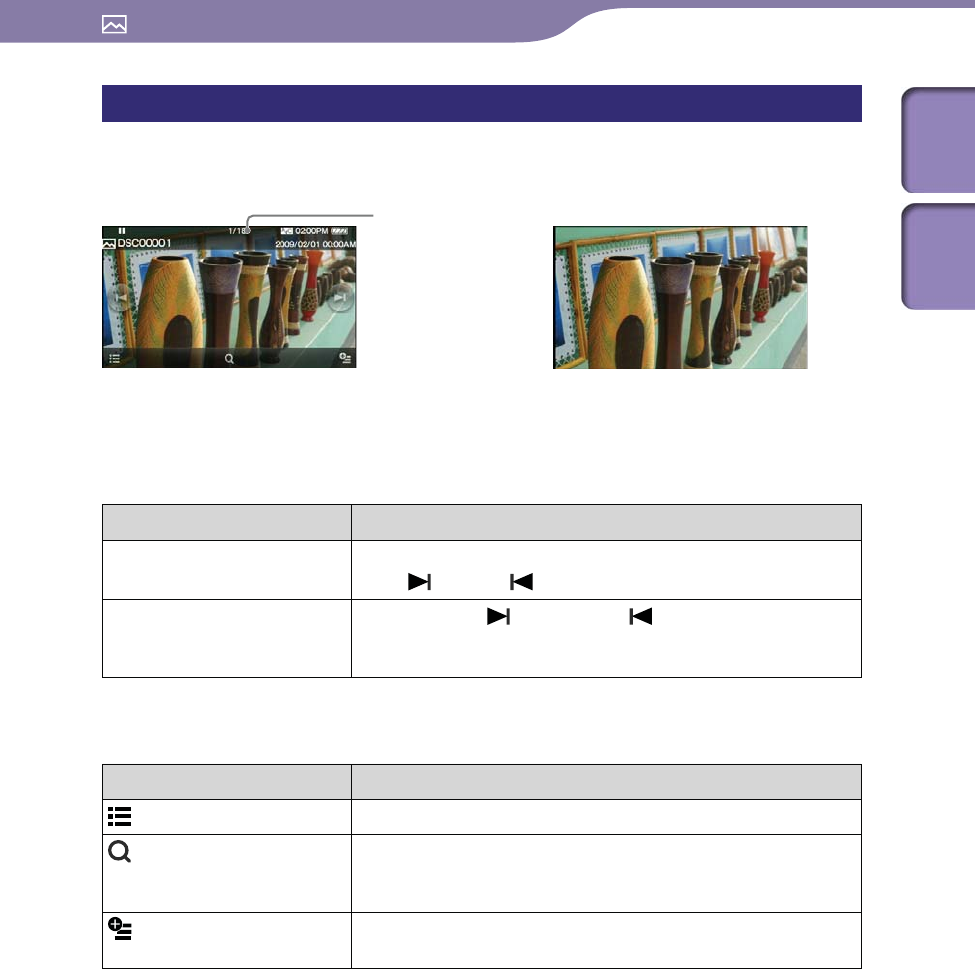
Viewing Photos
66
66
Photo display screen
You can bring up or dismiss the control buttons, icons, etc., by tapping the
screen. If there is no operation for a while, they disappear.
Information area
Operations on the photo display screen
You can tap the objects such as control buttons on the screen to operate the
player.
To Do this
Display the next/previous
photo
Drag or flick left (next) or right (previous).
Tap (next) or (previous).
Display the following/
previous photos
consecutively
Touch and hold (following) or (previous).
Icons on the photo display screen
Icon Description
(To List) Shows a list screen.
(Search) Shows the search menu. You can select desired search method
to display the list screen and search for photos. For details, see
“Searching for Photos” ( page 67).
(Option Menu) Shows the option menu. For details on the photo option
menu, see “Using the Photo Option Menu” ( page 69).
Table of
Contents
Index
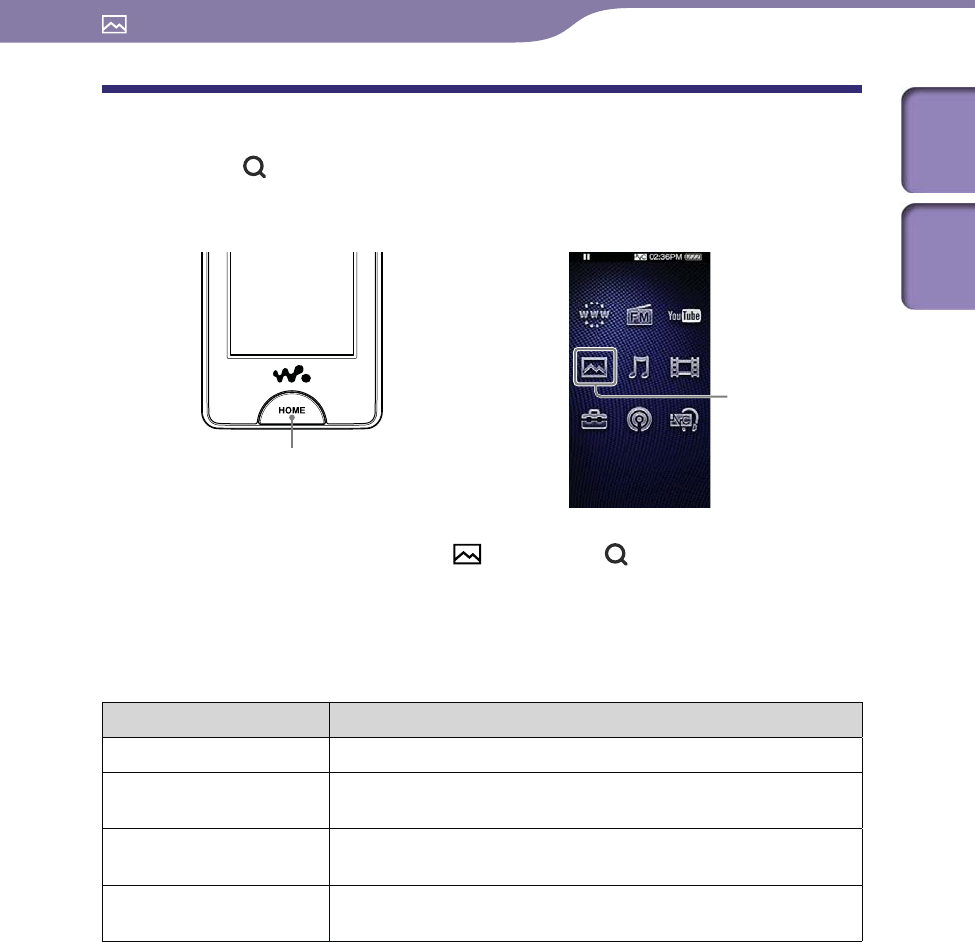
Viewing Photos
67
67
Searching for Photos
When you tap (Search) on the photo display screen or the list screen, the
search menu appears. You can select desired search method to search the list
for desired photos.
HOME button
Photos
From the Home menu, select (Photos) (Search) the
desired search method the desired photo.
Select items as follows until a photo list appears.
Search method
Method Description
All Photos Select a photo from the list of the all photos.
DCIM Select a photo by folder.
Select a folder in the “DCIM” folder a photo.
PICTURE Select a photo by folder.
Select a folder in the “PICTURE” folder a photo.
PICTURES Select a photo by folder.
Select a folder in the “PICTURES” folder a photo.
Table of
Contents
Index

Viewing Photos
68
68
Deleting Photos
Use Media Manager for WALKMAN or Windows Explorer to delete photos
from the player.
Use Media Manager for WALKMAN to delete photos transferred by Media
Manager for WALKMAN.
For details about using Media Manager for WALKMAN, see the Help of the
software.
Notes
If you use Windows Explorer to rename a photo on the player, Media Manager for
WALKMAN cannot delete the photo. Use Windows Explorer to delete it.
The player itself cannot delete photos without connecting to a computer.
Table of
Contents
Index
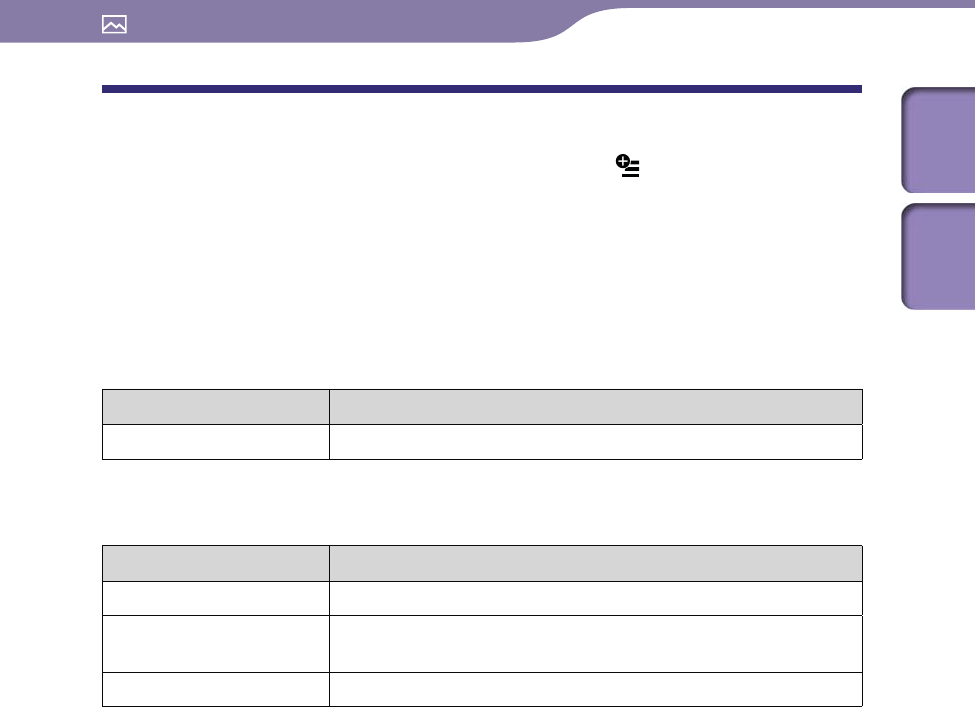
Viewing Photos
69
69
Using the Photo Option Menu
You can bring up the photo option menu by selecting (Option Menu) on the
photo list screen or on the photo display screen. For how to use the option
menu, see page 18.
The option items shown on the option menu vary, depending on the screen
from which you bring up the option menu. See the reference page for settings
and usage.
Option item appearing on the list screen
Option Item Description/reference page
Photo List Display Format Sets the photo list display format ( page 70).
Option items appearing on the display screen
Option Items Description/reference page
Brightness Adjusts the brightness of the screen ( page 121).
Detailed Information Displays file information, such as file size, resolution, and file
name, etc.
Set as Wallpaper Sets the currently displayed photo to the wallpaper( page 121).
Table of
Contents
Index
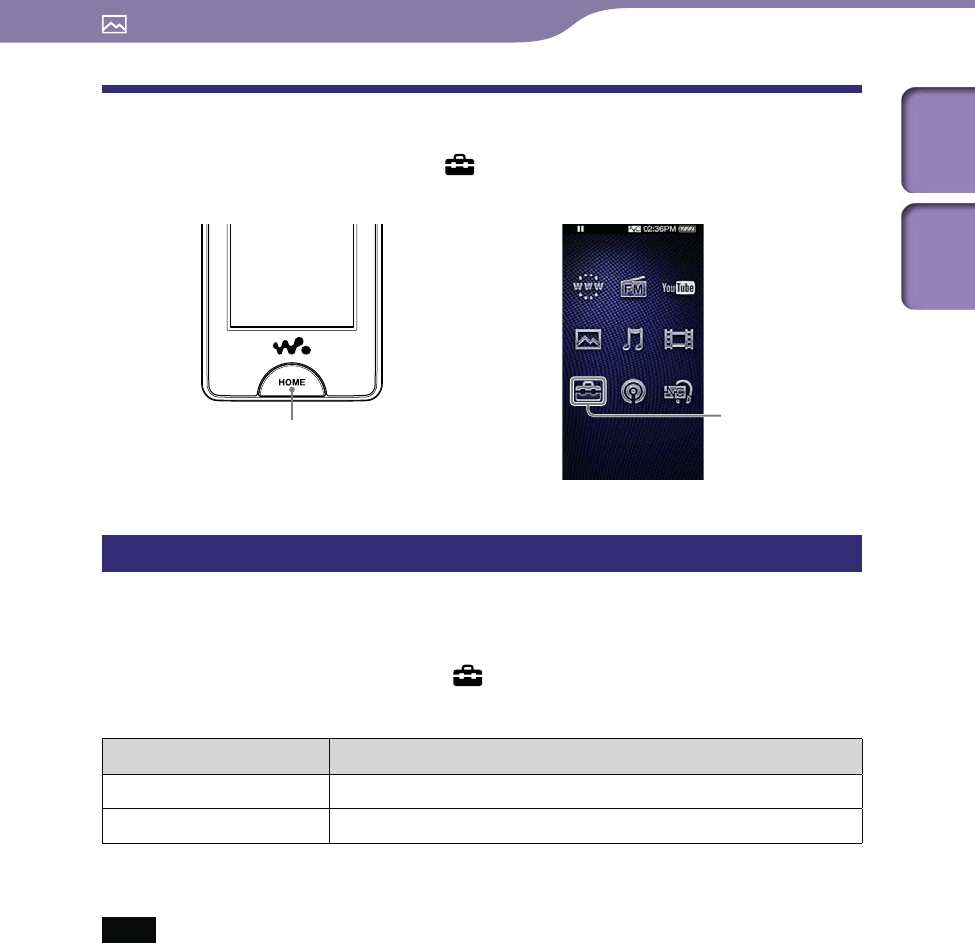
Viewing Photos
70
70
Changing the Photo Settings
To change the photo settings, select (Settings) from the Home menu, then
select “Photo Settings.”
HOME button Settings
Setting the Photo List Display Format
The player offers 2 display formats. You can set the display format of the photo
list as “Thumbnail + Title*1” or “Thumbnail Only.”
From the Home menu, select (Settings) “Photo Settings”
“Photo List Format” the desired photo list format type “OK.”
Type Description
Thumbnail + Title Displays a photo title with a thumbnail image in the photo list.
Thumbnail Only Displays only thumbnails in the photo list. (Default setting)
*1 Thumbnail refers to a reduced size image of a photo.
Note
Thumbnails may not be displayed, depending on the file format.
Table of
Contents
Index

Listening to FM Radio
71
71
Listening to FM Radio
To Listen to FM Radio, select (FM Radio) from the Home menu to display
the FM Radio screen.
The FM radio information, control buttons, etc., are displayed on the FM
Radio screen.
HOME button
FM Radio
Note
The headphone cord serves as an antenna, so extend it as far as possible.
Table of
Contents
Index
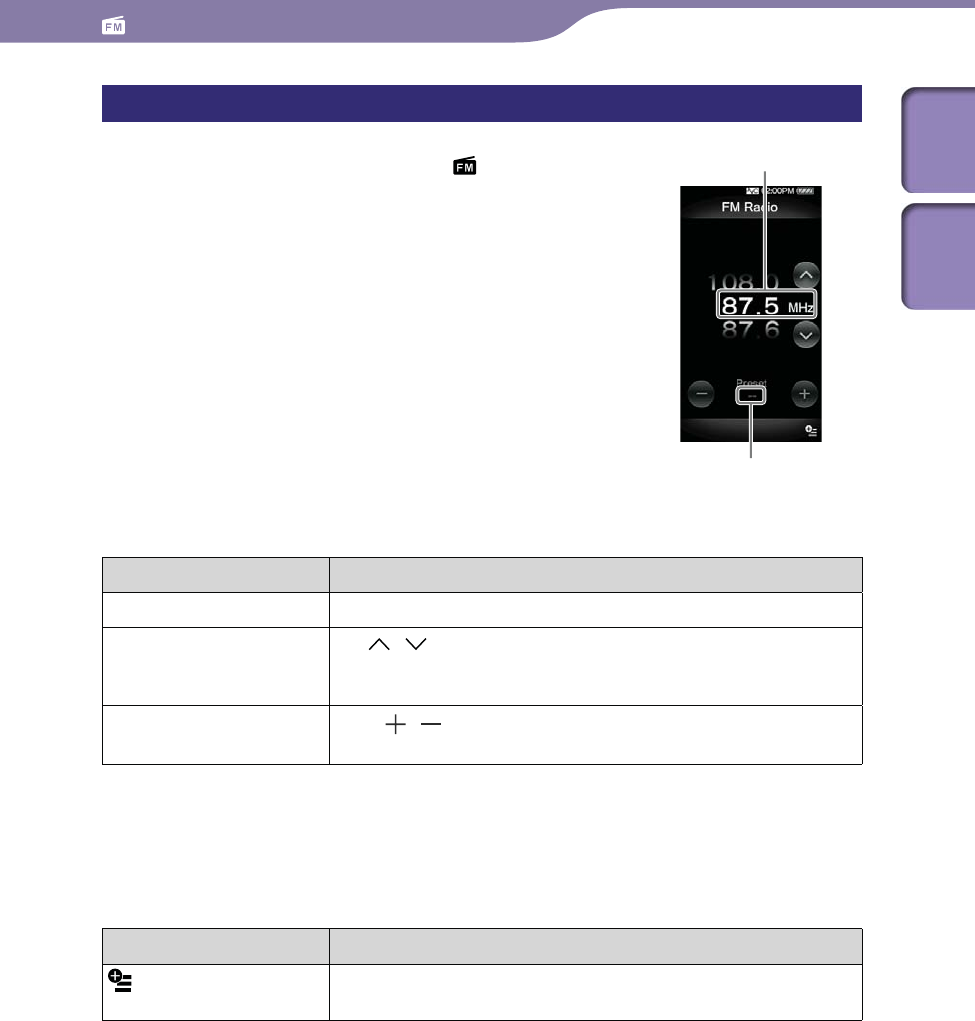
Listening to FM Radio
72
72
To listen to FM radio
From the Home menu, select (FM
Radio) the desired frequency or
Preset number.
You can tap the control buttons, icons etc.,
on the FM Radio screen to operate the
player.
Frequency
Preset number
FM Radio screen
To Do this
Tune the radio manually Drag or flick the frequency up or down.
Search the previous/
next receivable broadcast
station*1
Tap / .
To stop searching, tap the screen or press one of the
// buttons on the body of the player.
Select the previous/
next preset number*2 Tap / .
Press the / button on the body.
*1 If sensitivity is too high, change the “Scan Sensitivity” setting ( page 75) to “Low.”
*2 You cannot select the Preset number if no preset stations are entered. Preset the
receivable stations using “Auto Preset” ( page 73).
Icons on the FM Radio screen
Icon Description
(Option Menu) Shows the option menu. For details on the FM radio option
menu, see “Using the FM Radio Option Menu” ( page 76).
Table of
Contents
Index

Listening to FM Radio
73
73
Presetting broadcast stations automatically (Auto Preset)
You can preset receivable broadcast stations (up to 30 stations) in your area
automatically by selecting “Auto Preset.” When you use the FM radio for the
first time, or when you move to a new area, we recommend you preset
receivable broadcast stations by selecting “Auto Preset.”
From the FM Radio screen, select (Option Menu) “Auto Preset”
“Yes.”
The receivable broadcast stations will be preset in order from low to high
frequency.
“Auto Preset completed.” appears when presetting is completed, then the
first preset station is ready to be received.
Select “No” to cancel the automatic presetting.
Hint
If high sensitivity causes the player to receive many unwanted broadcast stations, change
the “Scan Sensitivity” setting ( page 75) to “Low.”
Note
The “Auto Preset” operation will delete already preset broadcast stations.
Table of
Contents
Index
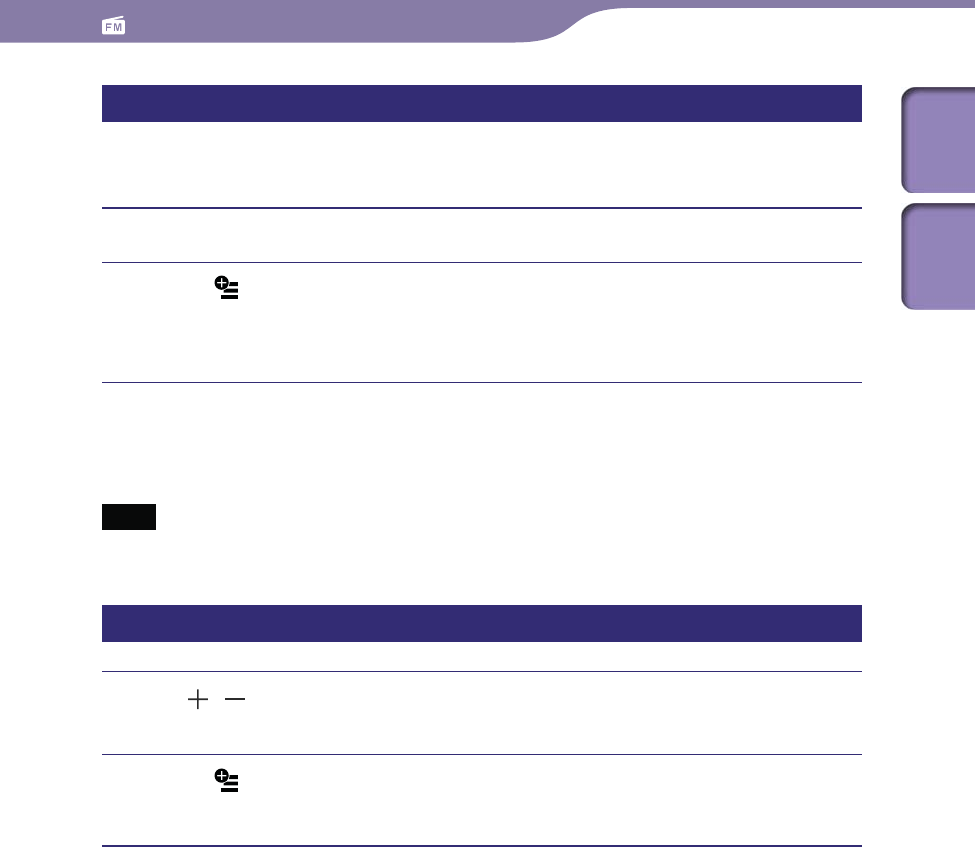
Listening to FM Radio
74
74
Presetting broadcast stations manually
You can preset broadcast stations which “Auto Preset” cannot detect ( page
73).
On the FM Radio screen, select the desired frequency.
Select (Option Menu) “Save to Preset.”
The frequency you select in step is preset and the assigned Preset
number appears below the frequency.
Hint
You can preset up to 30 stations.
Note
The preset numbers are stored in order, from low to high frequency.
Deleting preset broadcast stations
Tap / on the FM Radio screen to select a desired Preset
number for the frequency.
Select (Option Menu) “Delete from Preset.”
The selected preset broadcast station is deleted.
Table of
Contents
Index

Listening to FM Radio
75
75
Changing the FM Radio Settings
To change the FM radio settings, select (Settings) from the Home menu,
then select “FM Radio Settings.”
HOME button Settings
Scan Sensitivity
When you select stations using the “Auto Preset” function ( page 73) or
tapping / , the FM receiver may receive many unwanted broadcast stations
because sensitivity is too high. In this case, set the reception to “Low.” “High” is
set by default.
From the Home menu, select (Settings) “FM Radio Settings”
“Scan Sensitivity” “Low” “OK.”
To set the reception sensitivity back to the default, select “High.”
Mono/Auto
If noise occurs during FM reception, set the receiver to “Mono” for monaural.
If you set it to “Auto,” monaural/stereo reception is selected automatically,
depending on reception conditions. “Auto” is set by default.
From the Home menu, select (Settings) “FM Radio Settings”
“Mono/Auto” “Mono” “OK.”
To return to the automatic setting, select “Auto.”
Table of
Contents
Index
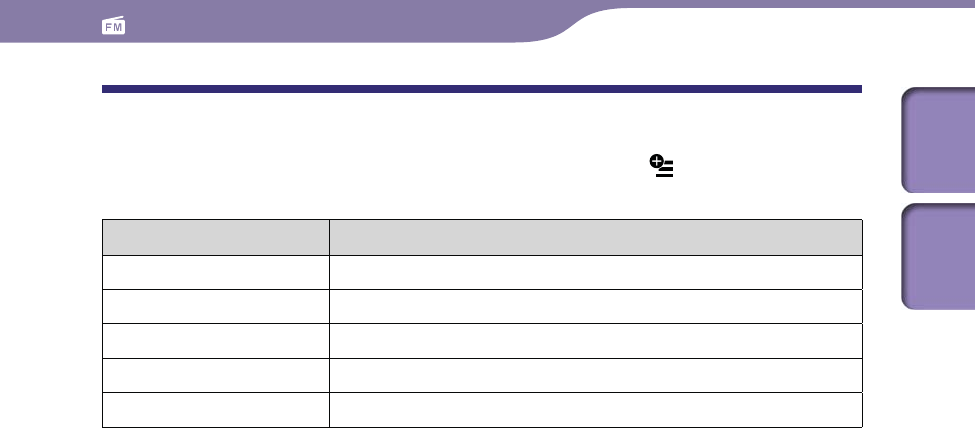
Listening to FM Radio
76
76
Using the FM Radio Option Menu
You can bring up the FM radio option menu by selecting (Option Menu) on
the FM Radio screen. For how to use the option menu, see page 18.
Option Items Description/reference page
Scan Sensitivity Adjusts the sensitivity of the radio reception ( page 75).
Mono/Auto Changes to either monaural or stereo ( page 75).
Save to Preset Presets the currently tuned-in broadcast station ( page 74).
Delete from Preset*1Deletes a broadcast station from the preset stations ( page 74).
Auto Preset Presets the broadcast stations automatically ( page 73).
*1 If no preset stations are entered, this option item does not appear.
Table of
Contents
Index
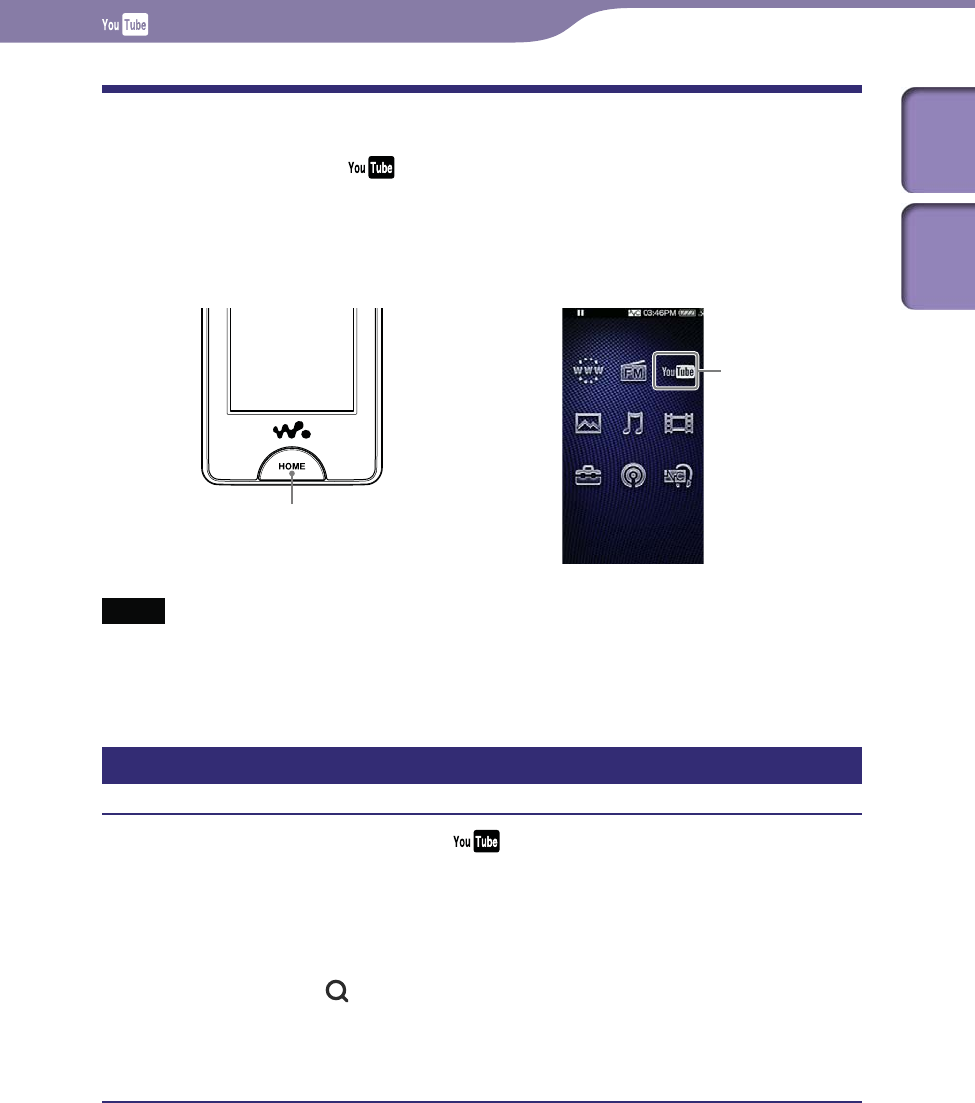
Watching YouTube
77
77
Watching YouTube
To watch YouTube, select (YouTube) from the Home menu to display the
YouTube list screen. You can play a YouTube video by selecting the desired
video from the list.
The video information, control buttons, etc., are displayed on the YouTube
playback screen.
HOME button
YouTube
Notes
To watch YouTube, you need to connect to a wireless LAN. For information on wireless
LAN connection settings, see “Wireless LAN Connection” ( page 33).
Before watching YouTube, adjust the date and time ( page 26).
To watch YouTube
From the Home menu, select (YouTube).
If the player has not connected to a wireless LAN yet, the connection
confirmation screen appears. Follow the instructions of “Connecting to a
wireless LAN” ( page 34) to connect.
After establishing a connection, the YouTube list screen appears.
When you select (Search) on the YouTube playback screen or the
YouTube list screen, the search menu appears. You can select desired
search method to display the list screen and search for videos. For
details, see “Searching for YouTube Videos” ( page 80).
Continued
Table of
Contents
Index
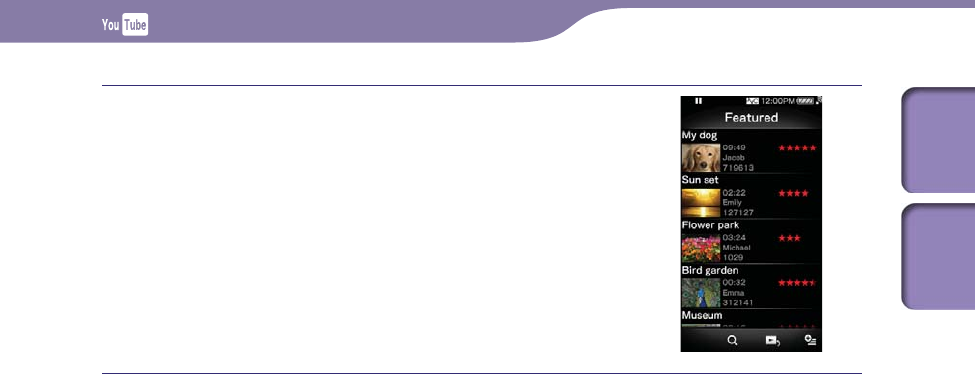
Watching YouTube
78
78
Select the desired video.
The playback of the YouTube video
begins.
You can tap the control buttons,
icons etc., on the YouTube playback
screen to operate the player. For
details on how to control the video
playback, see “YouTube playback
screen” ( page 79).
Table of
Contents
Index
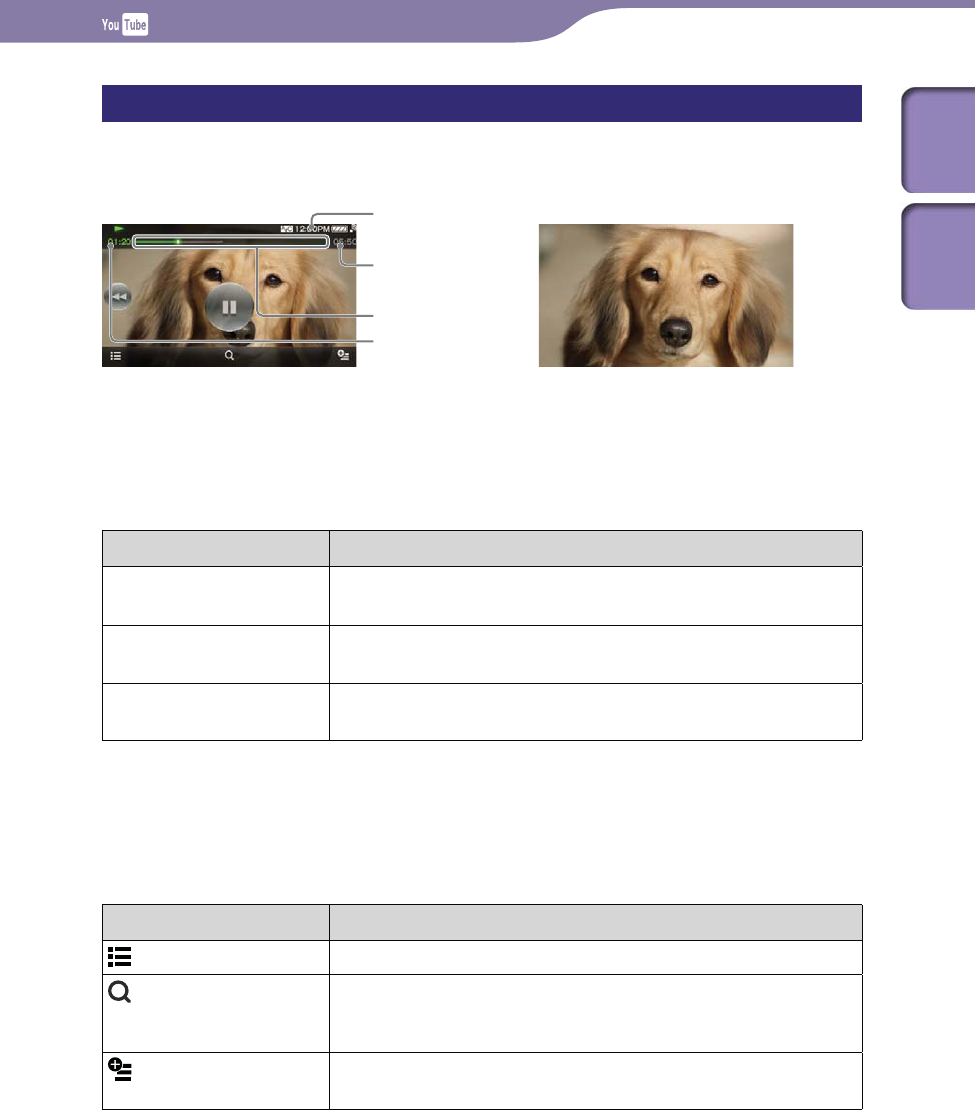
Watching YouTube
79
79
YouTube playback screen
You can bring up or dismiss the control buttons, icons, etc., by tapping the
screen. If there is no operation for a while, they disappear.
Information area
Seek Slider
Total time
Elapsed time
Operations on the YouTube playback screen
You can tap the objects such as control buttons on the screen to operate the
player. Also, you can use the / buttons on the body of the player to
operate it.
To (screen indication) Do this
Play ()/pause ()*1 Tap (play)/ (pause).
Press the button on the body.
Find the beginning of the
current video
Tap .
Press the button on the body.
Move to any point in a
video*2
Drag along the Seek Slider to move the indicator (playback
point). The playback begins at the point of the indicator.
*1 During pause, if there is no operation for a while, the player automatically enters
standby mode.
*2 You cannot move to a point where the video data has not been buffered.
Icons on the playback screen
Icon Description
(To List) Shows a list screen.
(Search) Shows the search menu. You can select desired search method to
display the list screen and search for videos. For details, see
“Searching for YouTube Videos” ( page 80).
(Option Menu) Shows the option menu. For details on the YouTube option
menu, see “Using the YouTube Option Menu” ( page 82).
Table of
Contents
Index
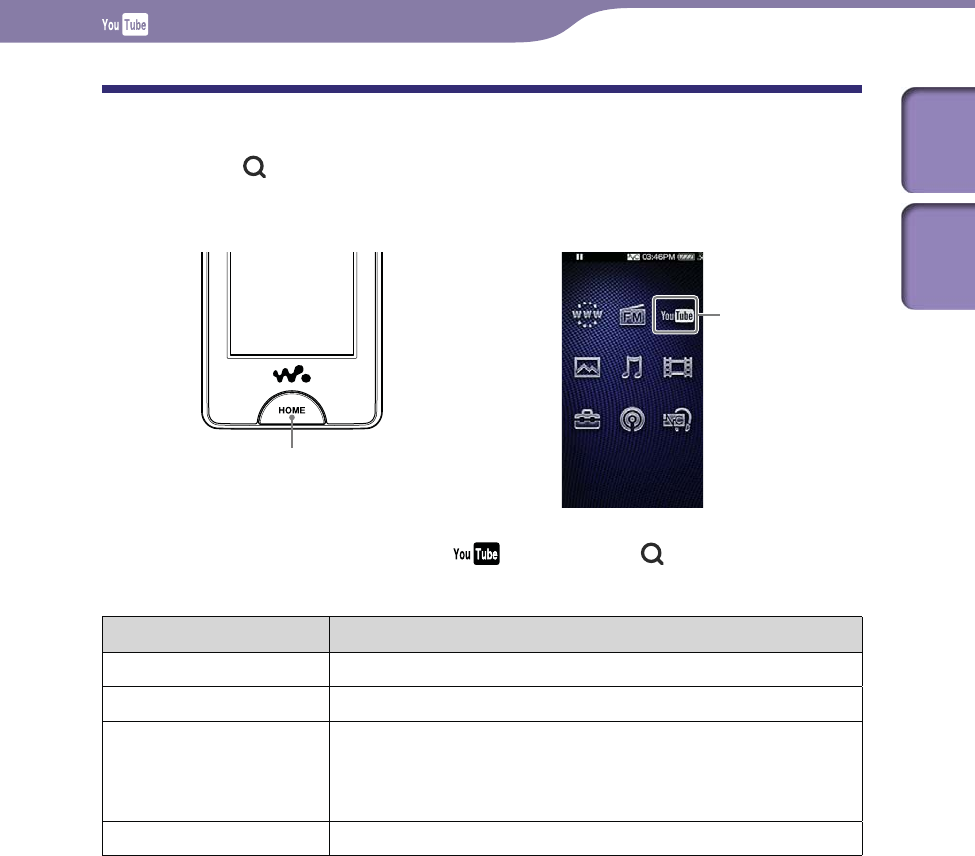
Watching YouTube
80
80
Searching for YouTube Videos
When you tap (Search) on the YouTube playback screen or the list screen,
the search menu appears. You can select desired search method to search the
list for desired video.
HOME button
YouTube
From the Home menu, select (YouTube) (Search) the
desired search method the desired video.
Method Description
Featured*1Select from the list of featured videos on the YouTube site.
Most Viewed*1,*2Select from the list of most viewed videos on the YouTube site.
Keyword Search Search for videos by keyword and display the video list.
You can enter a keyword by using the onscreen keyboard and
select “OK” to display the video list. For how to input text, see
“Text Input” ( page 20).
Related Videos Select from the list of videos relating to the last played video.
*1 You can narrow down the list by choosing country/region ( page 81).
*2 You can narrow down the list by choosing a timeframe ( page 81).
Table of
Contents
Index
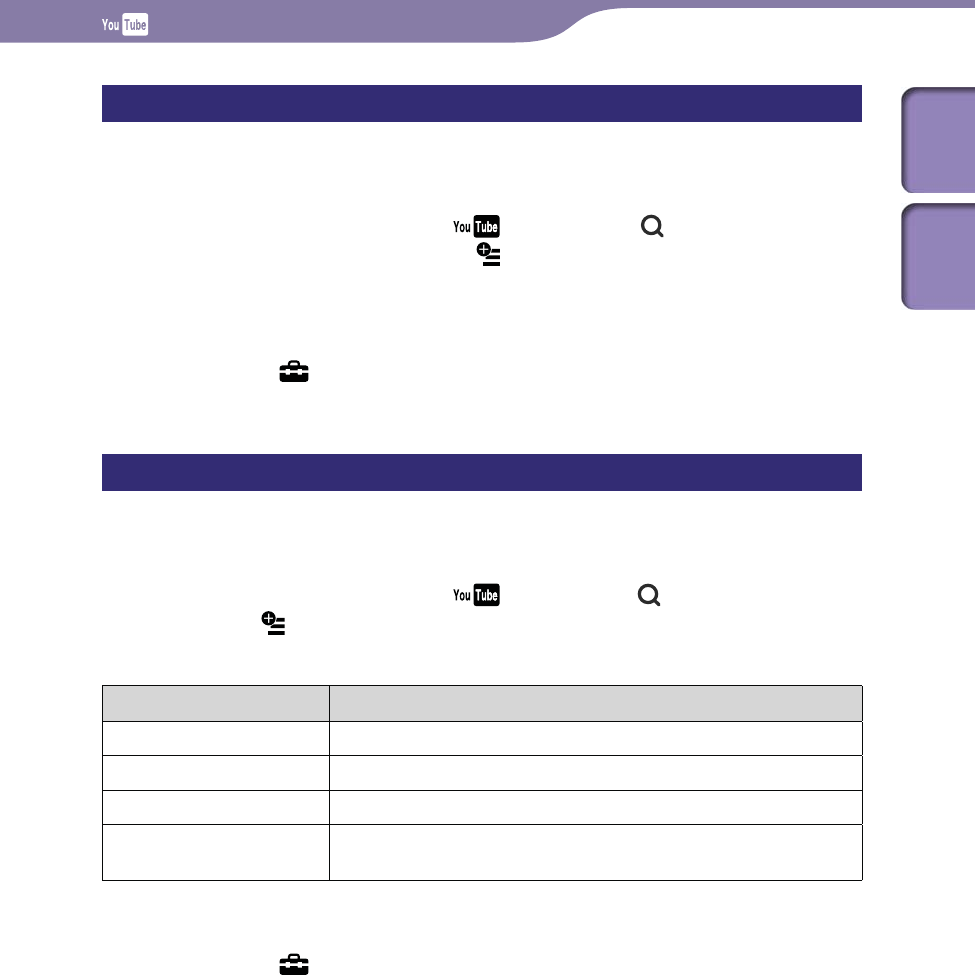
Watching YouTube
81
81
Choosing country/region
You can narrow down the “Featured” list and the “Most Viewed” list by
choosing country/region.
From the Home menu, select (YouTube) (Search)
“Featured” or “Most Viewed” (Option Menu) “Country/
Region” the desired country/region “OK.”
Hint
You can also select (Settings) “YouTube Settings” “Country/Region” from the
Home menu to choose country/region.
Choosing timeframe
You can narrow down the “Featured” list and the “Most Viewed” list by
choosing a timeframe.
From the Home menu, select (YouTube) (Search) “Most
Viewed” (Option Menu) “Timeframe” the desired
timeframe type “OK.”
Type Description
Today Displays the list of most viewed videos of the day.
This Week Displays the list of most viewed videos of the week.
This Month Displays the list of most viewed videos of the month.
All Time Displays the list of most viewed videos of all time. (Default
setting)
Hint
You can also select (Settings) “YouTube Settings” “Timeframe” from the Home
menu to choose a timeframe.
Table of
Contents
Index

Watching YouTube
82
82
Using the YouTube Option Menu
You can bring up the YouTube option menu by selecting (Option Menu) on
the YouTube playback screen or on the YouTube list screen. For how to use the
option menu, see page 18.
The option items shown on the option menu vary, depending on the screen
from which you bring up the option menu. See the reference page for settings
and usage.
Option item appearing on the list screen only
Option Item Description/reference page
Country/Region*1Narrows down the video list by choosing country ( page 81).
Timeframe*2Narrows down the video list by choosing a timeframe ( page
81).
*1 This option appears only when the “Featured” list or the “Most Viewed” list is displayed.
*2 This option appears only when the “Most Viewed” list is displayed.
Option items appearing on the playback screen
Option Items Description/reference page
Zoom Settings Sets the zoom function ( page 61).
Brightness Adjusts the brightness of the screen ( page 121).
On-Hold Display Sets to turn off the video screen during the player is on hold (
page 63).
Table of
Contents
Index

Enjoying Podcast
83
83
Before Enjoying Podcast
You can use the podcast function of the player in three ways. For details, see
each of the descriptions.
Register a podcast by using the player ( page 84), download episodes by
using the wireless LAN function of the player ( page 86), then play them
back ( page 90).
Register a podcast by using Media Manager for WALKMAN or Content
Transfer ( page 22), download episodes by using the wireless LAN
function of the player ( page 86), then play them back ( page 90).
Download episodes to a computer ( page 22), transfer them from the
computer to the player by using Media Manager for WALKMAN, Content
Transfer, or Windows Explorer ( page 22), then play them back ( page
90).
Note
If you transfer episodes of a podcast from a computer to the player by using Windows
Explorer, you cannot refresh the podcast by using the wireless LAN function until
registering the podcast.
What is a podcast?
A “podcast” is a group of audio or video files that is published on the Internet.
The files, called episodes, can be downloaded automatically by using RSS, to
play back. Many news sites, corporations, or individuals publish podcasts by
using RSS. You can register a podcast to the player by using an RSS icon on a
website. After registering, when the latest episodes are added to the podcast,
you can download them.
Table of
Contents
Index
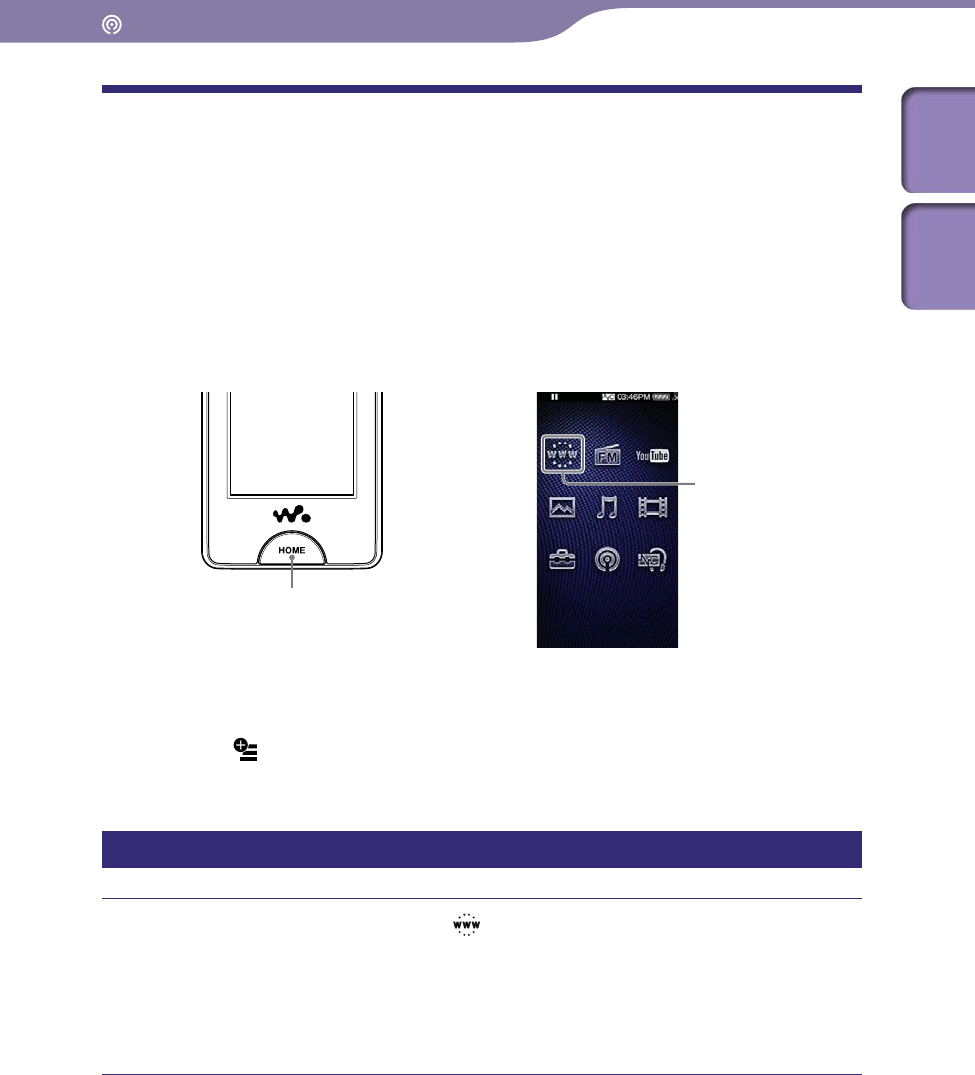
Enjoying Podcast
84
84
Registering a Podcast
To play back podcast episodes, you need to register the podcast to the player
and download episodes. You can register a podcast by selecting an RSS icon
displayed on the Internet browser of the player. For how to use the Internet
browser of the player, see “Viewing Websites (Internet Browser)” ( page
102).
You can also transfer a podcast by using Media Manager for WALKMAN or
Content Transfer to register the podcast to the player. For details about
transferring podcasts, refer to the Help of each software.
HOME button
Internet Browser
Hint
You can easily register podcasts by using the podcast link collection. From the list
screen, select (Option Menu) “To Podcast Links,” and then go to Step in the
next page.
Register a Podcast by using the Internet browser of the player
From the Home menu, select (Internet Browser).
If the player has not connected to a wireless LAN yet, the connection
confirmation screen appears. Follow the instructions of “Connecting to a
wireless LAN” ( page 34) to connect.
After establishing a connection, the Internet browser appears.
Continued
Table of
Contents
Index

Enjoying Podcast
85
85
Open the web page of the desired podcast, then select the RSS
icon.
The podcast is registered to the player by selecting the RSS icon.
RSS icons differ between websites. Refer to descriptions on the website
to select an RSS icon.
For how to use the Internet browser, see “Viewing Websites (Internet
Browser)” ( page 102).
Hint
You can transfer episodes from a computer to the player, without registering the podcast.
For details, see “Transferring Music/Videos/Photos/Podcasts” ( page 28).
Note
If you transfer episodes of a podcast from a computer to the player by using Windows
Explorer, you cannot refresh the podcast by using the wireless LAN function. If you
intend to refresh the podcast, register it by using the player or Media Manager for
WALKMAN. For how to register podcasts by using Media Manager for WALKMAN,
refer to the Help of the Media Manager for WALKMAN.
Table of
Contents
Index
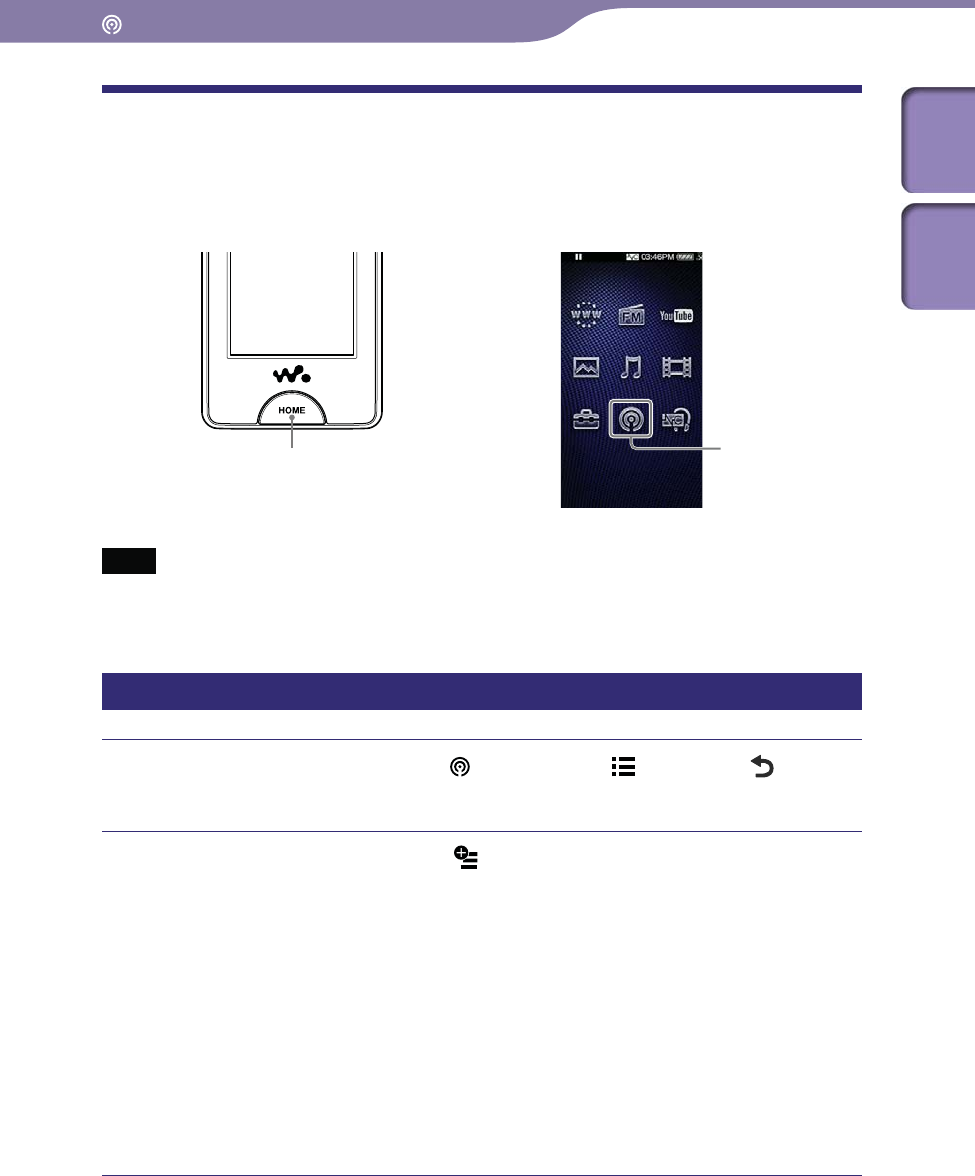
Enjoying Podcast
86
86
Downloading episodes
You can download the latest episodes of the desired podcast. Also, you can
download the latest episodes from all of the podcasts you have selected to
refresh.
HOME button Podcasts
Note
To download episodes from podcasts registered to the player, the player need to connect
to a wireless LAN.
Downloading from a podcast
From the Home menu, select (Podcasts) (To List) (Back).
The Podcast List screen appears.
Select the desired podcast (Option Menu) “Refresh This
Podcast.”
If the player has not connected to a wireless LAN yet, the connection
confirmation screen appears. Follow the instructions of “Connecting to a
wireless LAN” ( page 34) to connect.
After establishing a connection, the download of the latest episodes
begins.
You can select “Cancel” to cancel the download and return to the
episode list screen.
You can select “Skip” to skip the current episode and continue
downloading from the next episode.
Table of
Contents
Index
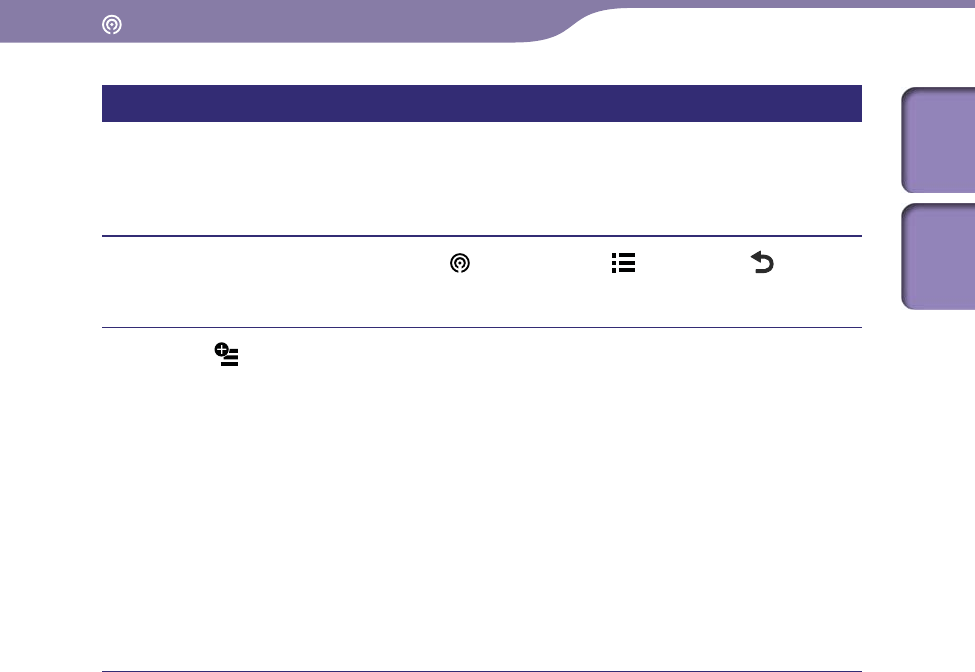
Enjoying Podcast
87
87
Downloading from all of the podcast selected to refresh
You can download the latest episodes from all of the podcasts you have selected
to refresh. For how to select/deselect podcasts to refresh, see “Selecting/
deselecting podcasts to refresh” ( page 88).
From the Home menu, select (Podcasts) (To List) (Back).
The Podcast List screen appears.
Select (Option Menu) “Refresh Podcast.”
If the player has not connected to a wireless LAN yet, the connection
confirmation screen appears. Follow the instructions of “Connecting to a
wireless LAN” ( page 34) to connect.
After establishing a connection, the download of the latest episodes of
each podcasts begins.
You can select “Cancel” to cancel the download and return to the
Podcast List screen.
You can select “Skip” to skip the current episode and continue
downloading of the next episode. If the last episode of the podcast is
skipped, the player continues downloading from the next podcast.
Hint
You can set the number of the latest episodes to be downloaded by setting “Number of
Downloads” option ( page 89).
Table of
Contents
Index
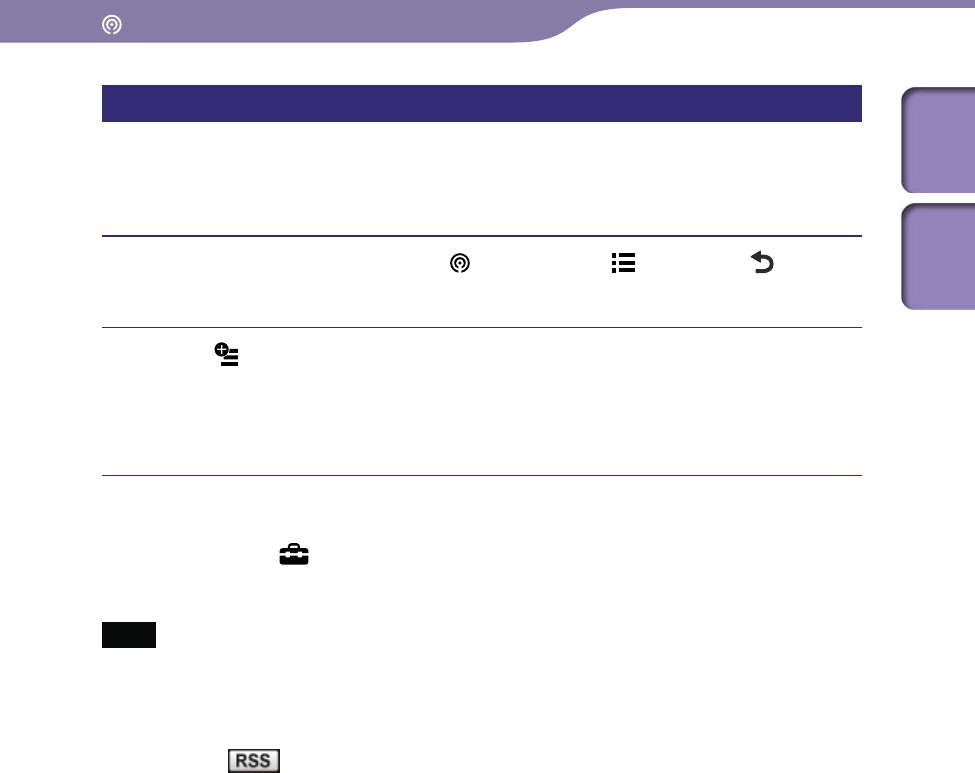
Enjoying Podcast
88
88
Selecting/deselecting podcasts to refresh
You can select/deselect podcasts to refresh. By selecting podcasts to refresh,
you can download the latest episodes of the podcasts by using “Refresh
Podcast” ( page 87).
From the Home menu, select (Podcasts) (To List) (Back).
The Podcast List screen appears.
Select (Option Menu) “Select Podcast to Refresh” podcasts
to refresh “OK.”
Check the podcast to select to refresh. Uncheck the podcast to deselect.
When a podcast is registered, it is selected to refresh.
Hint
You can also select (Settings) “Podcast Settings” “Select Podcast to Refresh”
from the Home menu to select/deselect podcasts to refresh.
Note
If you transfer episodes of a podcast from a computer to the player by using Windows
Explorer, you cannot refresh the podcast by using the wireless LAN function until
registering the podcast. If you intend to refresh the podcast, register it by using the
player or Media Manager for WALKMAN. The podcast that can be refreshed is
indicated by in the Podcast List screen.
Table of
Contents
Index

Enjoying Podcast
89
89
Setting the number of episodes to be downloaded
You can set the number of the latest episodes to be downloaded when
refreshing podcasts.
From the Home menu, select (Podcasts) (To List)
(Option Menu) “Number of Downloads” the desired episode
number type “OK.”
Type Description
Latest Episode Downloads the latest 1 episode.
Latest 3 Episodes Downloads the latest 3 episodes.
Latest 5 Episodes Downloads the latest 5 episodes.
Latest 10 Episodes Downloads the latest 10 episodes.
Latest 100 Episodes Downloads the latest 100 episodes.
Hint
You can also select (Settings) “Podcast Settings” “Number of Downloads” from
the Home menu to set the number of the episodes to be downloaded.
Note
If an episode has already been downloaded, it is not downloaded when refreshing
podcasts. For example, if the option is set to “Latest 3 Episodes” and one of the latest 3
episodes has already been downloaded, the remaining 2 episodes are downloaded.
Table of
Contents
Index

Enjoying Podcast
90
90
Playing Podcast
To play a podcast, select (Podcasts) to display the podcast playback screen.
You can select the desired episode by selecting (To List) on the podcast
playback screen.
The episode’s information, control buttons, etc., are displayed on the podcast
playback screen.
HOME button Podcasts
To play podcast
From the Home menu, select (Podcasts).
The podcast playback screen appears.
When you select (To List) on the podcast playback screen, the
episode list appears ( page 95). When you select (Back) on the
episode list screen, the Podcast List screen appears ( page 96).
Select .
The playback of the episode begins.
You can tap the control buttons, icons etc.,
on the podcast playback screen to operate
the player. For details on how to control
the podcast playback, see “Podcast
playback screen” ( page 91).
Note
You cannot play back podcast episodes continuously.
Table of
Contents
Index

Enjoying Podcast
91
91
Podcast playback screen
You can bring up or dismiss the control buttons by tapping the screen. If there
is no operation for a while, they disappear.
You can tap the objects such as control buttons on the screen to operate the
player. Also, you can use the // buttons on the body of the player
to operate.
Audio playback screen
Information area
Episode name
Artist name
Podcast name
Total time
Seek Slider
Elapsed time
Operations on the audio playback screen
To (screen indication) Do this
Play ()/pause ()*1 Tap (play)/ (pause).
Press the button on the body.
Fast forward ()/
fast rewind ()
Touch and hold /.
Press and hold the / button on the body.
Find the beginning of the
episode*2 Tap /.
Press the / button on the body.
Move to any point in a
song
Drag the indicator (playback point) along the Seek Slider. The
playback begins at the point of the indicator.
*1 During pause, if there is no operation for a while, the player automatically enters
standby mode.
*2 Both of the / buttons find the beginning of the episode. To play back the next
episode, select (To List) to display the episode list to select the desired episode.
Continued
Table of
Contents
Index
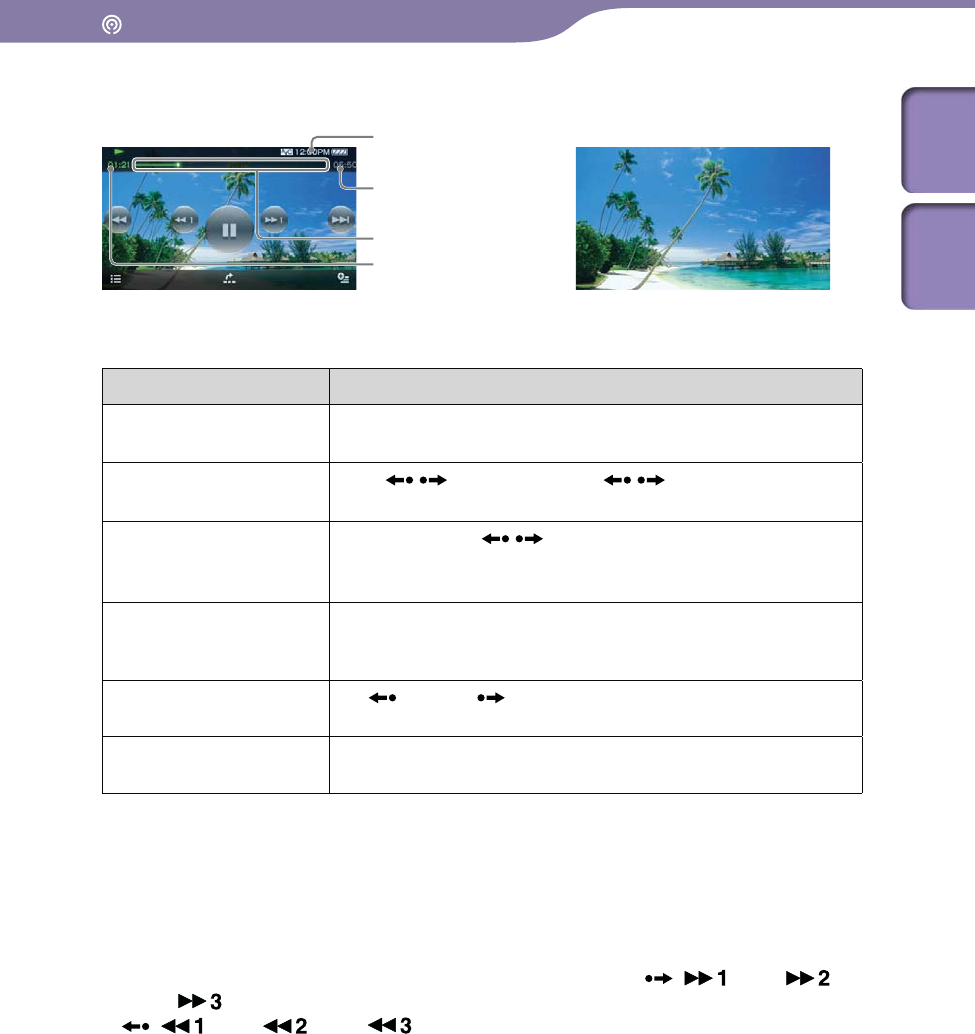
Enjoying Podcast
92
92
Video playback screen
Information area
Seek Slider
Total time
Elapsed time
Operations on the video playback screen
To (screen indication) Do this
Play ()/pause ()*1 Tap (play)/ (pause).
Press the button on the body.
Fast forward ()/
fast rewind ()*2*3 Tap /, or touch and hold / .*4
Press and hold the / button on the body.
Fast forward ()/
fast rewind () during
pause*5
Touch and hold / during pause.
Press and hold the / button on the body during
pause.
Move to the previous
scene ()/move to the
next scene ()
Tap /.
Press the / button on the body.
Rewind slightly/forward
slightly
Tap (rewind)/ (forward) during pause.
Move to any point in a
video
Drag along the Seek Slider to move the indicator (playback
point). The playback begins at the point of the indicator.
*1 During pause, if there is no operation for a while, the player automatically enters
standby mode.
*2 If you fast-forward to the end of the episode, the playback pauses. If you fast-rewind to
the beginning of the episode during playback, the playback restart automatically. If you
fast-rewind to the beginning to the episode during pause, the playback remains paused.
*3 These buttons may not work as described above depending on the episode.
*4 Forward speed changes through 3 levels by repeatedly tapping ( (×10),
(×30), (×100)). Also, rewind speed changes through 3 levels by repeatedly tapping
( (×10), (×30), (×100)). Tap to exit the operation and resume
normal playback.
*5 The speed of fast forward/fast rewind during pause varies depending on the length of
the video.
Continued
Table of
Contents
Index
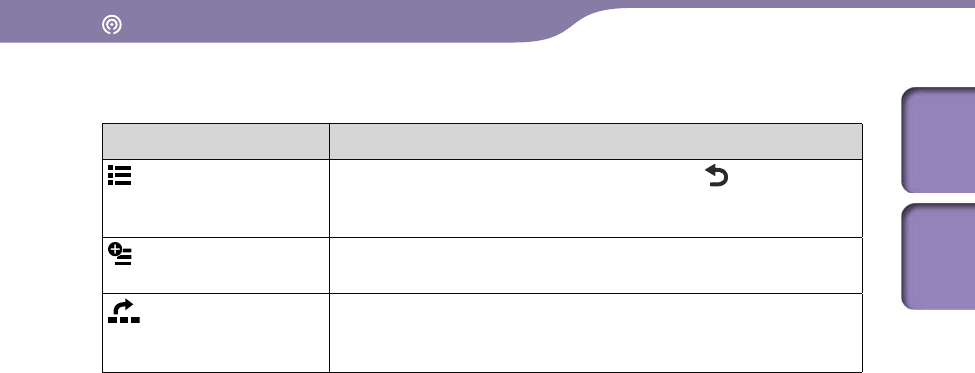
Enjoying Podcast
93
93
Icons on the playback screen
Icon Description
(To List) Shows an episode list screen. When you select (Back) on an
episode list screen, the Podcast List screen appears. For details,
see “Searching for Podcasts” ( page 94).
(Option Menu) Shows the option menu. For details on the podcast option menu,
see “Using the Podcast Option Menu” ( page 100).
(Scene Scroll)*1Shows the Scene Scroll screen. You can browse scenes by flicking
the images on the screen, to select the desired scene. For details,
see “Browsing scenes (Scene Scroll)” ( page 57).
*1 Scene Scroll icon appears on the video playback screen only.
Table of
Contents
Index
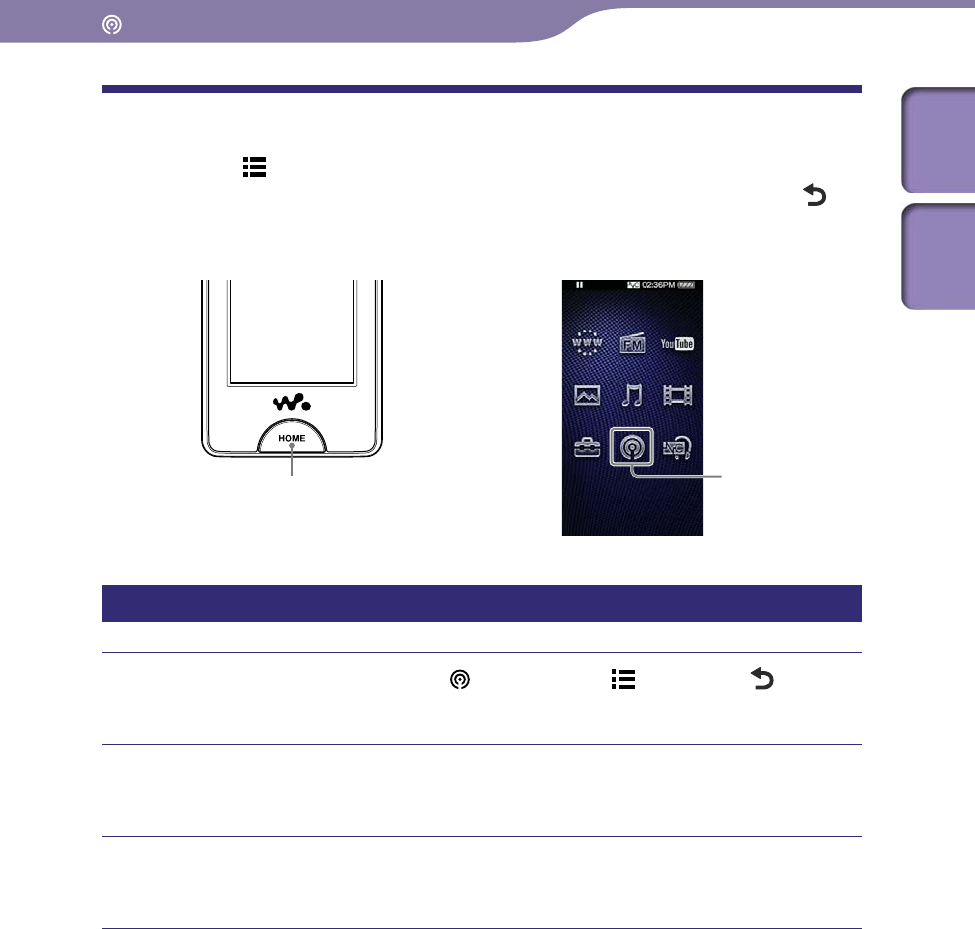
Enjoying Podcast
94
94
Searching for Podcasts
When you tap (To List) on the podcast playback screen, the episode list
appears, and you can select a desired episode to play back. When you tap
(Back) on the episode list screen, the podcast list appears, and you can select a
a desired podcast to display its episode list.
HOME button Podcasts
To search for podcasts
From the Home menu, select (Podcasts) (To List) (Back).
The Podcast List screen appears.
Select the desired podcast.
The episode list screen appears.
Select the desired episode.
The playback of the selected episode begins.
Hints
Podcasts are arranged by name.
Episodes are arranged by published date and time in reverse chronological order. The
episodes transferred using Windows Explorer are arranged by name and displayed under
the reverse chronological order list.
After you download a episode to the player, if you transfer the same episode from a
computer to the player, both episode files are displayed in the episode list.
Table of
Contents
Index

Enjoying Podcast
95
95
Episode list screen
Podcast name
Video icon
New icon
Playback icon
Audio icon
Icons of episodes
The following icons are displayed in the episode field.
Icon Description
(Audio icon) Shows that the episode is an audio episode.
(Video icon) Shows that the episode is a video episode.
(New icon) Shows that the episode has never been played back yet.
(Playback icon) Shows that the episode is currently playing.
Operations on the episode list screen
To Do this
Select an episode Tap an episode.
Scroll the list up or down Drag or flick up or down.
Icons on the episode list screen
Icon Description
(Back) Shows the Podcast List screen.
(To Play Screen) Returns to the podcast playback screen.
(Option Menu) Shows the option menu. For details on the podcast option menu,
see “Using the Podcast Option Menu” ( page 100).
Table of
Contents
Index
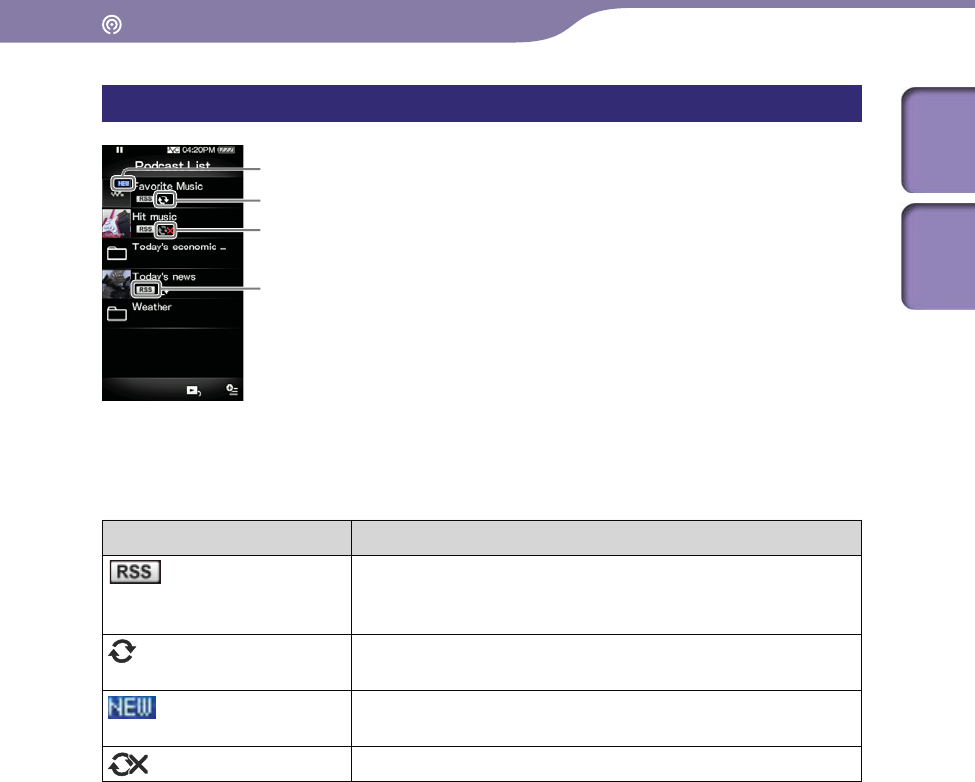
Enjoying Podcast
96
96
Podcast List screen
Selected to refresh icon
Refresh error icon
RSS icon
New icon
Icons of podcasts
The following icons are displayed in the podcast name*1 field.
Icon Description
(RSS icon) Indicates that the podcast is registered to the player. This icon
is not displayed for episodes that are transferred from a
computer by using Windows Explorer*2.
(Selected to refresh icon) Shows that the podcast is selected to refresh by using “Refresh
Podcast.”
(New icon)*3Shows that the latest episode(s) of the podcast has been
downloaded.
(Refresh error icon)*4Appears when updating or downloading failed.
*1 The folder name is displayed for the podcast that is transferred from a computer to the
player by using Windows Explorer.
*2 You cannot refresh the podcast that is transferred from a computer to the player by
using Windows Explorer. If you intend to refresh the podcast, register it by using the
player or Media Manager for WALKMAN.
*3 After you display the episode list of the podcast, the New icon disappears.
*4 After the podcast is refreshed correctly, the Refresh error icon disappears.
Continued
Table of
Contents
Index
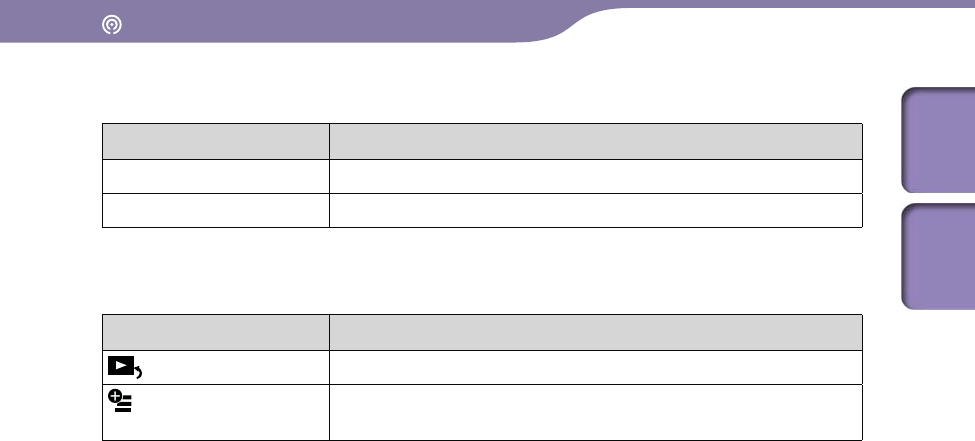
Enjoying Podcast
97
97
Operations on the Podcast List screen
To Do this
Select a podcast Tap a podcast.
Scroll the list up or down Drag or flick up or down.
Icons on the Podcast List screen
Icon Description
(To Play Screen) Returns to the podcast playback screen.
(Option Menu) Shows the option menu. For details on the podcast option menu,
see “Using the Podcast Option Menu” ( page 100).
Table of
Contents
Index

Enjoying Podcast
98
98
Deleting Podcasts
You can delete an episode, all episodes of a podcast, a podcast, and all
registered podcasts.
Deleting the currently playing episode
From the playback screen of the episode you intend to delete,
select (Option Menu) “Delete This Episode” “Yes.”
Deleting an episode in the episode list
From the episode list, select (Option Menu) “Delete Episode”
the episode you intend to delete “Yes.”
Deleting all episodes of a podcast
This operation deletes all episodes of a podcast but does not delete the podcast
itself.
From the episode list of the podcast you intend to delete, select
(Option Menu) “Delete All Episodes” “Yes.”
Deleting a podcast
The following operations delete all episodes of a podcast and delete the podcast
registration.
From the Podcast List screen, select (Option Menu) “Delete
Podcast” the podcast you intend to delete “Yes.”
or,
From the episode list of the podcast you intend to delete, select
(Option Menu) “Delete This Podcast” “Yes.”
Table of
Contents
Index

Enjoying Podcast
99
99
Deleting all podcasts
This operation deletes all episodes of all podcasts and deletes all podcast
registrations.
From the podcast list screen, select (Option Menu) “Delete All
Podcasts” “Yes.”
Table of
Contents
Index
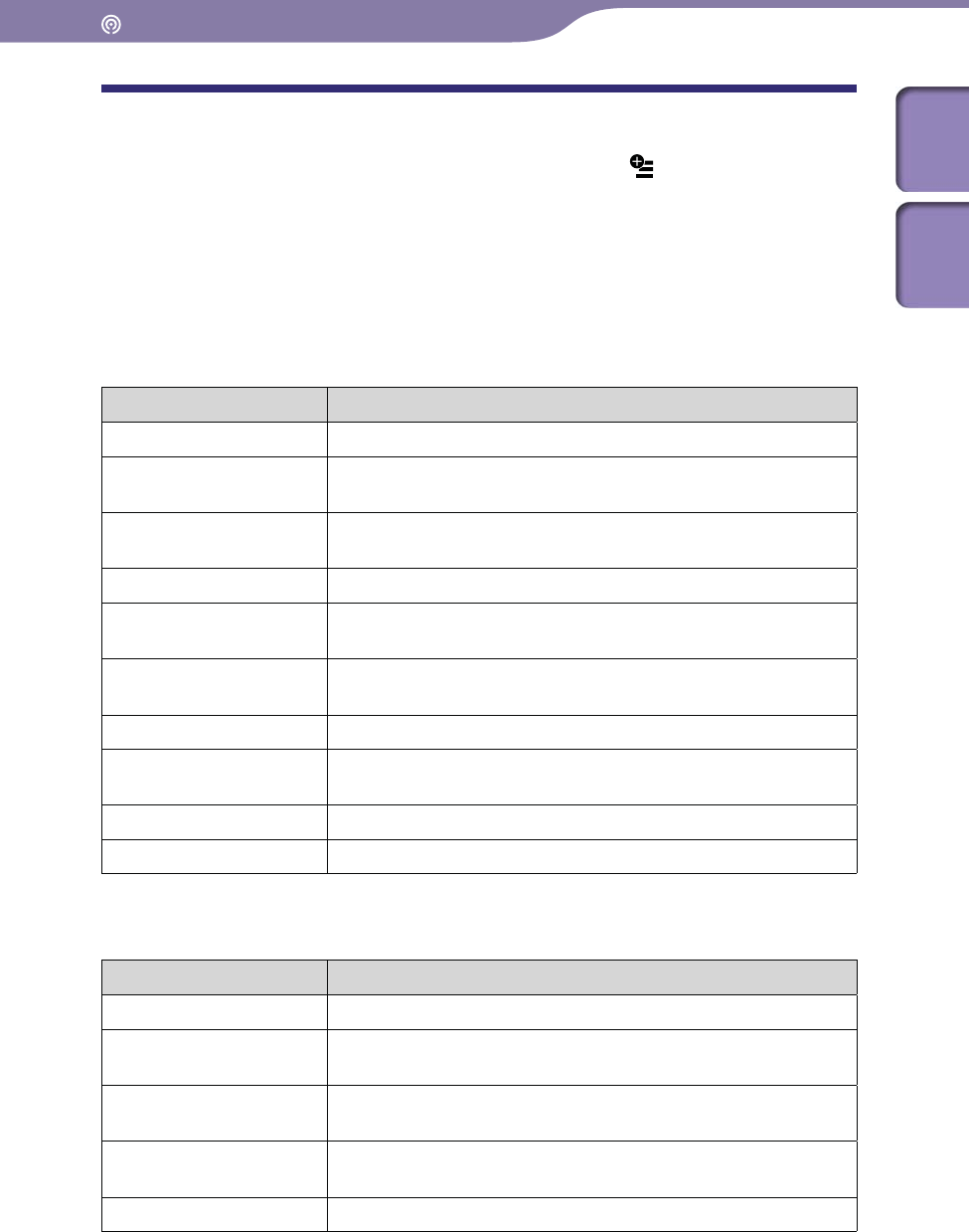
Enjoying Podcast
100
100
Using the Podcast Option Menu
You can bring up the podcast option menu by selecting (Option Menu) on
the podcast playback screen or on the list screen. For how to use the option
menu, see page 18.
The option items shown on the option menu vary, depending on the screen
from which you bring up the option menu. See the reference page for settings
and usage.
Option items appearing on the podcast playback screen
Option Items Description/reference page
Equalizer (audio only) Customizes the sound quality ( page 48).
VPT (Surround)
(audio only)
Customizes the “VPT(Surround)” settings ( page 50).
DSEE (Sound Enhance)
(audio only)
Enables/disables the “DSEE (Sound Enhance)” option ( page
51).
Clear Stereo (audio only) Enables/disables the “Clear Stereo” option ( page 52).
Dynamic Normalizer
(audio only)
Enables/disables the “Dynamic Normalizer” option ( page 52).
Zoom Settings
(video only)
Sets the zoom function ( page 61).
Brightness (video only) Adjusts the brightness of the screen ( page 121).
On-Hold Display
(video only)
Sets to turn off the video screen during the player is on hold (
page 63).
Detailed Information Displays detailed information of an episode.
Delete This Episode Deletes an episode ( page 98).
Option item appearing on the episode list screen
Option Item Description/reference page
Number of Downloads Sets the number of the episodes to be downloaded ( page 89).
Refresh This Podcast Connects to the Internet via wireless LAN and downloads the
latest episode(s) of the current podcast ( page 86).
Delete Episode Displays the delete episode screen to select an episode to delete
( page 98).
Delete All Episodes Deletes all episodes of the podcast. The podcast registration itself
is not deleted ( page 98).
Delete This Podcast Deletes the podcast ( page 98).
Continued
Table of
Contents
Index
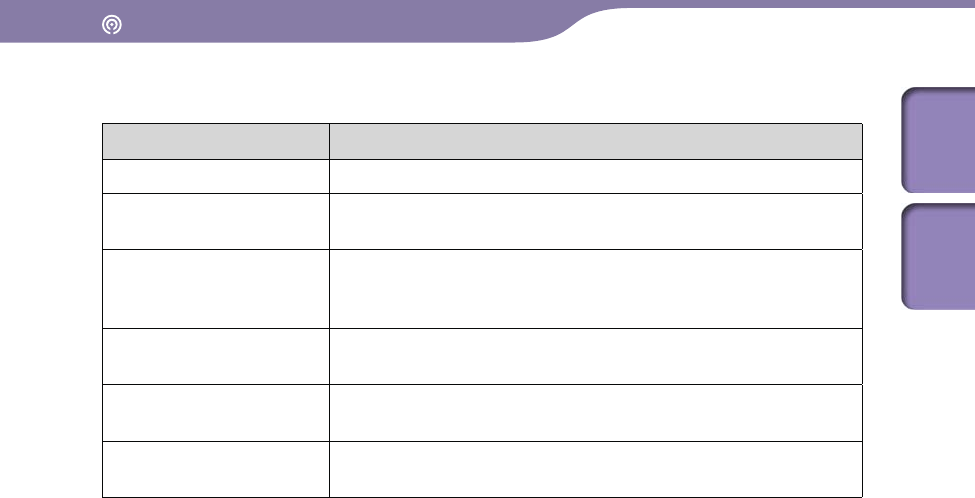
Enjoying Podcast
101
101
Option item appearing on the Podcast List screen
Option Item Description/reference page
Number of Downloads Sets the number of episodes to be downloaded ( page 89).
Select Podcast to Refresh Selects/deselects podcasts to refresh by using “Refresh Podcast”
( page 88).
Refresh Podcast Connects to the Internet via wireless LAN and downloads the
latest episode(s) of all podcasts you have selected to refresh (
page 87).
Delete Podcast Displays the Delete Podcast screen to select a podcast to delete all
its episodes and the podcast registration ( page 98).
Delete All Podcasts Deletes all episodes of all registered podcasts and their
registrations ( page 98).
To Podcast Links Connects to the Internet via wireless LAN and opens the Internet
browser to show the recommended podcast link collection.
Table of
Contents
Index
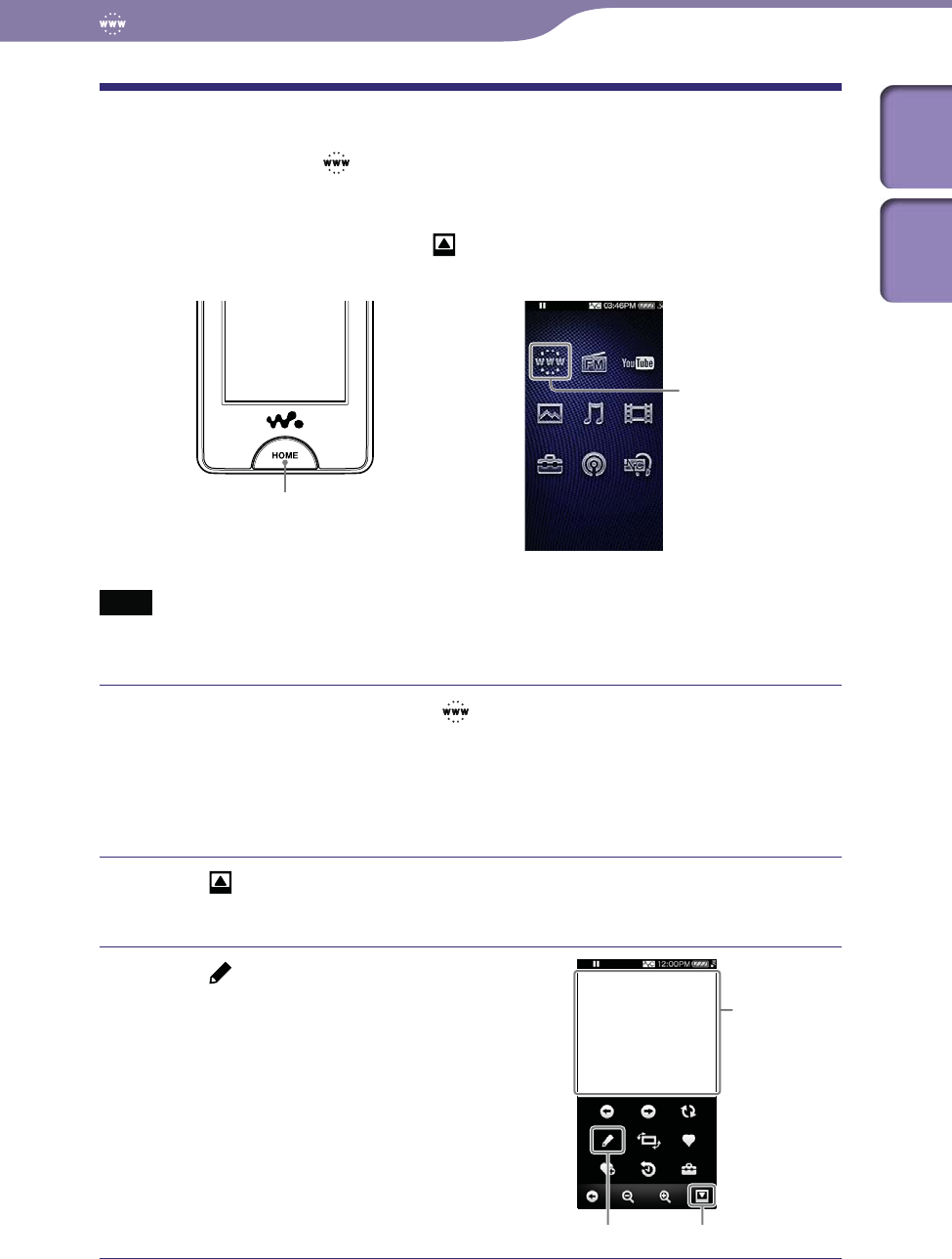
Viewing Websites
102
102
Viewing Websites
(Internet Browser)
To view websites, select (Internet Browser) from the Home menu to display
the Internet browser.
You can perform operations such as web page address input, favorites,
advanced settings, etc., by selecting (Menu) on the bottom right of the
Internet browser.
HOME button
Internet Browser
Note
To use the Internet browser, you need to connect to a wireless LAN. For information on
wireless LAN connection settings, see “Wireless LAN Connection” ( page 33).
From the Home menu, select (Internet Browser).
If the player is not connected to a wireless LAN yet, the connection
confirmation screen appears. Follow the instructions of “Connecting to a
wireless LAN” ( page 34) to connect.
After establishing a connection, the Internet browser appears.
Select (Menu).
The control buttons of the Internet browser appear.
Select (Address Input).
The Enter Address screen appears.
Address Input Menu
Web page
Continued
Table of
Contents
Index

Viewing Websites
103
103
Enter the address of the desired website, and then select “OK.”
Tap the address input field to display the onscreen keyboard.
Enter the address and select “OK” on the onscreen keyboard to return to
the Enter Address screen. After selecting “OK” on the Enter Address
screen, the loading of the web page begins. The now loading bar appears
during loading. When finished, the web page is displayed.
For how to input an address, see “Text Input” ( page 20).
Hint
You can use the predictive text function to easily enter commonly used words and
sequences such as “http://”.
Notes
If the “Set Date-Time” setting is not accurate, some web pages may not be displayed (
page 26).
The player does not support music download services on the Internet. Transfer music
files from a computer to the player.
Some web pages may not be displayed or may not work properly. Furthermore, the
Internet browser of the player does not support Flash® contents and uploading/
downloading files.
Web pages may not be displayed properly, due to the settings of the player,
circumstances of use, or the network condition.
Table of
Contents
Index
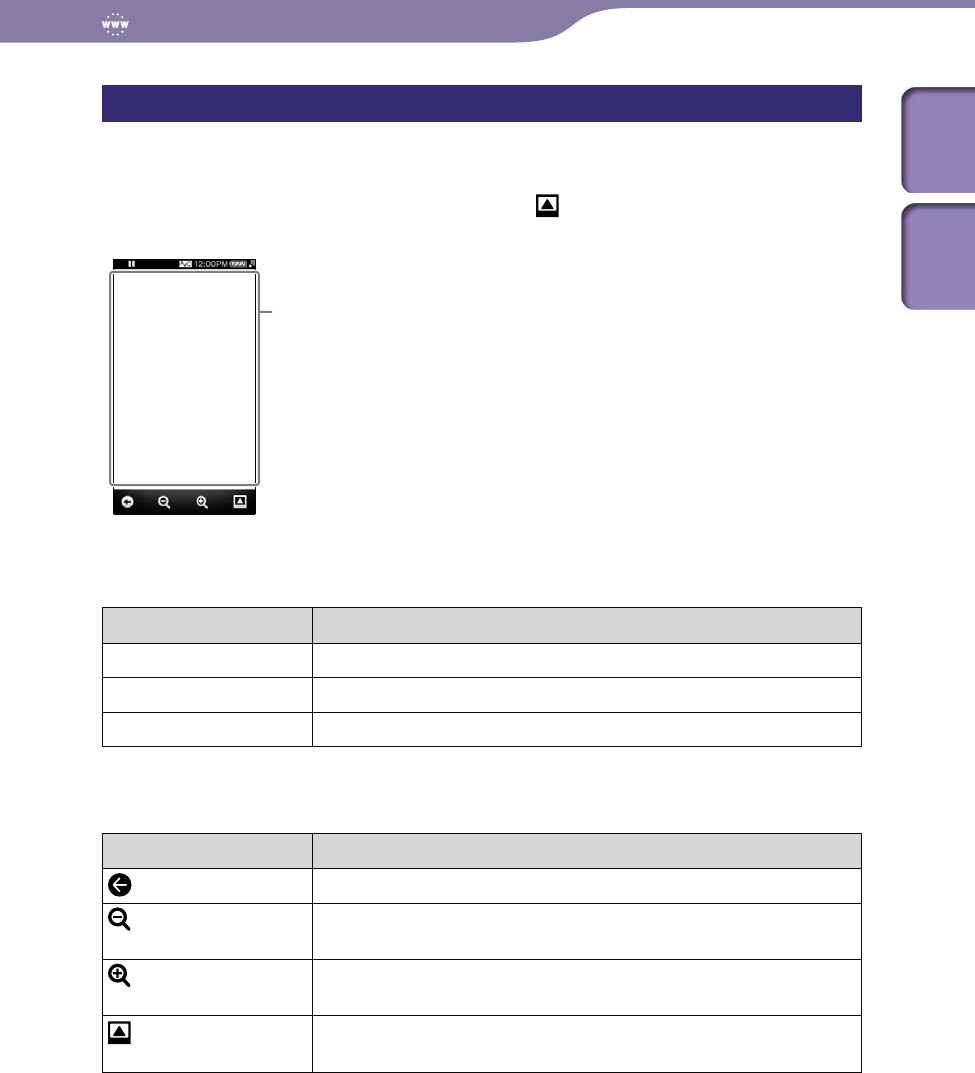
Viewing Websites
104
104
Internet browser screen
You can operate the Internet browser by tapping and dragging the screen.
Furthermore, you can perform operations such as web page address input,
favorites, advanced settings, etc., by selecting (Menu) on the bottom right of
the Internet browser.
Web page
Operations on the Internet browser screen
To Do this
Scroll the web page Drag or flick the web page.
Open a linked web page Tap a link.
Register a podcast Tap an RSS icon ( page 84).
Icons on the Internet browser
Icon Description
(Back) Returns to the previous web page.
(Zoom out) Zooms out.
The scale changes in order of large medium small minimal.
(Zoom in) Zooms in.
The scale changes in order of minimal small medium large.
(Menu) Displays the control buttons. For details of the control buttons, see
“Operations of the Control Buttons” ( page 105).
Table of
Contents
Index
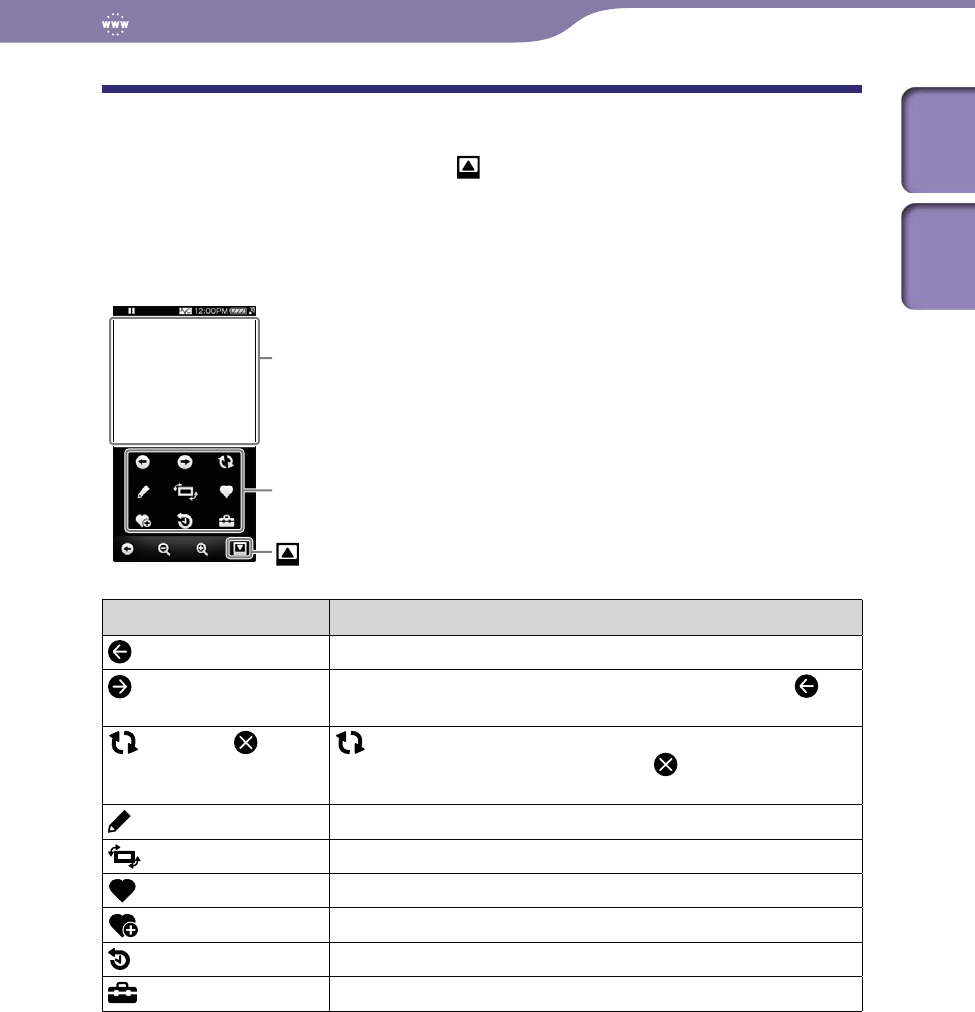
Viewing Websites
105
105
Operations of the Control Buttons
To display the control buttons, select (Menu) on the bottom right of the
Internet browser. To dismiss the control buttons, tap the area outside of the
buttons.
Control buttons of the Internet browser
Control buttons
(Menu)
Web page
Icon Description
(Back) Returns to the previous web page.
(Forward) Reopens the web page that was displayed before selecting
(Back).
(Refresh) / (Stop) (Refresh) reloads the web page to retrieve the latest changes.
While the now loading bar is displayed, (Stop) stops the
loading.
(Address Input) Allows you to enter a web page address.
(Rotate) Rotates the web page to horizontal or vertical.
(Favorites List) Displays the favorites list ( page 106).
(Add To Favorites) Adds the web page to the favorites list ( page 106).
(History) Displays the history list ( page 106).
(Browser Menu) Allows you to set up the Internet browser ( page 107).
Table of
Contents
Index
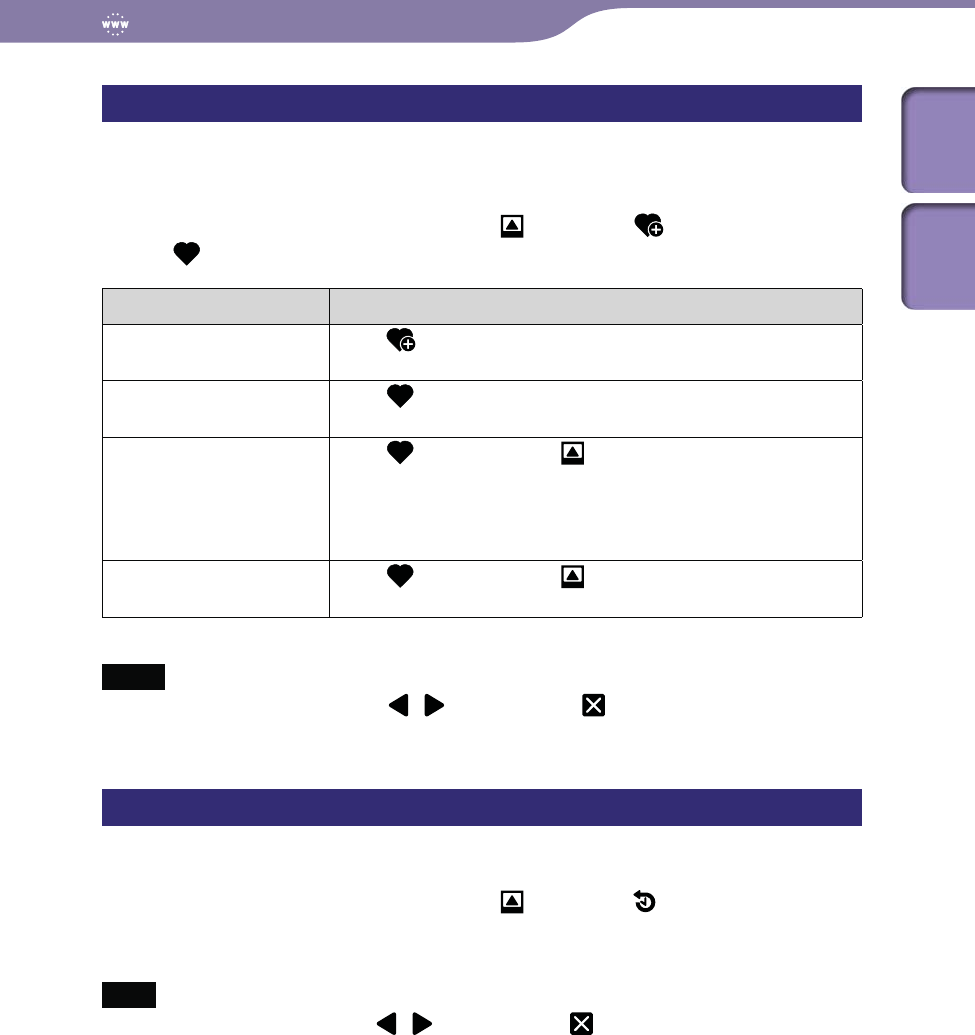
Viewing Websites
106
106
Using favorites
By adding a web page to the favorites list, you can open the web page by
selecting it from the favorites list.
From the Internet browser, select (Menu) (Add To Favorites)
or (Favorites List).
To Do this
Add the web page you are
viewing to the favorites list
Select (Add To Favorites) confirm the name and address
select “OK.”
Open a web page in the
favorites list
Select (Favorites List) the desired web page.
Edit a web page in the
favorites list
Select (Favorites List) (Menu) “Edit” the desired
web page edit the name and address select “OK.”
Tap the name or address field on the edit screen to bring up the
onscreen keyboard. For how to input text, see “Text Input” (
page 20).
Delete a web page from
the favorites list
Select (Favorites List) (Menu) “Delete” the web
page you intend to delete “OK.”
Notes
To scroll the favorites list, select / . To close, select .
You cannot delete the preset favorites.
Using history list
You can display a web page in the history list.
From the Internet browser, select (Menu) (History) the
desired web page.
Note
To scroll the history list, select / . To close, select .
Table of
Contents
Index

Viewing Websites
107
107
Changing the Internet Browser Settings
To change the Internet browser settings, select (Menu) from the Internet
browser screen, then select (Browser Menu).
View Mode
You can change the appearance of the web page.
From the Internet browser, select (Menu) (Browser Menu)
“View” tab “View Mode” the desired view mode type.
Type Description
Normal Displays a web page as it is. (Default setting)
Just-Fit Scales down a web page to fit to the width of the screen.
Smart-Fit Changes the layout of a web page to fit to the width of the screen.
Pictures wider than the screen width will be shrunk.
Page Information
You can display the information of the web page you are viewing.
From the Internet browser, select (Menu) (Browser Menu)
“View” tab “Page Information.”
Item Description
Title: The web page title.
Address: The web page address.
Type: The web page type.
Date of Acquisition: The date and time when the browser loaded the web page.
File Size (Byte): The file size of the web page.
Server Certificate The information of the certificates for the web server (displayed
only when there are any certificates for the web page you are
viewing).
Table of
Contents
Index
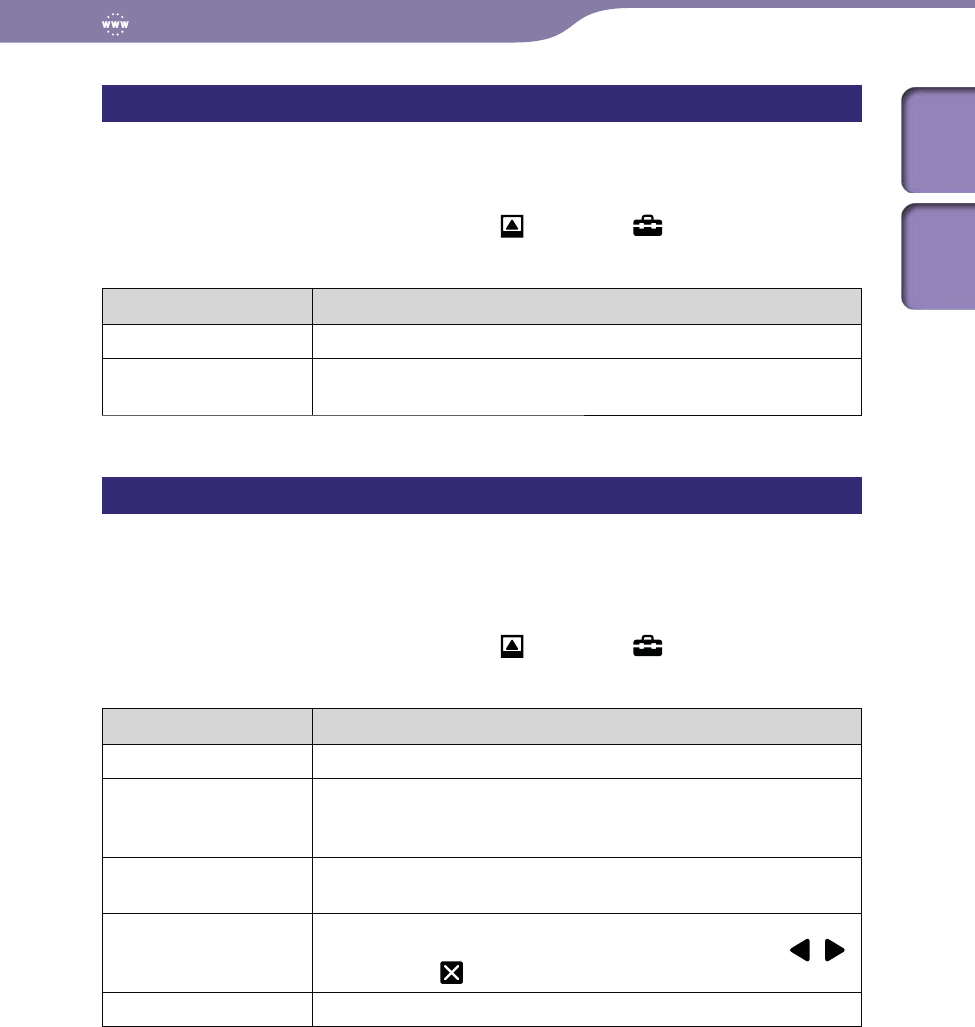
Viewing Websites
108
108
Startup Page
You can set the startup page to be displayed when the Internet browser starts
up.
From the Internet browser, select (Menu) (Browser Menu)
“View” tab “Startup Page” the desired startup page type.
Type Description
Blank Page When you start the Internet browser, the blank page is displayed.
Page Last Displayed When you start the Internet browser, the last viewed web page is
displayed. (Default setting)
Detailed Settings
You can enable or disable JavaScript, authentication information saving, and
cache. Check the item you intend to enable.
You can also select a time zone and view the browser information.
From the Internet browser, select (Menu) (Browser Menu)
“Settings” tab “Detailed Settings.”
Item Description
Enable JavaScript Enables JavaScript.
Save Authentif. Info If enabled, saves authentication information. The saved
information is automatically entered when the authentication is
required next time.
Use Cache If enabled, saves the loaded web page to the cache file, allowing the
player to display the web page quicker.
Time Zone Allows you to select a time zone.
Select a city from the time zone list. To scroll the list, select / .
To close, select .
Browser Information Shows the Internet browser information.
Table of
Contents
Index
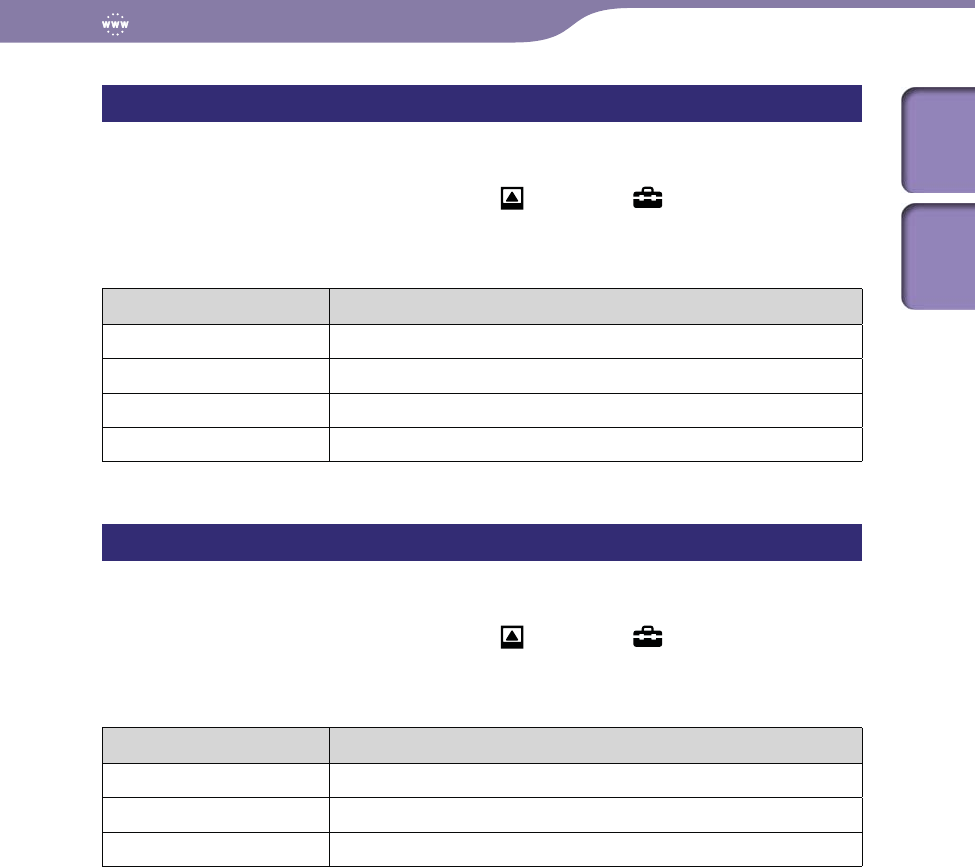
Viewing Websites
109
109
Privacy Settings
You can delete the cache, cookies, history list, and authentication information.
From the Internet browser, select (Menu) (Browser Menu)
“Settings” tab “Privacy Settings” the desired item “OK”
“OK.”
Item Description
Delete Cache Deletes the cache.
Delete Cookie Deletes cookies received from web servers.
Delete History Deletes the history.
Delete Authentif. Info Deletes the authentication information.
Cookie Settings
You can set to receive or not to receive cookies from web servers.
From the Internet browser, select (Menu) (Browser Menu)
“Settings” tab “Cookie Settings” the desired setting type
“OK.”
Type Description
Accept All Accepts all cookies. (Default setting)
Block All Blocks all cookies.
Verify before Accepting Displays the confirmation screen before accepting a cookie.
Table of
Contents
Index

Using Noise Canceling Function
110
110
About Noise Canceling
The internal microphone embedded in the headphones picks up the ambient
noise. The player generates an antiphase sound wave against the ambient noise
to reduce it. The Noise Canceling function can reduce the unwanted ambient
noise especially in a vehicle such as an airplane, train, bus, etc., allowing you to
enjoy music at a low volume.
1 The waveform of the ambient
noise (original sound)
The internal microphone embedded in
the headphones picks up the ambient
noise. Then, the Noise Canceling circuit
analyzes the waveform of the noise.
2 The antiphase waveform
against the noise.
The player generates the antiphase
waveform against the noise to
cancel it out.
3 The composite waveform.
Two waveforms have
canceled each other out.
The original waveform and antiphase
waveform combine to cancel each
other out, reducing the ambient
noise.
Notes
If the supplied headphones are not used properly, the effect of the Noise Canceling
function may be degraded. To make the most of the function, use the correct size
earbuds to fit your ears and insert the headphones into your ears snugly.
The Noise Canceling function mainly reduces the ambient noise in the low frequency
bands and has no effect against the ambient noise in the high frequency bands. It has no
effect on some sounds.
Do not cover the microphone part of the headphones with your hands, etc., otherwise
the Noise Canceling function may not work.
Microphone
You may hear a slight noise when the Noise Canceling function is active. This is
operational noise of the Noise Canceling function and not a malfunction.
Continued
Table of
Contents
Index

Using Noise Canceling Function
111
111
You may feel the Noise Canceling function does not work or noise is louder in a quiet
environment or depending on the noise. In this case, release the Noise Canceling
function.
Mobile phones may affect noise. In that case, keep the player away from mobile phones.
Make sure to remove the headphones from your ears before you connect or disconnect
the headphones from the headphone jack of the player. If the headphones are connected
or disconnected from the player during playback, or while the Noise Canceling function
is active, noise may be generated. This is not a malfunction.
When the Noise Canceling function is turned on or off, a switching sound will be
generated. This sound is generated by the switch of the Noise Canceling circuit, and is
not a malfunction.
Table of
Contents
Index
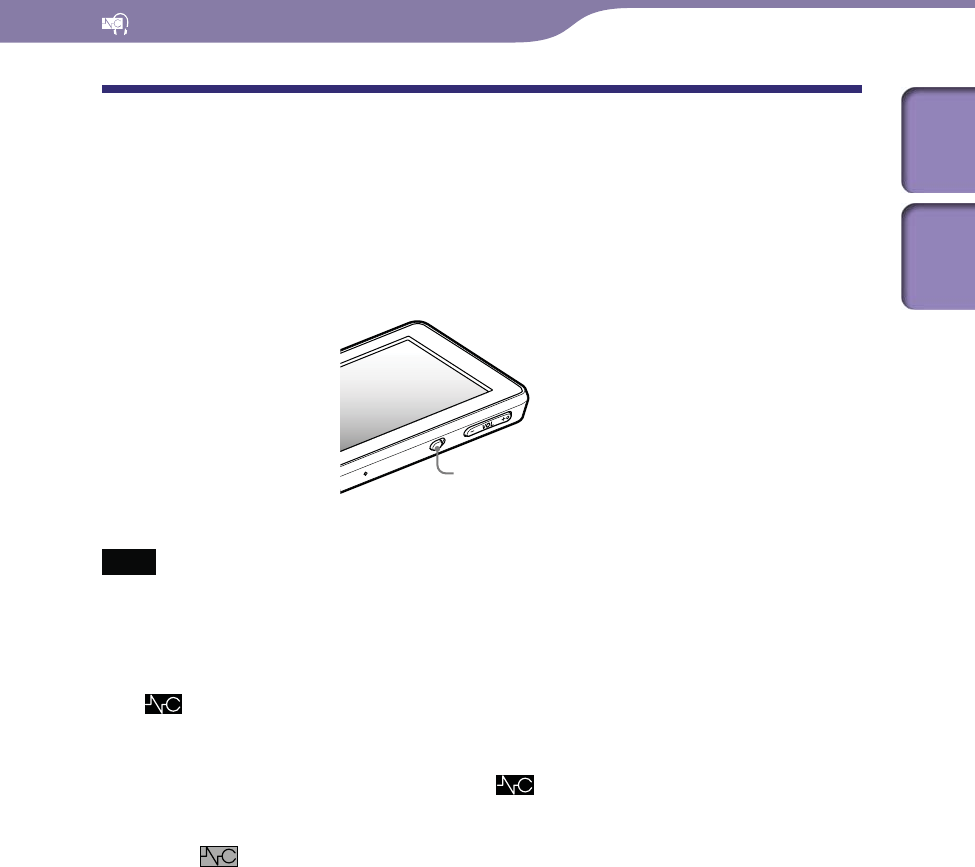
Using Noise Canceling Function
112
112
Playing Back with Using the Noise Canceling
Function
You can reduce the unwanted ambient noise by using the Noise Canceling
function of the player. The internal microphone of the headphones can catch
the ambient noise to reduce noise by outputting an antiphase sound wave
against the noise.
NOISE CANCELING switch
Note
If headphones other than those supplied are used, the Noise Canceling function will not
work even if the NOISE CANCELING switch is turned on.
Slide the NOISE CANCELING switch in the direction of the arrow .
appears in the information area.
Hints
When the Noise canceling function is active, appears on the screen. If the
headphones other than those supplied are used, the Noise Canceling function will not
work even if the NOISE CANCELING switch is slid in the direction of the arrow . In
this case, appears in the information area.
You can adjust the effect of the Noise Canceling function. For details, see page 116.
Table of
Contents
Index
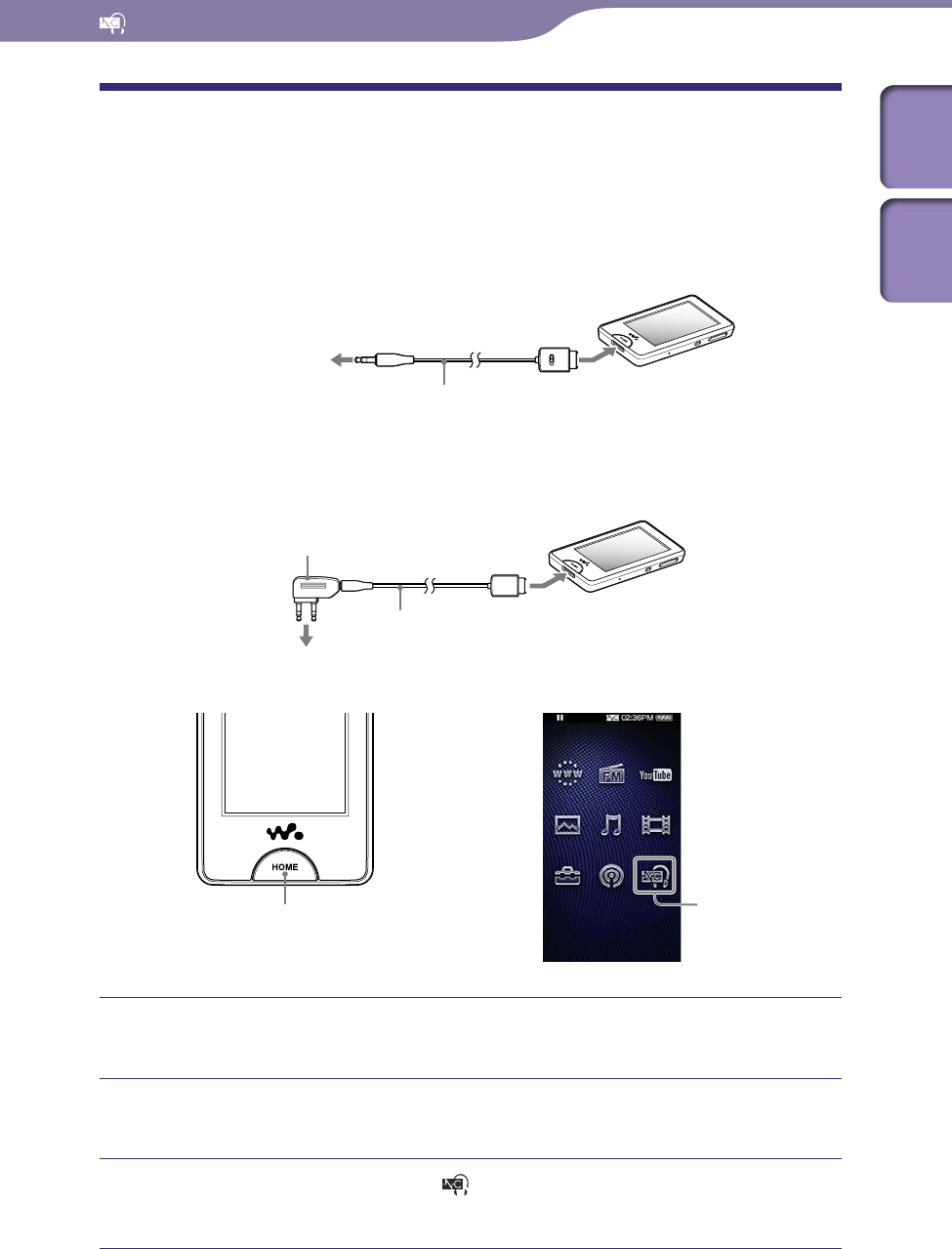
Using Noise Canceling Function
113
113
Listening to External Audio Sources
(External Input Mode)
You can enable the Noise Canceling function when you listen to audio from
external audio sources, such as audio devices in airplanes.
Using with external audio devices
To headphone jack
The supplied audio input cable
Using with in-flight entertainment systems
The supplied plug adaptor
The supplied audio input cable
To in-flight entertainment systems
HOME button NC Modes
Connect the supplied headphone to the player and slide the
NOISE CANCELING switch in the direction of the arrow .
Connect the audio source device and the player using the supplied
audio input cable.
From the Home menu, select (NC Modes).
You can listen to the audio source device with reduced ambient noise.
Continued
Table of
Contents
Index

Using Noise Canceling Function
114
114
Hints
You can change between “External Input Mode” and “Quiet Mode” ( page 115) by
selecting “External Input Mode” or “Quiet Mode” on the screen.
If you disconnect the supplied audio input cable, the Noise Canceling function enters
“Quiet Mode” ( page 115) automatically.
Notes
Some in-flight entertainment systems may not be connectable to the player.
When connecting to an audio device, plug the supplied audio input cable into the
headphone jack of the device. Do not plug it into the LINE OUT jack.
Table of
Contents
Index
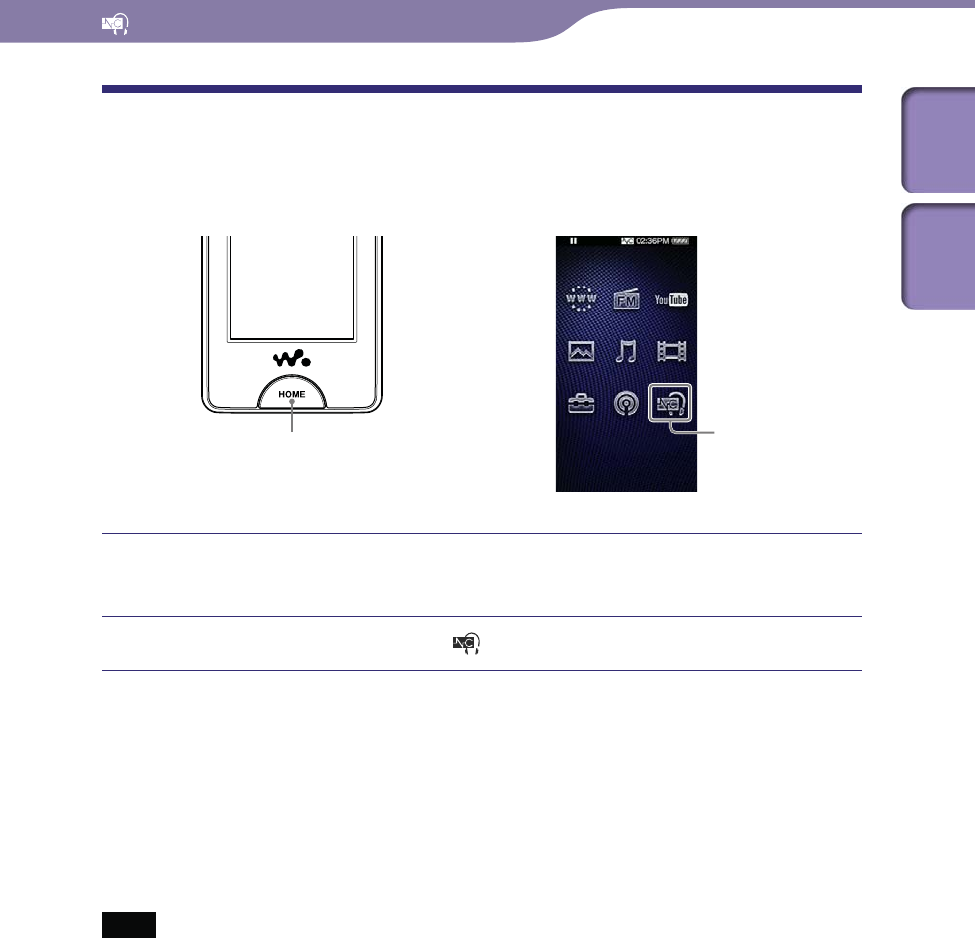
Using Noise Canceling Function
115
115
Reducing the Ambient Noise without Playing
Back Music
(Quiet Mode)
You can use the Noise Canceling effect to get peace and quiet.
HOME button NC Modes
Connect the supplied headphone to the player and slide the
NOISE CANCELING switch in the direction of the arrow .
From the Home menu, select (NC Modes).
Hint
When the player receives an audio input signal from the supplied audio input cable
connected to the WM-PORT, the player enters “External Input Mode.” You can change
between “External Input Mode” and “Quiet Mode” by selecting “External Input Mode”
or “Quiet Mode” on the screen. Also, if you disconnect the supplied audio input cable
during “External Input Mode,” the Noise Canceling function enters “Quiet Mode”
automatically.
Note
The Noise Canceling function mainly reduces the ambient noise in the low frequency
bands and has no effect against the ambient noise in the high frequency bands. It has no
effect on some sounds.
Table of
Contents
Index
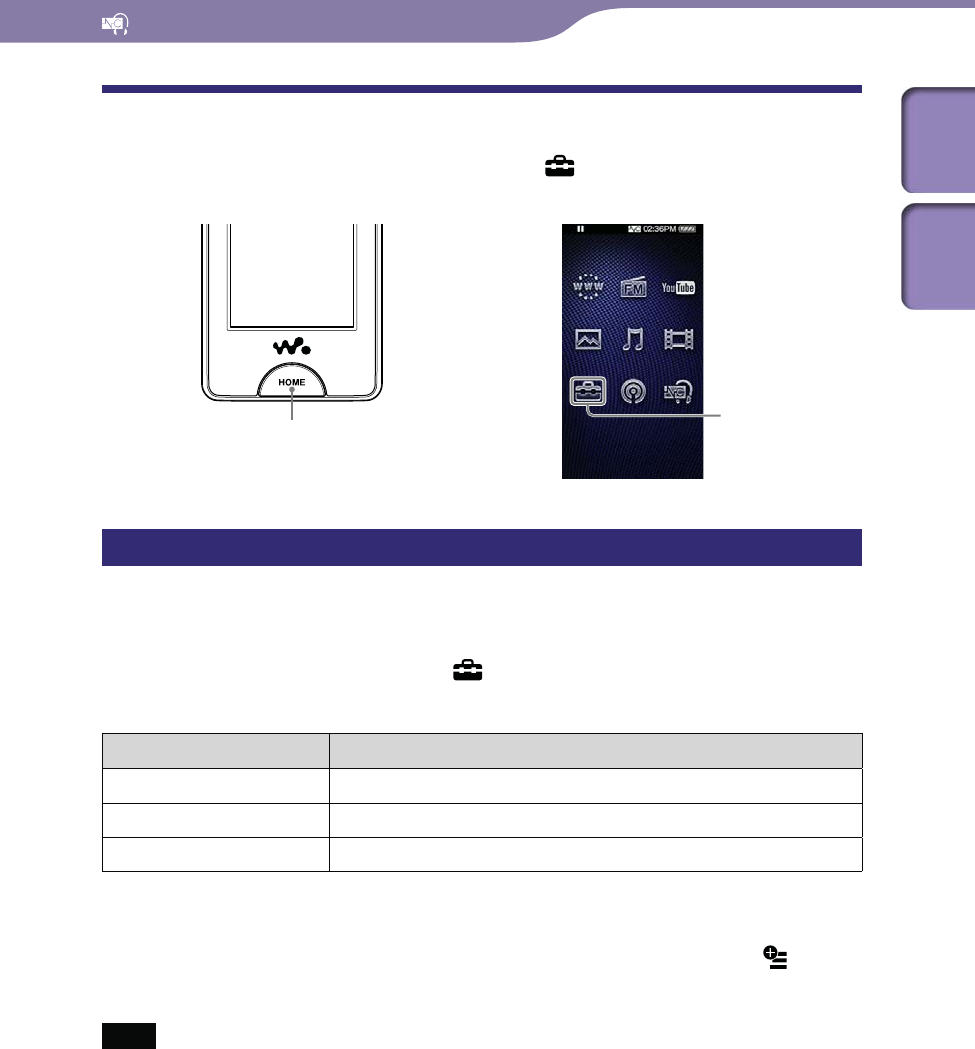
Using Noise Canceling Function
116
116
Changing the Noise Canceling Settings
To change the Noise Canceling settings, select (Settings) from the Home
menu, then select “NC Settings.”
HOME button Settings
Select NC Environment
You can select the digital filter that is most suitable for reducing the ambient
noise at the location.
From the Home menu, select (Settings) “NC Settings”
“Select NC Environment” the desired setting type “OK.”
Type Description
Bus/Train Most effective at reducing noise in a bus or train.
Airplane Most effective at reducing noise in an airplane.
Office Most effective at reducing noise in an office.
Hint
You can also select the filter from the Noise Cancellation screen, by selecting (Option
Menu) “Select NC Environment.”
Note
This function is only effective when the NOISE CANCELING switch is turned on.
Table of
Contents
Index
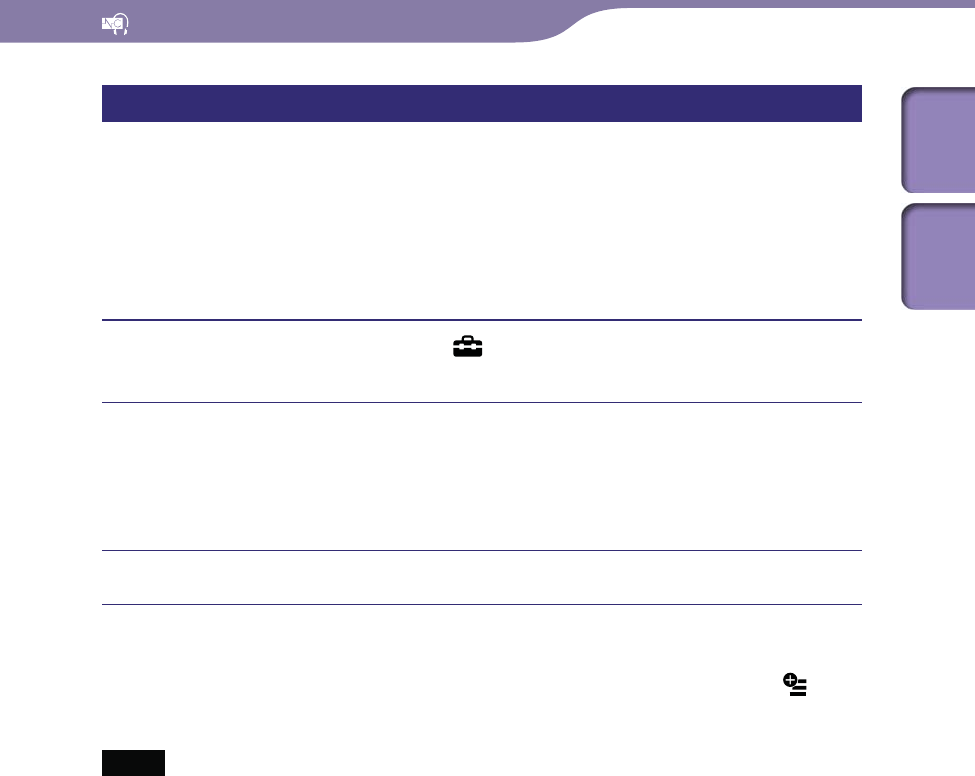
Using Noise Canceling Function
117
117
Set Noise Cancel Level
The player is designed to obtain the maximum effect of the Noise Canceling
function ( page 110). However, you may be able to enhance the effect
depending on your ear shape or usage environment by increasing (or
decreasing) the sensitivity of the microphone installed in the headphones.
You can adjust the microphone sensitivity by setting the Noise Cancel level.
Adjust the function when the Noise Canceling effect is poor.
From the Home menu, select (Settings) “NC Settings” “Set
Noise Cancel Level.”
Drag the indicator (setting value) to select the desired value.
The setting can be adjusted in 31 steps. The center position of the slider
will obtain the maximum effect. Move the position of the slider to the left
or right to adjust the desired value.
Select “OK.”
Hint
You can also adjust the setting from the Noise Cancellation screen, by selecting
(Option Menu) “Set Noise Cancel Level.”
Notes
This function is only effective when the NOISE CANCELING switch is turned on.
The default setting (center position of slider) will obtain the maximum effect. The effect
of the Noise Canceling function is not necessarily enhanced by maximizing the
microphone sensitivity.
Table of
Contents
Index

Common Settings
118
118
Changing the Common Settings
To change the common settings of the player, select (Settings) from the
Home menu, then select “Common Settings.”
HOME button Settings
Unit Information
Information such as model name, firmware version, etc., is displayed.
From the Home menu, select (Settings) “Common Settings”
“Unit Information.”
Item Description
Model: Displays the model name of the player.
Firmware: Displays version information for the player’s firmware.
Free/Total Memory Space: Displays the available free memory size and the total memory
size of the player.
Total Songs: Displays the total number of songs*1 stored on the player.
Total Videos: Displays the total number of videos*1 stored on the player.
Total Photos: Displays the total number of photos stored on the player.
WM-PORT: Displays the version information for WM-PORT.
*1 Total songs includes audio podcasts, and Total videos includes video podcasts.
Table of
Contents
Index
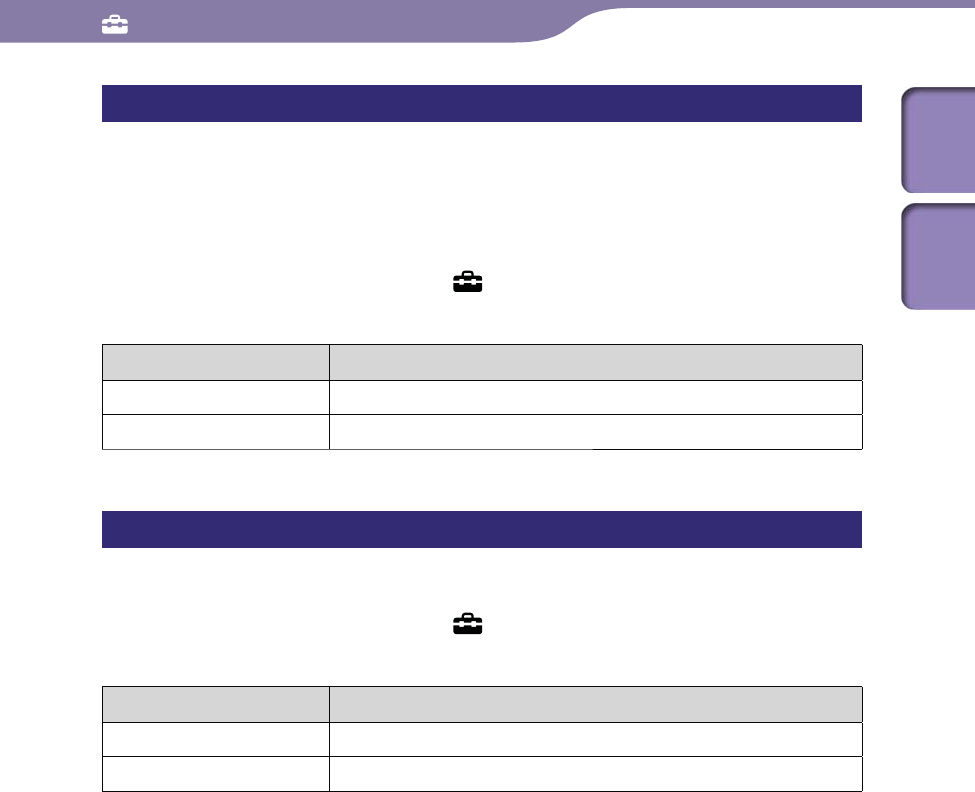
Common Settings
119
119
AVLS (Volume Limit)
You can set “AVLS (Volume Limit)” (Automatic Volume Limiter System) to
limit the maximum volume to prevent auditory disturbance or distraction.
With “AVLS (Volume Limit),” you can listen to music at a comfortable volume
level.
From the Home menu, select (Settings) “Common Settings”
“AVLS (Volume Limit)” the desired setting type “OK.”
Type Description
On Keeps the volume to a moderate level.
Off Plays back audio at the original volume. (Default setting)
Beep Settings
You can turn on or off the operation sounds of the player.
From the Home menu, select (Settings) “Common Settings”
“Beep Settings” the desired setting type “OK.”
Type Description
On Produces beep sounds. (Default setting)
Off Does not produce beep sounds.
Table of
Contents
Index
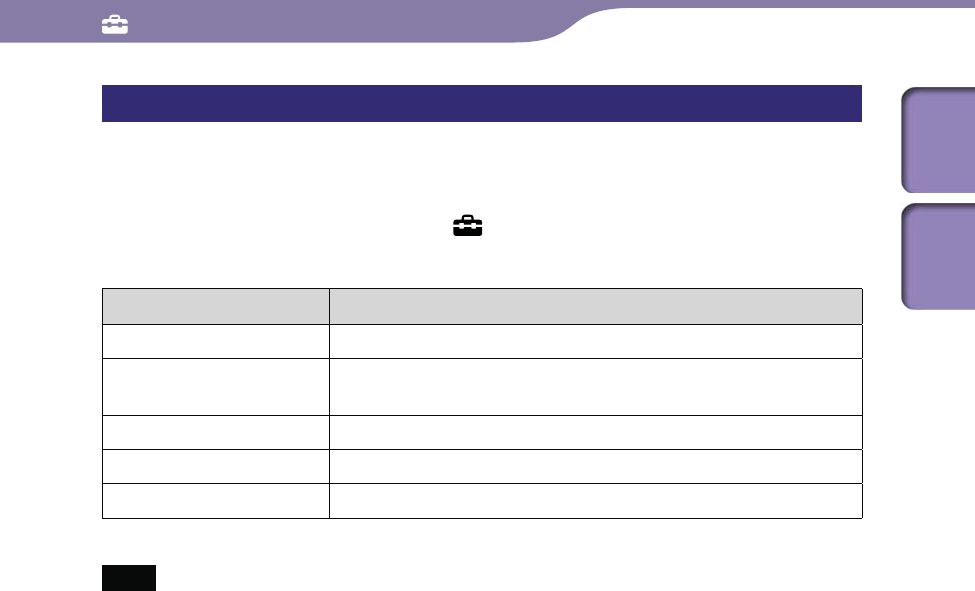
Common Settings
120
120
Screen Off Timer
When there is no operation for a while, the player turns off the screen. You can
set the waiting time for turning off the screen.
From the Home menu, select (Settings) “Common Settings”
“Screen Off Timer” the desired waiting time “OK.”
Type Description
After 15 sec Turns off the screen when there is no operation for 15 seconds.
After 30 sec Turns off the screen when there is no operation for 30 seconds.
(Default setting)
After 1 Min Turns off the screen when there is no operation for 1 minute.
After 3 Min Turns off the screen when there is no operation for 3 minutes.
After 5 Min Turns off the screen when there is no operation for 5 minutes.
Note
The player does not turn off the screen during the following situations.
– Playing back a video, YouTube video, podcast video, etc.
– Using “Auto Preset” function of the FM radio.
– Deleting a video, podcast episode, etc.
– Deleting a podcast registration, FM radio station presetting, etc.
Table of
Contents
Index
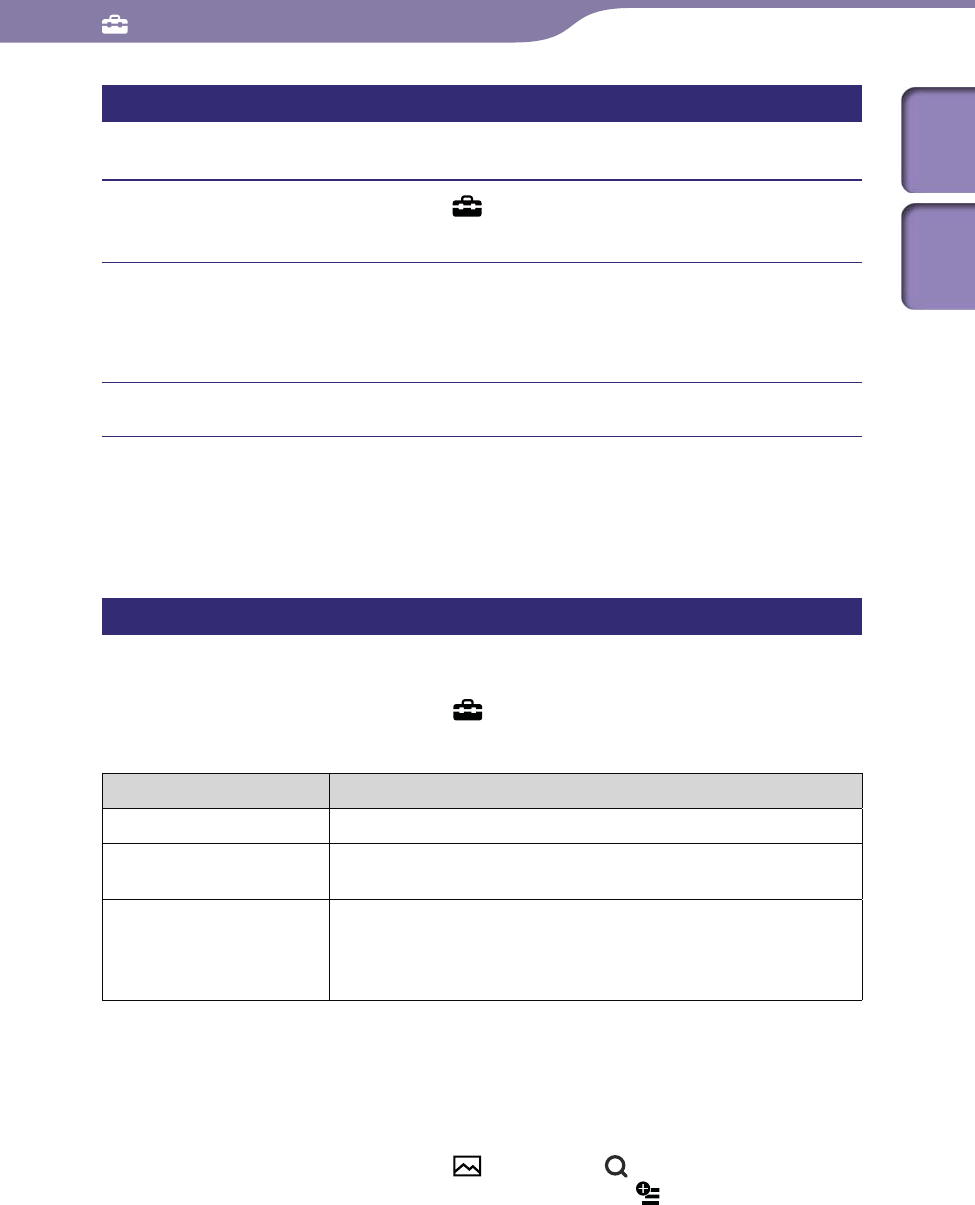
Common Settings
121
121
Brightness
You can set the display brightness to one of 5 levels.
From the Home menu, select (Settings) “Common Settings”
“Brightness.”
Drag the indicator (setting value) to select the desired level.
You can set to one of 5 levels. The larger the number, the brighter the
screen. “3” is set by default.
Select “OK.”
Hint
If you adjust the brightness of the screen to a lower level, the battery will last longer (
page 176).
Wallpaper Settings
You can set the wallpaper of the screen.
From the Home menu, select (Settings) “Common Settings”
“Wallpaper Settings” the desired wallpaper type “OK.”
Type Description
No Wallpaper Displays no wallpaper.
User’s Wallpaper Displays the photo that is set as the wallpaper. (See the following
instructions.)
User’s W.p.(dark) Displays the photo that is set as the wallpaper. (See the following
instructions.)
This option reduces the brightness of the photo so that you can
easily recognize the menu items or the icons.
To set a desired photo as the wallpaper
You need to designate a photo on the player for the wallpaper before selecting
“User’s Wallpaper” or “User’s W.p.(dark)” to set the photo as the wallpaper.
From the Home menu, select (Photos) (Search) the
desired search method the desired photo (Option Menu)
“Set as Wallpaper.”
Table of
Contents
Index
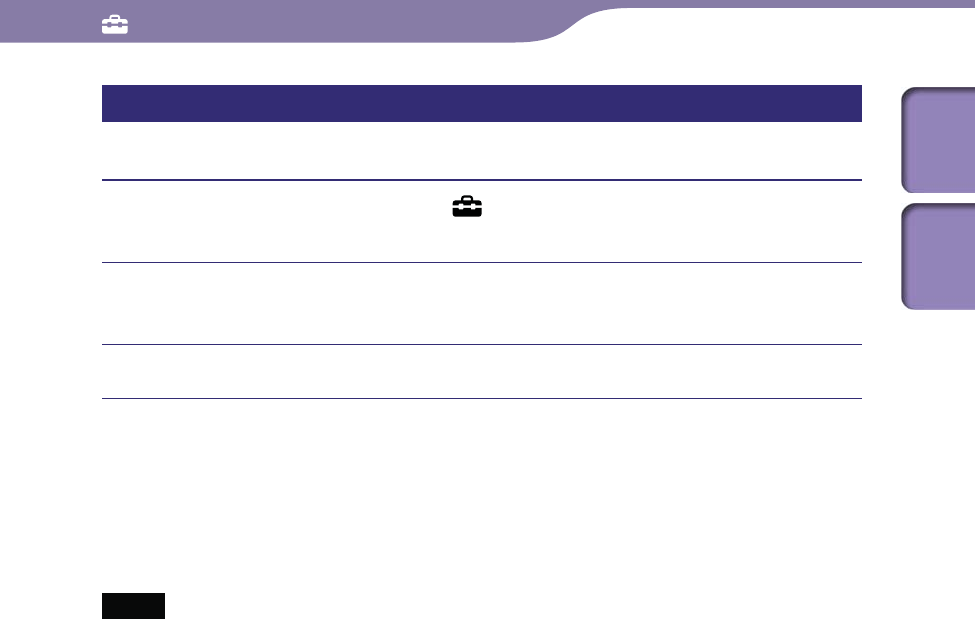
Common Settings
122
122
Set Date-Time
You can set the date and time.
From the Home menu, select (Settings) “Common Settings”
“Clock Settings” “Set Date-Time.”
Drag or flick the year, month, date, hour and minute up or down to
adjust the date and time.
Select “OK.”
Hint
You can select the date format from among “YYYY/MM/DD,” “MM/DD/YYYY,” and
“DD/MM/YYYY.” Furthermore, you can select the time format from either “12-hour” or
“24-hour.” For details, see “Date Display Format” ( page 123), or “Time Display
Format” ( page 123).
Notes
If the battery power is used up, for example, when the player is not used for a long time,
your settings for date and time may be lost and “-” will be displayed instead of the
current date and time.
The clock may gain or lose up to 60 seconds per month. In this case, set the clock again.
Table of
Contents
Index
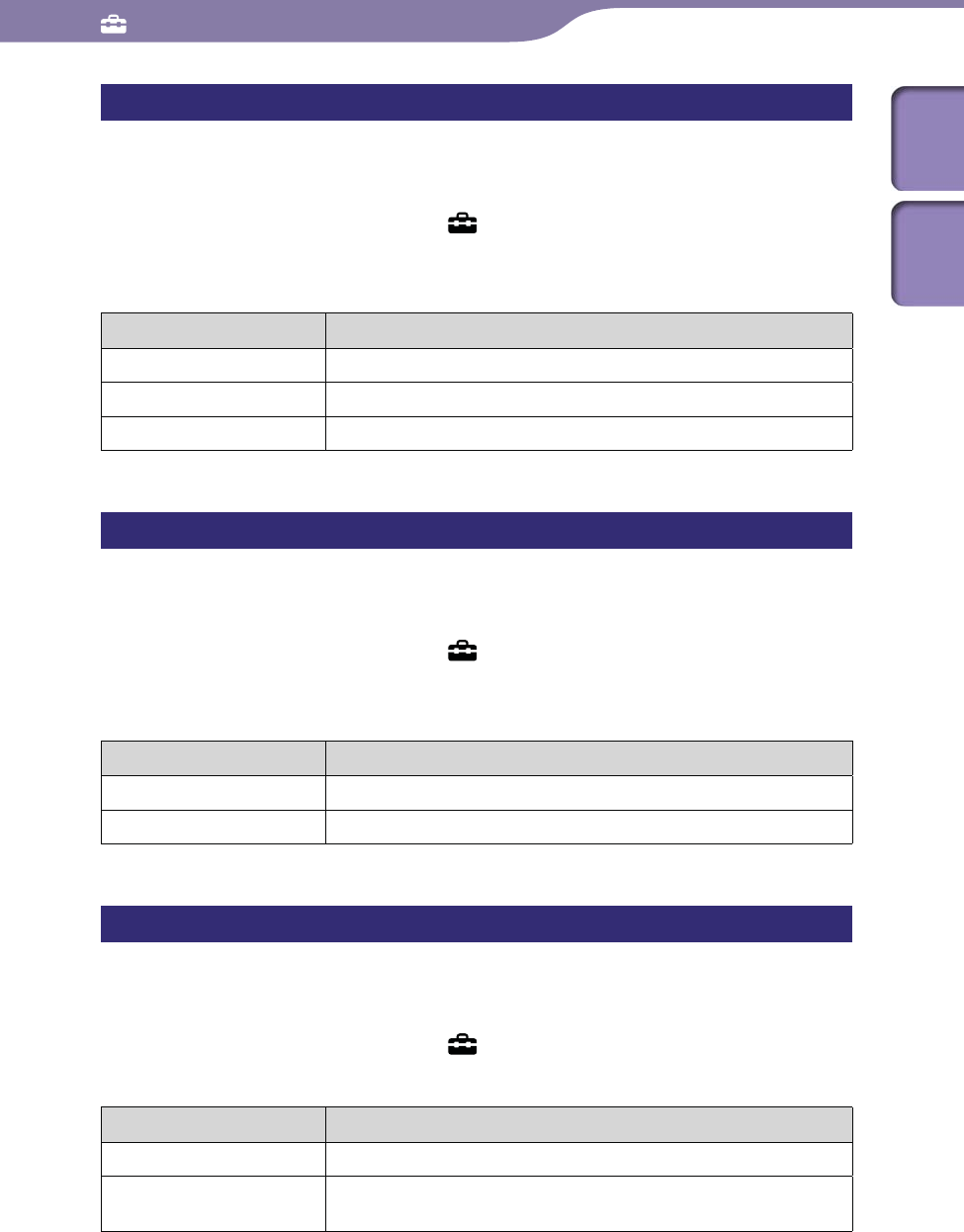
Common Settings
123
123
Date Display Format
You can set the date format displayed for the current time ( page 122) as
“YYYY/MM/DD,” “MM/DD/YYYY,” or “DD/MM/YYYY.”
From the Home menu, select (Settings) “Common Settings”
“Clock Settings” “Date Display Format” the desired format type
“OK.”
Type Description
YYYY/MM/DD Displays the date as year/month/day.
MM/DD/YYYY Displays the date as month/day/year.
DD/MM/YYYY Displays the date as day/month/year.
Time Display Format
You can select the time format displayed for the current time ( page 122)
from either a “12-hour” or “24-hour” display.
From the Home menu, select (Settings) “Common Settings”
“Clock Settings” “Time Display Format” the desired format
type “OK.”
Type Description
12-hour Displays the current time in the 12-hour format.
24-hour Displays the current time in the 24-hour format.
Hold Settings
You can set the hold status of the player when you slide the HOLD switch in
the direction of the arrow .
From the Home menu, select (Settings) “Common Settings”
“HOLD Settings” the desired setting type “OK.”
Type Description
All Operations Disable Locks the buttons and touch panel during HOLD.
Touch Panel Disable Locks the touch panel during HOLD, leaving the buttons on the
body operational.
Table of
Contents
Index

Common Settings
124
124
Reset All Settings
You can reset the player to the default settings. Resetting the player also deletes
the wireless LAN encryption key, but does not delete data such as music, video,
and photo data.
Note
This function is only available in the pause mode.
From the Home menu, select (Settings) “Common Settings”
“Reset/Format” “Reset All Settings” “Yes.”
“Restored factory settings.” appears.
To cancel the operation, select “No” on the confirmation screen.
Clear Input History
You can delete the input history for the predictive text function. The player
uses the history when you input text by using the onscreen keyboard, to show
predictive text candidates.
If you delete the input history, words or phrases you entered before are cleared
and do not appear on the predictive text list anymore.
From the Home menu, select (Settings) “Common Settings”
“Reset/Format” “Clear Input History” “Yes.”
“Deleted the input history.” appears.
To cancel the operation, select “No” on the confirmation screen.
Table of
Contents
Index
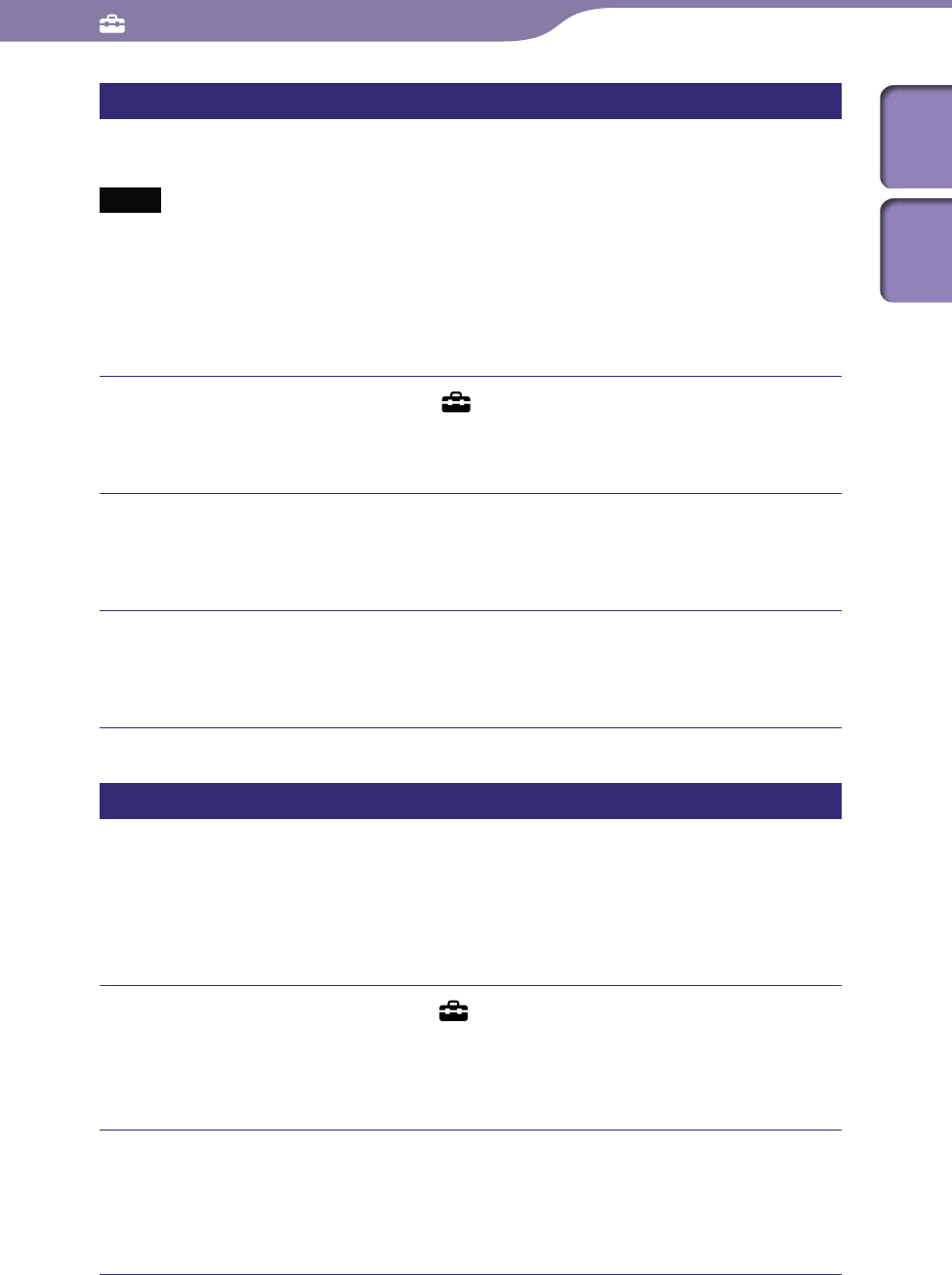
Common Settings
125
125
Format
You can format the built-in flash memory of the player.
Notes
If the memory is formatted, all data (songs, videos, photos, etc., including sample data
installed at the factory) will be erased. Be sure to verify the data stored in memory prior
to formatting and export any important data to the hard disk of your computer.
Be sure not to initialize (format) the built-in flash memory of the player by using
Windows Explorer. If you have formatted with Windows Explorer, format again by using
the player.
From the Home menu, select (Settings) “Common Settings”
“Reset/Format” “Format.”
“All data including songs will be deleted. Proceed?” appears.
Select “Yes.”
“All data will be deleted. Proceed?” appears.
To cancel the operation, select “No.”
Select “Yes.”
When initialization finishes, “Memory formatted.” appears.
To cancel the operation, select “No.”
USB Connection Mode
When connecting to a computer by the USB cable, some computers may fail to
establishing the USB connection with the player, causing the player to not
display “Connecting.”
In such case, you can display the USB connection standby screen before
connecting so that the USB connection is established with more reliability.
From the Home menu, select (Settings) “Common Settings”
“USB Connection Mode.”
“Use when USB connection cannot be established. Use this mode?”
appears.
Select “Yes.”
The player enters USB connection standby mode, displaying the USB
connection standby screen. After connecting to a computer via the USB
cable, “Connecting” appears.
Table of
Contents
Index

Common Settings
126
126
Language Settings
You can select from a variety of languages for the display of menus and
messages on the player.
From the Home menu, select (Settings) “Language Settings”
the desired language setting.
Language Messages and menus are displayed in
Deutsch German
English English
Español Spanish
Français French
Italiano Italian
Português Portuguese
Русский Russian
*1Japanese
Korean
Simplified Chinese
Traditional Chinese
*1 Japanese display may not be available, depending on the release region of the player.
Service Country/Region
You can choose the country/region for the search website to search information
by using Related Links function ( page 43).
From the Home menu, select (Settings) “Service Country/
Region” the desired country/region “OK.”
Note
For how to choose the country/region for YouTube, see “Choosing country/region” (
page 81).
Table of
Contents
Index
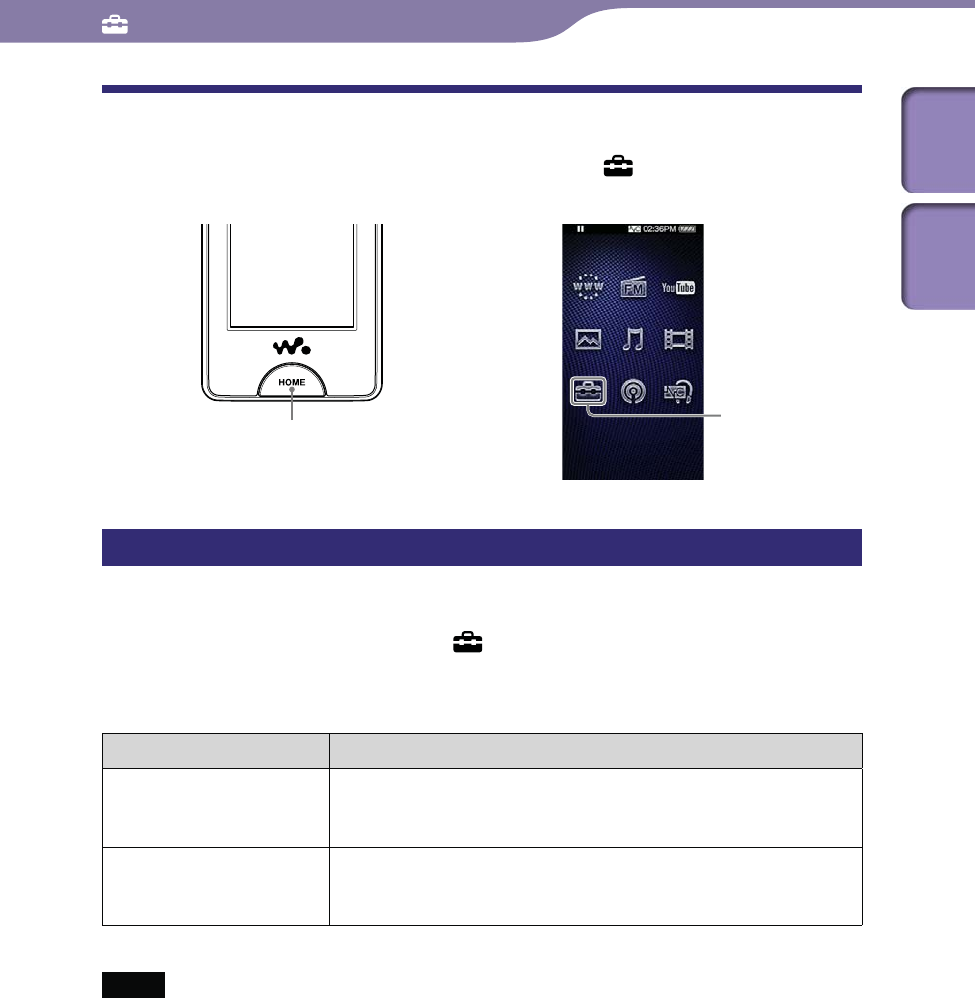
Common Settings
127
127
Changing the Wireless LAN Settings
To change or check the wireless LAN settings, select (Settings) from the
Home menu, then select “Wireless LAN Settings.”
HOME button Settings
WLAN Function On/Off
You can enable or disable the wireless LAN fuction.
From the Home menu, select (Settings) “Wireless LAN
Settings” “WLAN Function On/Off” the desired setting type
“OK.”
Type Description
On Enables the wireless LAN function. When an application such as
Internet browser requires a wireless LAN connection, the
connection confirmation screen appears to connect.
Off Disables the wireless LAN function. The player do not connect to
a wireless LAN even when applications need a connection.
(Default setting)
Notes
When this option is set to “Off,” the player does not transmit radio waves of wireless
LAN. Set the “WLAN Function On/Off ” option to “Off ” where the network connection
is restricted or prohibited, such as in a hospital or in an airplane.
When connected to a wireless LAN, if you change this option from “On” to “Off,” the
wireless LAN connection is disconnected.
Table of
Contents
Index
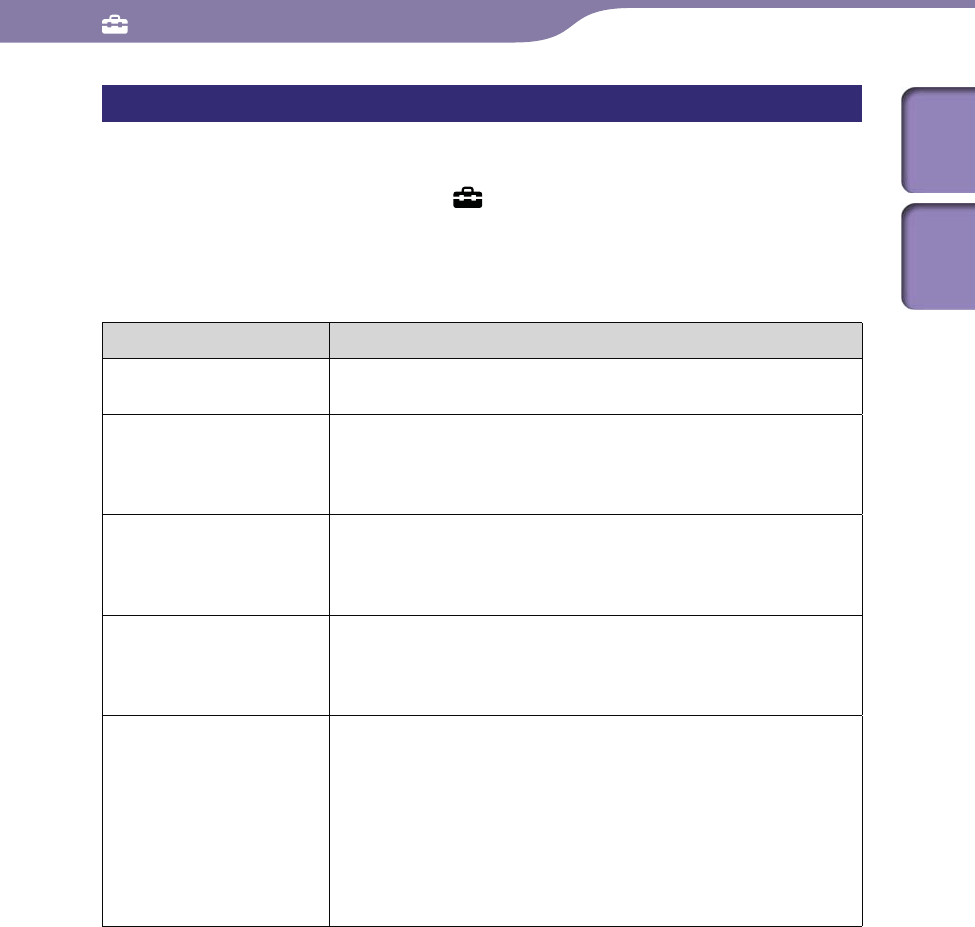
Common Settings
128
128
New Registration
You can register the access point to the player using the setting wizard.
From the Home menu, select (Settings) “Wireless LAN
Settings” “New Registration” the desired setting type “Next.”
There are 5 ways to register the access point. Refer to the description to select
the adequate setting method.
Type Description
Available Wirelss LANs Searches access points installed in the communication range.
After searching, the Scan Results screen ( page 129) appears.
Manual Registration Allows you to enter the SSID manually.
When the access point is set to hide the SSID, use this setting.
The Enter SSID screen ( page 130) appears and you can enter
the SSID manually.
WPS Button Connects to the WPS-compliant access point by using Push-
Button method. Use this setting when the access point supports
Push-Button method.
WPS Button screen ( page 130) appears.
WPS PIN Connects to the WPS-compliant access point by using PIN
method. Use this setting when the access point supports PIN
method.
WPS PIN screen ( page 130) appears.
<Wireless Internet access
service provider name*1>
Configures by using the public wireless LAN setting information
preset into the player.
The setting information of some public Internet access service
providers is preset into the player. If you have already subscribed
to any of the services, select the provider name to set up.
Depending on the provider, the usage agreement screen or the
log-in screen may appear.
After finishing the setting, the Confirmation screen ( page
132) appears.
*1 This item may not appear depending on the country/region. Furthermore, you cannot
use the provider when it is not available in your country/region, even if the provider
name is displayed.
After selecting the setting type, follow the instructions on the setting wizard
screen. For details of the setting wizard screen, see the reference page.
Continued
Table of
Contents
Index

Common Settings
129
129
Notes
For the information on the WPS settings of your access point, refer to the operation
guide of the access point.
For the information on the settings of the access point, refer to the operation guide of
the access point, consult the administrator of the access point, or consult the public
Internet access service provider.
You can register up to 32 access points.
If you begin the new registration using Push-Button method or PIN method during
connecting to a wireless LAN, the connection is disconnected.
Scan Results screen
When you select “Available Wirelss LANs” from the New Registration screen,
the list of access points installed within the communication range appears.
The following information is displayed for each access point.
Item Description
The strength of the radio wave of the access point is displayed.
SSID The SSID of the access point is displayed.
When the access point is set to use an encryption method, is
displayed.
Select the desired access point “Next.”
The IP Address Settings screen ( page 131) appears.
If you select the access point indicated with , the Enter Encryption Key
screen ( page 131) appears.
You can search access points again and refresh the list by selecting
“Scan.”
Note
Access points that are set to hide their SSID do not appear in the list. Select “Back” to
return to the New Registration screen, then select “Manual Registration” to set up
manually ( page 128).
Continued
Table of
Contents
Index

Common Settings
130
130
Enter SSID screen/Security Settings screen
When selecting “Manual Registration” from the New Registration screen, the
Enter SSID screen appears.
Select the SSID input field to bring up the onscreen keyboard,
then enter the SSID and select “Next.”
The Security Settings screen appears.
For how to input text, see “Text Input” ( page 20).
Select the encryption method type of the access point “Next.”
The IP Address Settings screen appears ( page 131).
When the access point requires entering an encryption key, the Enter
Encryption Key screen appears ( page 131).
If an encryption key is required, Enter Encryption Key screen (
page 131) appears.
Type Description
None Select when the access point uses no encryption method.
WEP Select when the access point uses WEP.
WPA/WPA2-PSK TKIP Select when the access point uses WPA-PSK TKIP or WPA2-PSK
TKIP.
WPA/WPA2-PSK AES Select when the access point uses WPA-PSK AES or WPA2-PSK
AES.
Note
If you select “WPA/WPA2-PSK TKIP” or “WPA/WPA2-PSK AES” as the encryption
method, either WPA or WPA2 is selected according to the settings of the access point
when establishing the connection.
WPS Button screen
When you select “WPS Button” from the New Registration screen, the WPS
Button screen appears. Set up following the instructions on the screen.
After setting, the Confirmation screen appears ( page 132).
WPS PIN screen
When you select “WPS PIN” from the New Registration screen, the PIN code
of the player (an 8-digit number) is displayed. Input the PIN code to the access
point.
After setting, the Confirmation screen appears ( page 132).
Continued
Table of
Contents
Index
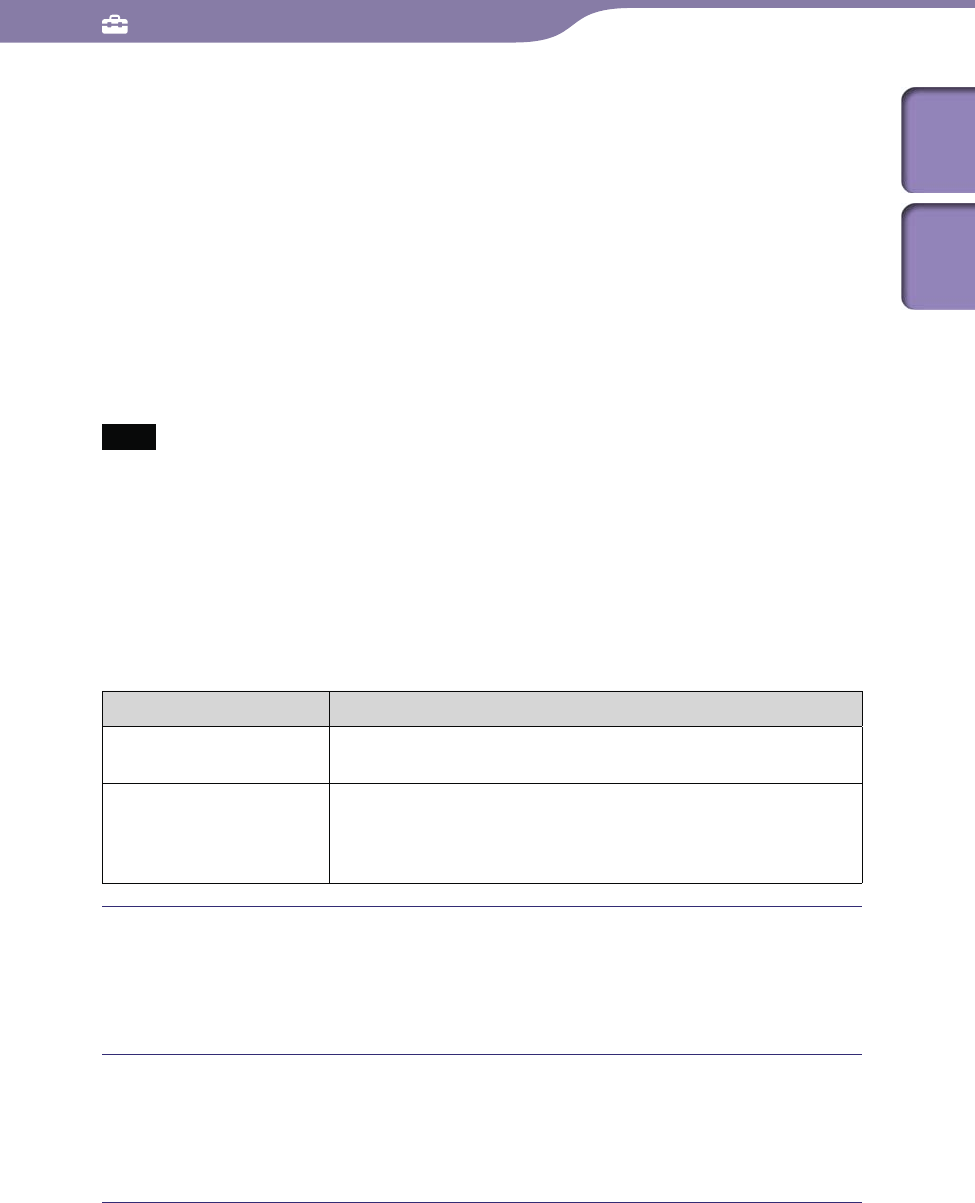
Common Settings
131
131
Enter Encryption Key screen
When the access point is set to use an encryption method, the Enter
Encryption Key screen appears.
Select the “WEP Key:” field or “WPA Key:” field to bring up the
onscreen keyboard, enter the encryption key, then select “Next.”
Enter the encryption key for using to connect to the access point. You can
enter a string of characters or a string of hexadecimal numbers as the
encryption key.
For how to input text, see “Text Input” ( page 20).
After setting, IP Address Settings screen appears ( page 131).
Note
WEP of the player does not support 152-bit encryption key nor Shared Key
authentication.
IP Address Settings screen
After finishing the access point connection settings for “Available Wirelss
LANs” or “Manual Registration” on the New Registration screen, the IP
Address Settings screen appears. Select the setting method according to the
access point.
Item Description
Automatic Acquisition Sets the IP address automatically by using DHCP when the
access point supports DHCP.
Manual Settings Sets the IP address manually.
Enter the IP address, subnet mask, default gateway address, and
primary/secondary DNS server addresses on the Manual Setting
screen.
Select one of the items for IP address settings.
If you select “Automatic Acquisition,” the Confirmation screen appears
( page 132).
If you select “Manual Settings,” the Manual Setting screen appears.
Select each field to bring up the onscreen keyboard to enter the
settings, then select “Next.”
The Confirmation screen appears ( page 132).
For how to input text, see “Text Input” ( page 20).
Continued
Table of
Contents
Index

Common Settings
132
132
Confirmation screen
After completing all settings, the Confirmation screen appears. Confirm the
displayed settings and enter the connection name.
Confirm the registration settings.
Select the Connection Name input field to bring up the onscreen
keyboard, enter a connection name, then select “Complete.”
Enter an easy-to-understand name as a connection name (such as Home,
Office, etc.).
The registration settings are saved and the new registration of the access
point is completed.
Table of
Contents
Index
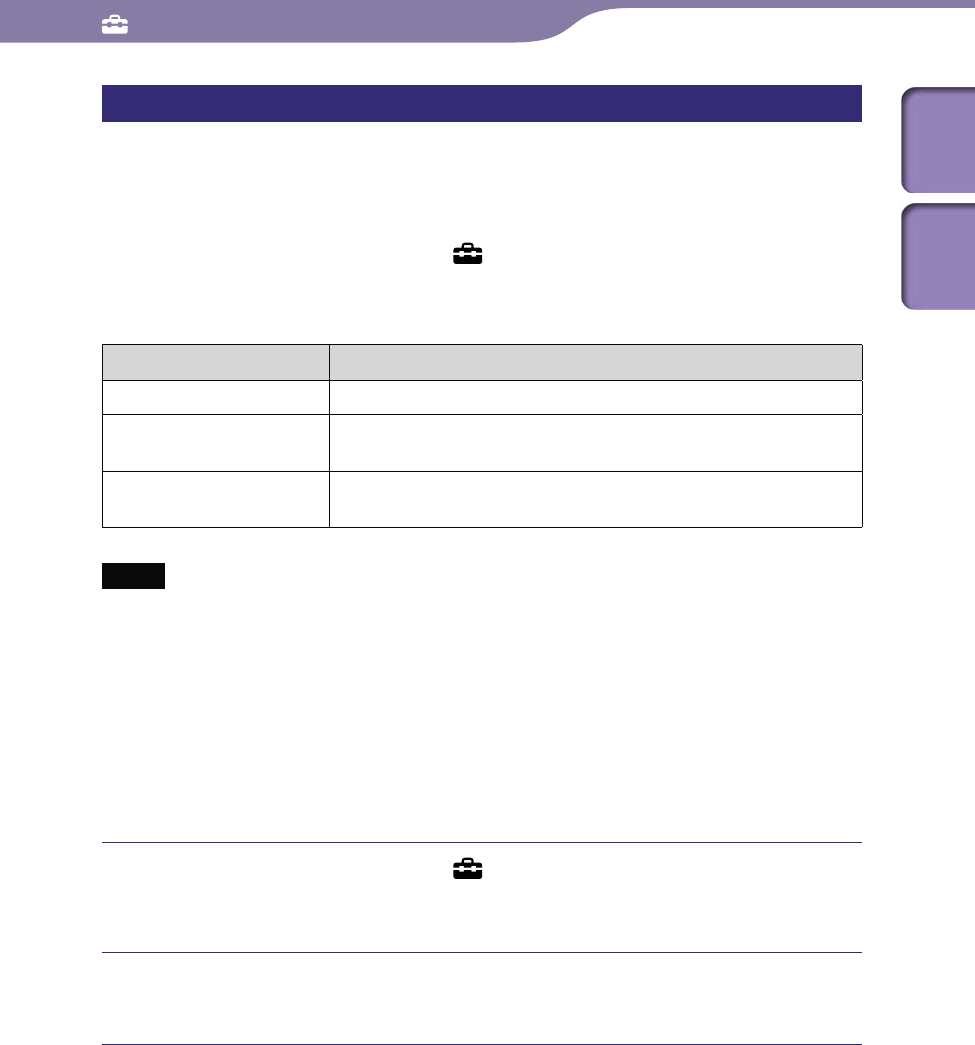
Common Settings
133
133
Access Points screen
You can display the list of the access points registered to the player.
When you select an access point, setting items appears allowing you to connect
to, edit the settings of, or delete the registration of the access point.
From the Home menu, select (Settings) “Wireless LAN
Settings” “Registered Access Points” the desired access point
the desired setting item.
Item Description
Connect Connects to the access point.
Edit Edits the access point settings. For details, see the following “To
edit the access point settings.”
Delete Deletes the registration of the access point. Select “Yes” on the
confirmation screen to delete.
Notes
If you select “Edit” for the access point connected to the player, it is disconnected
automatically.
If you delete the registration of the access point connected to the player, it is
disconnected automatically.
You cannot edit the user ID for logging in to the public wireless LAN service. To change
the user ID, delete the registration of the access point, then register it again.
To edit the access point settings
You can edit the access point settings.
From the Home menu, select (Settings) “Wireless LAN
Settings” “Registered Access Points” the desired access point
“Edit” the setting item to edit.
Edit the setting, then select “OK.”
For how to edit the settings, see the following descriptions.
Continued
Table of
Contents
Index
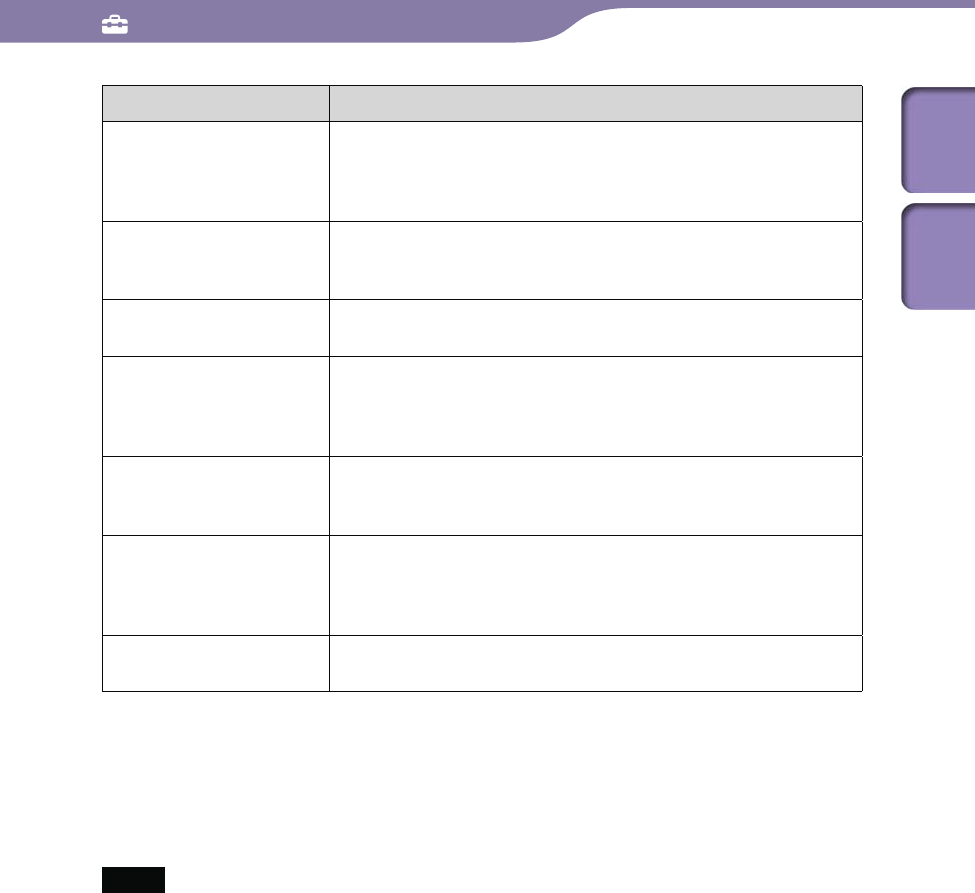
Common Settings
134
134
Item Description
Connection Name: You can edit the connection name for the access point. Select the
input field to bring up the onscreen keyboard, then enter the
name.
Enter an easy-to-understand name (such as Home, Office, etc.).
SSID: You can edit the SSID of the access point.
Select the input field to bring up the onscreen keyboard, then
enter the SSID.
Security Settings You can open the Security Settings screen to edit the security
method and encryption key for connecting to the access point.
IP Address Settings You can open the IP Address Settings screen to edit the IP
address settings for connecting to the Internet via the access
point.
For details, see “IP Address Settings screen” ( page 131).
Proxy Server Settings You can open the Proxy Server Settings screen to edit the proxy
server settings for connecting to the Internet via the access point.
For details, see “To edit the proxy server settings” ( page 135).
User ID:* The user ID for logging in to the public wireless LAN service is
displayed for information only, and you cannot edit it. To change
the user ID, delete the registration of the access point, then
register it again.
Password:* You can edit the password for logging in to the public wireless
LAN service.
* Appears only when a public wireless LAN service is selected.
Hint
For how to input text, see “Text Input” ( page 20).
Notes
For the information of the access point settings, refer to the operation guide of the access
point, consult the administrator of the access point, or consult the public Internet access
service provider.
For information on the proxy server settings, consult the wireless LAN administrator or
the public Internet access service provider.
Continued
Table of
Contents
Index
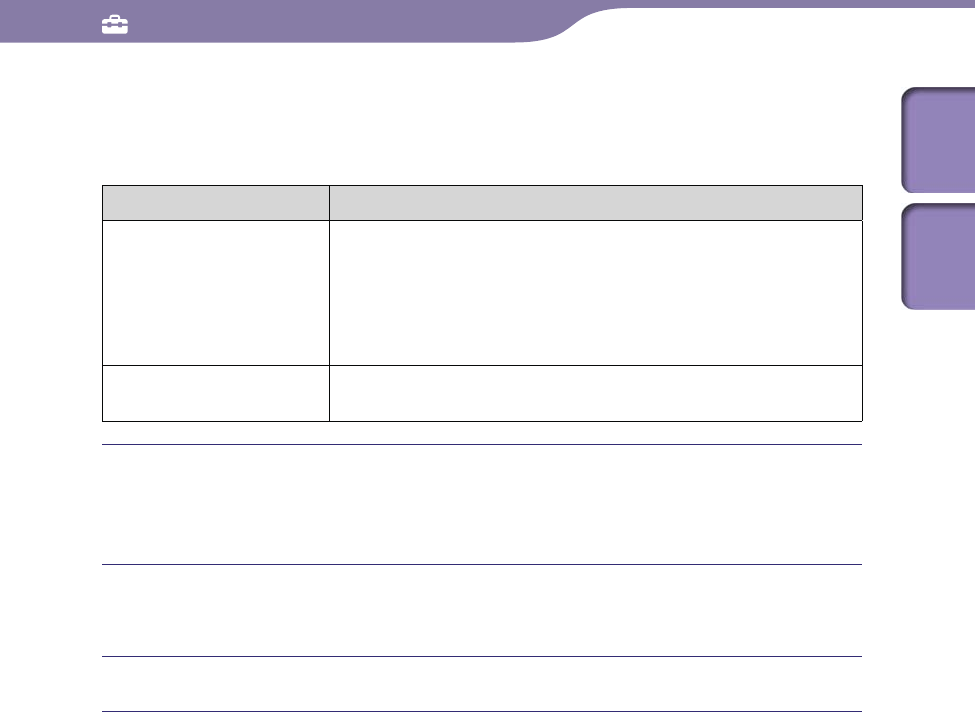
Common Settings
135
135
To edit the proxy server settings
You can edit the proxy server settings according to the wireless LAN you
intend to connect to.
Item Description
Address: When the wireless LAN you intend to connect to does not use a
proxy server, leave a blank.
When the wireless LAN uses a proxy server, enter the IP address
or domain name of the proxy server.
When entering IP address, enter it in the format of “xxx.xxx.xxx.
xxx” (xxx is an integer from 0 to 255).
Port: Enter the port number of the proxy server.
Enter an integer from 0 to 65535.
Select the proxy server setting item to edit.
To enter the address or port number, select the input field to bring up the
onscreen keyboard.
Enter the address and port number.
For how to input text, see “Text Input” ( page 20).
Select “OK.”
Table of
Contents
Index
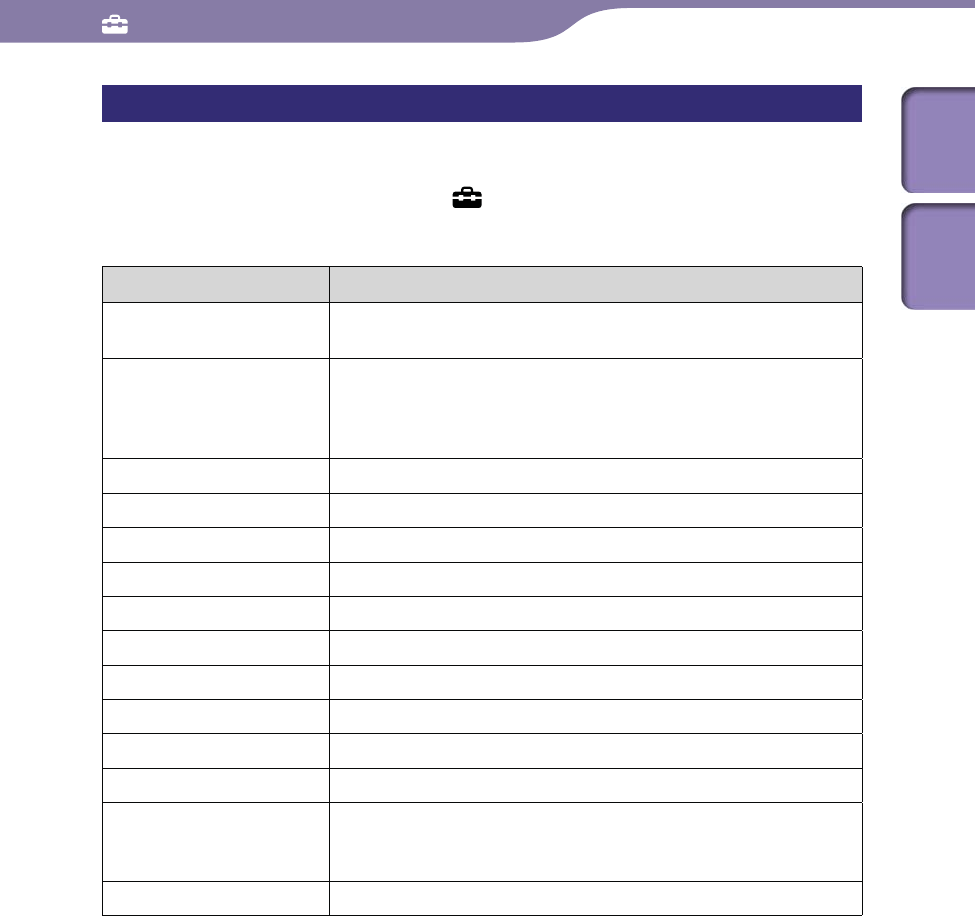
Common Settings
136
136
Current Connection Details
You can display the current connection status.
From the Home menu, select (Settings) “Wireless LAN
Settings” “Current Connection Details.”
Item Description
Wireless LAN Function: The setting of “WLAN Function On/Off” option ( page 127).
If this item is “Off,” the following items are not displayed.
Connection Name: The access point name currently connected. If the access point is
not registered to the player, “Unknown” is displayed. When the
player is not connected to a wireless LAN, “None” is displayed
and the following items are not displayed.
SSID: The SSID of the access point currently connected.
Security Method: The security method used to connect ( page 130).
Channel: The wireless LAN channel used to connect.
Signal Strength: The strength of the radio wave (expressed as a percentage).
IP Address Settings: The method for setting the IP address ( page 131).
IP Address: The IP address assigned to the player.
Subnet Mask: The subnet mask for the wireless LAN.
Default Gateway: The gateway address for the wireless LAN.
Primary DNS: The IP address of the primary DNS server.
Secondary DNS: The IP address of the secondary DNS server.
Proxy Server Settings: The IP address or domain name of the proxy server.
When the player is using no proxy server, “Do Not Use” is
displayed.
Port: The port number of the proxy server.
Table of
Contents
Index
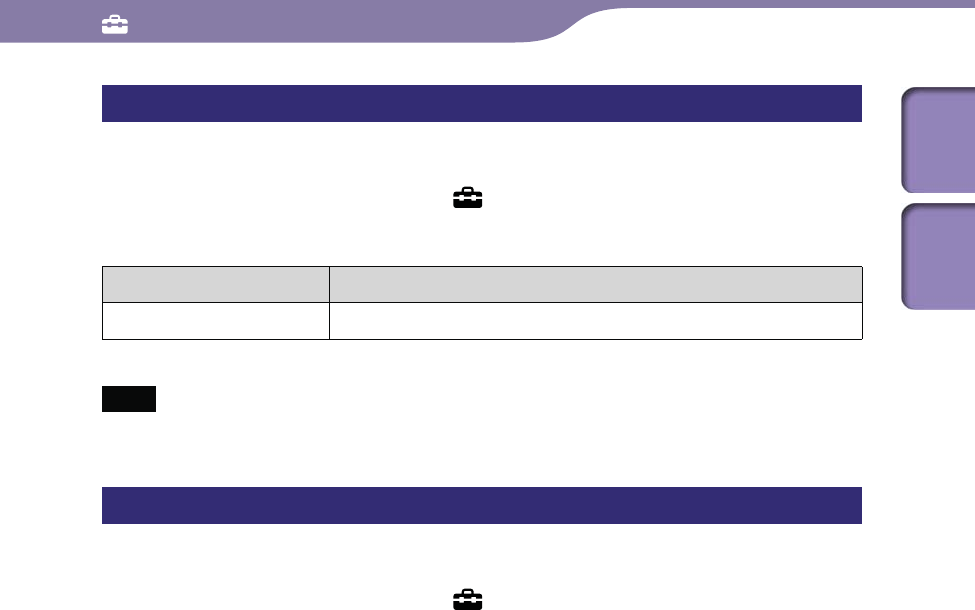
Common Settings
137
137
Detailed Information
You can display the MAC address of the player.
From the Home menu, select (Settings) “Wireless LAN
Settings” “Detailed Information.”
Item Description
MAC Address: The MAC address of the player.
Note
You cannot change the MAC address.
Disconnect from Network
You can disconnect the wireless LAN connection.
From the Home menu, select (Settings) “Wireless LAN
Settings” “Disconnect from Network” “Yes.”
Table of
Contents
Index
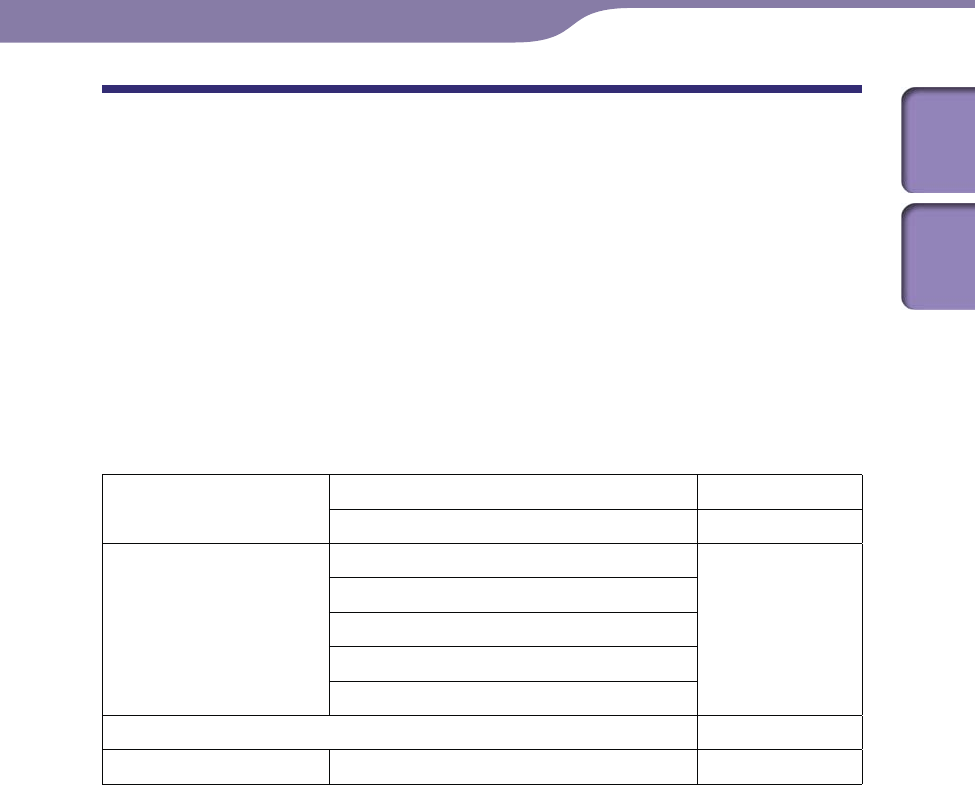
Useful Facts
138
138
Maximizing Battery Life
By adjusting the settings or managing the power supply properly, it is possible
to save the battery power and use the player for a longer time.
Turn off the player manually
If you press and hold the HOME button, the player enters standby mode and
the screen turns off to save battery power. Furthermore, if standby mode
continues for more than about a day, the player turns completely off
automatically.
Changing the settings
You can save battery power by setting as follows.
Settings for screen “Brightness” ( page 121) “1”
“Screen Off Timer” ( page 120) “After 15 Sec”
Settings for sound effect “Equalizer” ( page 48) Deactivate
“VPT(Surround)” ( page 50)
“DSEE(Sound Enhance)” ( page 51)
“Clear Stereo” ( page 52)
“Dynamic Normalizer” ( page 52)
Noise Canceling function ( page 110) Turned off
Settings for video “On-Hold Display” ( page 63) “No”
Adjust data format and bit rate
Playing time will vary, as battery charge can be affected by the format and bit
rate of songs, videos or photos that are played.
For details on charging time and usage time, see page 24.
Table of
Contents
Index

Useful Facts
139
139
What are Format and Bit Rate?
What is audio format?
Audio format refers to the method used when importing audio data from the
Internet or audio CDs to a computer and saving it as an audio file.
Common formats include MP3 and WMA, etc.
MP3: MP3 (MPEG-1 Audio Layer3) is a common audio compression
technology developed by the MPEG working group of the ISO (International
Organization for Standardization).
MP3 can compress audio files to about 1/10 the size of standard CD audio files.
WMA: WMA (Windows Media Audio) is a common audio compression
technology developed by Microsoft Corporation. The WMA format produces
the same sound quality as that of the MP3 format with a smaller file size.
AAC: AAC (Advanced Audio Coding) is a common audio compression
technology developed by the MPEG working group of the ISO (International
Organization for Standardization). The AAC format produces the same sound
quality as that of the MP3 format, with a smaller file size.
Linear PCM: Linear PCM is an audio recording format without digital
compression. You can listen to the sound with the same quality as CD music by
recording with this format.
What is copyright protection?
Some music files, video files, etc., that you purchase at a music download
service site or similar services may apply access control technologies such as
encryption, to accomplish the copyright holders intention to limit usage and
duplication of music or videos.
What is bit rate?
Bit rate refers to the amount of data used to store each second of audio,
expressed in kbps (kilo bits per second), such as 64 kbps. Generally, higher bit
rates provide better sound quality, but require more storage space for the same
length of audio.
Continued
Table of
Contents
Index

Useful Facts
140
140
What is the relationship between bit rate, sound quality, and storage size?
Generally, higher bit rates provide better sound quality, but require more
storage space for the same length of audio, so you can store fewer songs on the
player.
Lower bit rates enable you to store more songs, but at a lower sound quality.
Note
If you import a song from a CD to your computer at a low bit rate, you cannot improve
the song’s sound quality by selecting a high bit rate when transferring the song from the
computer to the player.
What is video format?
Video format refers to the method used when importing video and audio data
to a computer and saving it as a video file.
Common formats include MPEG-4 and AVC, etc.
MPEG-4: MPEG-4 refers to Moving Picture Experts Group phase 4, developed
by the MPEG working group of the ISO (International Organization for
Standardization). The compression format is for video and audio data.
AVC: AVC refers to Advanced Video Coding, developed by the MPEG working
group of the ISO (International Organization for Standardization). It enables
reproduction of more vivid images at a lower bit rate. AVC files include four
profiles, and “AVC Baseline Profile” is one of them. AVC format is based on the
MPEG-4 AVC standard of the ISO (International Organization for
Standardization), and since AVC is standardized as the MPEG-4 Part 10
Advanced Video Coding, it is commonly referred to as MPEG-4 AVC/H.264 or
H.264/AVC.
WMV: WMV (Windows Media Video) is a video compression format
developed by Microsoft Corporation. It was built upon MPEG-4, achieves a
high compression rate, and supports copy control by DRM.
What is photo format?
Photo format refers to the method used when importing images to a computer
and saving them as image files. Common formats include JPEG, etc.
JPEG: JPEG (Joint Photographic Experts Group) is a common image
compression format developed by the JPEG. JPEG can compress an image file
to about 1/10 to 1/100 the size of original image files.
Hint
For details on supported file formats and bit rates, see page 173.
Table of
Contents
Index

Useful Facts
141
141
Storing Data
You can store computer data into the built-in flash memory of the player by
transferring the data from your computer using Windows Explorer, or another
transfer capable software. If the player is connected to the computer, the built-
in flash memory appears in Windows Explorer as [WALKMAN].
Notes
Do not use the bundled software while using Windows Explorer to interact with the
built-in flash memory of the player.
Do not disconnect the supplied USB cable while “Do not disconnect.” appears during
data transfer. The data could be damaged.
Do not format the built-in flash memory using Windows Explorer. If you want to format
the built-in flash memory, format it on the player ( page 125).
You cannot change the following folder names or delete them: “MUSIC,” “MP_ROOT,”
“MPE_ROOT,” “VIDEO,” “PICTURES,” “PICTURE,” “DCIM,” “PODCASTS” and
“FEEDS.”
Do not change folder or file names directly under the “MP_ROOT” or “MPE_ROOT”
folder. Otherwise, they will not be displayed on the player.
Table of
Contents
Index

Useful Facts
142
142
Upgrading the Player’s Firmware
You can update the player’s firmware, allowing you to add new features to the
player by installing the latest player’s firmware to the player. For details about
the latest firmware information and how to install it, visit the following web
site:
For customers in the USA: http://www.sony.com/walkmansupport
For customers in Canada: http://www.sony.ca/ElectronicsSupport/
For customers in Europe: http://support.sony-europe.com/DNA
For customers in Latin America: http://www.sony-latin.com/index.crp
For customers in other countries/regions: http://www.sony-asia.com/support
For customers who purchased the overseas models:
http://www.sony.co.jp/overseas/support/
Download the update program to your computer from the web site.
Connect the player to your computer, and then start up the update
program.
Follow the on-screen instructions to update the player’s firmware.
Firmware update is complete.
Table of
Contents
Index
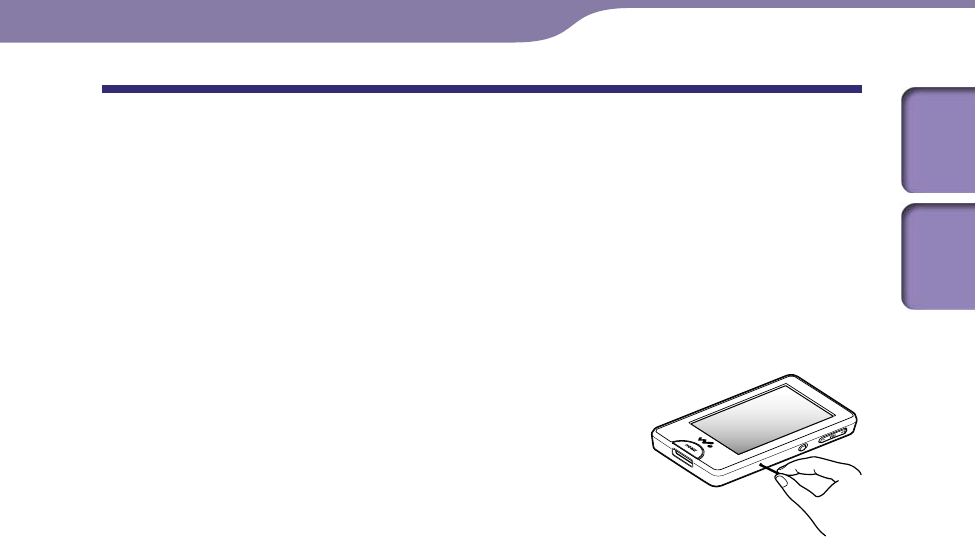
Troubleshooting
143
143
Troubleshooting
If the player does not function as expected, try the following steps to resolve
the issue.
1 Find the symptoms of the issue in the following troubleshooting tables,
and try any corrective actions listed.
2 Connect the player to your computer to charge the battery.
You may be able to resolve some issues by charging the battery.
3 Press the RESET button with a small pin, etc.
If you press the RESET button while operating the
player, stored data and settings on the player may be
deleted.
4 Check the information about the issue in the
Help of each software.
5 Look for information about the issue on one of the support websites.
For customers in the USA, visit: http://www.sony.com/walkmansupport
For customers in Canada, visit: http://www.sony.ca/ElectronicsSupport/
For customers in Europe, visit: http://support.sony-europe.com/DNA
For customers in Latin America, visit: http://www.sony-latin.com/index.crp
For customers in other countries/regions, visit:
http://www.sony-asia.com/support
For customers who purchased the overseas models, visit:
http://www.sony.co.jp/overseas/support/
6 If the approaches listed above fail to resolve the issue, consult your
nearest Sony dealer.
Continued
Table of
Contents
Index

Troubleshooting
144
144
Operation
Symptom Cause/Remedy
There is no sound. The volume level is set to zero.
Turn the volume up ( page 6).
The headphone plug is not connected properly.
Connect the headphone plug properly ( page 8).
The headphone plug is dirty.
Clean the headphone plug with a soft dry cloth.
No songs or videos are stored on the player.
Follow the instructions in the displayed message, and
transfer songs or videos from the computer.
No data is played. The battery is consumed.
Charge the battery fully ( page 24).
If the player does not react, even after charging the battery,
press the RESET button to reset the player ( page 143).
No data is stored on the player.
Follow the instructions in the displayed message, and
transfer data from the computer.
Transferred files are not in a playable format. For details, see
“Supported file format” of “Specifications” ( page 173).
Songs or videos may not be played back, depending on the
file format ( page 173).
Photos may not be displayed, depending on the file size or
the file format ( page 65).
You are placing audio MP4 files in a video folder by drag-and-
drop.
Place them in the “MUSIC” folder by drag-and-drop.
The playback limitation period of the song has expired due to
subscription conditions, etc.
Songs with an expired playback limitation period cannot be
played back. Update them using the software used for
transferring.
After transferring by drag-and-drop in Windows Explorer,
data hierarchy levels do not correspond to the player ( page
28).
Data cannot be deleted on
the player.
You cannot delete songs or photos on the player.
Delete them using the software you used to transfer the
data, or Windows Explorer.
Continued
Table of
Contents
Index

Troubleshooting
145
145
Symptom Cause/Remedy
Transferred data is not
displayed in its list.
The maximum number of files that can be displayed is reached.
The maximum number of files is 2,000 files for videos, 20,000
files for photos, and 20,000 files for podcast episodes. Also, the
maximum number of folders for the podcast list is 1,000
folders.
Delete unnecessary data.
If you rename a video file that is transferred from a computer
to the player, or move it to another folder, it may not be
recognized by the player and may not appear in a video list.
Data was placed in the wrong location by drag-and-drop.
Place the data in the correct place by drag-and-drop (
page 28).
Available capacity is insufficient.
Delete unnecessary data to increase free space on the player.
After transferring by drag-and-drop in Windows Explorer,
data hierarchy levels do not correspond to the player ( page
28).
When “All Songs” or
“Album” is selected, all the
songs will appear, but
some songs will not appear
when “Folder” is selected.
The audio files are not in folders under the “MUSIC” folder.
Place them in folders under the “MUSIC” folder by drag-
and-drop.
Songs are played back
within a limited playback
range only, such as within
one album.
”Playback Range” ( page 48) is set to “Selected Range.”
Change the playback range setting.
A transferred album
appears as two or more
albums in a list
When you import a compilation album to a computer by using
Windows Media Player, it may be imported as two or more
albums. In this case, organize them as one album by using
Windows Media Player, and retransfer to the player. For how to
organize, refer to the Help of Windows Media Player.
Songs are not displayed in
the order of transfer
Songs are not displayed in the order of transfer. If you want to
arrange songs in the desired order, create playlists by using
Windows Media Player before transferring to the player. For
information on playlists, refer to the Help of Windows Media
Player.
Continued
Operation (continued)
Table of
Contents
Index

Troubleshooting
146
146
Symptom Cause/Remedy
Noise is generated. Noise Canceling is set in a quiet place.
Noise tends to be more noticeable in a quiet place or
depending on the noise type. Release Noise Canceling (
page 110). Furthermore, the supplied headphones are
designed for fairly high sensitivity to maximize the
effectiveness of Noise Canceling in noisy places such as
outside or in a train. For this, you may hear white noise in a
quiet place even if you release Noise Canceling.
A device emitting radio signals, such as a mobile phone is
being used near the player.
When using devices such as mobile phones, keep them away
from the player.
Music data imported from CDs, etc., is damaged.
Delete the data, then import and transfer it again. When
importing data to your computer, close any other
applications to avoid data damage.
Transferred files are not in a playable format. For details, see
“Supported file format” of “Specifications” ( page 173).
Some songs may not be played back, depending on certain
file specifications.
Noise Canceling function
is not effective.
The NOISE CANCELING switch is set to the off position.
Slide the NOISE CANCELING switch in the direction of the
arrow .
You are using headphones other than the supplied ones.
Use the supplied headphones.
The supplied headphones are not being used properly.
Change the size of the earbuds or adjust the earbud position
to fit your ears snugly and comfortably ( page 8). If you
change the size of earbuds, turn to install them firmly on the
headphones to prevent from detaching and remaining in
your ears.
The microphone sensitivity is not properly adjusted.
The player is adjusted at the factory to maximize the effect
of the Noise Canceling function. However, you may attain
more effectiveness by heightening or lowering the sensitivity
of the microphone embedded in the supplied headphones.
Readjust the Noise Canceling function ( page 117).
The selected digital filter is not suitable for reducing the
ambient noise at the location.
Select the digital filter that is most suitable for the location
( page 116).
The player is used in a quiet place.
The Noise Canceling function may not be effective in a
quiet place or depending on the type of noise.
”VPT(Surround)” setting
or “Clear Stereo” function
is not effective.
When outputting to external audio speakers using the optional
cradle, “VPT(Surround)” settings and the “Clear Stereo”
function may not be effective because the player is designed for
compatible headphones only. This is not a malfunction.
Continued
Operation (continued)
Table of
Contents
Index

Troubleshooting
147
147
Symptom Cause/Remedy
Cannot see the video, but
can hear it.
The file is a .3gp file. (.3gp only supports audio.)
The video is not in the video folder.
Place the video in the video folder by drag-and-drop.
The touch panel or the
Buttons do not work.
The HOLD switch is set to the HOLD position.
Slide the HOLD switch to the opposite position ( page
10).
The player contains moisture condensation.
Wait a few hours to let the player dry.
The remaining battery power is low or insufficient.
Charge the battery by connecting the player to a running
computer ( page 24).
If you charge the battery and nothing changes, press the
RESET button to reset the player ( page 143).
While “Connecting” or “Connected USB (MTP)” is being
displayed, you cannot operate the player.
Disconnect the USB connection, then operate the player.
The buttons work
properly, but the touch
panel does not work.
The “HOLD Settings” option is set to “Touch Panel Disable”
and the HOLD switch is set to the HOLD position.
Slide the HOLD switch to the opposite position ( page
10).
Playback does not stop. With this player, there is no difference between stopping and
pausing. When you tap on the screen or press the
button on the body, playback pauses/stops.
The player does not work. The remaining battery power is insufficient.
Charge the battery by connecting the player to a running
computer ( page 24).
If you charge the battery and nothing changes, press the
RESET button to reset the player ( page 143).
Transferred data cannot be
found.
The built-in flash memory of the player was formatted using
Windows Explorer.
Format the built-in flash memory on the player ( page
125).
The supplied USB cable was disconnected from the player
while data was being transferred.
Transfer usable files back to your computer and format the
built-in flash memory on the player ( page 125).
After transferring by drag-and-drop in Windows Explorer,
data hierarchy levels do not correspond to the player ( page
28).
Transferred files are not in a playable format. For details, see
“Supported file format” of “Specifications” ( page 173).
Songs or videos may not be played back, depending on the
file format ( page 173).
Photos may not be displayed, depending on the file size or
the file format ( page 65).
Continued
Operation (continued)
Table of
Contents
Index

Troubleshooting
148
148
Symptom Cause/Remedy
The volume is not loud
enough.
”AVLS (Volume Limit)” is enabled.
Disable “AVLS (Volume Limit)” ( page 119).
There is no sound from
the right channel of the
headphones.
Or the right channel
sound is heard from both
sides of the headphones.
The headphone plug is not fully inserted.
If the headphones are not connected correctly, sound will
not be output properly. Insert the headphone plug into the
jack until it clicks ( page 8).
Playback has stopped
suddenly.
The remaining battery power is insufficient.
Charge the battery by connecting the player to a running
computer ( page 24).
The songs or video files that cannot be played are played.
Play back the other song or video files.
Thumbnails are not
displayed.
Songs do not have cover art information whose file format is
supported by the player.
Thumbnails are displayed only when songs have cover art
information whose file format is supported by the player.
Transfer again using the bundled Windows Media Player 11,
or another transfer capable software. Cover arts of songs that
are transferred using Windows Explorer may not be displayed.
Thumbnail name does not match its video, or the video is not
in the correct location.
Place a JPEG file of the same name as the video into the
folder under the “VIDEO” folder.
If the photos do not have thumbnails that are complied with
Exif file format, the thumbnails cannot be displayed.
Retransfer the photos using bundled Media Manager for
WALKMAN.
Cover art is not displayed. Cover art information is not included with the data.
The cover art only appears if the cover art information is
included. Cover arts of songs that are transferred using
Windows Explorer may not be displayed.
You can set cover art using the bundled Windows Media
Player 11, or another transfer capable software for setting
cover art. For details on operation, refer to the Help or
maker of the software.
Some cover art is not displayed, depending on its file format.
Cannot format the player. The remaining battery is low or insufficient.
Charge the battery by connecting the player to a running
computer ( page 24).
The player’s power was
inadvertently turned off,
and then on again.
If a malfunction occurs, the player turns off, and then on again
automatically.
The player does not work
properly.
The computer is started or restarted while the player is
connected to it.
Reset the player by pressing the RESET button of the player.
Disconnect the player when you start or restart the computer.
Continued
Operation (continued)
Table of
Contents
Index
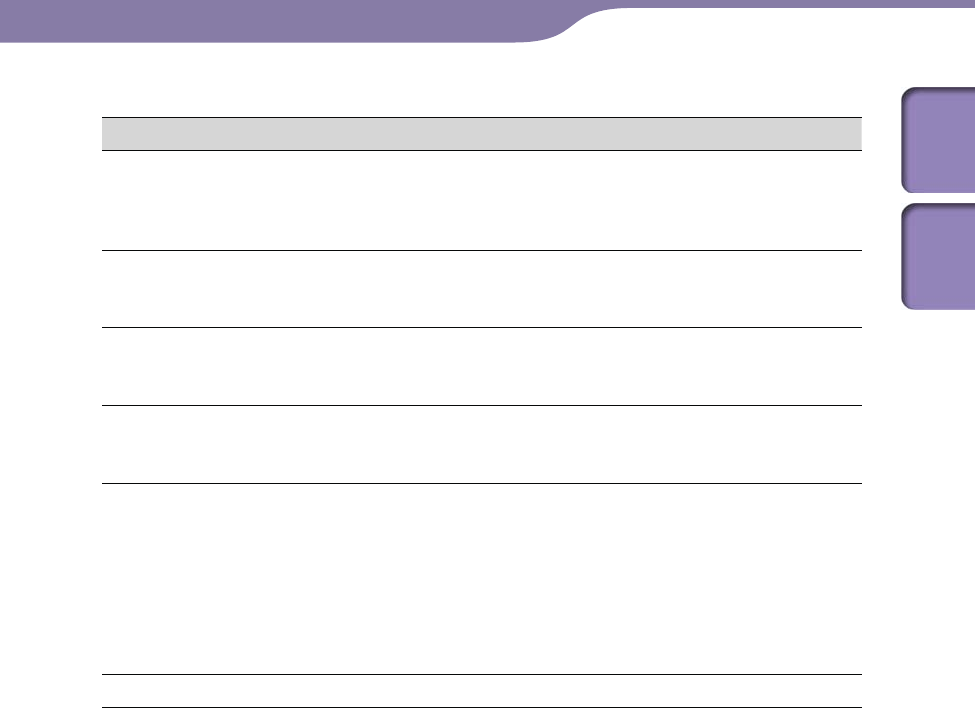
Troubleshooting
149
149
Display
Symptom Cause/Remedy
“” appears for a title. Characters that cannot appear on the player are included in the
title.
Rename the title with appropriate characters using the
software you used to transfer or Windows Explorer.
“Unknown” is displayed
for an album or artist
name, etc.
The data has no data information, such as album or artist
name, etc.
Garbled characters are
displayed.
The wrong language is selected.
Select the correct language from “Language Settings” (
page 126), and then transfer data to the player again.
The screen darkens while
displaying a photo.
There was no operation attempted for the time selected in
“Screen Off Timer” ( page 120).
Press any button.
The screen turns off. There was no operation attempted for the period you set in
“Screen Off Timer” ( page 120).
Press any button.
“On-Hold Display” is set to “No.”
Slide the HOLD switch to the opposite position ( page
10).
Set “On-Hold Display” to “Yes” ( page 63). You can play
back a video even when the HOLD function is activated.
A message appears. See the “Messages” ( page 160).
Continued
Table of
Contents
Index

Troubleshooting
150
150
Power
Symptom Cause/Remedy
Battery life is short. The operating temperature is below 5 °C (41 °F).
Battery life becomes shorter due to the battery
characteristics. This is not a malfunction.
Battery charging time is not sufficient.
Charge the battery until appears.
By adjusting the settings or managing the power supply
properly, it is possible to save the battery power and use the
player for a longer time ( page 176).
You have not used the player for a prolonged period.
The efficiency of the battery will be improved by repeatedly
charging and discharging it.
When usable battery life becomes half the usual time, even
after charging the battery fully, the battery should be replaced.
Consult your nearest Sony dealer.
Copyright-protected contents are played.
When copyright-protected contents are played, battery life
may be shorter.
The player cannot charge
the battery.
The USB cable is not connected to a USB port on your
computer properly.
Disconnect the USB cable, and then reconnect it.
Use the supplied USB cable.
The battery is charged in an ambient temperature out of the
range of 5 °C (41 °F) to 35 °C (95 °F).
Charge the battery in an ambient temperature of 5 °C (41
°F) to 35 °C (95 °F).
The computer is not on.
Turn on the computer.
Your computer has entered sleep or hibernation status.
Release the computer from sleep or hibernation status.
An AC adapter that does not support the player is used.
Use an optional AC adapter that supports the player.
A USB hub is being used.
Connecting the player via a USB hub may not work.
Connect the player to your computer using the supplied
USB cable.
The operating system installed on the computer is not be
supported by the player.
To charge the player, connect the player to a computer with
the operating system that is supported by the player.
After prescribing the remedies above, if the problem still
persists, press the RESET button of the player and reconnect it
to the computer by using the supplied USB cable.
The player turns off
automatically.
To avoid unnecessary battery consumption, the player
automatically turns off.
Press any button to turn the player on.
Charging completes very
quickly.
If the battery is already almost fully charged when charging
begins, little time is needed to reach full charge.
Continued
Table of
Contents
Index

Troubleshooting
151
151
Connection with a computer
Symptom Cause/Remedy
Cannot install the
software.
Your computer is installed with an operating system that is not
supported by the player.
Check the operating system of your computer ( page
177).
Other software is running on Windows.
If other software is running, it may interfere with
installation. Particularly, be sure to stop security software
because it can put a heavy load on the computer.
There is not enough free space for the hard drive.
The software requires 450 MB of hard drive space. Delete
unnecessary files.
Your account has no administrator privileges, or you have not
logged in as the computer’s administrator.
To install the software, log in with an account with
administrator privileges or log in as the computer’s
administrator.
A message dialog is covered from your site by the install
screen.
Press and hold the [Alt] key and press the [Tab] key several
times until the message dialog appears. Then follow the
message.
The progress bar on the
install screen does not
proceed. Or, the access
lamp of the hard drive
does not light for several
minutes.
Wait until the installation is completed, because it is
progressing properly. The installation may take 30 minutes or
more depending on the computer.
The installer does not start
up automatically.
After inserting the CD-ROM, if the installer does not start up
automatically, select [My Computer] (Windows XP) or
[Computer] (Windows Vista) from the [start] menu on the
task bar of Windows, then double-click the CD-ROM drive
icon to start up the installer.
Media Manager for
WALKMAN does not start
up.
Your computer’s system environment has changed, perhaps
due to an update of the Windows operating system.
Continued
Table of
Contents
Index

Troubleshooting
152
152
Symptom Cause/Remedy
“Connecting” or
“Connected USB (MTP)”
does not appear when
connected to the computer
with the supplied USB
cable.
The USB cable is not connected to a USB port on your
computer properly.
Disconnect the USB cable, and then reconnect it.
Use the supplied USB cable.
A USB hub is being used.
Connecting the player via a USB hub may not work.
Connect the player to your computer using the supplied
USB cable.
The software authentication may be performed and it may take
rather a long time. Wait for a while.
The software installation has been failed.
Reinstall the software by using the installer included in the
supplied CD-ROM. The imported data will remain
untouched.
The computer is running another software other than the one
used for transferring.
Disconnect the USB cable, wait a few minutes, and
reconnect it. If the problem persists, disconnect the USB
cable, restart the computer, and then reconnect the USB
cable.
“Connecting” or “Connected USB (MTP)” may not appear on
the player, depending on the software environment that is
running on your computer.
Activate Windows Media Player, or Windows Explorer.
By setting the player to the USB connection standby mode
before connecting it to a computer, you may be able to
establish connection between the player and the computer with
more reliability.
Select “Yes” for the “USB Connection Mode” ( page 124).
The player enters the USB connection standby mode and
the USB connection standby screen appears.
After prescribing the remedies above, if the problem still
persists, press the RESET button of the player and reconnect it
to the computer by using the supplied USB cable.
The player is not
recognized by the
computer when it is
connected to the
computer.
The USB cable is not connected to a USB port on your
computer properly.
Disconnect the USB cable, and then reconnect it.
A USB hub is being used.
Connecting the player via a USB hub may not work.
Connect the player to your computer using the supplied
USB cable.
The USB port on your computer may have a problem. Connect
the player to another USB port on your computer.
Continued
Connection with a computer (continued)
Table of
Contents
Index

Troubleshooting
153
153
Symptom Cause/Remedy
Data cannot be transferred
to the player from your
computer.
Transferring may be stopped due to noise such as static
electricity, etc. This happens to protect data information.
Disconnect the player, then reconnect it.
If you transfer files by drag-and-drop on some computers that
do not have Windows Media Player 11 installed, there may be
limited files (AAC, video files, etc.) that can be transferred by
drag-and-drop.
Install Windows Media Player 11 from the supplied CD-
ROM, then transfer files by drag-and-drop again. Before
installing the supplied Windows Media Player 11 on your
computer, make sure to check whether your software or
service corresponds to Windows Media Player 11. For
details on usage, or support on Windows Media Player, visit
the following web site:
http://support.microsoft.com/
The USB cable is not connected to a USB port on your
computer properly.
Disconnect the USB cable, and then reconnect it.
There is not enough free space in the built-in flash memory.
Transfer any unnecessary data back to your computer to
increase free space.
You can transfer up to 8,192 playlists to the player. If the total
number of playlists on the player reaches 8,192, you cannot
transfer playlists to the player anymore. Furthermore, if a
playlist contains songs more than 65,535, you cannot transfer it
to the player.
Songs with a limited playing period or playing count may not
be transferred due to restrictions set by copyright holders. For
details on the settings of each audio file, contact the distributor.
Abnormal data exists on the player.
Transfer usable files back to your computer and format the
built-in flash memory on the player ( page 125).
You may not be using the supplied software to transfer data to
the player.
Install the supplied software and use it to transfer data.
The data may be damaged.
Delete the data that cannot be transferred from your
computer, then import it to your computer again. When
importing data to your computer, close any other
applications to avoid data damage.
You may be attempting to transfer a file that is not in a playable
format.
For information on the supported file format, see
“Supported file format” of “Specifications” ( page 173).
You may not transfer a file depending on the file
specification.
Continued
Connection with a computer (continued)
Table of
Contents
Index

Troubleshooting
154
154
Symptom Cause/Remedy
Data cannot be transferred
to the player from your
computer.
Transferable limit of files and folders has been exceeded.
Delete unnecessary data.
You are trying to transfer .m4a, .mp4, .3gp or .m4v files on a
computer that already has Windows Media Player 10 installed.
Install Windows Media Player 11 from the supplied CD-
ROM.
If you transfer data using an appropriate software for
transferring, but the transfer is not made, refer to the
manufacturer.
The transfer takes too long
time.
You are transferring a large file.
It may take long time to transfer a large file.
Only a small amount of
data can be transferred to
the player.
There is not enough free space in the built-in flash memory.
Delete any unnecessary data to increase free space.
Data that cannot be played on the player is stored on the
player.
If data other than song, video, photo, or podcast data is
stored on the player, less data can be transferred. Transfer
back data that cannot be played on the player to the
computer to increase the available space.
The player becomes
unstable while it is
connected to the
computer.
A USB hub or USB extension cable is being used.
Connecting the player via a USB hub or extension cable may
not work. Connect the player to your computer using the
supplied USB cable.
You cannot delete or
rename the folders.
You cannot delete or rename the “MUSIC,” “MP_ROOT,”
“MPE_ROOT,” “VIDEO,” “PICTURES,” “PICTURE,” “DCIM,”
“PODCASTS” and “FEEDS” folders.
Continued
Connection with a computer (continued)
Table of
Contents
Index

Troubleshooting
155
155
Wireless LAN
Symptom Cause/Remedy
The player will not
connect to a wireless
network.
“WLAN Function On/Off” option is set to “Off.”
Set the option to “On” ( page 127).
Reconnect to a wireless network manually ( page 133).
Check if extra settings are required to connect to the wireless
network, such as encryption key (WEP/WPA), fixed IP
address, or proxy setting ( page 127).
The access point uses 152-bit encryption key or Shared Key
authentication as the encryption method.
WEP of the player does not support 152-bit encryption key
nor Shared Key authentication.
The access point you want to use is set to make its SSID
invisible to users.
In this case, the access point may not be shown on the
wireless network access point list. Enter the SSID manually
( page 130).
When connecting to the Internet, some public wireless LAN
access points require entering user ID and password by using
the Internet browser.
Check the public wireless LAN service you intend to
connect to.
The access point of the wireless network may be using a
security protection system not supported by the player.
Consult with the administrator of your network.
The access point may filter access by MAC address.
Check the MAC address of the player ( page 137), then
register the MAC address with the access point to connect
to the wireless LAN.
The network settings of the access point are not correct.
Adjust the settings as described in the manuals that came
with the access point and in any information provided by
the administrator of the wireless LAN.
The player is too far from the access point.
Move the player closer to the access point.
Obstacles such as walls metal, or concrete between the player
and access point may adversely affect the connection.
Try moving the player to a different location.
There is other equipment nearby using the 2.4 GHz frequency
band (such as a cordless phone, a microwave oven, or
Bluetooth computer equipment).
Move the equipment away or turn it off.
The wireless LAN service is temporarily not available or
degraded.
Check with the administrator of your wireless LAN service
for the status.
Continued
Table of
Contents
Index
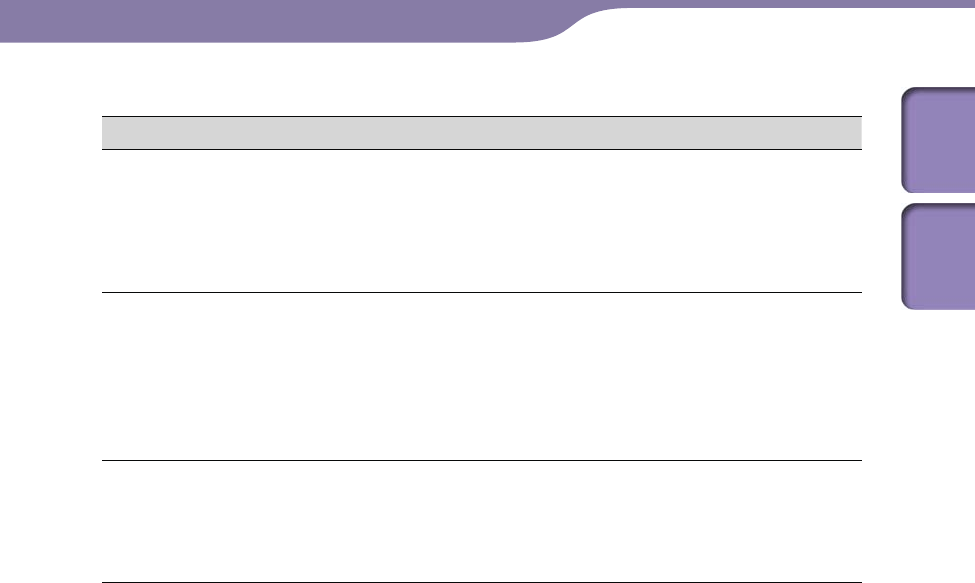
Troubleshooting
156
156
Symptom Cause/Remedy
You are positioned within
a wireless LAN and it is
available, but the icon of
the Select Access Point
screen indicates no signal
strength.
The wireless LAN status is renewed when the Select Access
Point screen is brought up or “Scan” is tapped.
Select “Scan” on the Select Access Point screen.
Some applications cannot
use the wireless LAN
function.
Some public wireless LAN access points limit the usage of the
service until you enter the user ID and password at the
provider’s website by using the Internet browser.
Check the public wireless LAN service’s usage.
Some public wireless LAN access points restrict the use of
some kind of the Internet service.
Connect to another access point.
The access point you
intend to connect to does
not appear in the Select
Access Point screen.
The access point you want to use is set to make its SSID
invisible to users.
In this case, the access point may not be shown on the
wireless network access point list. Enter the SSID manually
( page 130).
Continued
Wireless LAN (continued)
Table of
Contents
Index

Troubleshooting
157
157
FM Radio
Symptom Cause/Remedy
You cannot hear an FM
broadcast well.
The receiving frequency is not fully tuned in.
Select the frequency manually to improve reception by
dragging or flicking the frequency up or down. ( page
72).
Reception is weak and
sound quality is poor.
The radio signal is weak.
Listen to the FM broadcast near a window since the signal
may be weak inside buildings or in vehicles.
The headphone cord is not fully extended.
The headphone cord functions as an antenna. Extend the
headphone cord as far as possible.
Setting the receiver to monaural may reduce noise.
Set the “Mono/Auto” option to “Mono” ( page 74).
The FM broadcast is
affected by interference.
A device emitting radio signals, such as a mobile phone, is
being used near the player.
When using devices such as mobile phones, keep them away
from the player.
YouTube
Symptom Cause/Remedy
Sound or video is
interrupted intermittently.
The transfer rate of the wireless LAN is too slow.
Move the player closer to the access point, or connect to
another access point. Or, pause until the buffering is
completed, then begins playback.
Some videos do not appear
in the list.
Some videos that are specified by YouTube as unsuitable for
underage persons are not displayed nor played back on the
player.
Cannot connect to
YouTube.
You are not connected to a wireless LAN ( page 33).
Some public wireless LAN access points limit the usage of the
service until you enter the user ID and password at the
provider’s website by using the Internet browser.
Check the public wireless LAN service’s usage.
Cannot move to the latter
part of the Seek Slider.
The buffering is not completed.
You cannot move the indicator (playback location) to the
part where the data has not been read yet. Wait until the
buffering is completed, then move there.
Continued
Table of
Contents
Index

Troubleshooting
158
158
Podcast
Symptom Cause/Remedy
Cannot refresh a podcast. If you transfer podcast episodes from a computer to the player
by using Windows Explorer, you cannot refresh the podcast.
Register the podcast by using the player or Media Manager
for WALKMAN.
Cannot download
episodes by using “Refresh
Podcast.”
The podcast is not selected to refresh.
Select the podcast to refresh ( page 88).
Cannot play back an
episode.
The player does not support the file format of the episode.
Check the file format playable on the player ( page 173).
Too few episodes are
downloaded.
An episode that has already been downloaded to the player is
not downloaded ( page 89).
An episode of unsupported file format is not downloaded (
page 173).
Internet browser
Symptom Cause/Remedy
A particular Web page is
not displayed correctly.
Because the range of standards and technologies used to design
Web pages is so vast, it is not possible to guarantee that all
pages will be displayed correctly.
The clock setting is wrong.
Adjust the clock ( page 26).
JavaScript is disabled.
The page may be displayed if you activate JavaScript (
page 108).
Cannot scroll lists on the
Internet browser.
You cannot scroll the favorites list, history list, and time zone
list by dragging them.
Select / to scroll.
Continued
Table of
Contents
Index
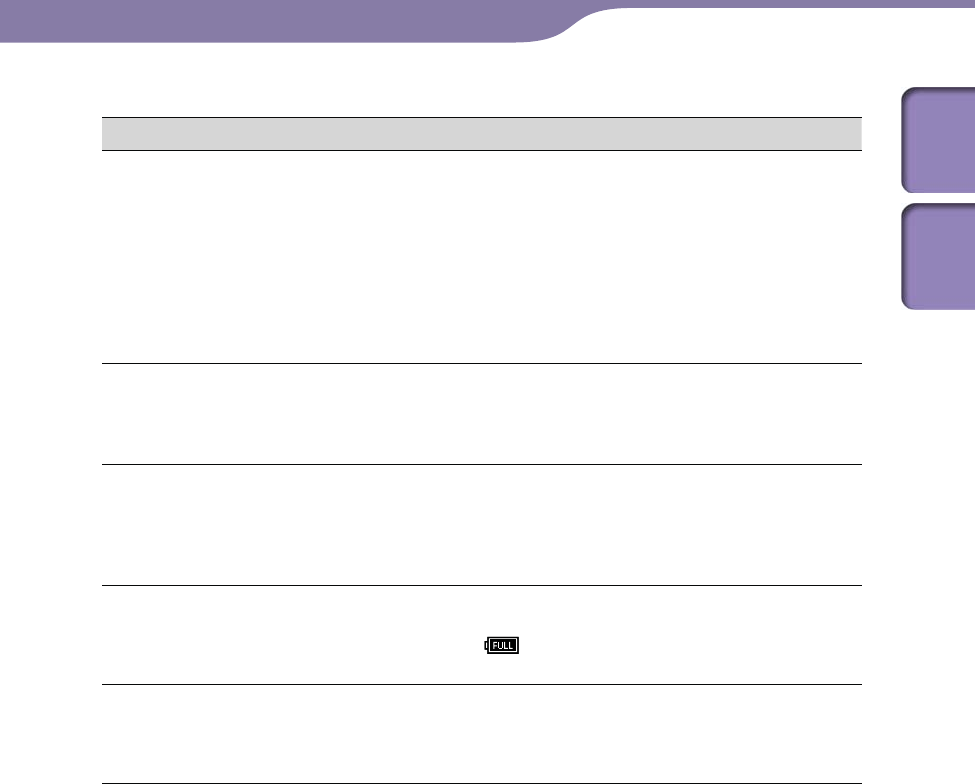
Troubleshooting
159
159
Other
Symptom Cause/Remedy
The touch panel does not
work properly.
A screen protection sheet or privacy filter is not applied
properly.
If the sheet lies off the edge of the screen, or burrows its way
into the gap, reapply it. If you are using a sheet other than
Sony’s optional protection sheet, it may interfere with the
touch panel.
The HOLD switch is set to the HOLD position.
Slide the HOLD switch to the opposite position ( page
10).
There is no beep sound
when the player is
operated.
“Beep Settings” is set to “Off.”
Set “Beep Settings” to “On” ( page 119).
The beep does not sound when the player is connected to the
optional cradle, or another device.
The player gets warm. The player may become warm when the battery is being
charged and just after charging. The player also may get warm
when a large amount of data is transferred. This behavior is
normal and not cause for concern. Set the player aside for a
while to allow it to cool down.
The date and time have
been reset.
If you left the player for a while with the battery used up, the
date and time may be reset. This is not a malfunction. Charge
the battery until appears on the screen ( page 24), and
set the date and time again ( page 26).
Noise is generated when
plugging or unplugging
the headphones.
Take off the headphones when plugging or unplugging the
headphones. If you plug or unplug the headphones during
playing song or using Noise Canceling function, you may hear
a noise from the headphones. This is not a malfunction.
Continued
Table of
Contents
Index

Troubleshooting
160
160
Messages
Follow the instructions below if a message appears in the display.
Message Meaning Remedy
Cannot play; file format is not
supported.
You are trying to play a file
that cannot be played on the
player.
You transferred an audio
file to video folders by drag-
and-drop.
You cannot play a song in an
unsupported format file (
page 173).
Place them in folders under
the “MUSIC” folder.
If the player cannot play back
WMV files, they may become
playable by transferring by
Windows Media Player 11.
Delete failed. You attempted to delete a
video but the player failed to
delete it.
Delete the video by using
Media Manager for
WALKMAN or Windows
Explorer.
Do not disconnect. The player is connected to a
computer or other external
devices to transfer data.
This is not an error message.
Do not disconnect the USB
cable until transferring
completes.
Firmware update failed. Updating the firmware failed
to complete.
Follow the instructions
displayed on your computer
to retry updating the
firmware.
LOW BATTERY. Please Charge. The player’s battery is running
low.
Charge the battery ( page
24).
Noise Canceling unavailable.
Unable to execute.
“External Input Mode” and
“Quiet Mode” are unavailable
because the usage
environment does not meet
the requirement for those
functions.
Make sure that the NOISE
CANCELING switch is set to
the activated position (
page 112), and the supplied
headphones are used.
Not enough free space in memory.
Delete files to ensure free space.
The player’s available capacity
is insufficient.
Connect the player to your
computer using the supplied
USB cable, and then delete
any unnecessary data from the
player using another software
used for transferring, or
Windows Explorer.
You can delete podcast’s
episodes using the player (
page 97).
Unable to set photo as wallpaper. The selected photo cannot be
designated as the wallpaper.
Make sure whether the photo
is not a damaged file or the
size is not too large.
Table of
Contents
Index

Additional Information
161
161
Precautions
The following FCC statement applies only to the version of this model
manufactured for sale in the USA. Other versions may not comply with FCC
technical regulations.
NOTE:
This equipment has been tested and found to comply with the limits for a Class
B digital device, pursuant to Part 15 of the FCC Rules. These limits are
designed to provide reasonable protection against harmful interference in a
residential installation. This equipment generates, uses and can radiate radio
frequency energy and, if not installed and used in accordance with the
instructions, may cause harmful interference to radio communications.
However, there is no guarantee that interference will not occur in a particular
installation. If this equipment does cause harmful interference to radio or
television reception, which can be determined by turning the equipment off
and on, the user is encouraged to try to correct the interference by one or more
of the following measures:
– Reorient or relocate the receiving antenna.
– Increase the separation between the equipment and receiver.
– Connect the equipment into an outlet on a circuit different from that to
which the receiver is connected.
– Consult the dealer or an experienced radio/TV technician for help.
You are cautioned that any changes or modifications not expressly approved in
this manual could void your authority to operate this equipment.
This equipment must not be co-located or operated in conjunction with any
other antenna or transmitter.
Continued
Table of
Contents
Index
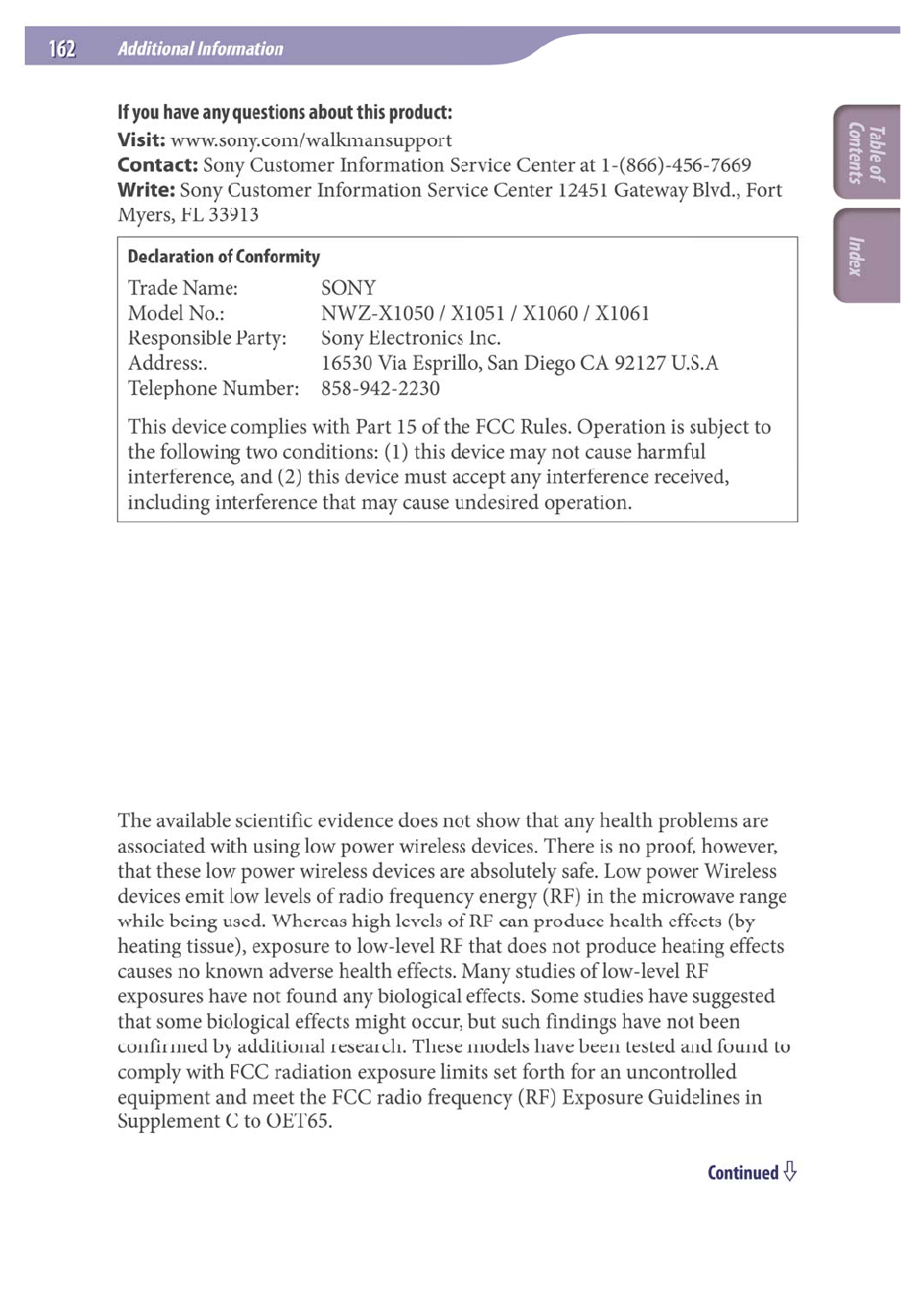

Additional Information
163
163
For customers in Canada
Operation is subject to the following two conditions: (1) this device may not
cause interference, and (2) this device must accept any interference, including
interference that may cause undesired operation of this device.
The available scientific evidence does not show that any health problems are
associated with using low power wireless devices. There is no proof, however,
that these low power wireless devices are absolutely safe. Low power Wireless
devices emit low levels of radio frequency energy (RF) in the microwave range
while being used. Whereas high levels of RF can produce health effects (by
heating tissue), exposure to low-level RF that does not produce heating effects
causes no known adverse health effects. Many studies of low-level RF
exposures have not found any biological effects. Some studies have suggested
that some biological effects might occur, but such findings have not been
confirmed by additional research. These models have been tested and found to
comply with IC radiation exposure limits set forth for an uncontrolled
equipment and meet RSS-102 of the IC radio frequency (RF) Exposure rules.
Notice for customers: the following information is only applicable to equipment sold in
countries applying EU directives
The manufacturer of this product is Sony Corporation, 1-7-1 Konan, Minato-
ku, Tokyo, Japan. The Authorized Representative for EMC and product safety
is Sony Deutschland GmbH, Hedelfinger Strasse 61, 70327 Stuttgart, Germany.
For any service or guarantee matters, please refer to the addresses given in
separate service or guarantee documents.
Disposal of Old Electrical & Electronic Equipment (Applicable in the European Union and
other European countries with separate collection systems)
This symbol on the product or on its packaging indicates that this
product shall not be treated as household waste. Instead it shall be
handed over to the applicable collection point for the recycling of
electrical and electronic equipment. By ensuring this product is
disposed of correctly, you will help prevent potential negative
consequences for the environment and human health, which could otherwise
be caused by inappropriate waste handling of this product. The recycling of
materials will help to conserve natural resources. For more detailed
information about recycling of this product, please contact your local Civic
Office, your household waste disposal service or the shop where you purchased
the product.
Applicable accessories: Headphones
Continued
Table of
Contents
Index

Additional Information
164
164
Disposal of waste batteries (applicable in the European Union and other European countries
with separate collection systems)
This symbol on the battery or on the packaging indicates that the
battery provided with this product shall not be treated as household
waste.
By ensuring these batteries are disposed of correctly, you will help
prevent potentially negative consequences for the environment and human
health which could otherwise be caused by inappropriate waste handling of the
battery. The recycling of the materials will help to conserve natural resources.
In case of products that for safety, performance or data integrity reasons
require a permanent connection with an incorporated battery, this battery
should be replaced by qualified service staff only.
To ensure that the battery will be treated properly, hand over the product at
end-of-life to the applicable collection point for the recycling of electrical and
electronic equipment.
For all other batteries, please view the section on how to remove the battery
from the product safely. Hand the battery over to the applicable collection
point for the recycling of waste batteries.
For more detailed information about recycling of this product or battery, please
contact your local Civic Office, your household waste disposal service or the
shop where you purchased the product.
For users in France
At high volume, prolonged listening to the personal audio player can
damage the user’s hearing.
On safety
Be sure not to short-circuit the terminals of the player with other metallic
objects.
Do not touch the rechargeable battery with bare hands if it is leaking. Since
battery liquid may remain in the player, consult your nearest Sony dealer if
the battery has leaked. If the liquid gets into your eyes, do not rub your eyes
as it may lead to blindness. Wash out your eyes with clean water, and consult
a doctor.
Also, if the liquid gets on to your body or clothes, wash it off immediately. If
you do not, it may cause burns or injury. If you get burned or injured by the
liquid from the battery, consult a doctor.
Do not pour water or put any foreign object in the player. Doing so may
cause fire or electric shock.
If this occurs, turn off the player immediately, disconnect the USB cable from
the player, and consult your nearest Sony dealer or Sony Service Center.
Do not put the player into fire.
Continued
Table of
Contents
Index
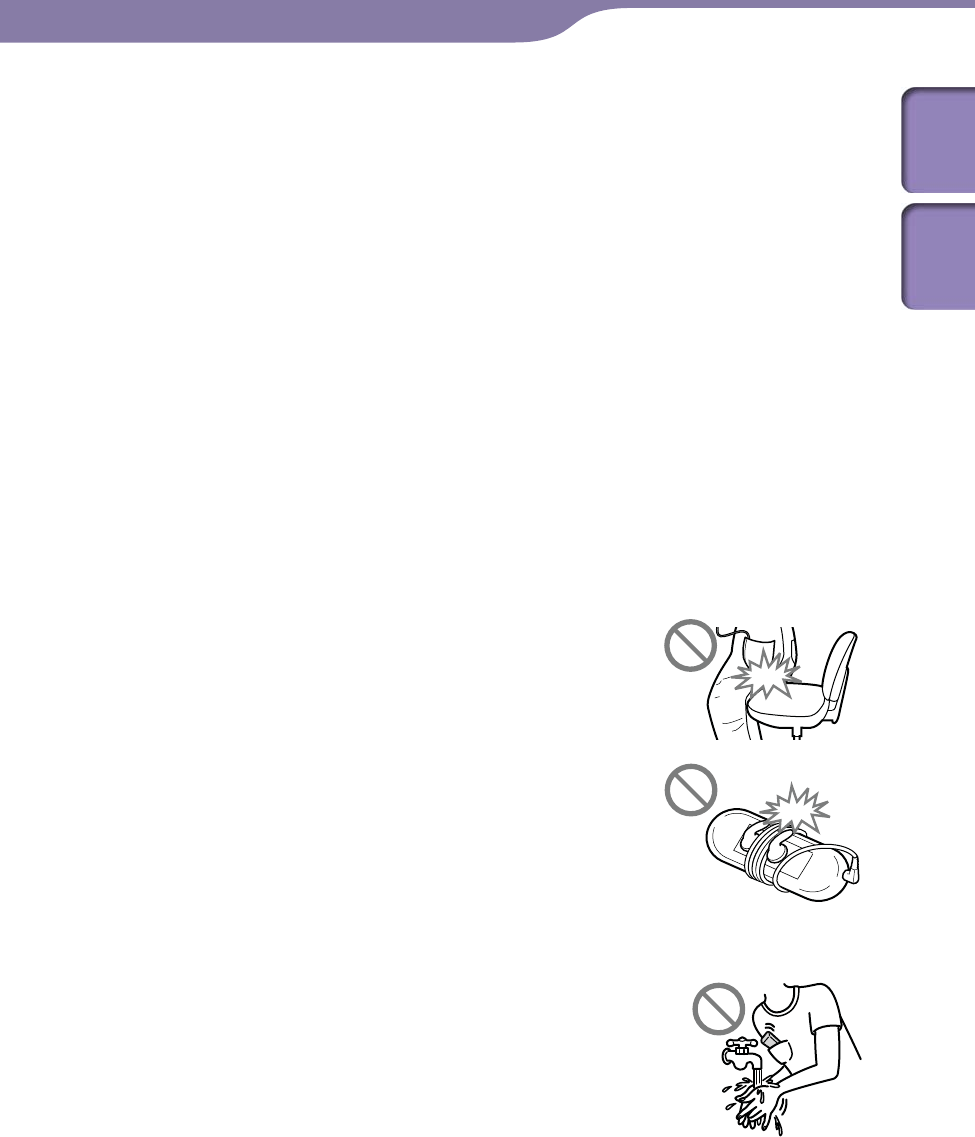
Additional Information
165
165
Do not take apart or remodel the player. Doing so can result in electric shock.
Consult your nearest Sony dealer or Sony Service Center for exchange of
rechargeable batteries, internal checks or repair.
On installation
Do not put any heavy object on top of the player or apply a strong shock to
the player. It may cause a malfunction or damage.
Never use the player where it will be subjected to extremes of light,
temperature, moisture or vibration. The player may become discolored,
distorted or damaged.
Never leave the player exposed to high temperature, such as in a car parked
in the sun or under direct sunlight.
Do not leave the player in a place subject to excessive dust.
Do not leave the player on an unstable surface or in an inclined position.
If the player causes interference to radio or television reception, turn the
player off and move it away from the radio or television.
When using the player, remember to follow the precautions below in order to
avoid warping the cabinet or causing the player to malfunction.
– Make sure not to sit down with the player in your back
pocket.
– Make sure not to put the player into a bag with the
headphones/earphones cord wrapped around it and
then subject the bag to strong impact.
Do not expose the player to water. The player is not waterproof. Remember
to follow the precautions below.
– Be careful not to drop the player into a sink or other
container filled with water.
– Do not use the player in humid locations or bad weather,
such as in the rain or snow.
– Do not get the player wet.
If you touch the player with wet hands, or put the player in
a damp article of clothing, the player may get wet and this
may cause a malfunction of the player.
When you unplug the headphones from the player, make sure to hold the
headphone plug to unplug it. Pulling the headphone cord itself may cause
damage to the headphone cord.
Continued
Table of
Contents
Index

Additional Information
166
166
Note on static electricity
In particularly dry air conditions, mild tingling may be felt on your ears. This is
a result of static electricity accumulated in the body, and not a malfunction of
the player.
The effect can be minimized by wearing clothes made from natural materials.
On heat build-up
Heat may build up in the player while charging if it is used for an extended
period of time.
On the headphones
Road safety
Avoid listening with your headphones in situations where hearing must not be
impaired.
Preventing hearing damage
Avoid using the headphones at a high volume. Hearing experts advise against
continuous, loud and extended play. If you experience a ringing in your ears,
reduce the volume or discontinue use.
Do not turn the volume up high all at once, especially when using headphones.
Turn up the volume gradually so that loud sound will not hurt your ears.
Caring for others
Keep the volume at a moderate level. This will allow you to hear outside sounds
and to be considerate to the people around you.
Warning
If there is lightning when you are using the player, take off the headphones
immediately.
If you experience an allergic reaction to the supplied headphones, stop using
them at once and contact a doctor.
Continued
Table of
Contents
Index

Additional Information
167
167
On the use
When using a strap (sold separately), be careful to avoid hooking it on objects
you pass by. Furthermore be careful not to swing the player by the strap to
avoid bumping people.
Refrain from using the player according to the in-flight announcements
during take off or landing in an aircraft.
Note that condensation may form temporarily in cases such as when the
player is moved quickly from a low-temperature environment to a high
temperature environment or used in a room that has a heater just turned on.
Condensation creates a phenomenon where moisture in the air adheres to
surfaces such as metal panels, etc., and then changes to liquid.
If condensation forms in the player, leave it turned off until the condensation
disappears. If you use the player with condensation present, a malfunction
may result.
Precautions about the display
On the OLED (Organic Light Emitting Diode) display
Do not apply strong force to the surface of the OLED display. This may cause
a malfunction of the OLED display.
On the display
The surface of the display of the player is made of glass.
When handling the player, be careful not to drop it and not to give an impact to
it, otherwise the display may be broken. If the glass have been broken or
become chipped, stop using the player and avoid touching the broken part,
otherwise you may be injured.
On the OLED (Organic Light Emitting Diode)
The prolonged display of a still image or the repetitive display of the same
image may cause permanent screen burn to occur. To protect the display, avoid
displaying images that can easily develop screen burn and follow precautions
when using the player.
Continued
Table of
Contents
Index

Additional Information
168
168
On screen burn
In general, screen burn may develop on OLED panels because of the
characteristics of the materials which are used to achieve high definition of
images. If you keep displaying a still image at the same position of the display,
or repeat displaying the same image, the image will be burned in and become
unable to be removed.
Images that easily develop screen burn
Widescreen images with black bars above and below them (letterbox images)
Images with a 4:3 aspect ratio
Photos and still images that rest on the display for a long time
To prevent screen burn
Display images on full screen.
Set “Zoom Settings” option to “Auto” or “Full” ( page 60).
On cleaning
Clean the player’s case with a soft cloth, such as a cleaning cloth for
eyeglasses.
If the player’s case becomes very dirty, clean it with a soft cloth slightly
moistened with water or a mild detergent solution.
Do not use any type of abrasive pad, scouring powder, or solvent, such as
alcohol or benzene, as it may mar the finish of the case.
Be careful not to let water get into the player from the opening near the
connector.
Clean the headphone plug periodically.
If you have any questions or problems concerning the player, please consult
your nearest Sony dealer.
Important Notice
Copyright laws prohibit reproducing the software or the manual
accompanying it in whole or in part, or renting the software without the
permission of the copyright holder.
In no event will SONY be liable for any financial damage, or loss of profits,
including claims made by third parties, arising out of the use of the software
supplied with this player.
Continued
Table of
Contents
Index

Additional Information
169
169
In the event a problem occurs with this software as a result of defective
manufacturing, SONY will replace it. However, SONY bears no other
responsibility.
The software provided with this player cannot be used with equipment other
than that to which it is so designated.
Please note that, due to continued efforts to improve quality, the software
specifications may be changed without notice.
Operation of this player with software other than that provided is not covered
by the warranty.
The ability to display the languages on supplied software will depend on the
installed OS on your computer. For better results, please ensure that the
installed OS is compatible with the desired language you want to display.
– We do not guarantee all the languages will be able to be displayed properly on
the supplied software.
– User-created characters and some special characters may not be displayed.
The explanations in this manual assume that you are familiar with the basic
operations of Windows.
For details on the use of your computer and operating system, please refer to
the respective manuals.
Notice for users
The recorded song is limited to private use only. Use of the song beyond this
limit requires permission of the copyright holders.
Sony is not responsible for incomplete recording/downloading or damaged
data due to problems of the player or computer.
The ability to display the languages on the supplied software will depend on
the installed OS on your computer. For better results, please ensure that the
installed OS is compatible with the desired language you want to display.
– We do not guarantee all the languages will be able to be displayed properly on
supplied software.
– User-created characters and some special characters may not be displayed.
Depending on the types of the text and characters, the text shown on the
player may not be displayed properly on device. This is due to:
– The capacity of the connected player.
– The player is not functioning normally.
– Content information is written in the language or the character that is not
supported by the player.
Continued
Table of
Contents
Index

Additional Information
170
170
About sample data*1
The player is pre-installed with sample data.
If you delete the sample data, you cannot restore it, and we will not supply any
replacement data.
*1 In some countries/regions some sample data is not installed.
The recorded song is limited to private use only. Use of the song beyond
this limit requires permission of the copyright holders.
Sony is not responsible for incomplete recording/downloading or damaged
data due to problems of the player or computer.
Depending on the type of the text and characters, the text shown on the
player may not be displayed properly on device. This is due to:
– The capacity of the connected player.
– The player is not functioning normally.
– Content information is written in language or character that are not
supported by the player.
About the customer support Web site
If you have any questions or issues with this product, or would like information
on compatible items with this product, visit the following web sites.
For customers in the USA: http://www.sony.com/walkmansupport
For customers in Canada: http://www.sony.ca/ElectronicsSupport/
For customers in Europe: http://support.sony-europe.com/DNA
For customers in Latin America: http://www.sony-latin.com/index.crp
For customers in other countries/regions: http://www.sony-asia.com/support
For customers who purchased the overseas models:
http://www.sony.co.jp/overseas/support/
Table of
Contents
Index

Additional Information
171
171
License and Trademark Notice
OpenMG, ATRAC, ATRAC3, ATRAC3plus, ATRAC Advanced Lossless and their logos
are trademarks of Sony Corporation.
“WALKMAN” and “WALKMAN” logo are registered trademarks of Sony Corporation.
Microsoft, Windows, Windows Vista and Windows Media are trademarks or registered
trademarks of Microsoft Corporation in the United States and/or other countries.
and are trademarks of Sony Corporation.
Adobe and Adobe Reader are trademarks or registered trademarks of Adobe Systems
Incorporated in the United States and/or other countries.
Manufactured under license from Dolby Laboratories. Dolby and the double-D symbol
are trademarks of Dolby Laboratories.
MPEG Layer-3 audio coding technology and patents licensed from Fraunhofer IIS and
Thomson.
IBM and PC/AT are registered trademarks of International Business Machines
Corporation.
QuickTime and the QuickTime logo are trademarks or registered trademarks of Apple
Inc., used under license therefrom.
Pentium is a trademark or a registered trademark of Intel Corporation.
YouTube and the YouTube logo are trademarks of Google Inc.
This product contains NetFront Browser of ACCESS CO., LTD.
ACCESS, ACCESS logo and NetFront are registered trademarks or trademarks of
ACCESS CO., LTD. in the United States, Japan and/or other countries.
©2007 ACCESS CO., LTD. All rights reserved.
This software is based in part on the work of the Independent JPEG Group.
THIS PRODUCT IS LICENSED UNDER THE MPEG-4 VISUAL PATENT
PORTFOLIO LICENSE FOR THE PERSONAL AND NON-COMMERCIAL USE OF A
CONSUMER FOR
(i) ENCODING VIDEO IN COMPLIANCE WITH THE MPEG-4 VISUAL
STANDARD (“MPEG-4 VIDEO”) AND/OR
(ii) DECODING MPEG-4 VIDEO THAT WAS ENCODED BY A CONSUMER
ENGAGED IN A PERSONAL AND NON-COMMERCIAL ACTIVITY AND/OR
WAS OBTAINED FROM A VIDEO PROVIDER LICENSED BY MPEG LA TO
PROVIDE MPEG-4 VIDEO.
NO LICENSE IS GRANTED OR SHALL BE IMPLIED FOR ANY OTHER USE.
ADDITIONAL INFORMATION INCLUDING THAT RELATING TO
PROMOTIONAL, INTERNAL AND COMMERCIAL USES AND LICENSING
MAY BE OBTAINED FROM MPEG LA, LLC. SEE
HTTP://WWW.MPEGLA.COM
Continued
Table of
Contents
Index

Additional Information
172
172
THIS PRODUCT IS LICENSED UNDER THE AVC PATENT PORTFOLIO LICENSE
FOR THE PERSONAL AND NON-COMMERCIAL USE OF A CONSUMER TO
(i) ENCODE VIDEO IN COMPLIANCE WITH THE AVC STANDARD (“AVC
VIDEO”) AND/OR
(ii) DECODE AVC VIDEO THAT WAS ENCODED BY A CONSUMER ENGAGED IN
A PERSONAL AND NON-COMMERCIAL ACTIVITY AND/OR WAS OBTAINED
FROM A VIDEO PROVIDER LICENSED TO PROVIDE AVC VIDEO.
NO LICENSE IS GRANTED OR SHALL BE IMPLIED FOR ANY OTHER USE.
ADDITIONAL INFORMATION MAY BE OBTAINED FROM MPEG LA, L.L.C.
SEE
HTTP://MPEGLA.COM
THIS PRODUCT IS LICENSED UNDER THE VC-1 PATENT PORTFOLIO LICENSE
FOR THE PERSONAL AND NON-COMMERCIAL USE OF A CONSUMER TO
(i) ENCODE VIDEO IN COMPLIANCE WITH THE VC-1 STANDARD (“VC-1
VIDEO”) AND/OR<Hard Return>
(ii) DECODE VC-1 VIDEO THAT WAS ENCODED BY A CONSUMER ENGAGED
IN A PERSONAL AND NON-COMMERCIAL ACTIVITY AND/OR WAS
OBTAINED FROM A VIDEO PROVIDER LICENSED TO PROVIDE VC-1
VIDEO.
NO LICENSE IS GRANTED OR SHALL BE IMPLIED FOR ANY OTHER USE.
ADDITIONAL INFORMATION MAY BE OBTAINED FROM MPEG LA, L.L.C.
SEE
HTTP://WWW.MPEGLA.COM
All other trademarks and registered trademarks are trademarks or registered trademarks
of their respective holders. In this manual, TM and ® marks are not specified.
This product is protected by certain intellectual property rights of Microsoft
Corporation. Use or distribution of such technology outside of this product is
prohibited without a license from Microsoft or an authorized Microsoft
subsidiary.
Content providers are using the digital rights management technology for
Windows Media contained in this device (“WM-DRM”) to protect the integrity
of their content (“Secure Content”) so that their intellectual property, including
copyright, in such content is not misappropriated.
This device uses WM-DRM software to play Secure Content (“WM-DRM
Software”). If the security of the WM-DRM Software in this device has been
compromised, owners of Secure Content (“Secure Content Owners”) may
request that Microsoft revoke the WM-DRM Software’s right to acquire new
licenses to copy, display and/or play Secure Content. Revocation does not alter
the WM-DRM Software’s ability to play unprotected content. A list of revoked
WM-DRM Software is sent to your device whenever you download a license
for Secure Content from the Internet or from a PC. Microsoft may, in
conjunction with such license, also download revocation lists onto your device
on behalf of Secure Content Owners.
Program ©2009 Sony Corporation
Documentation ©2009 Sony Corporation
Table of
Contents
Index

Additional Information
173
173
Specifications
Supported file format
Music (Includes podcasts)
Audio Formats
(Codec)
MP3 Media File format: MP3 (MPEG-1 Layer 3) file format
File extension: .mp3
Bit rate: 32 to 320 kbps (Supports variable bit rate (VBR))
Sampling frequency*1: 32, 44.1, 48 kHz
WMA Media File format: ASF file format
File extension: .wma
Bit rate: 32 to 192 kbps (Supports variable bit rate (VBR))
Sampling frequency*1: 44.1 kHz
Compatible with WM-DRM 10
AAC-LC*2Media File format: MP4 file format
File extension: .mp4, .m4a, .3gp
Bit rate: 16 to 320 kbps (Supports variable bit rate (VBR))*3
Sampling frequency*1: 8, 11.025, 12, 16, 22.05, 24, 32, 44.1, 48
kHz
Linear PCM Media File format: Wave-Riff file format
File extension: .wav
Bit rate: 1,411 kbps
Sampling frequency*1: 44.1 kHz
HE-AAC Bit rate: 32 to 128 kbps (Supports variable bit rate (VBR))
Sampling frequency*1: 44.1 kHz
Video (Includes podcasts)
Video Formats
(Codec)
Frame rate: Max. 30 fps
Resolution: Max. QVGA (320 × 240)
AVC
(H.264/AVC)
Media File format: MP4 file format, “Memory Stick” video
format
File extension: .mp4, .m4v
Profile: Baseline Profile
Level: Up to 1.3
Bit rate: Max. 768 kbps
MPEG-4 Media File format: MP4 file format, “Memory Stick” video
format
File extension: .mp4, .m4v
Profile: Simple Profile
Bit rate: Max. 2,500 kbps
Windows Media
Video 9
Media File format: ASF file format
File extension: .wmv
Bit rate: Max. 1,700 kbps
Audio Formats
(Codec)
Channel number: Max. 2 channels
Sampling frequency*1: 24, 32, 44.1, 48 kHz
Bit rate: Max. 288 kbps / channel
WMA
(for Windows Media
Video 9)
Bit rate: 32 to 192 kbps (Supports variable bit rate (VBR))
Sampling frequency*1: 44.1 kHz
File size Max. 2 GB
The number of files Max. 1,000
Continued
Table of
Contents
Index
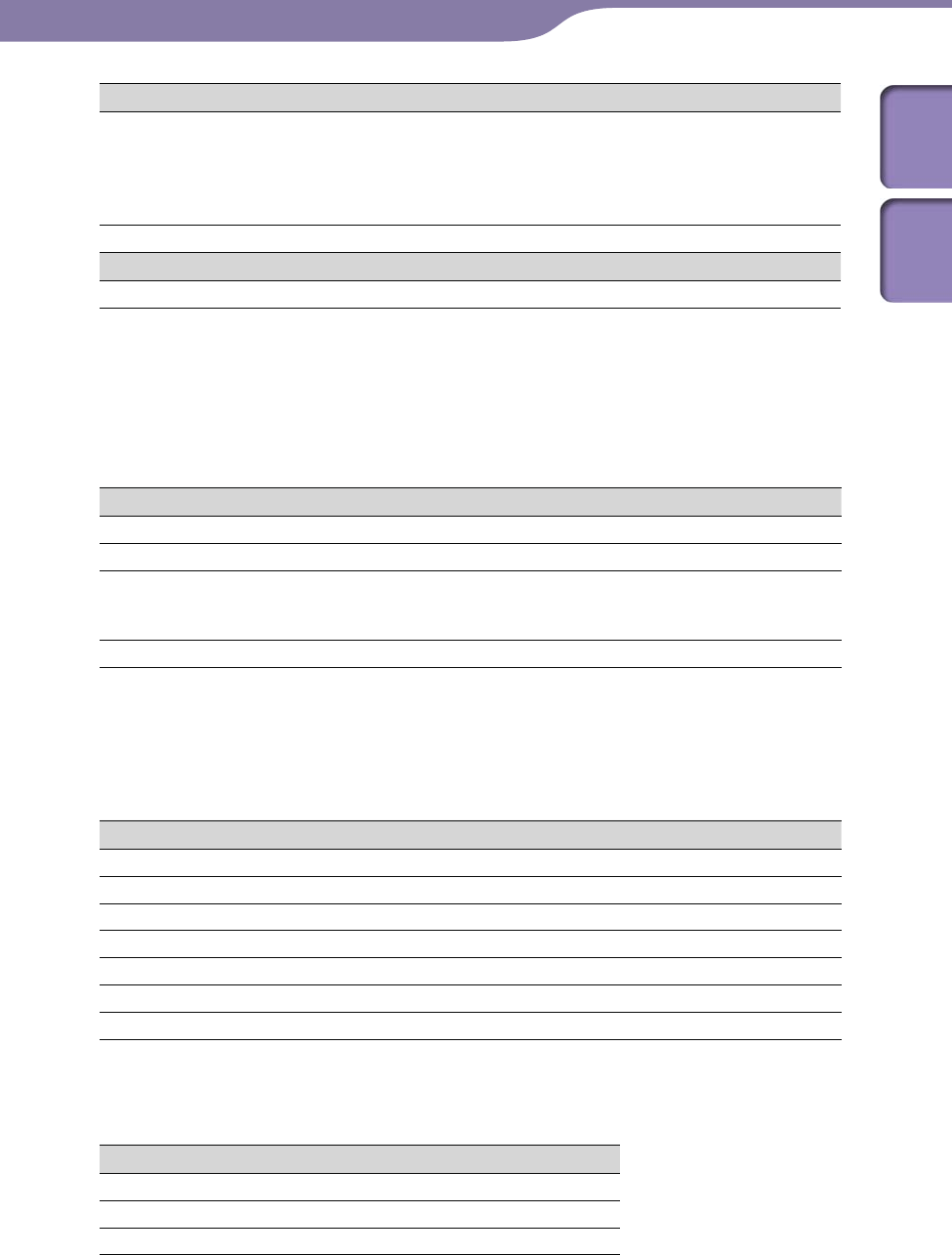
Additional Information
174
174
Photo*4
Photo Format
(Codec)
JPEG Media File format: Compatible with DCF 2.0/Exif 2.21 file
format
File extension: .jpg
Profile: Baseline Profile
Number of pixels: Max. 4,000 × 4,000 pixels (16,000,000 pixels)
The number of files Max. 20,000
Podcast*5
The number of files Max. 10,000
*1 Sampling frequency may not correspond to all encoders.
*2 Copyright protected files cannot be played back.
*3 Non-standard bit rates or non-guaranteed bit rates are included depending on the sampling frequency.
*4 Some photo files cannot be played back, depending on their file formats.
*5 Photo contents are not supported.
Target folder in Drag and Drop
File type Target folder Playable files
Music MUSIC Within 8th level in “MUSIC folder
Video VIDEO Within 8th level in “VIDEO” folder
Photo PICTURE
PICTURES
DCIM
Within 8th level in “PICTURE,” “PICTURES” and “DCIM”
folders
Podcast PODCASTS Within 8th level in “PODCASTS” folder*1
*1 Photo contents are not supported.
Maximum recordable number of songs and time (Approx.)
The approximate times are based on the case in which you transfer or record only 4
minutes songs (not including videos and photos) in the MP3 format. Other playable audio
file format song numbers and times may differ from the MP3 format.
NWZ-X1050 / X1051 NWZ-X1060 / X1061
Bit rate Songs Time Songs Time
48 kbps 2,500 170 hr. 00 min. 5,350 345 hr. 40 min.
64 kbps 1,900 126 hr. 40 min. 4,000 266 hr. 40 min.
128 kbps 985 65 hr. 40 min. 2,050 136 hr. 40 min.
256 kbps 495 33 hr. 00 min. 1,000 66 hr. 40 min.
320 kbps 395 26 hr. 20 min. 820 54 hr. 40 min.
1,411 kbps (Linear PCM) 90 6 hr. 00 min. 185 12 hr. 20 min.
Maximum recordable time of videos (Approx.)
The approximate recordable times are estimated in the case where only videos are transferred.
The time may differ, depending on the conditions under which the player is used.
NWZ-X1050 / X1051 NWZ-X1060 / X1061
Bit rate*1Time Time
384 kbps 15 hr. 00 min. 31 hr. 10 min.
768 kbps 8 hr. 30 min. 17 hr. 50 min.
*1 Bit rate of video. Bit rate of Audio is 128 kbps.
Continued
Table of
Contents
Index

Additional Information
175
175
Maximum recordable number of photos that can be transferred (Approx.)
Max. 20,000
Recordable number of photos may be less depending on file sizes.
Capacity (User available capacity)*1
NWZ-X1050 / X1051: 4 GB (Approx. 3.46 GB = 3,725,197,312 bytes)
NWZ-X1060 / X1061: 8 GB (Approx. 7.19 GB = 7,725,514,752 bytes)
*1 Available storage capacity of the player may vary.
A portion of the memory is used for data management functions.
Output (headphones)
Frequency response
20 to 20,000 Hz (when playing 44.1 kHz sampling data file, single signal measurement)
Total ambient noise reduction*1
TBD
*1 The comparative value between wearing headphones (with the “Select NC
Environment” option set to “Airplane”) and wearing no headphones, under the
simulated airplane noise specified by us. Approximately 15 dB of the total ambient noise
reduction (measured by our measuring method) corresponds to approximately 97 % of
noise reduction in sound energy.
Wall paper Settings
User setting
FM radio
FM Frequency range
87.5 to 108.0 MHz
IF (FM)
375 kHz
Antenna
Headphone cord antenna
Wireless LAN
Standards: IEEE 802.11b/g
Communication range*1:
Approximately 30 m (*** ft)
Frequency band:
2.4 GHz band (2.400 GHz to 2.483 GHz)
Wireless channels:
1 to 13
Modulation:
DS-SS (IEEE 802.11b compliant)
OFDM (IEEE 802.11g compliant)
Security method:
WEP/WPA/WPA2
Connection method:
Manual Setting/WPS/PPPoE
*1 Communication range may vary depending on the operating conditions or settings.
Continued
Table of
Contents
Index
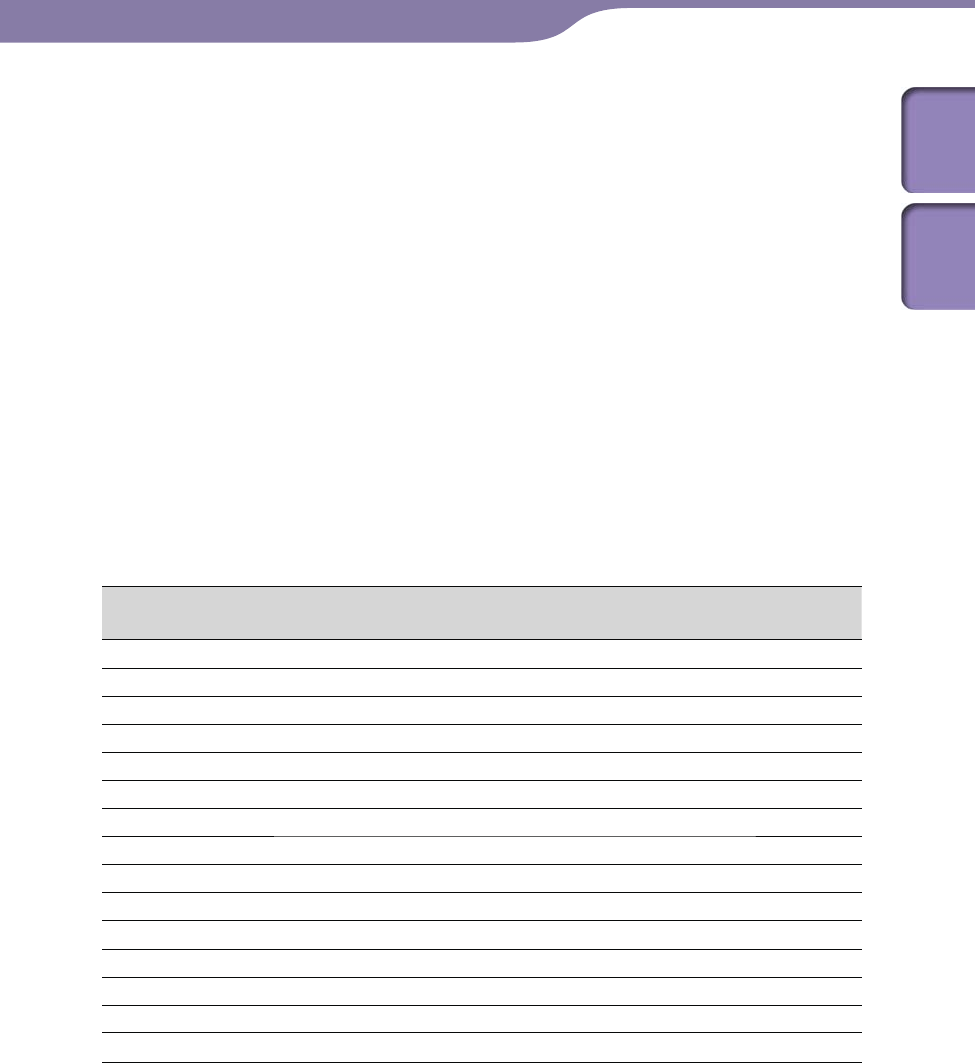
Additional Information
176
176
Interface
Headphone: Stereo mini-jack
WM-PORT (multiple connecting terminal): 22 pins
Hi-Speed USB (USB 2.0 compliant)
Operating temperature
5 °C to 35 °C (41 °F to 95 °F)
Power source
Built-in rechargeable lithium-ion battery
USB power (from a computer via the supplied USB cable)
Charging time
USB-based charging
Approx. 3 hours (full charge), Approx.1.5 hours (approx. 80 %)
Battery life (continuous playback)
By setting as follows, a longer battery life can be expected.
The times below are approximated when “Equalizer”, “VPT (Surround)”, “DSEE(Sound
Enhance)”, “Clear Stereo”, “Dynamic Normalizer” are deactivated. Furthermore, for videos,
the time approximated when the brightness of the screen is set to “3.”
The time below may differ depending on ambient temperature or the status of use.
With Noise Canceling function
deactivated
With Noise Canceling function
activated
Music
Playback at ATRAC 132 kbps Approximately 37 hours Approximately 28 hours
Playback at ATRAC 128 kbps Approximately 33 hours Approximately 26 hours
Playback at ATRAC 48 kbps Approximately 35 hours Approximately 27 hours
Playback at ATRAC Advanced Lossless 64 kbps Approximately 34 hours Approximately 27 hours
Playback at MP3 128 kbps Approximately 40 hours Approximately 30 hours
Playback at WMA 128 kbps Approximately 38 hours Approximately 30 hours
Playback at AAC 128 kbps Approximately 38 hours Approximately 29 hours
Playback at HE-AAC 48 kbps Approximately 38 hours Approximately 29 hours
Playback at Linear PCM 1,411 kbps Approximately 41 hours Approximately 31 hours
Video
Playback at MPEG-4 384 kbps Approximately 10 hours Approximately 9 hours
Playback at AVC Baseline 384 kbps Approximately 8.5 hours Approximately 7.5 hours
Playback at WMV 384 kbps Approximately 10 hours Approximately 9.5 hours
At receiving FM broadcasting Approximately 22 hours Approximately 18 hours
Continued
Table of
Contents
Index

Additional Information
177
177
Display
3-inch, OLED (Organic Light Emitting Diode) color display, WQVGA (432 × 240 pixels),
262,144 colors
Dimensions (w/h/d, projecting parts not included)
52 × 96.5 × 9.8 mm ( 2 1/8 × 3 7/8 × 13/32 inches)
Dimension (w/h/d)
52.5 × 97.4 × 10.5 mm (2 1/8 × 3 7/8 × 7/16 inches)
Mass
Approx. 98 g (Approx. 3.5 oz)
Supplied Accessories
Headphones (1)
USB cable (1)
Earbuds (Size S, L) (1)
Attachment (1)
Use when connecting the player to the optional cradle, etc.
Audio input cable (1)
Plug adaptor for in-flight use (single/dual) (1)
CD-ROM*1*2 (1)
– Media Manager for WALKMAN*3
– Windows Media Player 11
– Content Transfer
– Operation Guide (PDF file)
Quick Start Guide (1)
*1 Do not attempt to play this CD-ROM in an audio CD player.
*2 Depending on the country/region in which you have purchased the player, the bundled
software may be different.
*3 Media Manager for WALKMAN is not bundled with the packages sold in the U.S.A.
Please download it from the following web site:
http://www.sonycreativesoftware.com/download/wmm_lite
Continued
Table of
Contents
Index

Additional Information
178
178
System Requirements
Computer
IBM PC/AT or compatible computer preinstalled with the following Windows operating
systems*1:
Windows XP Home Edition (Service Pack 2 or later) / Windows XP Professional
(Service Pack 2 or later) / Windows Vista Home Basic (Service Pack 1 or later) /
Windows Vista Home Premium (Service Pack 1 or later) / Windows Vista Business
(Service Pack 1 or later) / Windows Vista Ultimate (Service Pack 1 or later)
Not supported by 64 bit version OS.
Not supported by OSs other than above.
*1 Excluding OS Versions not supported by Microsoft.
CPU: Pentium 4 1.0 GHz or higher
RAM: 512 MB or more
Hard Disk drive: 450 MB or more of available space
The supplied software may require more available space depending on the version of
Windows. Furthermore, you need more space to store data such as music, videos,
photos, etc.
Display:
– Screen Resolution: 800 × 600 pixels (or higher) (recommended 1,024 × 768 or higher)
– Colors: Highcolor (16-bit) or higher (8-bit or lower is not supported)
CD-ROM drive (supporting Digital Music CD playback capabilities using WDM)
To create original CDs, a CD-R/RW drive is required.
Sound board
USB port (Hi-Speed USB is recommended)
Microsoft .NET Framework 2.0 (supplied) or 3.0, QuickTime 7.3 (supplied), Internet
Explorer 6.0 or 7.0, and Windows Media Player 10 or 11 (Windows Media Player 11
recommended. Some computers that already have Windows Media Player 10 installed
may encounter file limitation (AAC, video files, etc.) that can be transferred by drag-
and-drop.) are required.
Broadband Internet connection is required to use Electronic Music Distribution (EMD)
or to visit the web site.
We do not guarantee operation for all computers even if they meet the above System
Requirements.
Not supported by the following environments:
– Personally constructed computers or operating systems
– An environment that is an upgrade of the original manufacturer-installed operating
system
– Multi-boot environment
– Multi-monitor environment
– Macintosh
Design and specifications are subject to change without notice.
Table of
Contents
Index

Additional Information
179
179
B
Battery .......................................24, 176
Beep Settings .................................. 119
Bit rate ............................................. 139
Browser control button .................105
Address Input ....................................105
Add To Favorites ...............................105
Back ....................................................105
Browser Menu ...................................105
Favorites List .....................................105
For ward .............................................. 105
History ...............................................105
Refresh ...............................................105
Rotate .................................................105
Stop ..................................................... 105
Brightness ....................................... 121
C
Cache .......................................108, 109
Capacity .......................................... 175
Clear Input History ....................... 124
Clear Stereo ...................................... 52
Clock Settings ..........................26, 122
Club ................................................... 50
Computer..........................27, 157, 177
Connect (access point) .................133
Connection Name ......................... 132
Content Transfer .............................. 23
Cookie Settings .............................. 109
Cover art ........................................... 41
Current Connection Details.........136
Custom .............................................. 49
Index
Symbols
(Repeat) ...................................... 47
(Shuffle) ................................... 47
(Shuffle&Repeat) ............... 47
(Repeat 1 song)......................... 47
(Heavy)...................................... 48
(Pop) .......................................... 48
(Jazz) .......................................... 48
(Unique) .................................... 48
(Custom 1) ................................ 48
(Custom 2) ................................ 48
(Studio) ...................................... 50
(Live) .......................................... 50
(Club) ........................................ 50
(Arena) ...................................... 50
(Matrix) ..................................... 50
(Karaoke) ................................... 50
(Selected Range) ........................ 48
A
AAC ................................................. 139
AAC-LC .......................................... 173
Access point..............................33, 128
Accessories ..................................... 177
Address (proxy) ............................. 135
Adobe Reader ..................................... 2
Album Display Format ................... 53
Album scroll ..................................... 41
All Range .......................................... 48
Arena ................................................. 50
Attachment ..................................... 177
Audio format .................................. 139
Authentication information
.............................................. 108, 109
Auto Preset ....................................... 73
AVC ................................................. 140
AVLS (Volume Limit) ................... 119
Continued
Table of
Contents
Index

Additional Information
180
180
D
Data .................................................141
Date Display Format ..................... 123
Date-Time ...................................... 122
Delete (access point) ..................... 133
Delete All Episodes.......................... 98
Delete All Podcasts .......................... 99
Delete Episode ................................. 98
Delete photos ................................... 69
Delete songs ..................................... 44
Delete This Episode ......................... 98
Delete This Podcast ......................... 98
Delete videos .................................... 59
Detailed Information .................... 137
Detailed Settings ............................ 108
DHCP ..............................................131
Disconnect from Network ......36, 132
Display ........................................53, 70
Drag ................................................... 12
DSEE (Sound Enhance) .................. 51
Dynamic Normalizer ...................... 52
E
Earbuds ............................................... 8
Edit (access point) .........................133
Encryption key .........................35, 129
Episode .............................................. 84
Episode list ....................................... 95
Equalizer ........................................... 48
Explorer ............................................ 28
External Input Mode .....................113
F
Favorites ..........................................106
Favorites List .................................. 105
Featured ............................................ 80
Firmware .................................118, 142
Flick ................................................... 12
FM Radio ..................................71, 157
Folder ................................................ 28
Format (Initialize) ......................... 125
H
HE-AAC ......................................... 173
Headphone jack ................................. 7
Headphones ........................................ 8
Heavy ................................................ 48
History list ...................................... 106
Hold Settings .................................. 123
HOLD switch ................................... 10
HOME button ............................13, 14
Home menu ................................13, 14
I
Information .................................... 118
Information area .............................. 13
Initialize (Format) ......................... 125
Internet browser ....................102, 158
Internet Browser Settings ............. 107
Interval .............................................. 57
IP Address Settings ........................ 131
J
JavaScript ........................................ 108
Jazz ..................................................... 48
JPEG ................................................ 140
Just-Fit ............................................. 107
K
Karaoke ............................................. 50
Keyword Search ............................... 81
L
Language .........................................126
Linear PCM ....................................139
Live .................................................... 50
Continued
Table of
Contents
Index

Additional Information
181
181
M
MAC Address ................................. 137
Matrix ................................................ 50
Media Manager for WALKMAN ... 22
Menu (Internet browser) .............. 104
Model .............................................. 118
Mono/Auto ....................................... 75
Most Viewed .................................... 80
MP3 ................................................. 139
MPEG-4 .......................................... 140
Music ................................................. 37
N
New Registration ...........................128
Noise Canceling .............................110
Normal .............................................. 47
Number of Downloads ................... 89
O
On-Hold Display ............................. 63
Option menu
.................17, 45, 60, 69, 76, 82, 100
Order of Video List ......................... 63
P
Page Information ........................... 107
Password ......................................... 134
Photo format .................................. 140
Photo List Display Format.............. 70
Photos ............................................... 65
Play Mode ......................................... 47
Playback Range ................................ 48
Playback screen ..............38, 55, 79, 91
Playlists ............................................. 42
Podcast ...................................... 83, 158
Podcasts ............................................ 83
Podcast List ...................................... 96
Pop ..................................................... 48
Port .................................................. 135
Power ...................................9, 138, 150
Privacy Settings .............................. 109
Proxy Server ................................... 135
Proxy Server Settings .................... 135
Q
Quiet Mode ....................................115
R
Radio wave strength ..............129, 136
Recharging ........................................ 24
Refresh .............................................. 86
Refresh Podcast ................................ 87
Refreshing podcasts ........................ 86
Registering a Podcast ...................... 84
Related Links .................................... 43
Related Videos ................................. 80
Release Year ...................................... 42
Remaining battery ........................... 24
Repeat................................................ 47
RESET (the player) ........................ 143
Reset All Settings ........................... 124
RESET button ............................6, 143
RSS icon ....................................84, 104
S
Scan Sensitivity ................................ 75
Scene Scroll ...................................... 57
Screen (display) .........................6, 149
Screen Off Timer ...........................120
Searching for Reference
Information .................................. 43
Search for songs ............................... 42
album ....................................................42
artist ......................................................42
folder ....................................................42
genre .....................................................42
playlists .................................................42
release year ..........................................42
Security Settings ............................ 130
Select NC Environment ................ 117
Select Podcast to Refresh ................ 88
Selected Range ................................. 48
Service Country/Region ............... 127
Set Date-Time ..........................26, 122
Set Noise Cancel Level .................. 117
Settings ............................................ 118
Shuffle ............................................... 47
Smart-Fit ......................................... 107
Sound quality ................................... 48
SSID .................................................130
Startup Page .................................... 108
Store computer data ......................141
Studio ................................................ 50
Continued
Table of
Contents
Index

Additional Information
182
182
T
Tap ..................................................... 11
Text Input ......................................... 20
Thumbnails (photo) ........................ 71
Thumbnails (cover art) ................... 53
Thumbnails (video) ......................... 57
Time Display Format .................... 123
Time Zone ...................................... 108
Timeframe ........................................ 81
To Play Screen ......................40, 95, 97
To Podcast Links ............................ 101
Total Photos....................................118
Total Songs ..................................... 118
Total Videos .................................... 118
Touch panel ........................................ 6
Transferring data ............................. 28
Troubleshooting .............................143
Turning off the player manually
...................................................... 138
U
Unique............................................... 48
Upgrading .......................................142
USB cable ........................................ 177
USB Connection Mode ................. 125
User ID ............................................ 134
V
Video format .................................. 140
Videos ............................................... 54
View Mode ..................................... 107
VOL +/- button .................................. 6
Volume ................................................ 6
VPT (Surround) .............................. 50
W
Wallpaper Settings ......................... 121
WEP ................................................ 130
WEP Key ......................................... 131
Windows Explorer ........................... 28
Windows Media Player ................... 22
Wireless LAN Settings .................. 127
WLAN Function Of/Off ............... 127
WMA ......................................139, 173
WM-PORT .................................6, 118
WMV .............................................. 140
WPA Key ........................................ 131
WPA/WPA2-PSK AES .................. 130
WPA/WPA2-PSK TKIP ................ 130
WPS Button .................................... 130
WPS PIN......................................... 130
Y
YouTube .................................... 77, 157
Z
Zoom ................................................. 61
Zoom In .......................................... 104
Zoom Out .......................................104
Zoom setting (video) ...................... 61
Table of
Contents
Index